
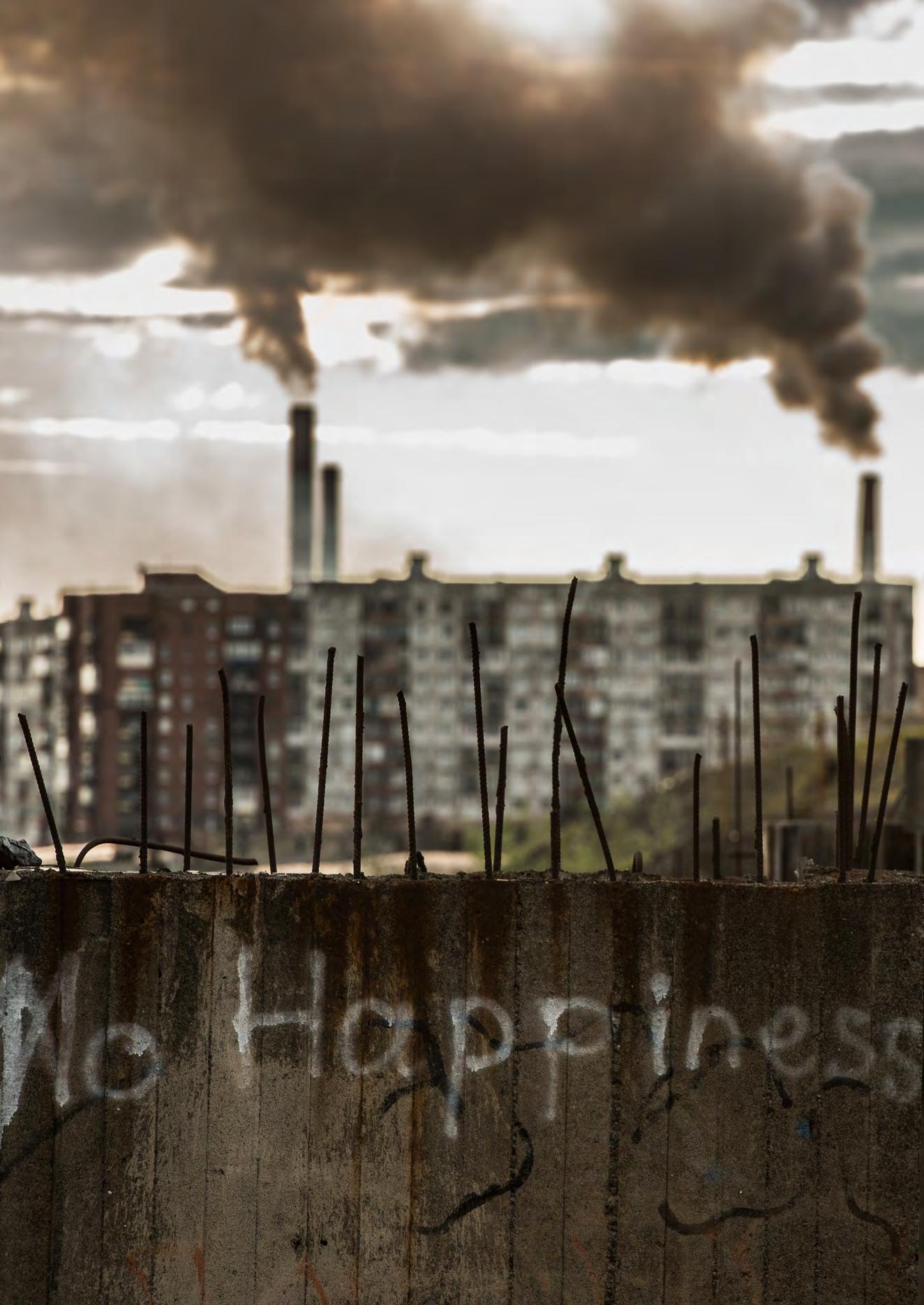



The Environment of Post-2022 Russia and the Kremlin’s Threat to Domestic and Global Stability and Sustainability
Greenpeace International is grateful to all the authors and experts working on environmental protection and activism in Russia, and in the broader international context, whose research and contributions made this report possible.
We would also like to thank all the reviewers from different Greenpeace national and regional offices for their valuable contributions and support throughout the review process.
Greenpeace is an independent global campaigning organisation that acts to change attitudes and behaviour, to protect and conserve the environment, and to promote peace.
Published by: Greenpeace International, October 2025
Greenpeace International Surinameplein 118 1058 GV Amsterdam
The Netherlands
+31 20 718 2000
+31 20 718 2002
info.int@greenpeace.org greenpeace.org/international
© Greenpeace International 2025. All Rights Reserved.
Cover photo: View of Norilsk city
© Anonymous
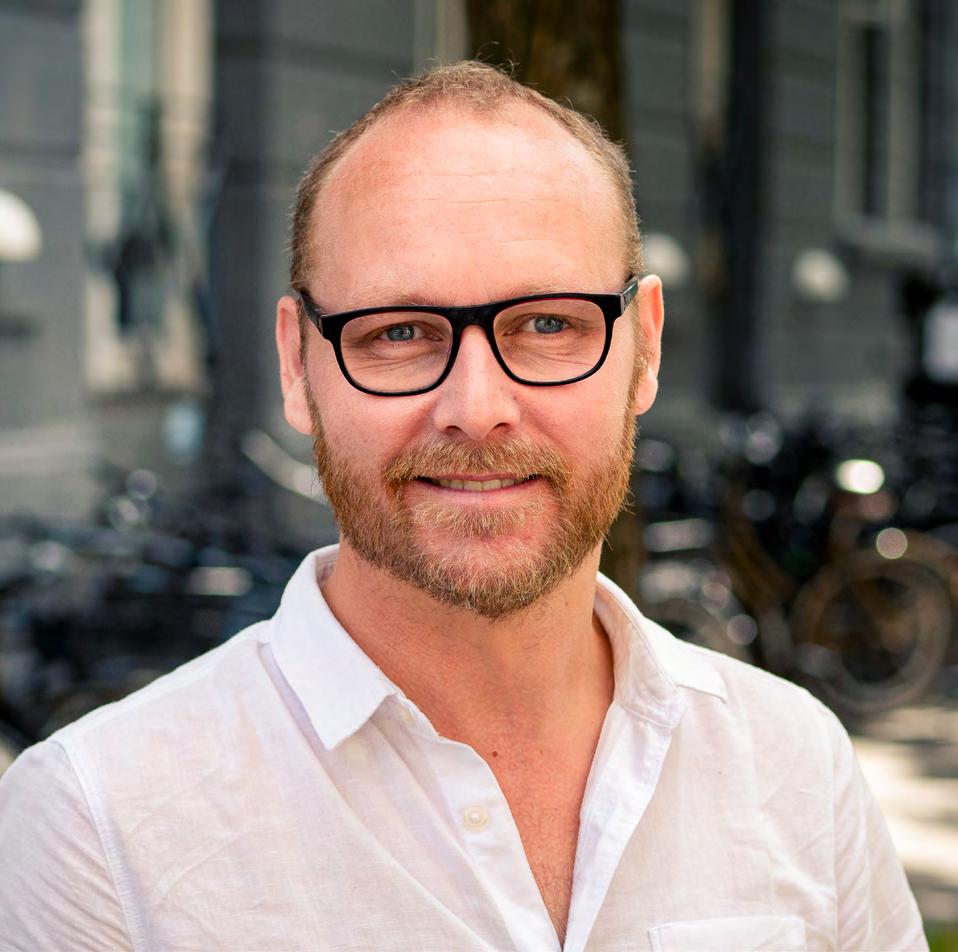
Drawing on the insights of countless experts on Russia’s climate, biodiversity, and politics, this report provides an unparalleled look at its ecosystems, the movements working to protect them, and the country’s far-reaching impact on global sustainability – all against the backdrop of the ongoing full-scale invasion of Ukraine.
Russia’s descent into a bloodthirsty war economy, running on fossil fuels and propaganda, has deprived the world of vital information about our shared planet. Yet determined reporting can still cut through the silence.
Greenpeace Russia, having opposed the war in Ukraine since February 2022, was forcibly closed after Greenpeace International was designated an ‘undesirable organisation’ in 2023 as part of a Kremlin crackdown on civil society, ending a proud 30-year history defending the environment, human rights and peace.
In a separate effort to tackle the threats posed by Russia’s heinous invasion, Greenpeace Ukraine was opened in September 2024, driving the green reconstruction of the country and exposing the reckless actions of Russia. I am deeply proud of my colleagues there who, under immense pressure and unspeakable horror, demonstrate hope, courage and creativity even in the darkest times.
At the same time, nature and environmental destruction are not limited by borders. Despite Russia’s growing isolation, its global influence remains undeniable, and while we can learn about the state of the environment in Ukraine from open sources, independent media, and scientists, information about the state of the environment in Russia is cloaked in secrecy.
That is what makes reporting on Russia, like this, so important. Not only to expose the environmental devastation caused by the violence and corruption of the current Russian regime, but also to stand as proof that Greenpeace, along with millions, will not be silenced.

Environmental journalist; fellow at the Institute for Global Reconstitution in Berlin; expert on environmental projects at Dialogue for Understanding e. V. (Berlin) and the Environmental Communications Agency
This report is a significant analytical work by a group of Russian experts, highlighting key changes, trends, and challenges in Russia’s environmental and climate policy since the full-scale invasion of Ukraine.
As independent information from Russia in the fields of environment and climate becomes increasingly difficult to access, and pressure on independent media and civil society organisations continues to grow, this comprehensive report, in my view, serves to inform both international and Russian-speaking audiences – and to help maintain connections between critical voices in Russia and the global community.
Fellow at the Institute for Global Reconstitution in Berlin; specialist in political ecology and extractivism in Eastern Europe and the post-Soviet space
We live in an age of multiple crises: wars, growing political repression, social inequality and the climate crisis are increasingly intertwined and reinforce each other. This report situates Russia within the broader context of these multiple crises, thereby contributing to a better understanding of the country's current social development.
This is particularly true with regard to the ecological situation, about which less and less has been known since the beginning of the full-scale invasion of Ukraine. Thanks to the tremendous wealth of expert contributions, this anthology fills the growing information gap and is aimed at both Russian-speaking and international readers.

Russia’s full-scale invasion of Ukraine on 24 February 2022 sent shockwaves around the world. The Putin regime that inflicted this ongoing, heinous tragedy on Ukraine and its people has also set Russia itself back decades. Many economic, social and democratic achievements that Russia had attained since the fall of the USSR have been lost and the country now ranks among the lowest in the world for civil liberties. Global ratings for freedom of the press show Russia has fallen to 171st place out of 1801 and, in an index for perceived corruption, to 154th place.2 Ruthless repression of civil society has led to the shuttering of many NGOs and the aggressive persecution of activists. In 2023, Russia became the only country in the world to ban Greenpeace.
Recent events have been enabled largely by fossil fuel revenues, which fuel authoritarianism and militarism. Vladimir Putin and his cronies have made extractivism the foundation of a system based on corruption, imperialist propaganda and repression – one in which a small circle of elites profit from exploiting people and nature, and from seizing the territory of neighbouring states by force.
Extractivism is an economic and political system based on the widescale extraction and export of natural resources – oil, gas, coal, metals, timber, etc – with little processing or added value. This model is often marked by ecosystem destruction, environmental pollution, community rights violations and entrenched social inequality. It funnels wealth and power into the hands of a narrow elite, and fuels the repressive apparatus used by authoritarian regimes to undermine prospects for democratic, just and sustainable development.
1 Reporters Without Borders. World Press Freedom Index. 2025.
2 Transparency International. 2025. Corruption Perceptions Index (CPI) for 2024.
The Russian regime’s influence extends far beyond the country’s borders. Though it still formally participates in international environmental agreements, Russia’s foreign policy veers increasingly toward undermining international institutions and escalating environmental jeopardy, rather than strengthening global sustainability and security.
Despite the Russian state’s destructive policies and the damaging role its current leadership plays in the international arena, the country itself is crucial to global environmental sustainability. Its vast boreal forest, permafrost and wetlands play a vital role in global climate stabilisation, while the diversity of its ecosystems – from Arctic deserts to the subtropical foothills of the Western Caucasus mountains – makes Russia a repository of unique biological riches.
Given the repression and pressure on independent environmental organisations in Russia, we believe it is vital to safeguard independent advocacy in defence of nature. Russian authorities’ attempts to silence Greenpeace have not stopped us – not in 2013, when Russian special forces arrested an international group of 30 activists at gunpoint for peacefully protesting Arctic oil drilling, nor a decade later, at the height of the war in Ukraine, when the Russian state groundlessly banned Greenpeace activities in Russia3. Thanks to our supporters and international solidarity, we remain independent of government and corporate interests, and we continue our work – even in countries where authorities and corporate elites obstruct access to and dissemination of reliable information, and try to suppress independent environmental movements.
Numerous experts, researchers and activists continue to work to preserve Russia’s nature, support civil society and stop the war in Ukraine. Some do so from inside the country, adapting to its new reality; others have brought their work with them into exile. Despite the deep crisis in which Russia finds itself, we believe that these are the very people who can
3 In May 2023, Greenpeace International was unjustifiably declared an “undesirable organisation” by the Russian Prosecutor General’s Office. De facto, this amounts to a ban on any of the organisation’s activities under threat of criminal prosecution.
drive the transformation needed to change the current situation, and bring about peaceful and sustainable development in the future.
The goal of this report is to summarise and analyse how environmental policy in Russia has changed – since the beginning of the full-scale invasion in 2022 and in the context of subsequent sanctions and growing authoritarianism – as well as the impact of these changes at domestic and global levels. The analysis we present is not only important for Russia; it reveals the wide array of problems faced by countries following a path of resource dependence, militarisation and curtailed freedoms.
This report is based on hundreds of studies and publications produced by various organisations, media outlets, expert communities and independent specialists working on Russian issues both within the country and abroad. More than 20 experts specialising in environmental preservation and activism contributed to its preparation.
The chapter Socioeconomic Context provides an overview of the current economic and social situation in Russia, providing the context to assess the state of the environment, society, and the actions of the ruling regime.
Environmental Policy and Governance describes the degradation of government environmental regulations, including changes to legislation and its enforcement, as well as the decline in data transparency and opportunities for public participation in decision-making.
The Climate Crisis chapter analyses both the already observable and the projected consequences of climate change for Russia’s environment and society, as well as state climate policy, including measures to reduce greenhouse gas emissions and to adapt to climate change.
The Biodiversity Crisis chapter describes the factors affecting biodiversity in Russia, including forest management policies, protected natural areas and endangered species conservation.
The chapter on The Arctic is a study of the effects of militarisation and industrial exploitation in the context of war, growing authoritarianism and international isolation. It analyses environmental degradation, violations of Indigenous rights, and the dismantling of the region’s system for international environmental cooperation.
The chapter Russia’s Influence on Global Environmental Policy and Security examines how the Kremlin uses international agreements and institutions for its own geopolitical aims, opposing global climate transformation and undermining mechanisms for international cooperation. It also considers the diplomatic and other forms of influence that Russia exerts on environmental security in other countries.
The Public Opinion chapter analyses Russians’ opinions about environmental problems and activism in the context of war, censorship and political repression.
The chapter on The Environmental Movement describes the dismantling of Russia’s public sector and the transformation of its environmental movement under growing authoritarianism, repression and war. It also analyses environmentalism’s potential as one of the few remaining channels for civil self-organisation.
The final chapter, An Alternative Path to a Sustainable Future? Overcoming Resource Dependence in Russia, examines approaches to transforming the current extractivist model, and proposes directions for social and environmental restructuring in the country.
At the end of the report, we present the major conclusions drawn up by experts on the basis of their research and analysis.
This report does not cover the vast topic of environmental damage that Russian aggression inflicted on Ukraine. For more information, please visit the websites of Greenpeace Ukraine and the Ukraine War Environmental Consequences Work Group.

Since the full-scale invasion of Ukraine in February 2022, the Russian economy has undergone profound changes, driven by war-related demands and external economic pressures. Unprecedented sanctions imposed by the EU and some non-EU countries, the loss of traditional energy markets and the exodus of foreign investors and financial reserves have triggered structural transformations that will shape the country's development for decades. These shifts have already manifested in both short-term economic disruptions, such as financial instability and labour shortages, and long-term consequences that extend beyond the economy into environmental and ecological domains.
One of the most striking transformations has been the dramatic increase in military and security expenditure, which now accounts for up to 40% of the federal budget, diverting resources from civilian sectors, including environmental protection. [1.1] The prioritisation of military production has led the federal government to reallocate resources away from civilian sectors, including the environment and sustainable development. The war-driven restructuring of the economy has intensified industrial output in polluting sectors, particularly defence and heavy manufacturing, exacerbating environmental degradation and sidetracking climate commitments.
Simultaneously, the fossil fuel industry –historically the backbone of Russia’s economy –has faced considerable setbacks due to the loss of traditional European markets. In response, Russia has reoriented its energy exports toward Asia, a shift that requires extensive new infrastructure such as pipelines, liquefied natural gas (LNG) terminals and coal transport networks. These projects threaten fragile ecosystems, particularly in Siberia and the Arctic, where extraction and transportation involve high environmental risks.
Additionally, the departure of major Western energy firms has deprived Russia of critical technology for cleaner extraction and processing, potentially leading to increased methane leaks, higher carbon emissions and inefficient resource utilisation.
Deforestation, water contamination and land degradation have also intensified as the war economy demands greater exploitation of domestic natural resources with less ecological control. Moreover, the diversion of state funding towards military needs has come at the expense of environmental initiatives, reducing support for renewable energy, emissions reduction programmes and pollution prevention measures.
Since 2022, Russia’s economic development has undergone a fundamental shift towards the military-industrial sector at the expense of the civilian economy. The redirection of resources from key civilian industries has led to an expansion of military-industrial enterprises, with increased production of weapons, ammunition and military vehicles. Unemployment in Russia declined from 4.4% in January 2022 to an unprecedented 2.3% in December 2024.[1.2] As a result, labour force shortages limit opportunities for economic growth. A deficit of skilled labour has emerged, as thousands of qualified workers and engineers are either mobilised for military service or redirected to defence-related industries offering much higher salaries.
Simultaneously, Russia’s traditional economic drivers, particularly the energy sector, have faced significant disruptions. The loss of traditional export markets for oil, gas and coal has forced Russia to seek alternative buyers in Asia, a pivot that in turn requires investments in infrastructure projects which are costly and often impossible to complete. Western sanctions have complicated access to critical technology and foreign investment, further weakening civilian industries such as automotive manufacturing, aviation and high-tech production. Many factories that previously relied on Western components have struggled to adapt, leading to declining production quality and inefficiencies in the civilian sector.
The shift toward a military-dominated economy has also worsened Russia’s long-term socioeconomic prospects. Reduced funding for public services, education and technological innovation limits opportunities for improving quality of life, growth and diversification.
State budget allocations for defenсe have seen an approximately four-fold increase: from 3.4 trillion RUB (around 43.3 billion USD)1 in 2021 to around 9 trillion RUB in 2024 (around 114.5 billion USD), with the figure expected to rise further to 13.5 trillion RUB in 2025 (around 165.4 billion USD) (Figure 1). More than 80% of Russia’s military expenditure is classified as confidential.[1.3][1.4][1.5][1.6]
The state funding for several environmental projects listed under the Ecology national programme has been reduced in the federal budget. Notably, the Clean Air Federal Project, which aims to reduce air pollution in industrial cities, was slated for a nearly 50% budget cut, amounting to a reduction of 6 billion RUB (around 76.4 million USD). Similarly, the Clean Country Federal Project, focused on eliminating toxic waste sites, faced a budget decrease of almost 30%.[1.7] [1.8]
1 Here and below, USD amounts were calculated at the official exchange rate of the Bank of Russia as of 1 June, 2025.
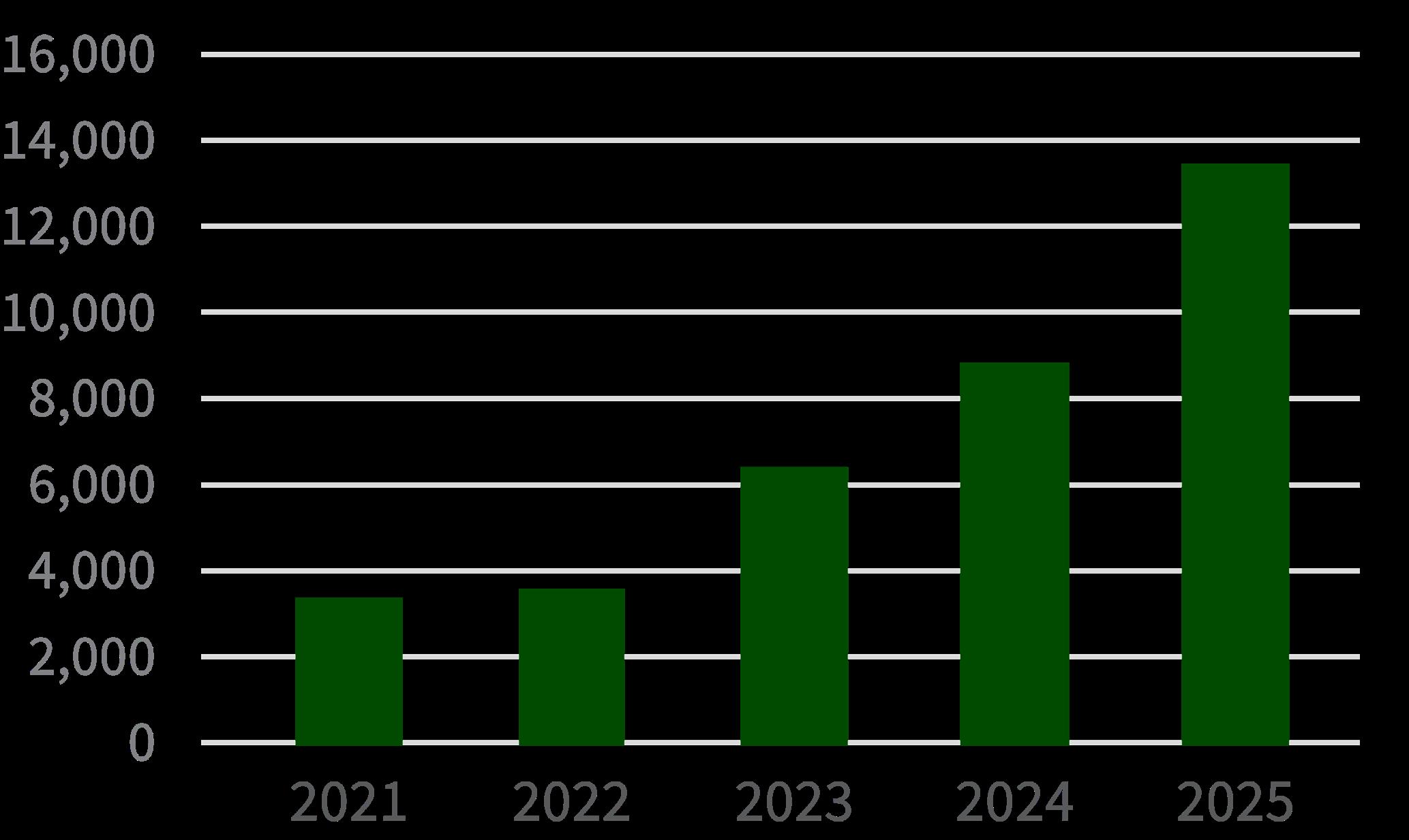
Source: Greenpeace International, based on data from the Russian Ministry of Finance
The Russian government and Central Bank have been implementing unprecedented measures to inject money into the economy using various tools. These processes fuel high inflation, which is projected to rise for both businesses and the population at large. Massive state budgetary expenditure on the military sector, including payments to war participants and their families, also serves as a significant source of cash injection into the economy. The growth of the Russian money supply (cash and deposits) from January 2022 through January 2025 reached about 80%, while official GDP increased by less than 6%, a discrepancy that contributes significantly to the high inflation rate in Russia.[1.9]
Another factor contributing to inflation was the devaluation of the national currency, the ruble (RUB), which lost more than 45% of its value against the US dollar between January 2022 and January 2025, as the exchange rate rose from 76 to 110 RUB/USD. Although by May 2025 the ruble had strengthened again to around 80 RUB/USD, this did not lead to lower prices for imported goods or to a slowdown in inflation. Ruble’s volatility, uncertainty over its future value and reliance on nonmarket mechanisms to manage the exchange rate make it harder to import advanced technologies and environmentally safe materials. This slows the transition to green production and restricts access to eco-friendly goods and services.
Since early 2022, over 1,000 foreign companies have shuttered their Russian operations and withdrawn from the country.[1.10]
The net outflow of capital from Russia surged by 3.4 times between 2022 and 2021, reaching 251 billion USD in 2022 and, according to the Central Bank of Russia’s estimates, 125 billion USD in 2023. Such significant 'run-away' of capital underscored a profound lack of trust in Russia among both foreign and domestic investors.
Russia has faced significant restrictions to accessing modern technology and services following the comprehensive sanctions imposed by Western nations, including European Union countries and the United States, as well others like Japan and South Korea. These sanctions have targeted various sectors, aiming to curtail Russia's technological and industrial capabilities.
In December 2023, the European Union expanded its sanctions to include a prohibition on the sale, supply, transfer, export or provision of specific software and IT services to Russian entities. [1.11] This includes software for enterprise management and design and manufacturing processes, effectively isolating Russia from essential digital tools.
The cumulative effect of these sanctions has been a significant hindrance to Russia's industrial sectors, limiting their ability to modernise and maintain their industrial and technological infrastructure — for example, by restricting access to imported equipment needed for cleaner production or emissions monitoring systems. These limitations will have long-lasting environmental impacts.
Between 2022 and 2025, Russia underwent significant financial shifts that profoundly affected its economic and environmental landscape. The loss of access to foreign financial markets drove up both the cost and scarcity of capital, making long-term investment planning more difficult and often limiting shareholders’ willingness to approve expenditure related to environmental protection.
The Central Bank raised its base rate from 6.5% in 2021 to 21% by the end of 2024, causing commercial bank lending rates to exceed 25% per year.[1.12] These increases were compounded by rising labour and operating costs. Under such conditions, borrowing to finance business development, technological modernisation or sustainable initiatives became largely unfeasible for enterprises.
Since 2022, Russia has experienced significant activity in asset takeovers, including mergers and acquisitions, nationalisations and the seizure of foreign-owned assets. In 2023, the total value of such transactions involving Russian assets was approximately 50.59 billion USD, marking an 18.7% increase from the previous year. This upward trend continued into 2024, with the total value of such transactions reaching 54.3 billion USD, a 7.11% increase compared to 2023.[1.13]
Foreign companies and investors have witnessed their capital assets being 'nationalised', including via transfers to individuals close to Vladimir Putin. A significant wave of property takeovers is evident across various sectors, including oil and gas (shares of ExxonMobil in Sakhalin-1 and Shell in Sakhalin-2 projects), energy (loss of assets by Fortum) and services (Russian divisions of Baker Hughes and Halliburton).
Amid uncertainties and high capital costs, many companies are opting to employ costcutting measures to sustain production. Russian businesses are encountering significant challenges in executing complex operations, particularly in the Arctic and other remote areas, due to the withdrawal of technological partners such as Shell, ExxonMobil, BP, Equinor, Siemens, General Electric, and leading service companies like Schlumberger (SLB), Baker Hughes and Halliburton. Domestic companies’ existing capacities are inadequate for carrying out high-tech-intensive operations.
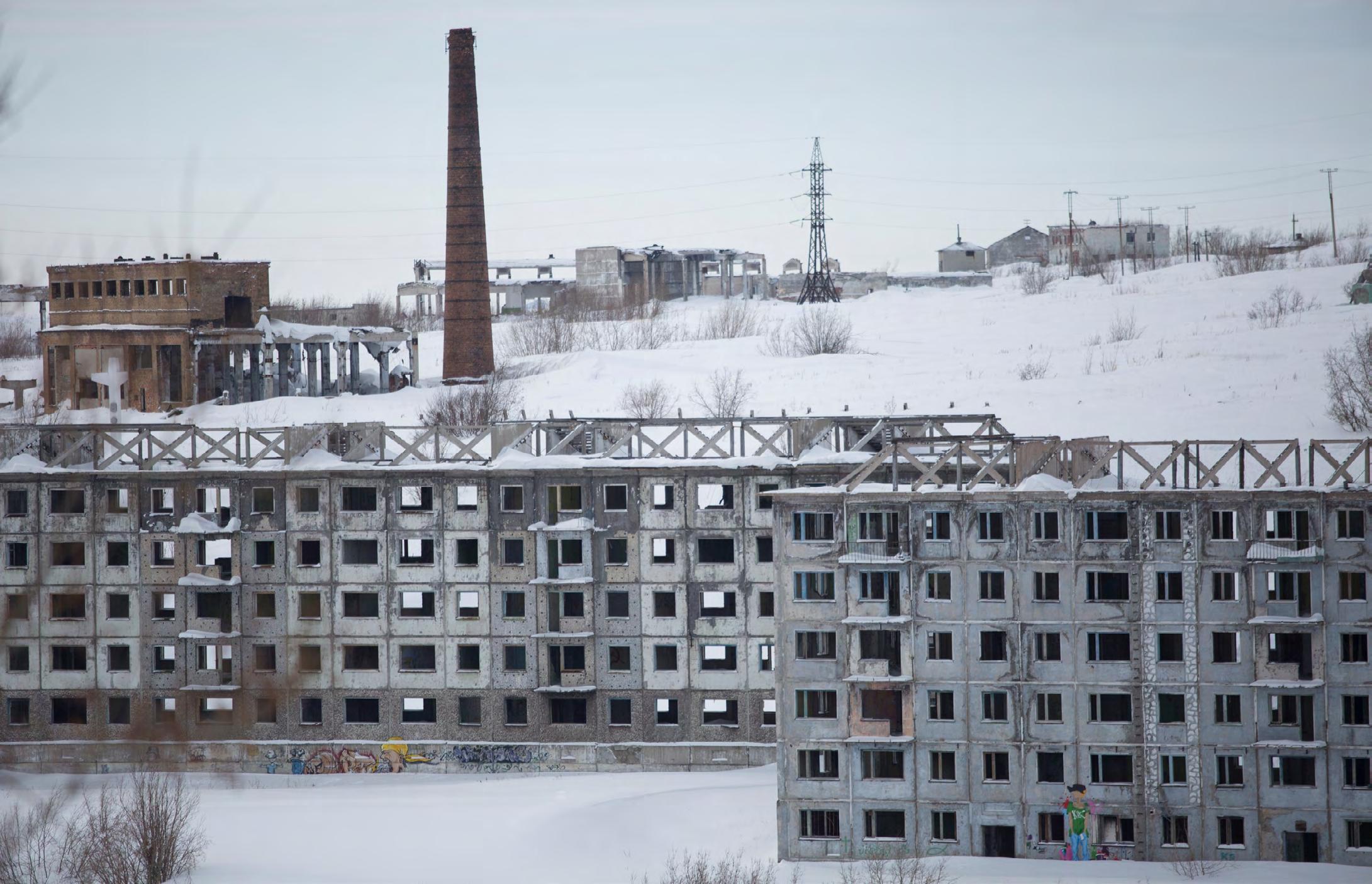
The systematic destruction of a free press and nonprofit organisations, the state’s growing role in the economy and increasing secrecy inevitably lead to a rise in corruption in the country. This state of affairs is reflected in Transparency International's Corruption Perceptions Index (CPI), where a lower score indicates a higher perceived level of corruption. In 2022, Russia scored 28 points, placing it 137th out of 180 countries. This score dropped to 26 points in 2023, ranking Russia 141st, and further declined to 22 points in 2024, positioning Russia at 154th, the lowest in its history.[1.14][1.15]
Since 2022, Russian businesses have faced significant challenges in maintaining sustainable practices and adhering to Environmental, Social and Governance (ESG) standards. These challenges stem from geopolitical tensions, economic sanctions and the exodus of foreign companies, leading to a deprioritisation of sustainability initiatives within Russia.
The departure of major international corporations and restricted access to Western markets and technology have prompted Russian businesses to reassess their ESG commitments. In 2022, approximately 40% of Russian companies reduced their sustainability expenditure, reflecting a shift away from long-term environmental goals towards immediate economic concerns.[1.16] Many Russian companies have reconsidered their ESG strategies: social issues have become the most relevant, while environmental agendas and governance quality have taken a back seat due to geopolitical tensions.[1.17]
Despite these setbacks, some Russian companies are redirecting their ESG efforts towards national environmental challenges, including the development of domestic ESG ratings, which aim to align with local priorities rather than international standards. However, the effectiveness and global recognition of these initiatives remain uncertain.
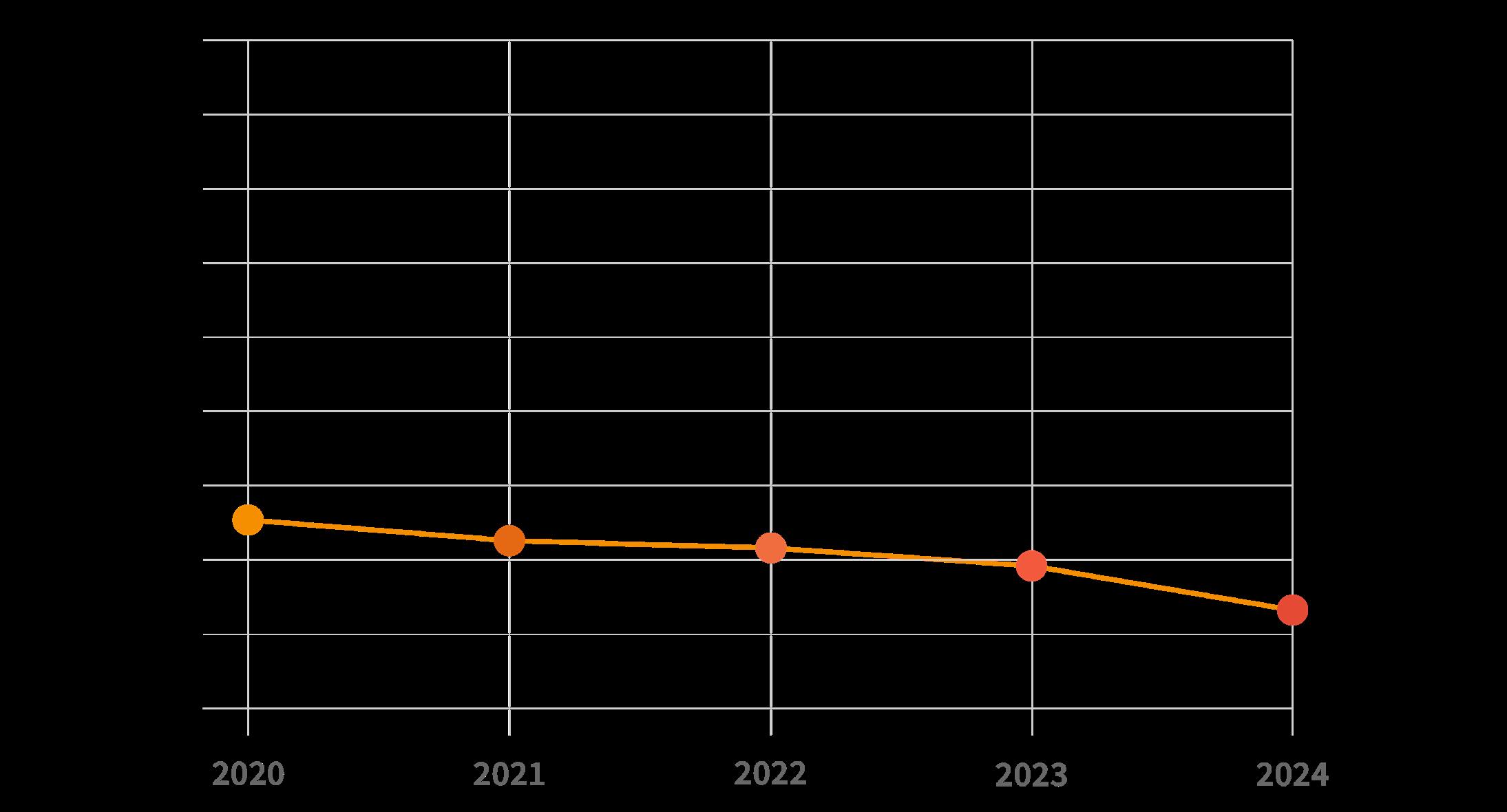
Figure 2.
Source: Transparency International
Russia has also experienced a profound shift in income and consumption patterns, driven by a combination of economic sanctions, isolation from global markets and internal financial changes.
In an effort to adapt, the Russian economy has moved increasingly towards import substitution, ramping up domestic production to replace goods previously sourced from foreign markets. However, this rapid transition has often come at the expense of environmental sustainability. Many newly domestically produced goods, especially in the manufacturing and consumer sectors, fail to meet modern environmental standards. Quality degradation has become common, as companies cut costs and technological inputs become harder to obtain.
One visible manifestation of these shifts is in the market for durable goods, such as cars. With reduced availability of new, efficient vehicles and the soaring costs of imports, demand has shifted sharply toward older, less fuel-efficient models, which eventually contributes to a rise in urban air pollution.
The long-term effects of Russia’s current trajectory are increasingly severe and multifaceted. A significant depletion of resources from the Fund of National Wellbeing has undermined the country's financial resilience, reducing its capacity to respond to future crises.
The technological base continues to degrade. Across the economy, more than 50% of capital assets – including machinery, equipment and infrastructure – are now fully depreciated, according to Rosstat, meaning they have exceeded their service life and require replacement. There are still neither enough funds nor incentives to modernise industries and infrastructure. This is reflected in the further deterioration of water supply and heating systems, electricity grids, oil and gas pipelines, and roads, many of which are over 80-90% worn out. This increases the risks of accidents, inefficiency and environmental harm.
The absence of a coherent governmental strategy for environmental protection and rational natural resource use has fostered negative incentives for businesses, encouraging short-term profit-seeking behaviour at the expense of sustainability. The financial burden of the war and its aftermath is expected to be enormous, with looming obligations for compensation to Ukraine, the recovery of destroyed territories and infrastructure, and efforts to boost weapons production to replenish depleted military stockpiles.
Demographic challenges have also deepened – accelerated depopulation, brain drain and the flight of qualified specialists, entrepreneurs and professionals are compounded by significant war-related losses. Social capital has deteriorated, marked by a growing lack of trust in society, in businesses and in the rule of law, all of which erodes the foundations on which future economic and social stability could be built.
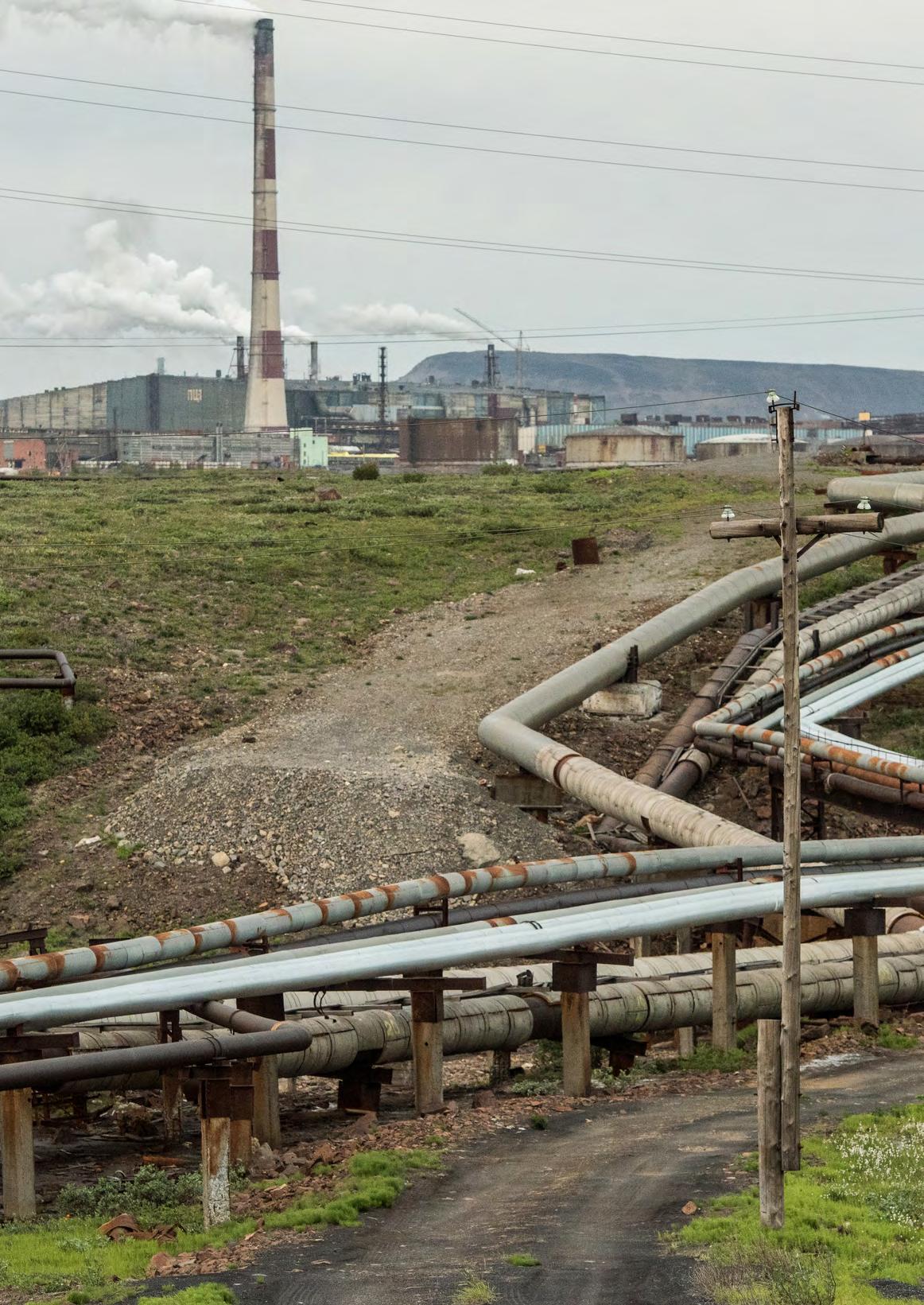
Growing authoritarianism and the full-scale invasion of Ukraine have profoundly impacted environmental policy and governance in Russia, with both immediate and long-term consequences. In the short term, domestic environmental issues have been deprioritised as resources and political attention shift toward military objectives and increasing state budget revenues. Environmental regulations are being weakened or ignored, particularly in industries critical to the continuation of the war, such as oil, gas and metals production, leading to ever increasing damage to the environment. Meanwhile, the crackdown on civil society has undermined independent oversight and transparency in environmental governance. International sanctions and Russia’s growing isolation have also disrupted cooperation on climate and environmental initiatives, such as its participation in the Arctic Council, Paris Agreement and other multilateral agreements (see Chapter 5, The Arctic and Chapter 6, Russia’s Influence on Global Environmental Policy and Security).
In the long term, the consequences could be even more severe. The militarisation of the economy risks permanently degrading environmental institutions, as sustainability concerns are sidelined in favour of a war-oriented economy. Russia’s climate policies may stagnate or regress further, with the government pushing for fossil fuel production and exports to sustain its economy amid sanctions, further delaying decarbonisation efforts. The erosion of transparency and repression of environmental activism will likely worsen, making it harder to monitor and address ecological damage. Endless sanctions limit access to modern technologies, a situation which could prolong reliance on outdated, polluting infrastructure, exacerbating environmental degradation and leading to an increase in industrial accidents. As Russia becomes increasingly distanced from global environmental frameworks, its ability and willingness to meet international climate commitments will diminish.
The foundations of Russian environmental legislation were formed in the 1990s and were, at the time, considered quite progressive even by European standards. The key regulatory acts were the “protection of the natural environment” and “environmental expert review” laws. These instruments established that any economic activity could be environmentally dangerous: the burden of proof of its safety fell on the project’s initiator. Conducting an Environmental Impact Assessment (EIA) was a mandatory step, and the state environmental review was conceived as an independent instrument for environmental regulation, ensuring that design documents were verified before permits were issued. The preliminary publication of design materials and public discussions, and the obligation to take into account the opinions of local residents, environmental organisations, and other interested parties were integral elements of EIA and state environmental review procedures. The legislation also provided for the possibility of conducting a public environmental review, whose findings were to be taken into account by the state review. Despite the fact that these principles are still formally enshrined in foundational environmental laws, the weakening of environmental legislation that began in the 2000s and selective application of existing laws have led to the degradation and the de facto curtailment of EIA and environmental review procedures. After the start of the full-scale war, these trends became even more pronounced.
The list of activities subject to state environmental review continues to be reduced. Simultaneously, the regime is creating legislative and administrative barriers to conducting public reviews, and restricting access to information about the expected environmental impact of any project. The mechanism of public discussion is losing its efficacy and is increasingly reduced to formal procedure with no real influence on decision-making.[2.1] [2.2] Large extractive projects, like the Yamal LNG and the Arctic LNG 2, are allowed to determine independently the amount of information they disclose.[2.3] No information is disclosed on the environmental impact of completing military projects.[2.4]
After 2022, the degradation of major environmental legislation also intensified. In particular, changes to the law “On production and consumption waste” in 2022 serve to simplify waste incineration under the guise of a clean-up of mining operations.[2.5][2.6] Legislation pertaining to forests, specially protected natural territories and wildlife protection has also undergone important changes (see Chapter 4, Biodiversity Crisis).
In 2022 and 2023 alone, 12 destructive amendments were made to Russia’s five main environmental laws, aimed at weakening state environmental reviews and reducing the economic burden on large businesses at the expense of the environment.[2.2]
Russian authorities have increasingly classified or restricted access to critical environmental data. Some key examples include pollution data, such as real-time air quality monitoring in industrial cities (Norilsk, Chelyabinsk, Krasnoyarsk and many others), that is not available for open access. Deforestation statistics are not true, as the official reports exclude illegal logging and wildfire impacts are continuously misreported. Industries no longer disclose full pollution data, citing "commercial secrecy". As a result, independent researchers and NGOs cannot verify environmental damage, while people in polluted regions lack information about related health risks.
Independent environmental journalism has been largely silenced due to bans on media organisations. Journalists investigating oil spills or military pollution face charges of "extremism". Remaining media use selfcensorship and avoid sensitive topics linked to sanctions-busting tankers, the health impacts of pollution and the degradation of the environment.
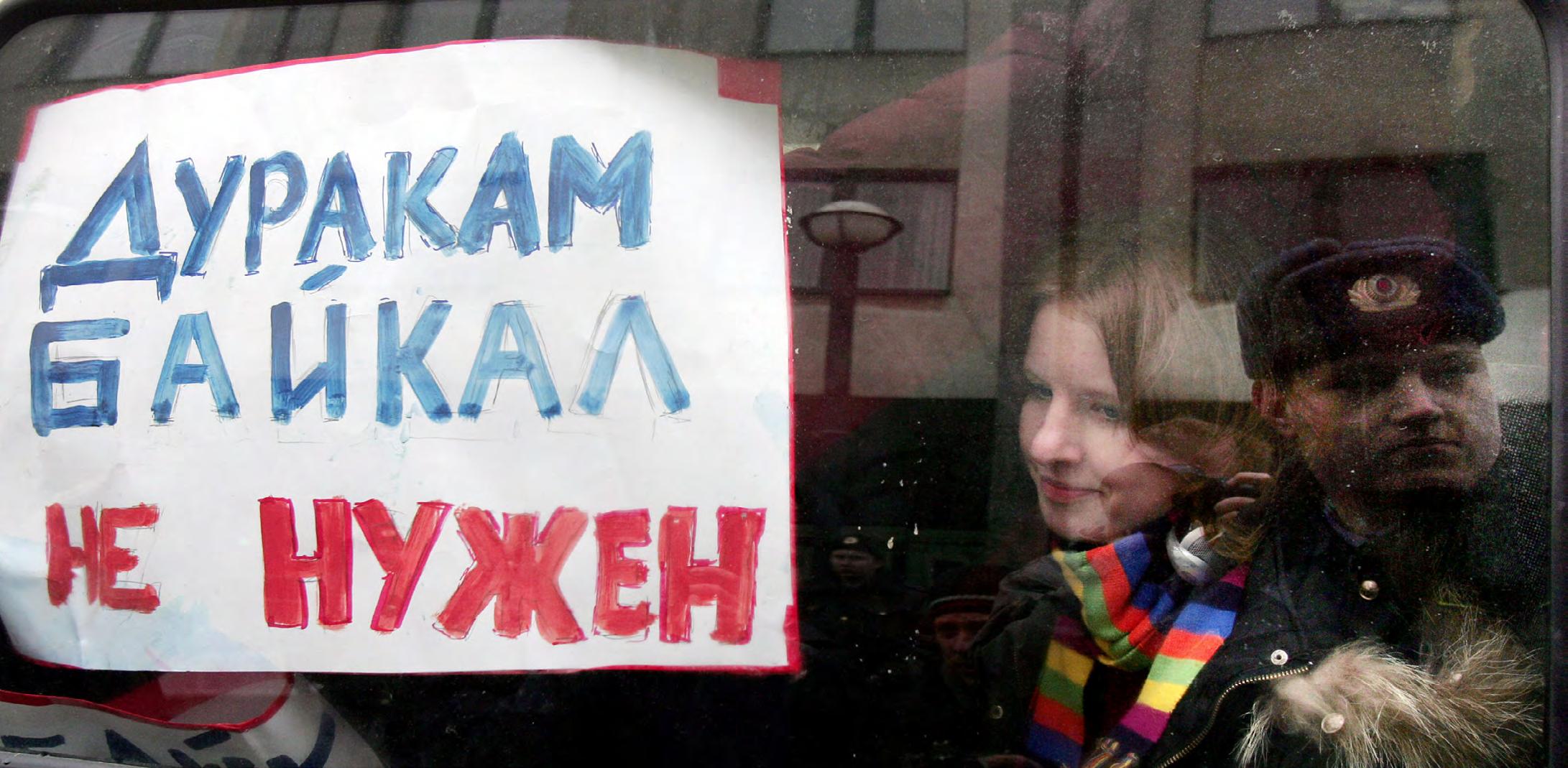
The Federal Service for Hydrometeorology and Environmental Monitoring (“Roshydromet”) controls a large amount of environmental data, and rising concerns about the agency include its lack of independence, selective reporting and methodology adjustments (to comply with the official narratives), and a lack of independent verification as NGO monitoring systems are blocked or dismissed as "foreign interference". This leads to the "Russian data gap" – unreliable data that distort worldwide modelling and assessment.
Russia's environmental governance system has become a façade, designed to maintain the illusion of ecological stewardship while enabling natural resource extraction and environmental degradation.
At the federal level, the Ministry of Natural Resources and Ecology operates as a bureaucratic shell rather than an effective regulatory body. Despite its nominal responsibilities, the ministry lacks both the political backing and enforcement capabilities to challenge powerful economic interests. Environmental protection is frequently overridden by industrial priorities, with the ministry serving primarily to rubber-stamp potentially damaging projects. The recent gutting of EIA requirements exemplifies this dynamic, removing one of the last remaining barriers to uncontrolled and unsustainable extractive and industrial expansion.
Russia's environmental strategies, especially in recent years, exist primarily as performative documents rather than practical plans. The much-publicised “Ecology” national project (2018–2024) failed to meet many of its key goals, including those related to programmes such as “Revival of the Volga River”, the “Preservation of Lake Baikal”, as well as to waste management reform.[2.7][2.8][2.9][2.10]
Climate change mitigation and adaptation policies remain ineffective, particularly with respect to greenhouse gas (GHG) emission reduction, which faces severe pressure from anti-climate action lobbyists from the coal and energy sectors. The government's recent embrace of "sovereign carbon accounting methodologies" has institutionalised data manipulation, allowing officials to report artificial progress while actual GHG emissions continue to rise (see Chapter 3, Climate Crisis).[2.11]
At the regional level, environmental authorities often function as extensions of governors’ administrations rather than independent regulators. In resourcerich areas like Kuzbass and the Yamal Peninsula, environmental departments openly serve mining and energy interests. This leads to unchecked pollution, fraudulent environmental impact assessments and the systematic violation of environmental standards. Such issues are even more evident in the Arctic, where rapid industrialisation proceeds without meaningful ecological safeguards.
The role of civil society in environmental protection has been systematically dismantled through restrictive legislation and direct repression (see Chapter 8, The Environmental Movement). Leading independent environmental organisations have either been eliminated or forced to adapt to the system. Grassroots activists face harassment, criminal prosecution and often physical violence. The authorities are clearly signaling to society that environmental advocacy challenging the economic or political interests of the elite will not be tolerated.
The complete state capture of Russia's media landscape has created an information vacuum on environmental issues. Domestic coverage either ignores ecological disasters or frames them as inevitable byproducts of economic progress. Independent journalists attempting to report on environmental issues face increasing restrictions.[2.12]
International media reports, blocked by internet restrictions and dismissed as foreign propaganda, have limited impact.
The window for reforming Russia’s environmental governance is narrowing. Without deep changes in the political and economic priorities driving environmental degradation, the country risks becoming a global environmental outlier, isolated from modern technologies and international cooperation aimed at addressing global challenges.
Flood in Orsk, 2024
© Zhdanov/Kommersant Photo/AFP/Getty
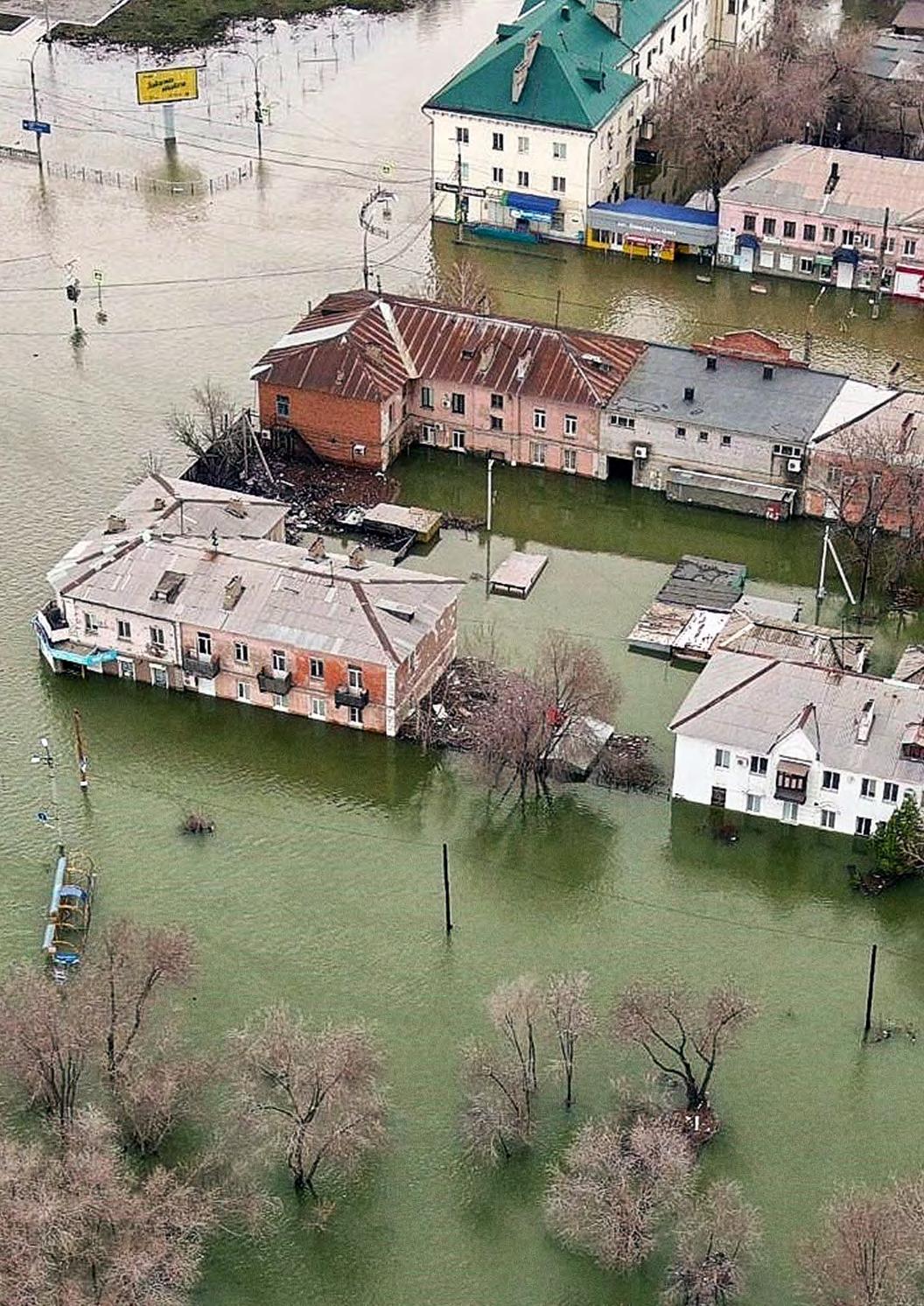
Modern climate change, clearly observable across Russia, has several important characteristics. Warming over land generally occurs faster than over the ocean: the global average near-surface temperature (land and ocean combined) between 1976 and 2020 increased by 0.179°C per decade, while the rate over land was more than one and a half times higher, at 0.295°C per decade.[3.3] The territory of Russia is warming almost twice as fast as the global land average, at 0.51°C per decade.[3.4] Moreover, each decade since 1981–1990 has been warmer than the last, with the past ten years (2015-2024) representing the warmest decade on record.[3.5]
The latest observations of the territoryaveraged anomaly across Russia (Figure 1) show that November 2024 was the third highest on record (+3.13°C), following the exceptionally warm Novembers of 2013 and 2020, with anomalies of +4.05°C and +3.50°C, respectively. Almost the entire territory of the country has experienced significant warming in recent years, with only a few exceptions — areas displaying slight negative anomalies.[3.6]
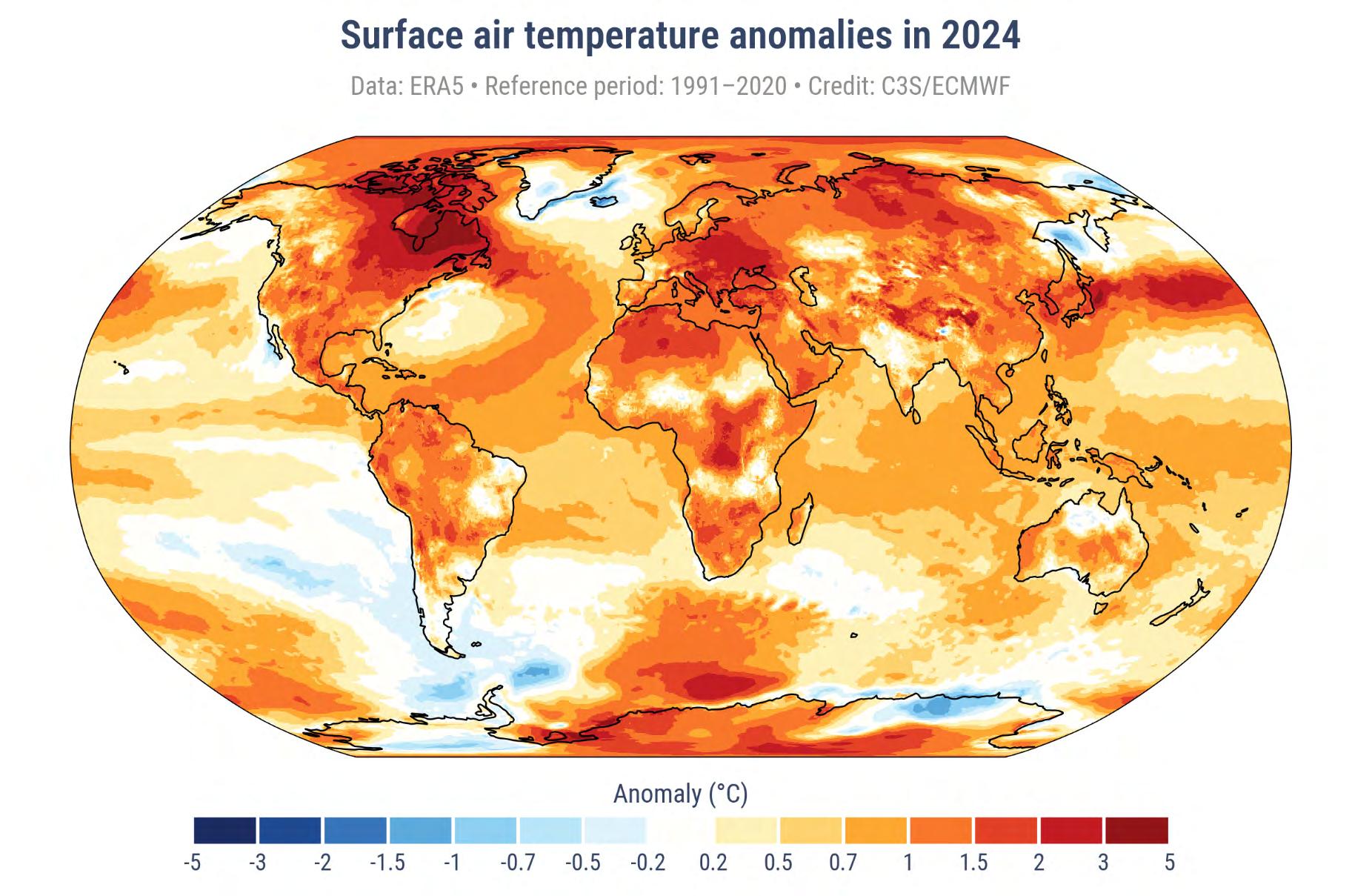
from the 1991–2020 average).
Source: C3S/ECMWF
Other climatic indicators beyond near-surface air temperatures also reflect climate change. In Russia, important examples include agro-climatic factors such as heat availability for agricultural crops, soil temperatures at various depths, Arctic Ocean ice cover, glacier degradation, the increasing frequency of large-scale summer heatwaves, and more.
Aspects of the hydrological cycle are also changing significantly, such as average seasonal precipitation and indicators of precipitation extremes; cloud cover; seasonal snow cover characteristics; river run-off, and the formation and break-up of river ice. Studies indicate a general trend toward increased precipitation across Russia, both annually and in all seasons. In all physical-geographical regions, annual precipitation totals over the past decade have increased compared to the previous assessment period from 1976 to 2012.[3.7]
According to the most recent studies (as of November 2024), observation stations recorded a significant excess of precipitation across Russia – exceeding 160% of the norm – in the upper and middle reaches of the Amur River, in the northern part of the European territory of Russia, and in the central Siberia.[3.6]
Expected climate warming in Russia during the 21st century is projected to significantly exceed the global average under all considered scenarios. In all scenarios considered by the IPCC, the average annual air temperature in Russia is expected to rise substantially throughout the 21st century (Figure 2). An increase in the frequency and duration of heatwaves will inevitably accompany average near-surface air temperature rises:
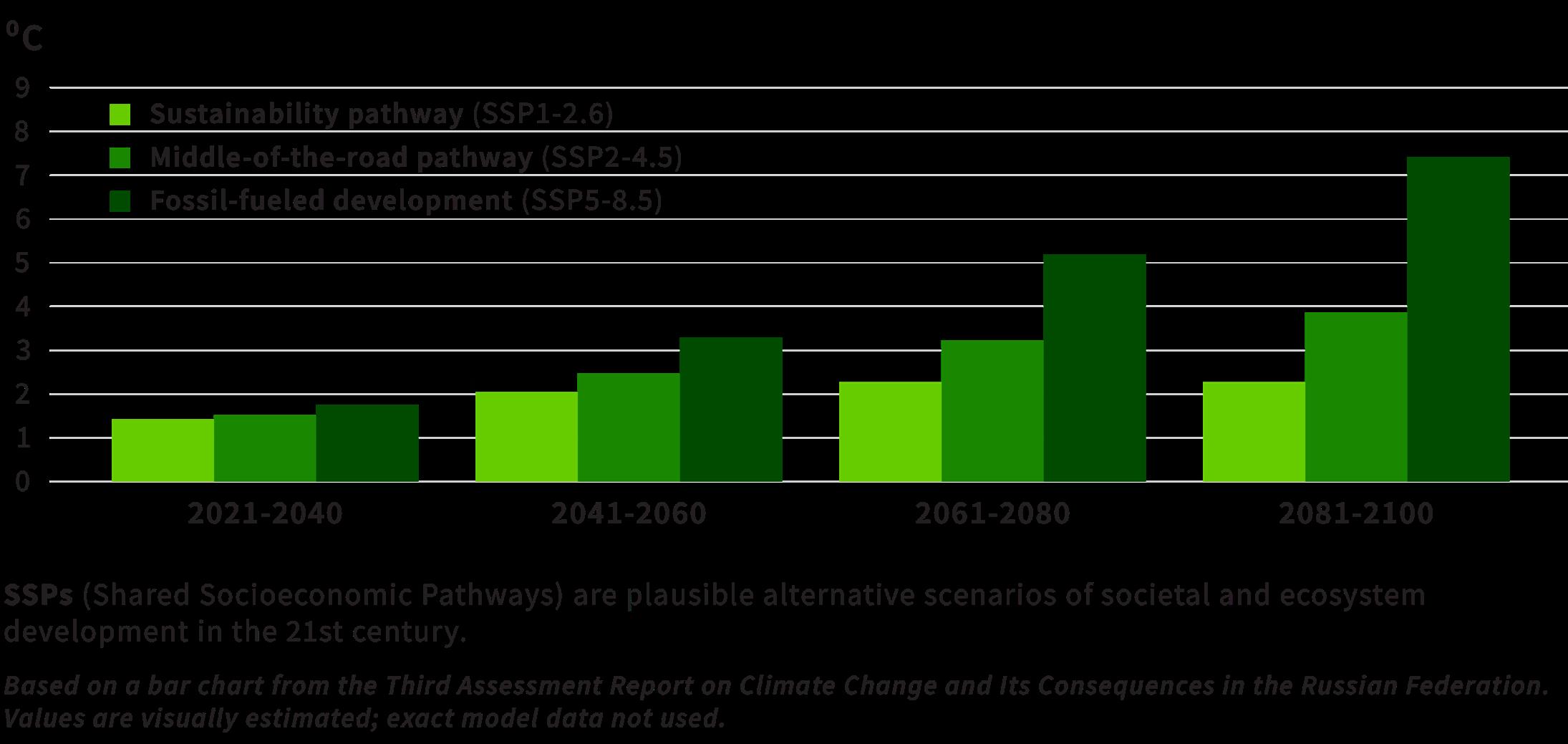
Source:
Annual atmospheric precipitation totals across Russia show a steady increase under all scenarios of anthropogenic impact on the climate system. The rate of precipitation is increasing, particularly in the Russian Arctic Zone, at a pace significantly exceeding the global average:
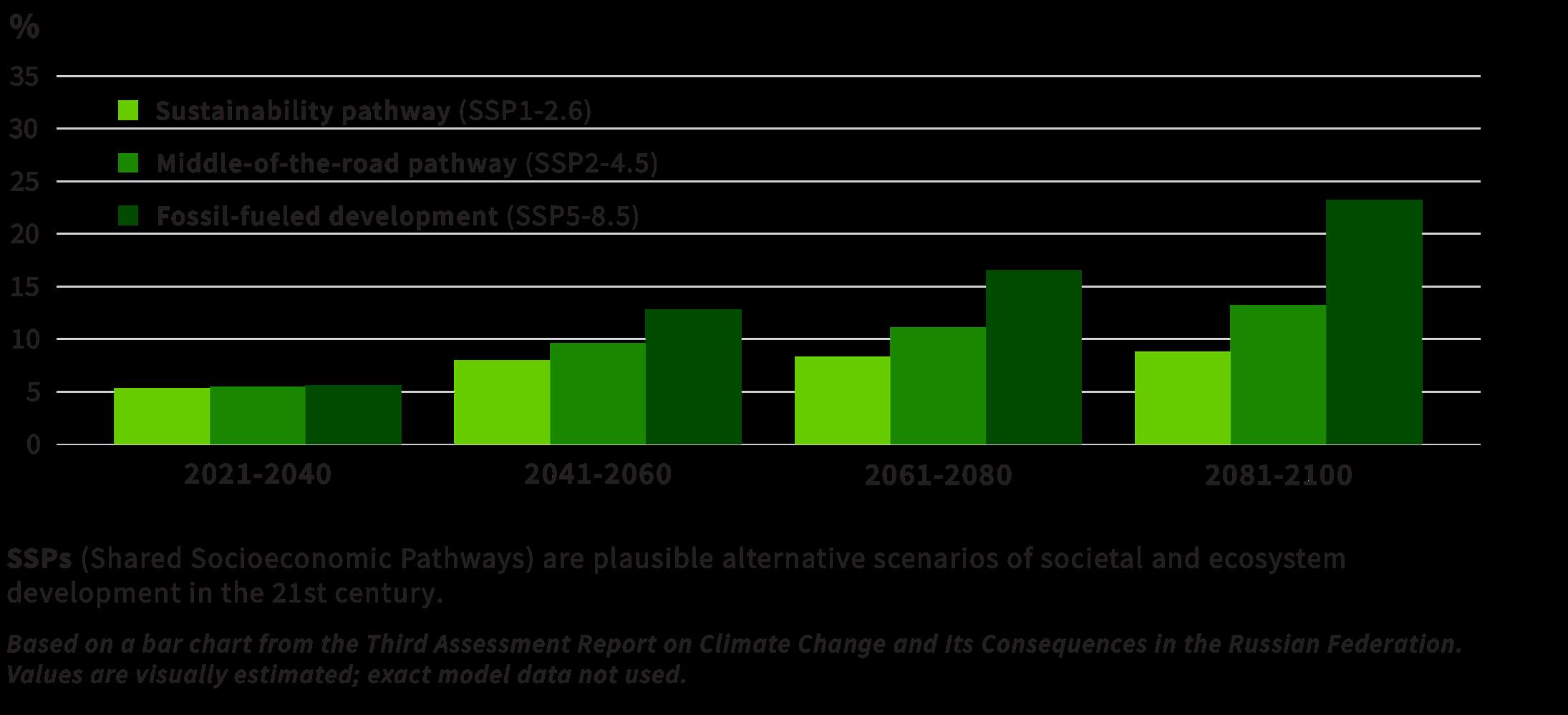
Figure 3. Projected changes in the average annual precipitation (%) across the Russian Federation in the 21st century (averaged for each of the four decades from 2021 to 2100) relative to the baseline period 1995–2014, according to IPCC scenarios. Source: Roshydromet, 2022[3.7]
The area of snow cover over land in Russia is projected to decrease throughout the 21st century, according to model calculations. In the second half of the century, the rate of reduction in the snow-covered surface area is expected to accelerate significantly, reaching 13-25% by 2100. Russia contains more than two-thirds of the world's permafrost, and its thawing is a significant contributor to accelerating climate change. Russia's near-surface permafrost area is expected to shrink by 22-28% by 2050 and by 40-72% by 2100 compared to the 1995-2014 period. [3.7]
These anticipated changes will have profound consequences for both ecosystems and socio-economic systems in Russia.
In recent decades, climate change has continued to shift the boundaries of biomes in many regions of Russia — northwards in the plains and to higher elevations in the mountains. Ecological zones such as tundra, taiga or steppe — are reshaped as temperature and moisture conditions change. For most groups of species and ecological processes, the timing of seasonal biological events (phenological phases) has also shifted: spring phases now occur earlier, while autumn phases are delayed. One of the consequences of this is the desynchronisation between plants and their pollinators — such as the mismatch between flowering and insect activity — is considered a significant threat both to pollinator populations and to agricultural sectors dependent on pollination.[3.7]
The vulnerability of ecosystems in Russian regions to climate change is associated with biotic (such as outbreaks of insect pests and forest diseases) and abiotic factors (forest fires, prolonged droughts and floods, extreme wind and snow-ice conditions). Thawing permafrost intensifies the processes of swamp formation and alters the spatial structure of polygonal and hummocky bogs. Peat fires are becoming increasingly likely everywhere, especially in abandoned drained peatlands.
Changes are both observed and predicted for aquatic ecosystems, not only in streamflow (annual and seasonal), river feeding regimes, the increase in extreme floods and droughts, but also in riverbeds, increased turbidity, higher temperatures, and the related change in the composition and number of aquatic organisms, along with the spread of invasive species1 Rising temperatures combined with eutrophication – an excess of nutrients in water that fuels algal growth and depletes oxygen – lead to a significant decline in water quality.
The growing frequency of hazardous and adverse hydrometeorological phenomena exacerbates soil degradation caused by exogenous processes, such as water and wind erosion, among others. For forested land, one of the main causes of soil carbon loss is wildfires. Wildfires release carbon stored in vegetation and soils; up to 75-80% of that carbon can be lost during high-intensity fires — a process referred to as pyrogenic loss.[3.7]
The increase in air and water temperatures in all Russian seas during the winter period leads to uneven reductions in ice cover area and ice thickness, as well as to the lengthening of the ice-free season.
The state of ecosystems and the intensity of fishing in Russia’s seas depend on the changing physical, chemical and biological characteristics of each specific sea. For example, since 2004, the Barents Sea has seen a reduction and a northward shift in the distribution areas of Arctic fish species, accompanied by an overall decrease in their numbers and biomass, due to the shrinking area of Arctic waters in the sea.[3.7]
Russia’s Far Eastern seas have been warming for the past 30 years, producing a strong impact on marine ecosystems. One of the noticeable consequences has been the migration of tropical and subtropical species of cartilaginous fish (sharks, rays, chimaeras) to areas not previously typical for these species, such as the Southern Kuril Islands and Sakhalin.
Increasing eutrophication of waters and risks associated with harmful algal blooms, both related to global climate and anthropogenic changes, pose yet another serious threat to marine ecosystems.
Climate change is expected to significantly impact Russia's population, economy and quality of life. According to some studies, climate change may result in an increase to mortality rates and morbidity, and directly contribute to migration, both within Russia and across its borders.[3.8][3.9]
The 2010 heatwave in the European part of Russia led to a significant increase in mortality rates, particularly from cardiovascular and respiratory diseases. It is estimated that the heatwave resulted in over 54,000 excess deaths, largely due to extreme heat and severe air pollution.[3.10]
Despite rising average temperatures, cold-related health issues remain prevalent. Prolonged exposure to extremely cold temperatures during winter can lead to death from hypothermia, which is regularly recorded in Russia.[3.11]
Rising temperatures and changing precipitation patterns are altering the distribution of disease vectors, such as ticks and mosquitoes, potentially increasing the incidence of diseases like tick-borne encephalitis and malaria. Ixodes persulcatus, the main vector of tick-borne encephalitis, has expanded north into regions like Arkhangelsk and Yakutia — a trend identified in studies from the early 2010s and likely to continue under current warming conditions.[3.12]
1 Invasive species are organisms that have been intentionally or accidentally introduced from other ecosystems. In new environments, they can spread rapidly, disrupt ecological balance, outcompete native species, and cause damage to the environment, the economy or human health.
[3.13] Anopheles maculipennis , a mosquito capable of transmitting malaria, has also been shifting northeast at approximately 30 km per year and is expected to spread further in Russia.[3.14]
Other hazardous natural phenomena, primarily hydrometeorological events intensified by climate change, such as the 2024 floods in the Orenburg and Tyumen regions, can also lead to fatalities and their frequency and scale continue to grow. The combined effects of extreme weather events and environmental changes put increasing pressure on Russia’s public health infrastructure. This situation demands strong adaptive strategies, including improvements to healthcare services, more resilient infrastructure and enhanced disease surveillance systems.
The shift in climate conditions is transforming migration flows both within Russia and beyond its borders. Rising temperatures worsen living and economic conditions in climate-sensitive regions such as the Russian Far North, Siberia and the Far East, intensifying population outflow from these already depopulated areas. Increasingly, both direct climate impacts, such as forced relocations due
to natural disasters, and indirect effects of climate change, such as the degradation of infrastructure, the economy and labour markets, are influencing migration patterns.[3.15] There is also a high probability of cross-border migration as climate change-driven displacement from neighbouring countries could increase the number of migrants entering Russia. The impact of climate change is particularly significant for Russia’s Indigenous populations, especially those in the North, Siberia and the Far East. These groups face growing threats to their traditional cultures from changing climate and environmental conditions.[3.16]
Both climate change itself and policies aimed at mitigating its effects are expected to have a notable negative impact on Russia’s labour market and employment. Currently, аbnormal weather events and natural disasters already lead to losses in working hours and their frequency and intensity will only increase with further intensification of the climate crisis. Extreme weather conditions, especially heatwaves, decrease productivity, particularly for outdoor physical labour but also for indoor tasks, including the knowledge-based economy.
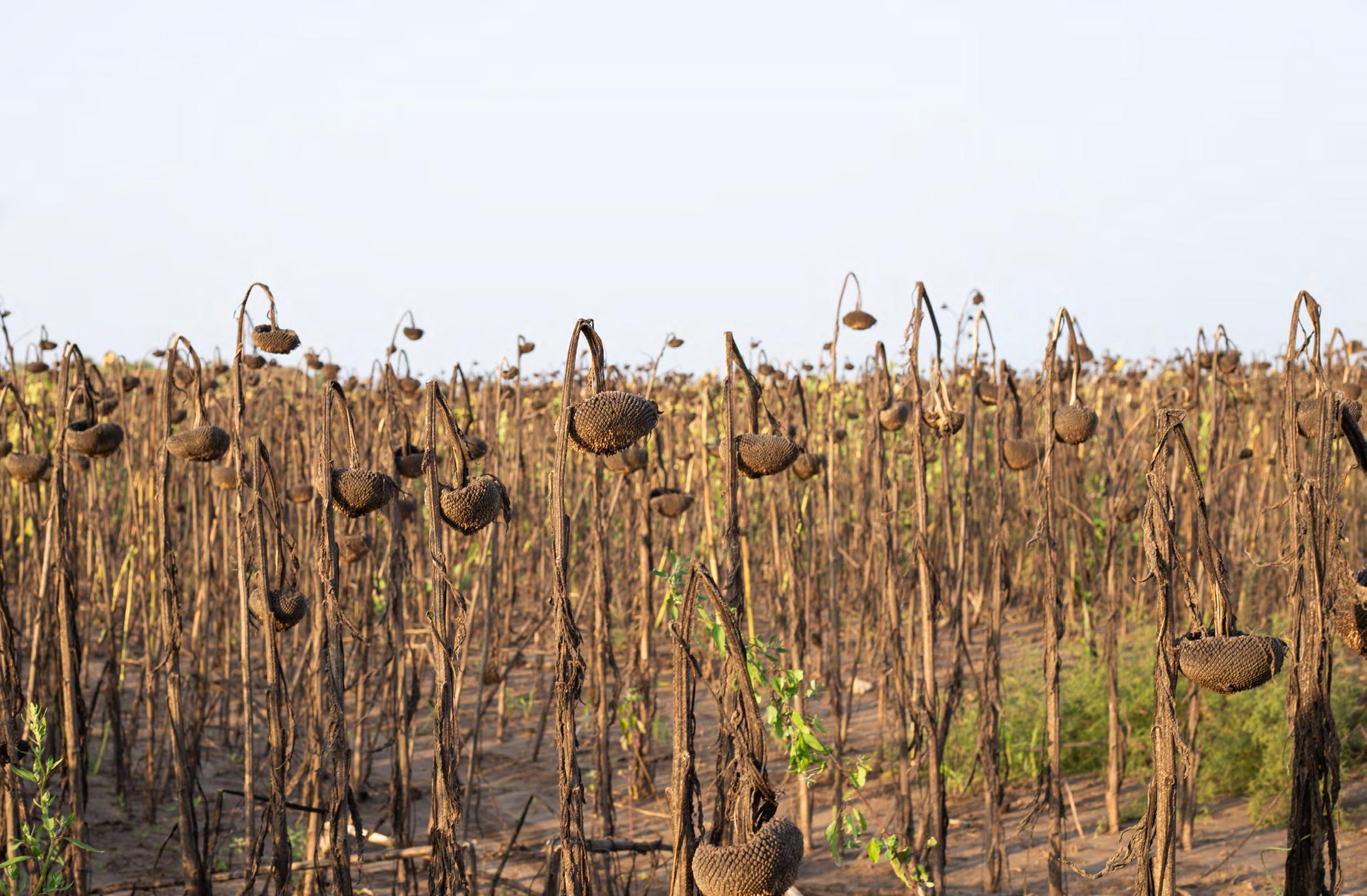
In terms of key industries, Russia's oil and gas sector is especially vulnerable to extreme weather and gradual climate changes. The main risks are associated with infrastructure damage caused by sea level rise, permafrost thaw and coastal erosion. In many areas where hydrocarbons are extracted, a significant share of accidents are linked to meteorological factors. The reduction in ice coverage in Arctic seas is intensifying coastal erosion, which threatens port facilities, while the growing likelihood of wildfires poses a direct threat to oil and gas infrastructure. Short periods of intense rainfall present significant risks for mining operations, as drainage systems were originally designed based on 20th-century climate conditions.
Warmer conditions also lead to the premature melting of 'winter roads' (including those over rivers), which are essential for transportation in northern and northeastern Russia.
The agricultural sector is experiencing its own set of challenges. Increasing aridity and changing precipitation patterns are making the southern and southeastern regions of European Russia more vulnerable to large-scale crop failures. From 1976 to 2015, climateinduced reductions to spring wheat yields were approximately 12%, with a rate of decline of about 3% per decade.[3.17] With projected temperature increases in major grain-producing areas, the climate is expected to become even more arid, worsening growing conditions for grain crops in the 21st century. The damage to crop production observed in the extreme drought years of 2010 and 2012 reached over 300 billion RUB (around 3.8 billion USD).[3.18] Expected shifts in ecological and phenological conditions are expanding the ranges of dangerous pests and agricultural diseases, thereby increasing the risks of significant crop yield reductions.
The number of hazardous hydrological events increased by 13% from the previous decade (2001–2010) to the most recent one (2011–2020). Dangerous floods during the spring thaw have increased by 38%, while ice-jam floods have risen by 15%.[3.19][3.20] Looking forward, the risks of extreme rain-induced floods and prolonged droughts will likely increase.
Forest ecosystems are increasingly vulnerable due to the growing threats posed by wildfires, diseases, pests, windfalls and extreme weather events. The vulnerability of Russia’s forests to disturbances is a major current and future risk. Regional disturbance regimes are expected to intensify, with more frequent and severe wildfires, insect outbreaks and pathogen invasions. Mid-latitude Eurasian forests are particularly at risk from invasive species. For instance, outbreaks of the Siberian silk moth (Dendrolimus sibiricus) can lead to dieback of affected coniferous forests.[3.21]
Although local factors like droughts, hydrological changes and poor forest management contribute to forest decline, growing evidence links these processes to climate and environmental changes.[3.22] By the end of the 21st century, climate change is highly likely to lead to reduced forest biodiversity and further destabilisation of forest ecosystems in Russia.[3.23]
Climate change is projected to have far-reaching effects on Russia's socioeconomic landscape, impacting public health, migration patterns and key sectors such as industry, infrastructure, agriculture and forestry. As these risks intensify, implementing effective adaptation and mitigation strategies will be crucial to the protection of vulnerable communities and vital resources.
Covering over 17 million square kilometres, Russia is the largest country on Earth. Its territory includes vast forests, tundra, wetlands and permafrost regions that are critical to the global climate system, storing enormous amounts of carbon and regulating key processes such as atmospheric circulation, as well as the hydrological and carbon cycles.
As one of the top five emitters of greenhouse gases (GHGs) globally, Russia’s mitigation and adaptation actions – or lack thereof – have a major impact on the international community’s ability to meet the targets set under the The UN Framework Convention on Climate Change (UNFCCC) and Paris Agreement. Russia ratified the Paris Agreement in 2019 and has committed to achieving carbon neutrality by 2060, although its near-term targets under the Nationally Determined Contributions (NDCs) to implementing the Paris Agreement have been criticised for a lack of ambition.[3.1][3.2]
In international scientific and policymaking processes, Russia has historically maintained an active, though sometimes controversial, role. Russian scientists contribute important research on the physical science basis and impacts of climate change, particularly Arctic climate dynamics, permafrost thaw and boreal forest ecology, all of which are crucial to global climate modelling and risk assessments. Russia participates in all major events under the UNFCCC, Intergovernmental Panel on Climate Change (IPCC) processes, and other multilateral climate-related forums, including those of BRICS and G20.
Russia’s position as a major fossil fuel producer and exporter makes its internal energy transition particularly important for global decarbonisation efforts. At the same time, its exposure to climate risks such as wildfires, permafrost degradation and changes to the hydrological regime underscores the growing importance of climate adaptation in its domestic and foreign policies. In the new geopolitical context, Russia remains a strategically vital player: its climate actions influence not only regional but also global climate resilience and sustainability efforts.
Russia’s climate policy has long been characterised by rhetoric rather than tangible action. Despite adopting frameworks like the Climate Doctrine (2009), federal and regional adaptation plans, and a 2050 Low-Carbon Development Strategy, the country’s implementation of policies has been weak and largely ineffectual.
Between 2000 and 2023, Russia’s net greenhouse gas emissions increased by 28% (Figure 4), even as it committed to reductions under the UNFCCC, Kyoto Protocol and Paris Agreement. This growth across all economic sectors underscores the failure of domestic initiatives — from energy efficiency programmes to waste management and forestry policies.
Even the much-publicised Sakhalin carbon trading experiment, a pilot project aiming to test regional emissions trading, has proven to be little more than a symbolic effort. Without a meaningful carbon price, a functional emissions trading mechanism or strict compliance measures, this regional 'sandbox' remains ineffective — and highlights Russia’s broader reluctance to move from pledges to real climate action. The delay in implementing corporate greenhouse gas (GHG) reporting and the lack of enforceable emission quotas reflect a systemic failure to create real incentives for emission reductions, turning what should be substantive policies into mere window-dressing.
In 2022-2023, net GHG emissions continued to rise (+5% in 2023 compared to 2021 levels), according to the Emissions Database for Global Atmospheric Research (EDGAR).[3.24]

Figure 4. Net-GHG emissions in Russia, MtCO2e per year, 1990-2023.
Source: The Emissions Database for Global Atmospheric Research (EDGAR)
Yet in 2024, the Russian government doubled down on narratives, such as that claim that "Russia is a climate donor to the planet", attempting to portray itself as an environmental leader despite actions that starkly contradict this image. Backed by coal and energy lobbyists, authorities have revised the national GHG inventory, introducing "sovereign GHG accounting methodologies" — a move that effectively manipulates emissions data to underreport the country’s true climate impact.
According to the 2024 national inventory submission, Russia’s net GHG emissions declined by 69% from 1990 through 2022, primarily due to the growth of carbon sequestration via a twofold increase in forests.[3.25] Such greenwashing tactics allow Russia to claim progress while sidestepping real decarbonisation. It is unclear whether the international community will trust these updates, but the stakes are high: it is easier to record 'on-paper' carbon-sink increases than to really reduce emissions. Vladimir
Putin personally supports this initiative: the Russian climate monitoring system project appears in the list of key objectives from his Executive Order on national development goals until 2030, and is overseen by the Ministry of Economic Development. The system is being developed with the participation of the Federal Service for Hydrometeorology and Environmental Monitoring (Roshydromet), and 50 leading research institutes united into six consortia.[3.26]
In addition to the reported emissions, there are “hidden” sources of GHGs that remain largely uncontrolled and unreported. One of the most significant of these is methane emissions in the Russian North, which can be observed in satellite imagery — in 2024, the number of large methane emission events detected by satellites in Russia doubled compared with 2023.[3.27] Methane, a potent greenhouse gas, is released from various sources including oil and gas infrastructure, coal mines, landfills and thawing permafrost. While some of these emissions are recorded, many are not captured by official reports, contributing to the underestimation of Russia’s true emissions.[3.28]
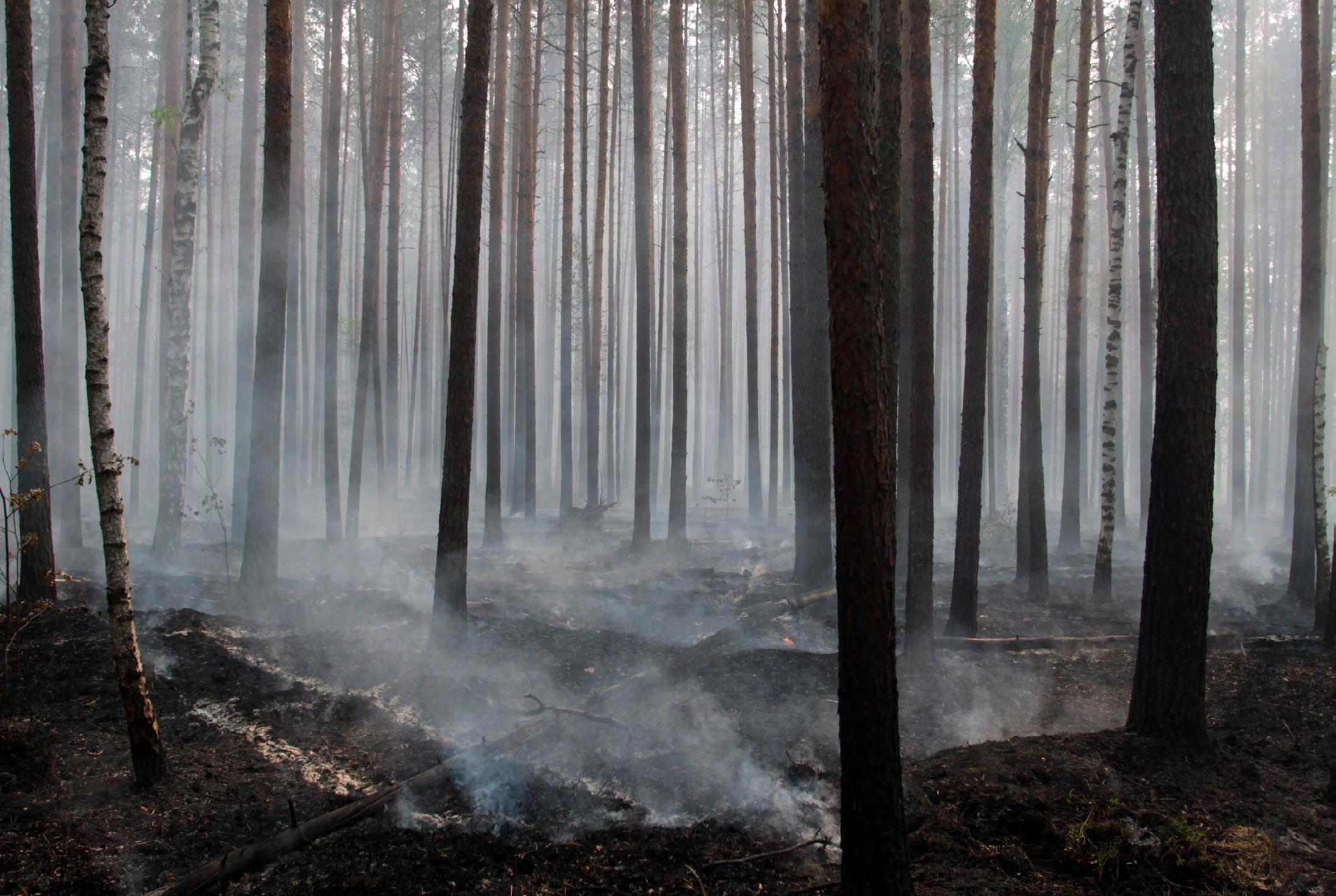
Another significant issue is the underreporting of carbon emissions from forest fires. Forest fires in Russia, particularly during extreme weather events, release substantial amounts of CO₂ into the atmosphere. Official statistics often fail to fully account for the carbon released during these fires.[3.29]
Furthermore, corporate reporting of pollution and GHG emissions in Russia remains unreliable. Many industries fail to accurately report their emissions because of a lack of enforcement, poor data collection systems or deliberate attempts to avoid accountability. This lack of transparency means that a significant portion of Russia’s emissions goes untracked, further undermining the country’s ability to effectively address climate change.
Overall, the ambition to actually decarbonise the Russian economy by 2060 is increasingly viewed as unrealistic, given the current business-as-usual practices, the absence of meaningful policy changes and worsening data manipulation.
On the adaptation side, the National Adaptation Plan has failed to deliver meaningful results in terms of federal budgetary financial support to relevant regions and sectors, leaving vital adaptation efforts unaddressed. Regional authorities have been tasked with handling adaptation with their own money, resulting in a lack of effective action and empty declarations. As a result, the consequences of climate inaction are becoming increasingly evident, with severe environmental, economic and social repercussions in various provinces. These failures highlight the need for urgent and tangible policy shifts to address both mitigation and adaptation challenges.
Russia still holds significant untapped potential for reducing its GHG emissions. Key areas for potential mitigation include:
1. Energy efficiency . Russia's energy sector remains highly inefficient, with large amounts of energy wasted in industrial processes and buildings. Improving energy efficiency, particularly in the residential, industrial and transportation sectors, could lead to substantial emission reductions.
2. Renewable energy. The country has vast untapped renewable energy resources, including wind and solar. So far, Russia has made limited progress in developing renewable energy sources. Solar and wind account for less than 1% of electricity generation.[3.30] Investing in renewables could diversify the energy mix, reduce dependence on fossil fuels and decrease emissions.
3. Green hydrogen production. Green hydrogen, produced using renewable energy sources, has the potential to become a major part of Russia’s future energy strategy. Hydrogen can be used as a clean fuel for various industries, particularly heavy industry, and could help reduce emissions in other sectors.
4. Carbon farming, which uses agricultural practices to increase the capture of carbon in soils and vegetation, and climate-smart forestry, an approach to forest management that both adapts to climate change and enhances carbon storage, can help increase carbon removal. Proper forest management practices, aimed at preventing deforestation and enhancing carbon storage, are essential to ensuring that Russia’s forests continue to function as global carbon sinks and storage.
Russia remains a key element in the global climate system because of its vast natural ecosystems — from Arctic seas to Siberian forests. These territories play an important role in climate regulation and the planet’s carbon cycle. At the same time, as one of the largest producers of fossil fuels and a party to international climate agreements, Russia influences both regional and global efforts to combat the climate crisis.
Russia’s natural environment already faces serious consequences from a changing climate. Rapid warming is causing wide-scale permafrost melt, the destruction of wetland and forest ecosystems, shifting boundaries between biomes, and the risk of biodiversity loss. Forests suffer increasingly frequent fires, pest infestations and disease outbreaks. Threats to aquatic and marine ecosystems are also rising, with changes to river flows, deteriorating water quality, the spread of invasive species, and shrinking ice cover.
The climate crisis increasingly impacts people’s health, quality of life and economic resilience. Anomalous temperatures, floods and droughts lead to rising mortality, damage to infrastructure and agricultural losses. Risks from diseases borne by pests such as ticks and mosquitoes are also on the rise. Extreme weather events disrupt logistics, undermine key industries and exacerbate climate migration, especially from vulnerable regions. The Indigenous peoples of Russia’s North, Siberia and Far East are particularly vulnerable to the consequences of climate change — their traditional way of life and culture are under threat from degradation of the natural environment and lacking support for adaptation.
The Russian regime’s war on Ukraine and pursuit of an extractivist development model have had a devastating impact on the larger country’s climate policies. International cooperation on climate has been seriously weakened as a result of the sanctions and isolation that resulted from the invasion. Key resources were reallocated for military uses, which led authorities to curtail environmental initiatives and abandon Russia’s National Adaptation Plan. Responsibility for adaptation has been shifted onto regional governments, which lack authority and funding, making regional protections from climate-related risks patchy and ineffective. The most vulnerable territories, such as Siberia and the Far East, have been left without support in the face of devastating degradation of permafrost, catastrophic wildfires and extreme weather. At the same time, the state is increasing fossil fuel production and divesting from sustainable energy, which strengthens its dependence on a resource-oriented and high-emission economic model.
A significant portion of Russia’s greenhouse gas emissions is unaccounted for in official reports, making it difficult to assess the country’s real contribution to the climate crisis. Methane emissions are increasing, especially in the Arctic, from leaks in oil and gas infrastructure, associated gas flares, coal mines and melting permafrost. In addition, emissions from forest fires are systematically underestimated. A lack of transparency, effective monitoring and credible reporting undermine both domestic and international efforts to reduce emissions and adapt to climate risks.
Russia’s position on international climate agreements is characterised by a gap between its declarations and its real actions. While it formally participates in key agreements, the country shows a lack of ambition and increasingly resorts to data manipulation. The move to “sovereign” methods of emissions accounting, accompanied by statements about emissions reductions without real actions, undermines confidence in Russia’s reporting and weakens the overall effect of international agreements.
The international isolation caused by Russia’s invasion of Ukraine has led to ruptured scientific connections and curtailed international cooperation in climate research. Loss of access to joint projects and cross-border monitoring weakens not only Russia’s own capabilities, but also the effectiveness of the global climate response.
Nonetheless, Russia retains significant potential to reduce greenhouse gas emissions and mitigate the effects of the climate crisis. There are real possibilities for increasing energy efficiency in the housing, industrial and transport sectors, where significant energy losses persist. The country’s resources would allow for the share of wind and solar, which are currently used minimally, to increase several times over in the country’s energy mix. Projects for carbon sequestration in Siberian forests — including reforestation, climate-smart forestry, and carbon farming — remain promising. With political will and institutional support, these areas could make meaningful contributions toward Russia achieving its climate goals.
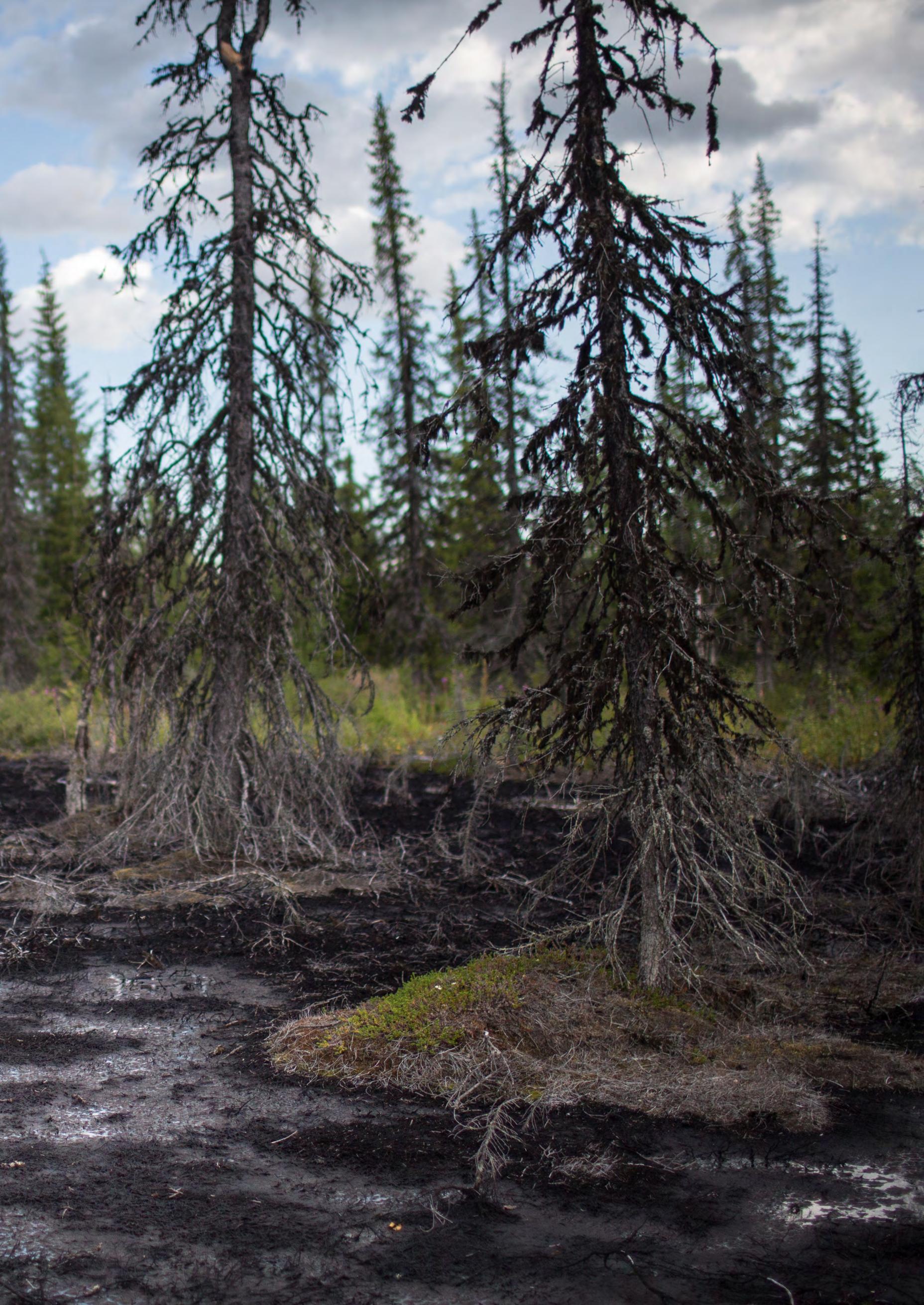
Russia has the largest forest area of any country on Earth. According to official counts, Russian forests occupy more than 7.5 million square kilometres – around 45% of the country’s territory.[4.1] Russia also has large areas of Intact Forest Landscapes (IFL) – the last remaining relatively undisturbed forest ecosystems on Earth.[4.110] However, Russia classifies 52% of its forests as exploitable, meaning that from a legal standpoint they can be developed for extraction of timber and other forest resources.[4.1][4.2] Such forest is mostly located in the taiga (boreal) zone and stretches across Russia’s entire territory, from the north-west to the Far East.
The Forest Code, adopted in 2006, is the basic legal framework governing the protection, management and use of forests. It views forest primarily as a commercial resource, not as an important ecosystem for ensuring the preservation of biodiversity and mitigating
climate change.[4.2] The Code has been amended regularly since its adoption and the majority of amendments have aimed at increasing the exploitation, rather than the protection, of forests.[4.3] Between 2022 and 2024, Russia adopted 11 amendments to the Forest Code.
Notably in 2023, clear-cutting was permitted in protected forests, which are especially valuable forests that fulfil important ecological functions such as protecting soil and water reservoirs, preserving endangered species and others. [4.4] Such territories comprise one quarter of all Russian forests.
Also in 2023, another amendment allowed tourism-related economic activity, including large construction projects for purpose-built facilities such as hotels.[4.4] In 2025, authorities initiated a bill that would allow clearing of mountain forests for the construction of ski areas and other facilities. [4.5]
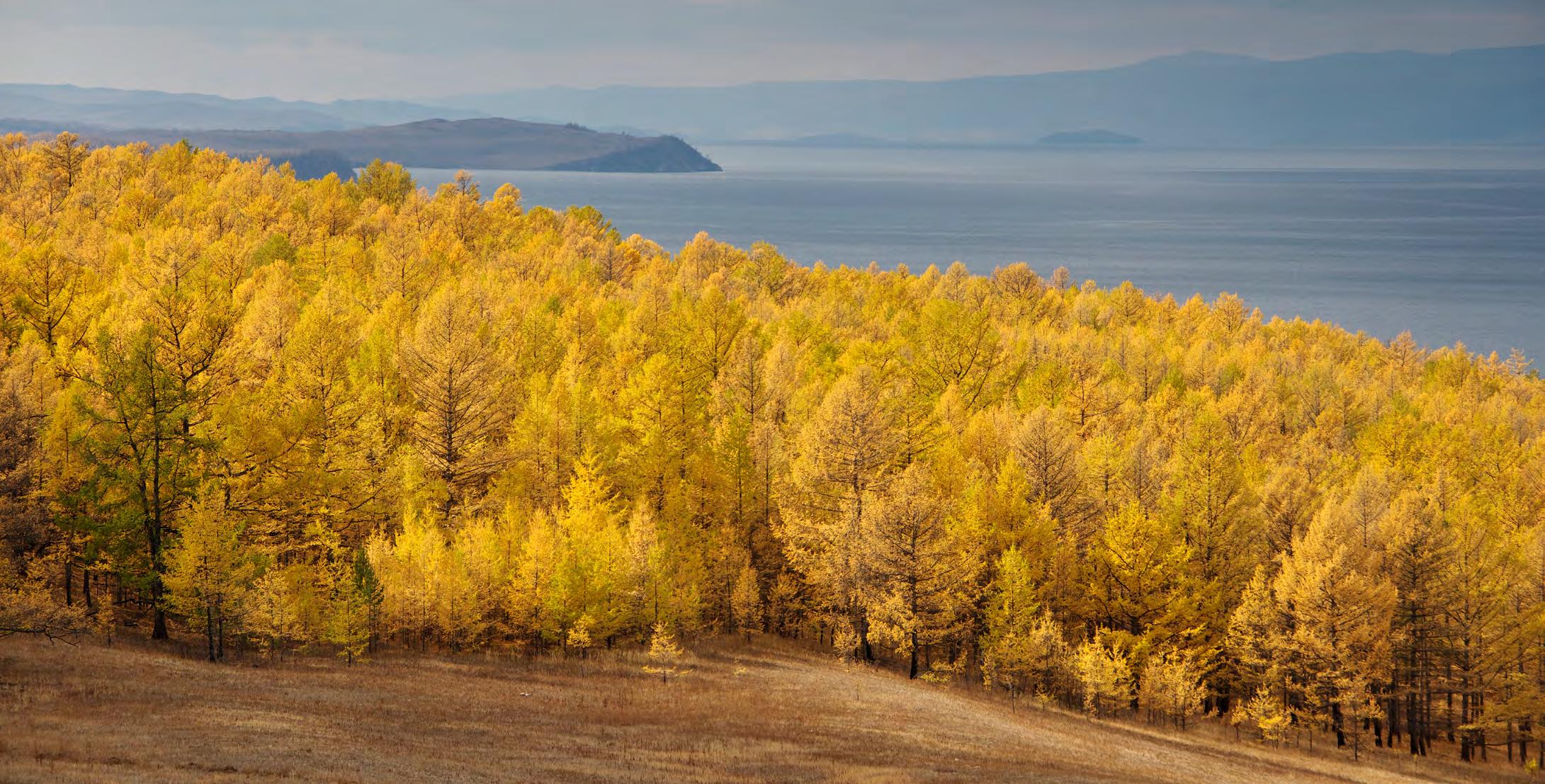
One major shortcoming of Russia’s forest legislation has been a de facto ban on the restoration of forests on land zoned for agricultural use. Much of this land lies abandoned and could be reforested. Estimates of unused agricultural land range from 44 to 76 million hectares – an area equivalent to the territory of one or two Germanys.[4.6] [4.7] However, reforestation in these areas is considered a violation of the law and landowners are required to destroy new tree growth themselves. There was an attempt in 2020 to legalise this type of reforestation but in 2022 the Russian government again made it impossible to restore forest on abandoned agricultural lands.[4.8][4.9][4.10]
In late 2024, amendments to the Forest Code regulating forest-related climate projects were adopted – measures aimed at increasing forest absorption of greenhouse gases. In addition to their important climate function, such projects could promote the development of towns and villages, and improve quality of life in depressed agricultural regions. However, the amendments also banned the implementation of forest climate projects on the vast areas of unused agricultural land.[4.11]
In practice, forestry in Russia is oriented towards the exploitation of forests and maximisation of economic gains, while the management of forest restoration and protection processes remains insufficiently effective. Forested regions located near populated areas are most exposed, since they have developed transport access and infrastructure. However, as resources in these areas become depleted, logging companies are increasingly shifting operations to more remote regions, where they cut intact and pristine forests — the most valuable in terms of biodiversity preservation and climate resilience. [4.12] Experts estimate that Russia has lost around 41 million hectares of pristine forest over the past 20 years.[4.13] However, as a 2024 Accounts Chamber audit showed, Russian authorities have current information on only 17% of the country’s forest stock.[4.14]
In 2023, large-scale forest clearing was recorded in Moscow, including in specially protected natural territories, for the placement of military infrastructure (specifically, air defences) and commercial facilities. The work went ahead without authorities informing the public, while local residents' requests went unanswered. This example shows the extent to which military interests override the norms set by environmental protection legislation.[4.15] Instances of deforestation for military purposes evidently occur in other regions as well, but the lack of accessible data or opportunities for public oversight mean that their full scale remains unclear.
In 2022, the two largest international forest certification programmes, the Forest Stewardship Council (FSC) and the Programme for the Endorsement of Forest Certification (PEFC), halted operations in Russia in response to the country’s full-scale military invasion of Ukraine. This decision led to the cancellation of trade certificates, which effectively eliminated Russian timber from global supply chains focused on sustainable forest management. Additionally, many large consumers of certified forest and paper products, such as IKEA and McDonald’s, have left the country. Russian companies, which generally pay much less attention to questions of sustainable forestry in their procurement practices, have filled those niches. The departure of international certification programmes brings with it risks of increased uncontrolled logging and reduced transparency in the forestry sector. Some logging operations have already begun cutting in previously protected forest regions.[4.16]
The ineffectiveness of reforestation in Russia is evident in the underestimation of areas occupied by dead forests the prevalence of unmanaged overgrowth in clear-cuts and burn scars without necessary human intervention, and a lack of proper care for young forests or a formalistic approach to their reproduction.[4.17] In addition, in particularly valuable territory, restoration work sometimes does more harm than good, as it can interfere with natural forest restoration and disrupt the ecosystem stability.[4.18] There are numerous cases of clear-cutting for timber sales taking place under the guise of protecting forests from diseases and pests.[4.19]
Reforestation is also used by GovernmentOrganised Non-Governmental Organisations (GONGOs) – pseudo-independent entities created or controlled by the state in order to advance its interests under the guise of civil society – to engage with pro-environment communities.[4.20] However, due to a lack of expertise within such organisations, their activities can lead to ecosystem degradation, the spread of invasive species and other negative consequences.[4.21]
Since 2022, the state of the Russian forest industry has changed significantly. This is related to two factors: the introduction by the Russian authorities of a ban on the export of valuable types of unprocessed timber, and sanctions, which have made markets in Europe and other countries of the Global North inaccessible for timber.[4.22]
The volume of timber harvested in Russia in 2022 decreased by 13–15% compared to 2021, totalling 190–195 million cubic metres. Logging has been particularly reduced in north-western regions, which have traditionally been oriented towards export to Europe.[4.23]
Total timber exports fell sharply in 2022 and continued to decline gradually from 2023 to 2024. Figures from 2024 show that exports shrank by around one third compared to 2021, amounting to about 20 million cubic metres.[4.24] The reductions are chiefly in unprocessed timber.
The industry has reoriented to new markets. Following the introduction of sanctions, the share of Russian timber exports going to Asian countries rose from 76% to 98%.[4.25]
The undisputed leader remains China, which received more than half of all exports, followed by Uzbekistan and other Central Asian countries. [4.26] The increase in timber exports to these countries from Russia coincided with an increase in imports by European countries, indicating the circumvention of sanctions and the re-export of Russian timber to Europe.[4.16][4.27][4.28][4.111]
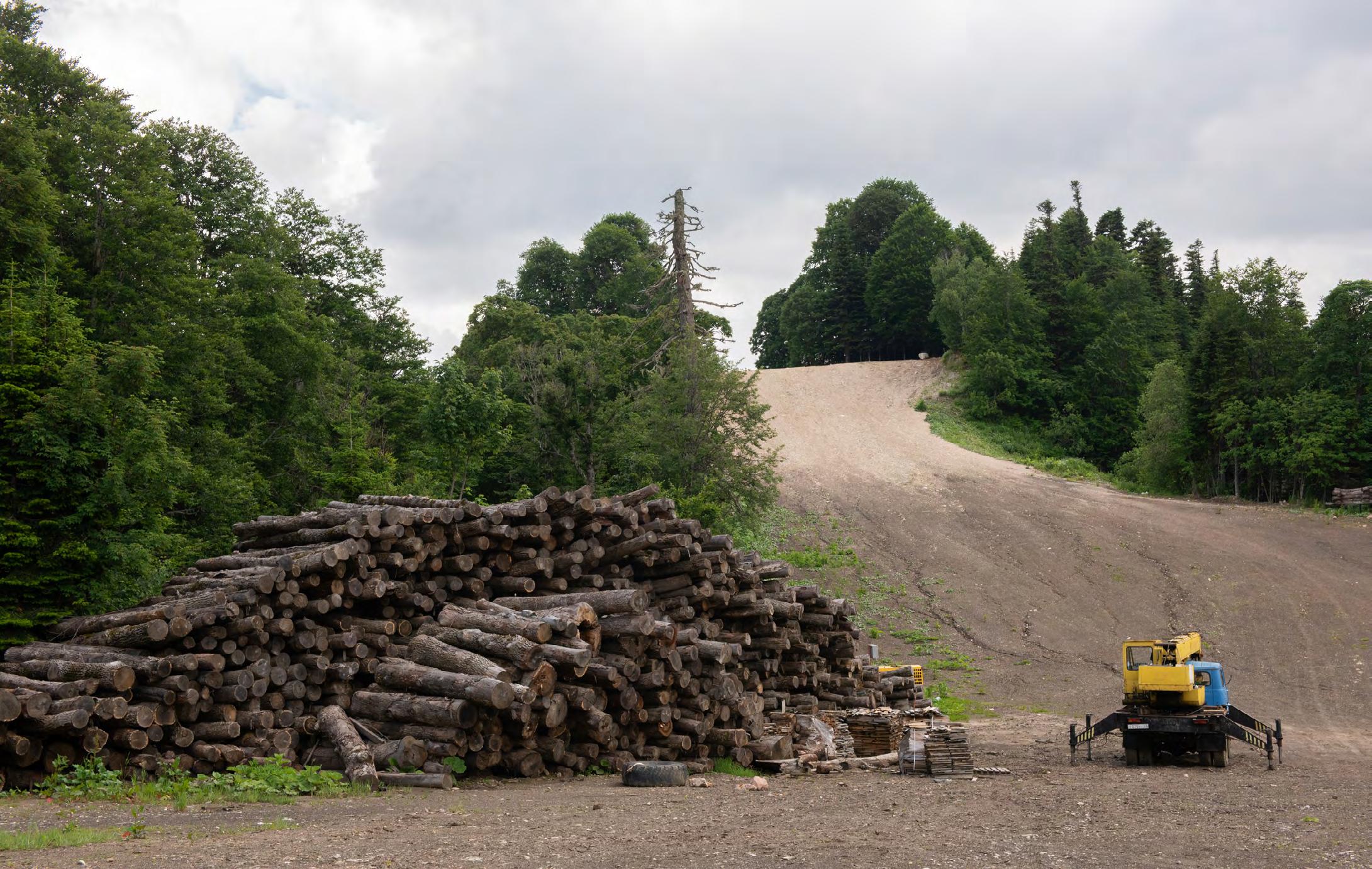
Forest fires are one of the most influential factors affecting the condition of Russian forests and the country’s carbon emissions. According to official estimates, fires have destroyed on average around six million hectares of forest annually over the past ten years.[4.1] In reality, the figures are higher, since government statistics only account for forests growing on Forest Fund land – state-managed territories officially designated for forestryrelated purposes1. Data from Russia’s Aerial Forest Protection Service, a government agency that manages forest fires, shows the extent of forest fires is about 30% higher than the official statistics recorded by the Ministry of Natural Resources.[4.29]
Between 2019 and 2021, Russia experienced the most destructive forest fires in recent years due to the hot summer weather. In 2022 and 2023, the number of forest fires decreased significantly thanks to wetter weather and summers without long periods of anomalous heat in the main taiga regions. [4.30] However, fire damage rose again in 2024, reaching 8.6 million hectares, with the Sakha Republic and Zabaykalsky Krai most severely affected.[4.31] In 2025, the risk of fires is predicted to be higher than average again.[4.32] Climate plays a key role in forest fire dynamics in Russia, and in the context of intensifying climate crisis, the situation is expected to worsen further in coming years.
A positive trend in recent years has been the reduction in the number of spring wildfires, which were previously mainly associated with stubble burning. This reduction was possible thanks to the active work of environmental organisations, including Greenpeace, which pursued a ban on burning dry vegetation in the 2010s and conducted wide-scale public education campaigns.[4.33][4.34] As a result, between 2014 and 2019 authorities adopted several regulations on spring stubble burning, and in 2023 introduced a one-year moratorium. These measures, combined with public education, have significantly reduced in stubble burning: from 2015 to 2024 springtime wildfire volume decreased by almost half compared to the previous decade.[4.35]
At the same time, the more dangerous summer–autumn peak season for wildfires is intensifying in connection with deep systemic problems. The State Forest Service is chronically underfunded, resulting in staffing and equipment shortages.[4.36][4.37] Irrational administrative requirements to clear agricultural land of vegetation, along with fines for noncompliance, push landowners to burn grass and young forest. Meanwhile, millions of hectares of agricultural land have been left abandoned and unprotected from fires.[4.35] Independent environmental organisations and volunteer groups, including Greenpeace Russia, that have actively participated in preventing and extinguishing fires as well as promoting care for forests, have been shut down or come under pressure. Weakened civil controls and the absence of a free press have led authorities to use resources ineffectively and distort statistics.
After 2022, fires associated with military activity became an additional important factor in assessments of wildfire damage. Research conducted in Ukraine demonstrates that military activity has a significant impact on the spread and intensity of fires.[4.38]
Although the scale of military fighting on Russian territory is significantly smaller than in Ukraine, this factor requires special attention, especially in the Kursk region, border areas and zones subject to drone, missile and artillery attacks. Currently, strict censorship regimes limit access to reliable information about the scale of such damage and independent investigations of the impact of military activities on Russia’s fire situation are lacking.
1 This land forms the core of Russia’s forest governance system. However, not all forests in Russia grow on Forest Fund land – some forests may be located on agricultural land, in urban territories, or on land comprising other legal categories.
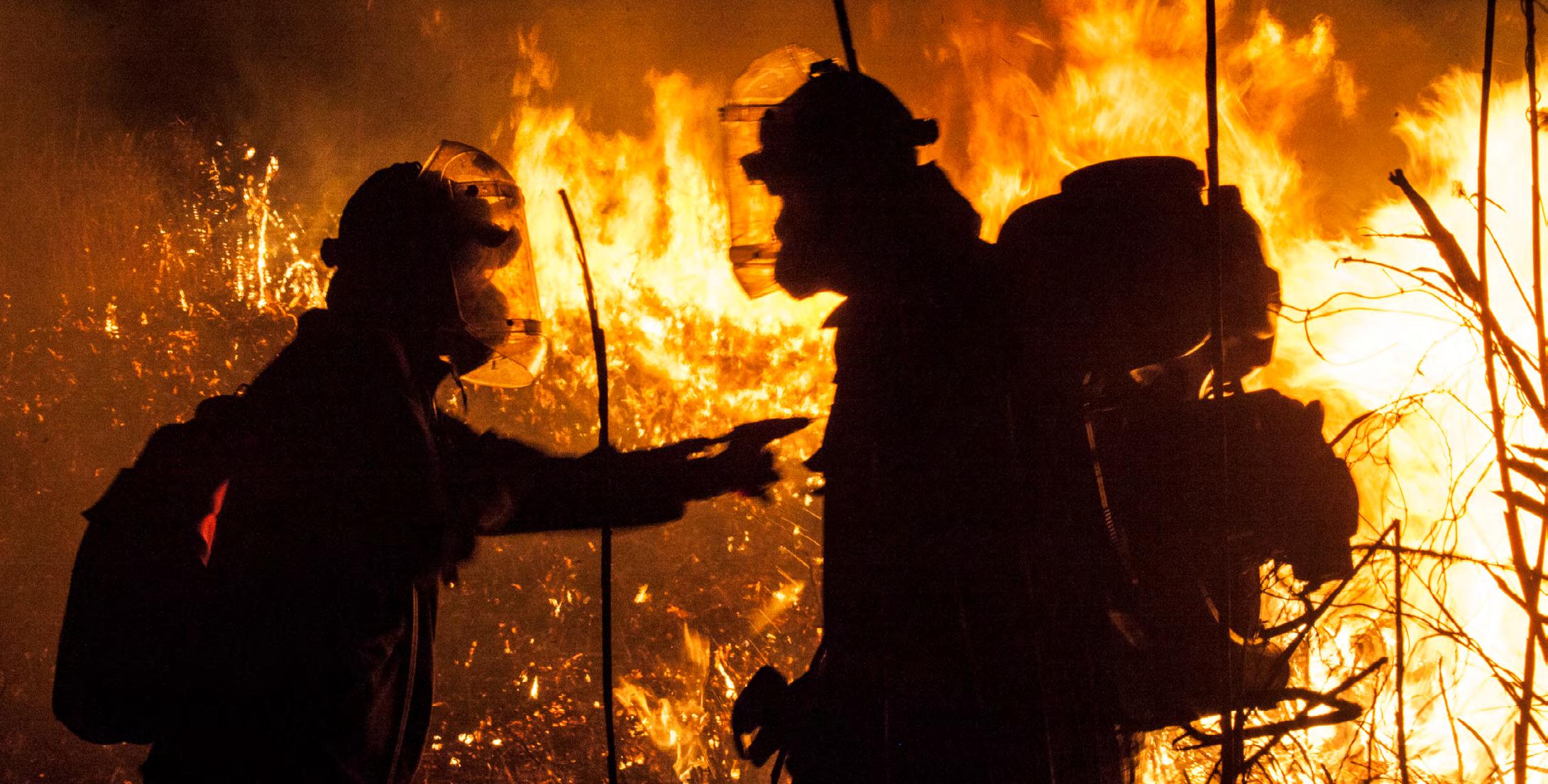
Firefighting expedition in the Astrakhan Biosphere Reserve © Anonymous
At present in Russia, there are 12,000 Specially Protected Natural Areas (SPNAs), with varying statuses and levels of protection. Among them are 11 UNESCO World Natural Heritage sites.[4.39] SPNAs occupy about 13% of Russia’s land area and 3% of the aquatic area included in its territorial waters and exclusive economic zone.2[4.1] These figures are lower than the global targets set by the Convention on Biological Diversity, to which Russia became a party in 1995. According to Convention global targets, by 2020 countries were expected to protect 17% of terrestrial and inland waters and 10% of coastal and marine areas, with a further target of 30% of all land and aquatic areas worldwide by 2030.[4.40][4.41]
In 2020, the Ministry of Natural Resources announced that it was drafting a Strategy for the Development of the SPNA system in Russia for the period up to 2030. According to the Strategy’s proposal, the share of terrestrial protected areas would increase to 17% and marine areas to 10%.[4.42] However, that version of the strategy was never adopted. In early 2025, discussions began for a new version
2 The information from this source includes Ukrainian territory and waters illegally occupied by Russia. This distortion does not have a significant influence on the general figures presented in this chapter.
of the Strategy, this time for the period up to 2036. The updated version retained the 17% target for protected land areas but reduced the target for aquatic SPNAs to 5%.[4.43] Thus, Russia’s goals for increasing protected territories are significantly less ambitious than those set by the Convention on Biological Diversity.
Although the total area of SPNAs has increased slightly in recent years, on the whole Russia’s system of nature reserves has degraded since the 2000s. [4.44][4.45] This is related first and foremost to commercialisation (resource extraction, tourism and the exclusion of territories from protection for development purposes) and to the poor management of the SPNAs system. The state views SPNAs as sources of potential profit, while the institutions charged with protecting them are weakened.
This trend did not change after 2022, whereafter legislation relating to SPNAs continued to deteriorate. Many particularly valuable areas, including UNESCO World Heritage sites, have been reduced or placed under less stringent protections. Several projects aimed at organising new protected territories or expanding existing ones remain incomplete.
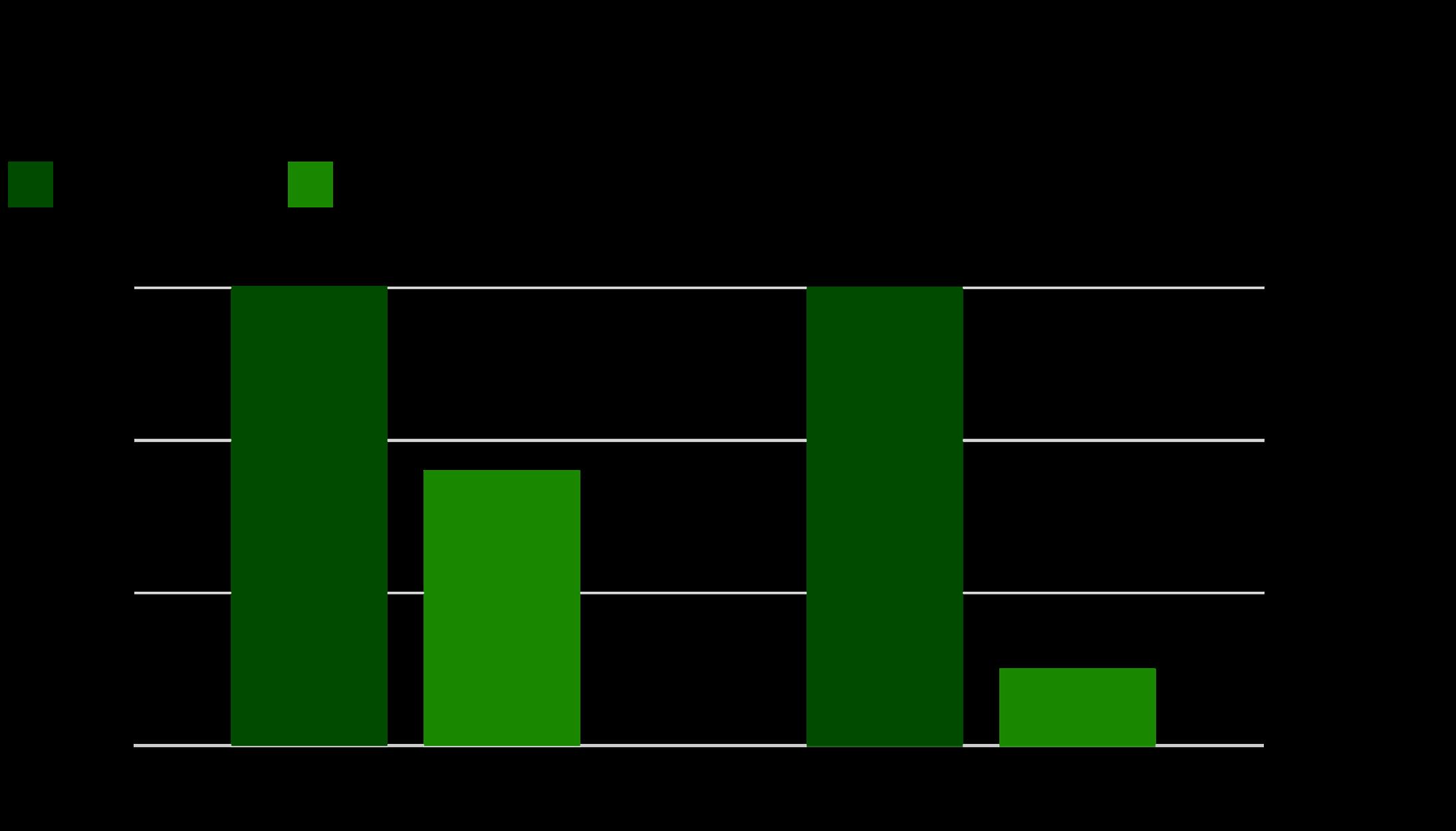
Examples include the Pompeevsky National Park for the preservation of the Amur tiger; the Kamchatka Volcanoes National Park, on the territory of a World Heritage site of the same name, and the expansion of the Saylyugemsky National Park for preservation of biodiversity in the Altai Mountains.[4.46][4.47][4.48]
The state has declared Greenpeace and WWF –the largest of the environmental organisations doing systemic work towards the preservation of protected territories in Russia — as “undesirable” organisations.
In recent years, various lobbies have made attempts to weaken legislation around SPNAs, and a number of them have succeeded.[4.49][4.50]
In spring 2022, Russia’s legislature amended a number of laws, including environmental protections, to establish “priority for infrastructure projects” in protected areas. [4.51] These changes have simplified construction of infrastructure and industrial facilities in SPNAs. [4.52]
In spring 2023, the legislature approved a law allowing the construction of tourist facilities, including large ones, on SPNA territories.[4.53][4.54] This increased the likelihood that SPNAs might be turned into construction sites for ski areas and other tourist infrastructure.[4.52]
In summer 2024, another law was adopted transferring authority over the protection and use of SPNAs from federal to regional level, potentially facilitating their commercial development.[4.55]
In spring 2025, the Ministry of Natural Resources initiated the repeal of a number of regulations restricting economic activity on SPNA territories.[4.56]
Ineffective personnel policies in Russia’s nature reserve system have led to an outflow of specialists, the expansion of non-protective activities, and conflict with local populations.[4.57][4.58] There are recorded cases of SPNA employees even facing criminal prosecution for carrying out their professional activities.[4.59][4.60] In addition, there is a notable shortage of scientific staff – in 2023, there were on average only two scientific employees per federally protected area.[4.1][4.61]
Examples of Russian SPNA degradation occurring or continuing since 2022:
• A bill allowing clear-cutting of forests in the Central Ecological Zone of the Lake Baikal region, a World Heritage Site.[4.62][4.63] Some of the legislative deputies who initiated the bill have affiliations with tourism;[4.64]
• The transfer of part of Losiny Ostrov National Park to Moscow authorities’ management and the planned construction of a new seven-kilometre highway through its territory; [4.65][4.66][4.67][4.68][4.69]
• Changing borders and territorial fragmentation of Numto nature park in the Khanty-Mansi Autonomous Okrug for oil exploration and extraction, despite protests from Indigenous Nenets and Khanty peoples for whom these territories are sacred;[4.70][4.71]
• The exclusion of 3,000 hectares of Ladoga Skerries National Park for the construction of tourist facilities;[4.72][4.73]
• Allocation of areas of Sochi National Park for the construction of ski resorts and other commercial facilities;[4.74]
• Allocation of areas of Tunkinsky National Park for construction of the Power of Siberia 2 natural gas pipeline;[4.52]
• The seizure of 15,000 hectares for the construction of a ski resort in YuzhnoKamchatsky nature park, which is part of the Volcanoes of Kamchatka UNESCO World Heritage Site [4.75]
• The seizure of 325,000 hectares from the Yamalsky regional reserve for gas extraction;[4.45]
• Downgrading the protected status for all 146 of Moscow’s SPNAs, which facilitates their exploitation for ends unrelated to nature conservation;[4.76]
• Plans to reallocate territories from the Samarskaya Luka National Park for a tourist resort; [4.77][4.78]
• The planned construction of a major ski resort on the Lago-Naki Plateau in the Caucasus Biosphere Reserve, a World Heritage Site;[4.79]
• Plans to mine gold in the protected zone of the Sikhote-Alin Biosphere Nature Reserve, part of the Central Sikhote-Alin World Heritage site [4.80]
• Plans to build a multi-storey hotel complex in the protected zone of the Curonian Spit National Park, along routes used by migratory birds.[4.81]
At the same time, public opposition and actions by the expert community have stopped several attempts at weakening regional SPNAs.[4.82]
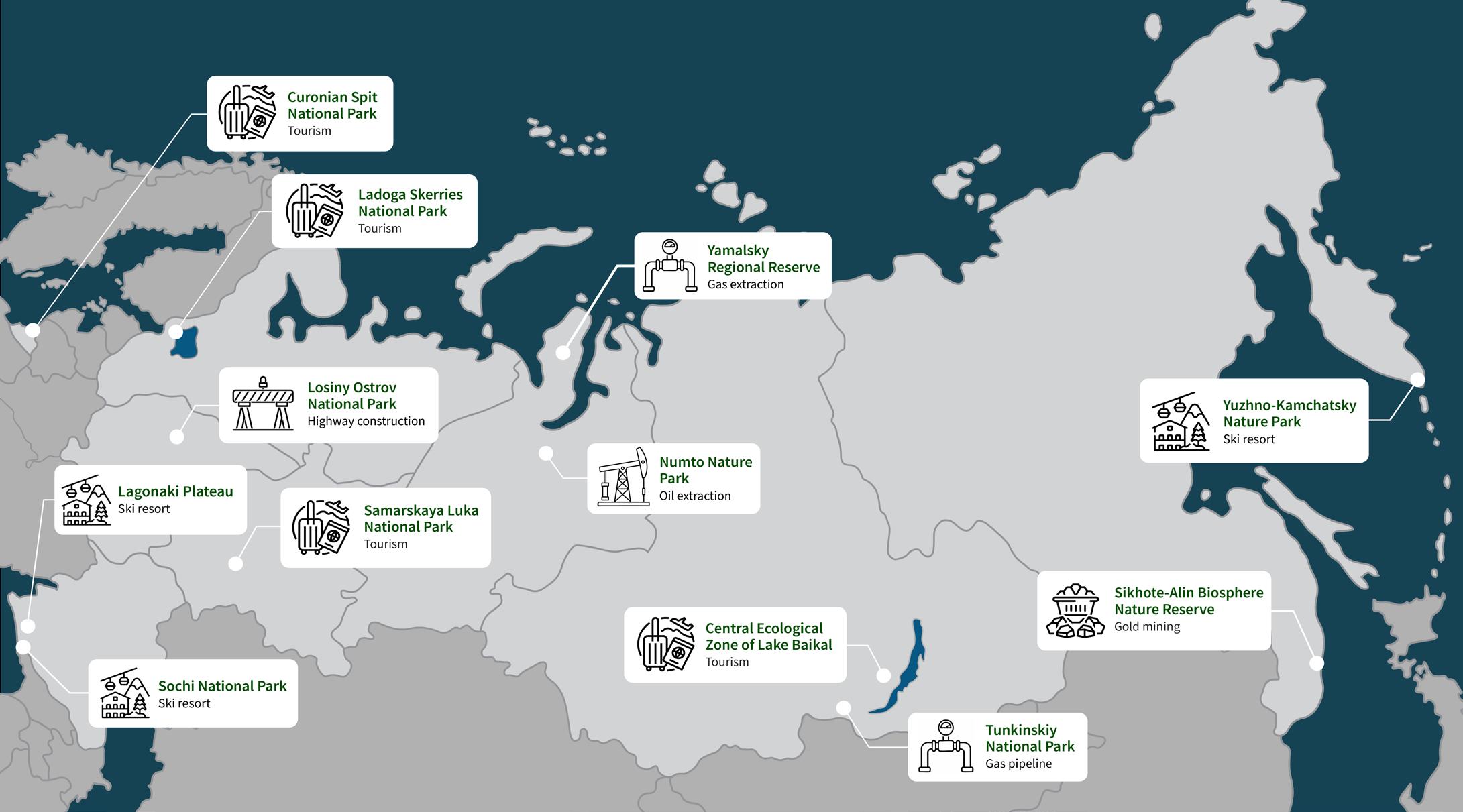
Russia is home to 1,230 rare and endangered species, including 740 species of plants and fungi, and 490 species of animals.[4.1] Of all species inhabiting the country, 9.5% are threatened with extinction, with another 5.2% close to threatened status. By both the total number of species included in the International Union for Conservation of Nature’s Red List of endangered species, and the relative number under threat of extinction, Russia ranks around the global average.[4.83]
Between 2019 and 2024, within the Ecology national project framework, Russia’s federal government allocated priority funding for the preservation of 13 endangered species: the Amur, Caucasian and snow leopards; Amur tiger; European bison; saiga antelope; Przewalski’s horse; Altai argali; Mongolian gazelle; polar bear; Siberian crane, and bowhead and grey whales. Since 2025, the Russian desman, reindeer, great bustard and falconiform birds have been added to the list. Many of these species have been used in publicity campaigns aimed at boosting Vladimir Putin’s popularity, with projects for the preservation of rare species presented as his personal initiative.[4.84][4.85][4.86]
A number of endangered species are excluded from the priority list and their preservation receives inadequate attention despite declining populations. These include the spoon-billed sandpiper, Caspian seal and Black Sea cetaceans, which were particularly badly affected by an oil spill in late 2024.[4.87][4.88][4.89][4.90]
The government’s poor record in conserving populations of rare species reflects a broader crisis of environmental preservation in Russia.
Logging, mining and poaching continue to destroy the habitat of the Amur tiger; reduced food supply has led to instances of attacks on humans, which in turn leads to tigers being shot. [4.91]
When implementing projects to restore endangered species, scientific expertise is frequently sidelined in favour of ostentatious PR campaigns involving high-ranking officials. One telling example is the staged release of a leopard into the wild, after which it was shot.[4.92]
In some cases, endangered species are exploited for commercial purposes. Whale meat, which is only permitted for the domestic needs of Indigenous peoples, can be found for sale in online marketplaces. [4.93] Poachers also continue to exterminate endangered species for the export of animal parts to China for use in traditional medicine. [4.94]
A lack of proper protections and controls over the migration of dzerens, classified as a priority species, led to a mass mortality event when they were hit by a train in the Zabaykalsky region. [4.96]
Ineffective regulation of commercial fishing harms protected marine mammals, which are killed in fishing nets and suffer from depleted food supplies. [4.97][4.88]
Russia’s isolation due to the war in Ukraine has also led to a significant decrease in international scientific cooperation in the field of biodiversity. Research funding once supplied by grants from international and foreign organisations has been significantly reduced.[4.98][4.99] At the same time, Russian organisations and state agencies allocate insufficient funds for independent scientific research.[4.100]
In Russia, as in the Soviet Union, trophy hunting serves as a means for an individual to signal status within the political and financial elite. The practice has intensified in recent years against a backdrop of growing militarism and a cult of hyper-masculinity. Furthermore, the value of a trophy depends largely on the rarity of the killed animal. Many of the country’s highranking officials are active in trophy hunting and a vigorous hunting lobby exists in both the State Duma and the Government.[4.101][4.102]
Recent years have seen the following legislative changes:
• In 2021, a ban on shooting endangered species was lifted.[4.103][4.104]
• In 2022, a law was passed loosening regulations on the use of hunting rifles by foreigners, aiming to attract tourists for trophy hunts and further commodify Russia’s wildlife.[4.105]
• In 2023, the Ministry of Natural Resources attempted to expand the grounds for hunting rare species but the bill was withdrawn following public outcry. In 2024, the ministry put the initiative forward again.[4.106]
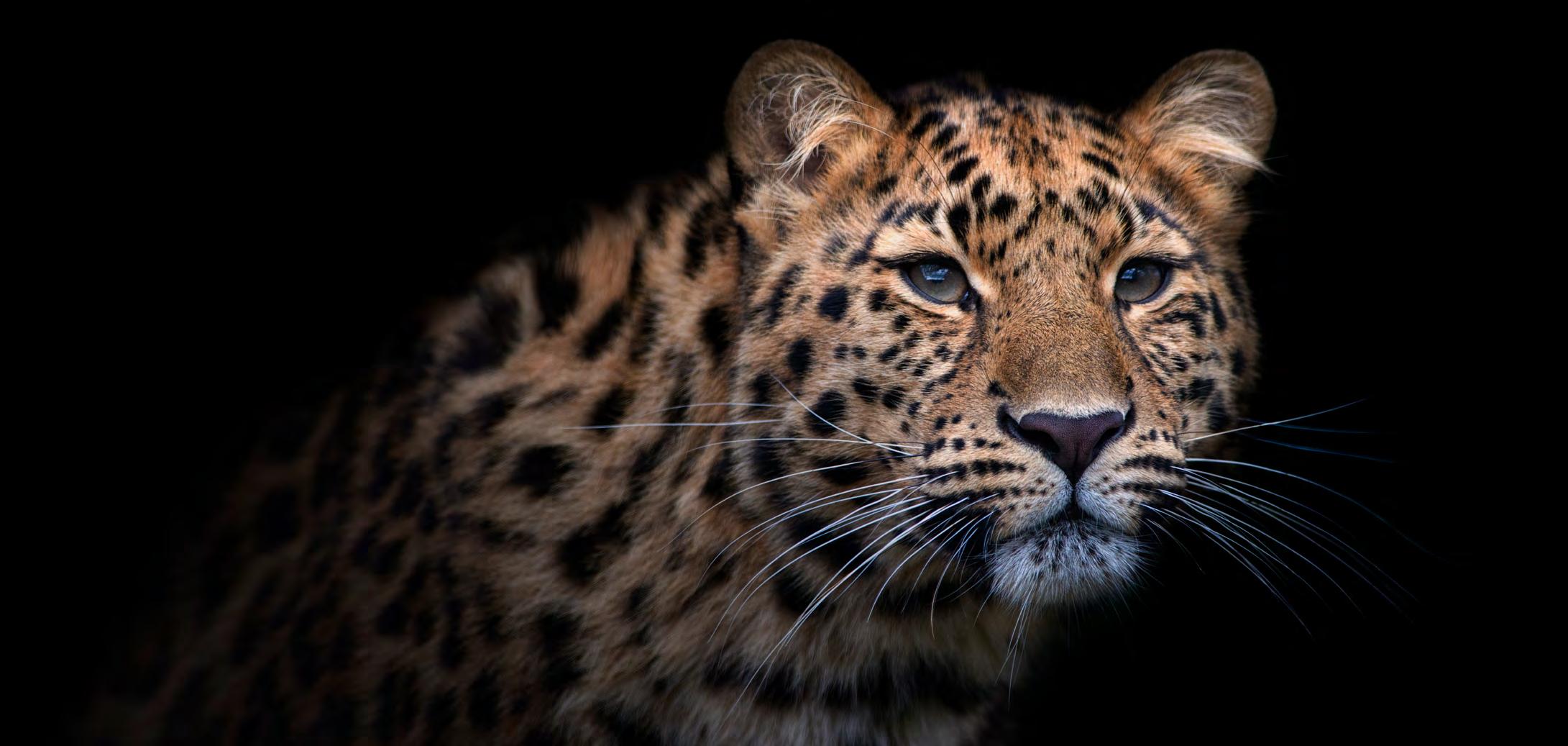
Climatic changes and ecosystem degradation also pose a threat to endangered species and biodiversity as a whole. Melting permafrost is destroying tundra ecosystems, while shrinking sea ice makes it increasingly difficult for polar bears to find food.[4.107] Marine mammals are also extremely vulnerable in the face of a changing climate.[4.108]
Climate change, coupled with an increased volume of transported goods, leads to the spread of invasive species. These are capable of altering the structure and function of the ecosystem, as well as displacing native organisms. European parts of Russia, especially the North Caucasus, the eastern coast of the Black Sea, and the Leningrad and Moscow regions, have seen the greatest spread of invasive species. [4.109]
Russia remains a key custodian of global biodiversity thanks to its vast forested area and diversity of natural zones. A wide range of geographic and climate conditions supports high species richness, an abundance of rare and endemic species, and the availability of vast, undisturbed natural areas.
• Half of Russia’s forests are classified as exploitable, which makes them vulnerable to commercial development. Recent legislative changes and policy around natural objects indicate a shift in priorities from conservation to economic exploitation. Procedures for removing high-value natural areas from protection in favour of commercial use are being simplified. After 2022, Russia allowed clear-cutting in protected forests and limited reforestation on abandoned land.
• The forestry industry in Russia is undergoing transformation: sanctions have seen export volume decrease and the market has shifted to China and Central Asian countries, which has increased the pressure on Siberian forests. Furthermore, Russian timber continues to reach Europe via re-export.
• Logging is now increasingly affecting intact and pristine forests, especially in Siberia and the Far East. The withdrawal of international forest certification systems from Russia has heightened the risk of uncontrolled cutting and losses of valuable natural territories. At the same time, the quality of forest restoration remains low.
• Forest fires continue to pose a serious environmental threat. Spring fires have been reduced thanks to previous efforts by environmental organisations, public education campaigns and bans on stubble burning. Simultaneously, the intensity of summer–autumn fires is growing as a result of the climate crisis, underfunded forest protection, abandonment of agricultural land and the weakening of the civil sector.
• Government policies aimed at commercial and infrastructural development are consistently weakening Russia’s system of Specially Protected Natural Areas. Investor interests, the tourism industry and resource extraction companies increasingly take priority over protecting valuable ecosystems. The ongoing revision of boundaries and reduction of natural areas protections, including of areas listed as World Heritage Sites, demonstrate the state’s systemic refusal to fulfil the international obligations that Russia assumed when it became a party to the Convention on Biological Diversity and the Convention Concerning the Protection of the World Cultural and Natural Heritage.
• A distinctive feature of Russian policy on natural areas is the lack of a comprehensive strategy aimed at maintaining ecosystems and preserving biodiversity. The government is not implementing long-term plans for the development of a system of protected areas, and is ignoring the global target of protecting 30% of land and marine waters by 2030. Instead, it gives priority to the commercial exploitation of valuable territories.
• War and rising authoritarianism create conditions for increased pressure on natural areas. Military facilities are located in protected zones, and military actions are highly likely to lead to wildfires, not only on Ukrainian territory, but also in Russia itself. At the same time, civil control has been weakened, the country’s leading independent environmental NGOs have been banned and the transparency of governmental activities has been reduced. This contributes to the destruction of natural objects for commercial and military uses. Local communities, Indigenous peoples and NGOs are increasingly unable to defend vulnerable territories from pressure by the state and business.
• The system for protecting endangered animals focuses on increasing population numbers rather than habitat restoration. Selective support for “priority” species used in PR campaigns has replaced an integrated approach to preserving biodiversity. As a result, a significant portion of vulnerable species remains outside the scope of government programmes, despite shrinking populations and habitat degradation.
• Climate change adds further pressure to ecosystem destruction, reducing food supplies and promoting the spread of invasive organisms, all posing an additional threat to endangered species. Instead of implementing a comprehensive adaptation strategy for threatened species, the government prioritises commercial and hunting ecosystem uses, including trophy hunting, actively promoted by high-ranking officials.
• Russia’s isolation as a result of its fullscale invasion of Ukraine has disrupted international scientific cooperation and led to a loss of foreign funding for independent environmental researchfunding that has not been replaced by the Russian state.
In summary, recent Russian policy in the field of biodiversity has become increasingly detached from genuine nature protection targets. The government continues to view forests and other natural areas primarily as resources for exploitation, while their role in the conservation of biodiversity, climate regulation and sustainable development remains on the periphery of governmental and economic priorities. This approach accelerates biodiversity loss, ecosystem degradation and a reduction in the ability of natural areas to mitigate the consequences of the climate crisis.
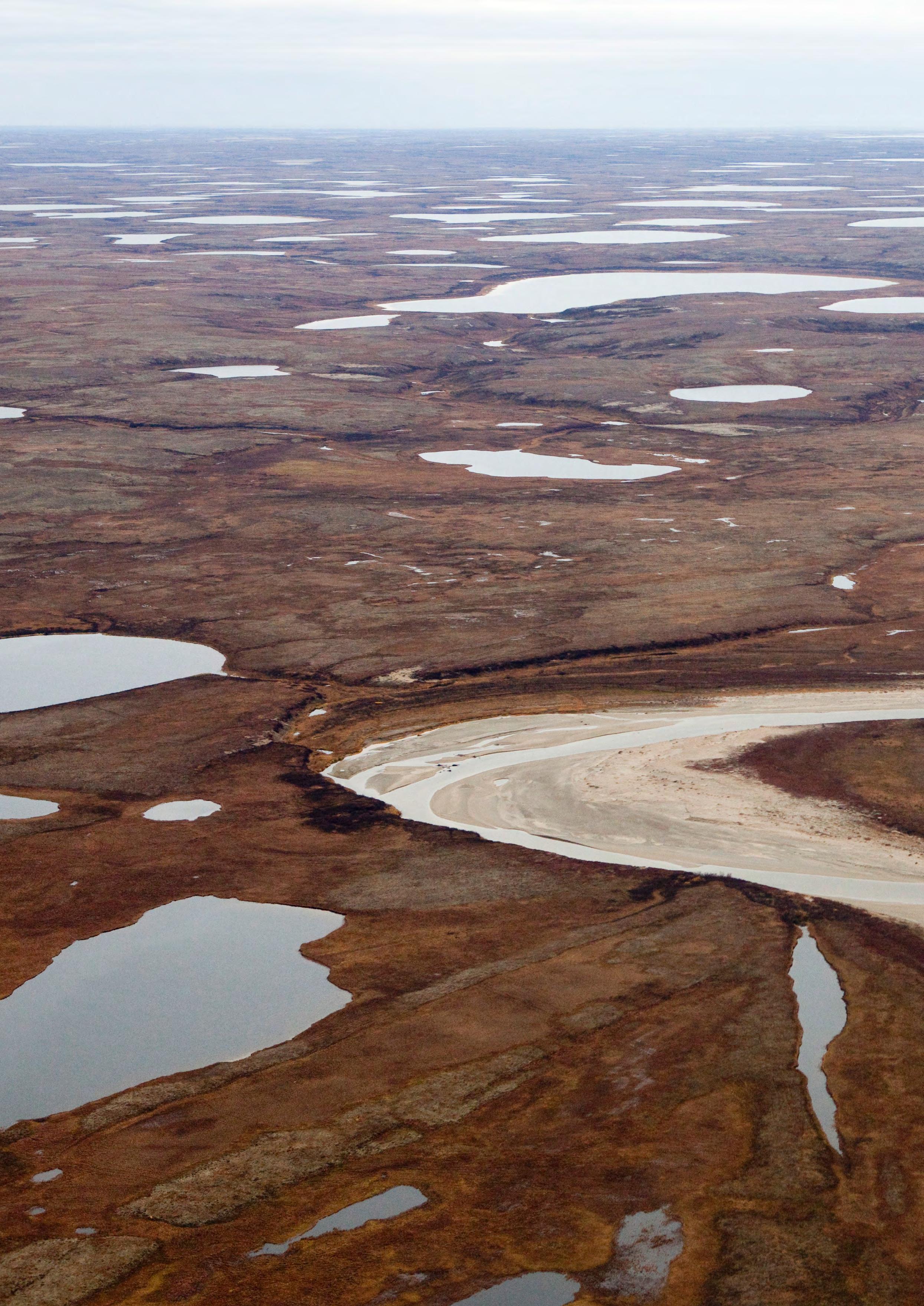
The Arctic occupies around 30% of Russia’s land territory yet is home to less than 2% of the country’s population, including Indigenous Peoples engaged in traditional ways of life. [5.1] The region plays an important role in global climate regulation, serves as habitat for endangered species of flora and fauna and hosts unique ecosystems. However, the Arctic’s fragile nature faces ever-increasing threats from military and industrial development, a changing climate and environmental pollution.
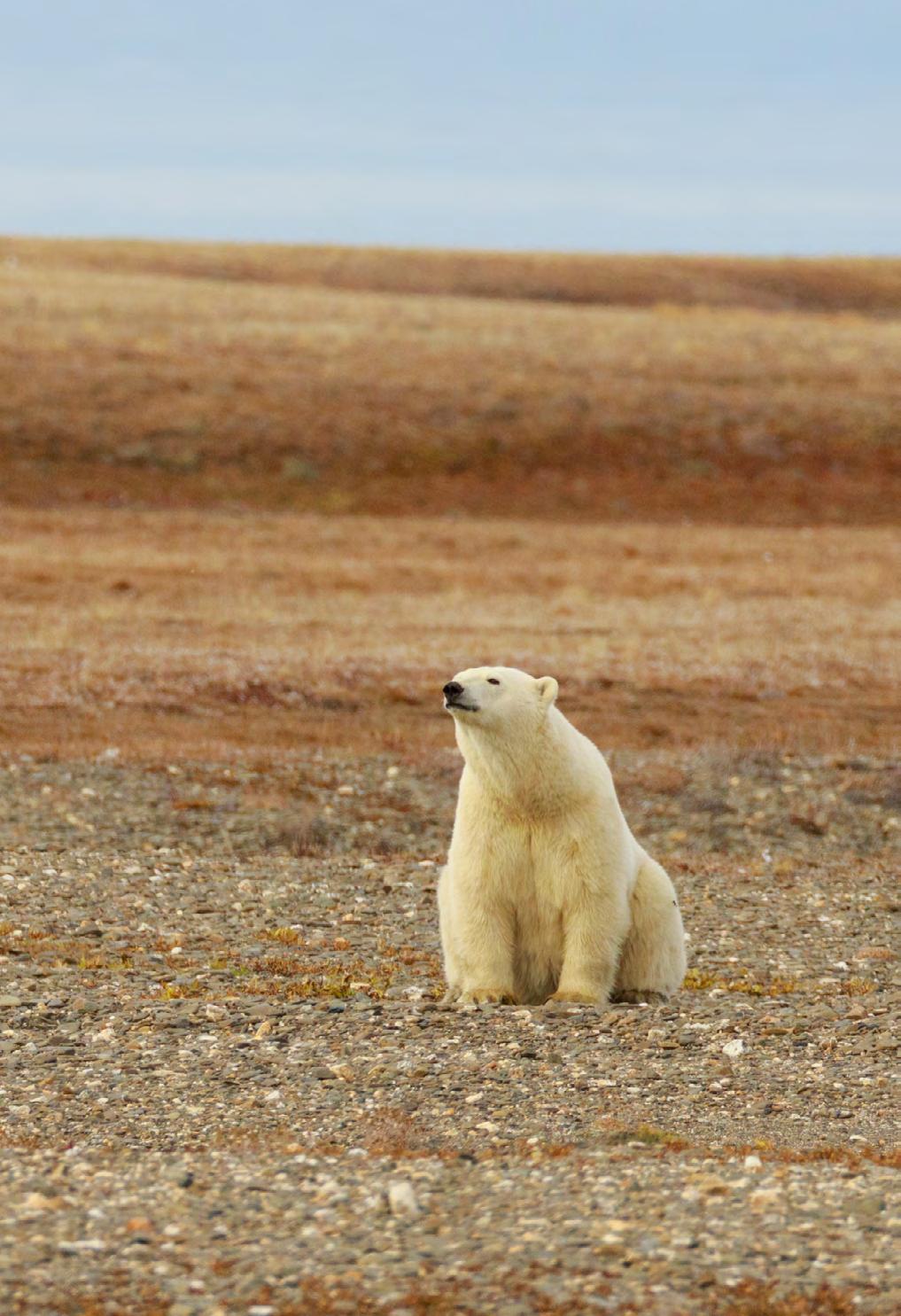
Historically, sustainable development of the Arctic, including its Russian regions, has depended in large part on consensus around the exceptional status of its lands and waters. At the end of the Cold War, a dominant paradigm emerged of an Arctic free from open conflict and competition, and with all interested parties making coordinated efforts to create a shared regime for the conservation of its ecosystems. [5.2] This consensus gained support and led to the creation, in 1996, of the Arctic Council, which included indigenous people’s organisations in addition to sovereign state entities.
Russia’s full-scale invasion of Ukraine occurred in the middle of Russia’s chairmanship of the Arctic Council, which ended in 2023 against the backdrop of its suspension from all international programmes. As of early 2025, the Council’s activities and former programmes had still not been fully restored. The disruption in 2022 led to Russia’s assertion of sovereignty 1 over its Arctic territories and its isolation from the rest of the world. This, in turn, contributed to decreased transparency in governmental and large-scale business activities, growing risks of natural and man-made disasters, and suppression of the rights of Indigenous Peoples of the Arctic. [5.3]
1 ‘Sovereignisation’ of the Arctic is a political and propagandistic concept employed by the Russian authorities. It denotes a strategic course aimed at consolidating exclusive state control over Arctic territories, including waters, and resources; substituting international cooperation with domestic governance mechanisms, and prioritising militarisation and industrial exploitation of the region over environmental protection and the rights of Indigenous peoples.
Since 2005, Russia has reopened 10 military bases in the Arctic. Аccording to data from March 2024, there were 31 military facilities in the region. [5.4][5.5][5.6] In March 2025, at the Murmansk Arctic Forum, Vladimir Putin announced that the military presence in the region would continue to grow, cementing militarisation as an important element in the country’s long-term development strategy for the Russian Arctic.
Although the Arctic is far from the RussiaUkraine war zone, it hosts military facilities that are directly involved in the conflict. One such facility is the Olenya airfield on the Kola peninsula, from which Russian military planes take off for airstrikes on Ukraine. This facility was the target of Ukrainian drone attacks in 2024 and 2025.[5.7]
At the same time, a lack of reliable information and access to data means that there are no assessments or studies of the impact of contemporary military infrastructure on the Arctic ecosystem. It is nonetheless clear that military exercises, maintenance of military transport infrastructure and construction work will inevitably increase the industrial burden on the region.
The Russian Arctic is still not free from the nuclear legacy of Soviet militarisation. The breakdown of international ties and cooperation indefinitely delays the completion of projects aimed at eliminating accumulated nuclear and radioactive waste, since such projects require international participation, including financial support.[5.8]
The Russian state views the Arctic chiefly as a “resource storeroom”, to which it lays claim via its geographical and historical dominance of the region (13th International Forum “Arctic: Present and Future”, 2023).[5.9] A similar approach explains key aspects of the industrial burden on the region, which has begun to grow as a consequence of sanctions on Russia from the European Union, United States and other countries. The consequences for the Arctic are, first and foremost, the development of the Northern Sea Route as a shorter passage from the Russian Arctic to markets in the Global South, as well as the implementation of large infrastructure projects for mineral extraction. Active industrialisation threatens the sustainable development of the Russian Arctic and leads to the violation of rights of Indigenous Peoples and traditional ways of life.[5.10]
Russian industrial lobbyists say that ice melt arising from the climate crisis could allow development of the Northern Sea Route. [5.11] However, this position ignores possible negative consequences of opening the route, including the influence and impact on the lives of Arctic Indigenous populations. Arctic development also heightens the risk of accidents and pollution, the mitigation of which is complicated by Arctic conditions. A further negative factor is the use of heavy fuel oil as the main power source for ships sailing on Arctic routes. Soot released from burning oil settles on Arctic ice and reduces its reflectivity. This leads to increased ice melt and negative climate consequences.
Observational data indicates that ice cover is shrinking year on year in the Arctic Ocean, based on figures from the months when it typically reaches both its maximum and its minimum extent (figures 1–2).
sea ice extent (Area of ocean with at least 15% sea ice)
Extent (millions of square kilometres)
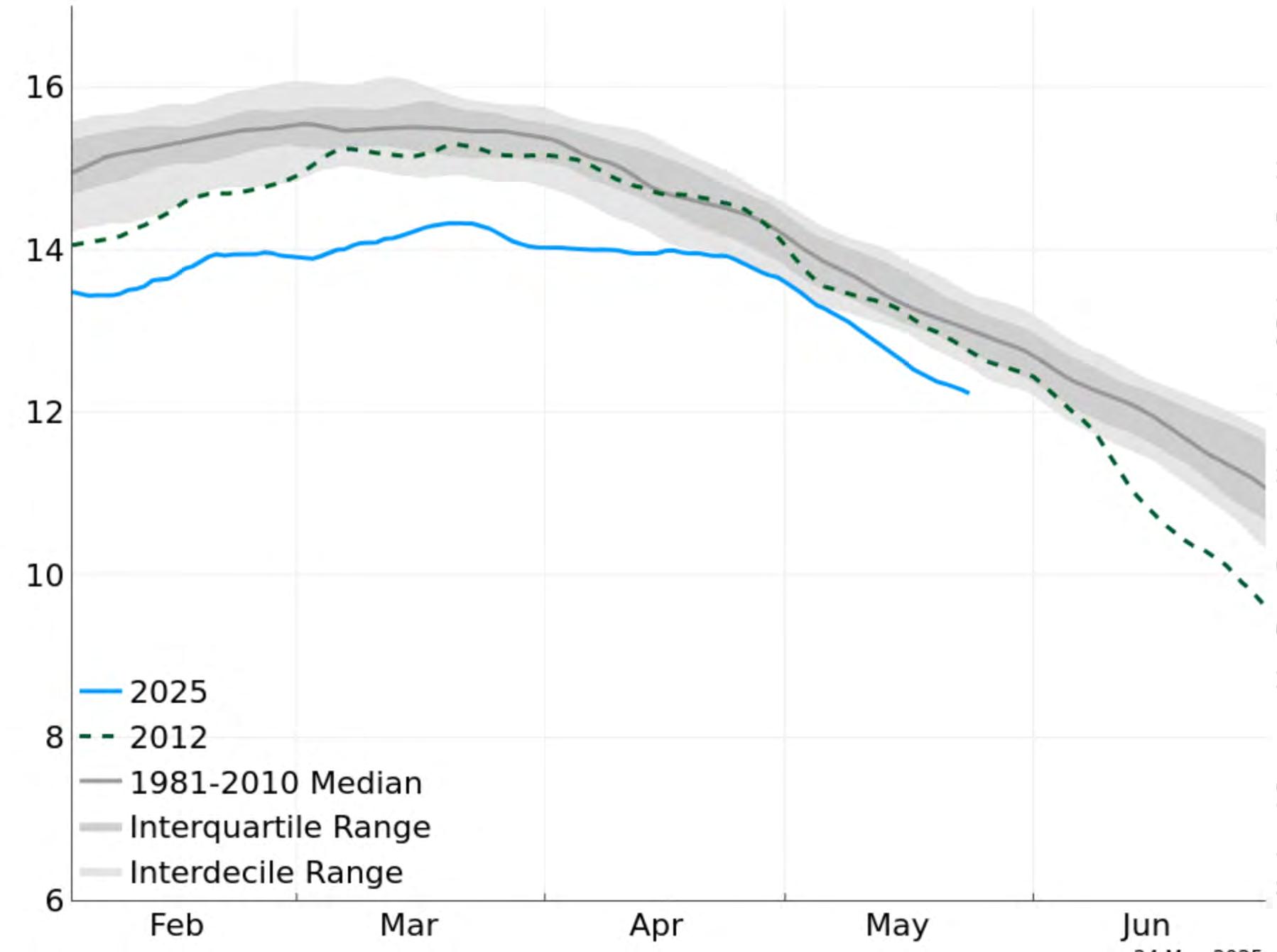
Source: National Snow and Ice Data Center, University of Colorado Boulder, data current as of May 2025
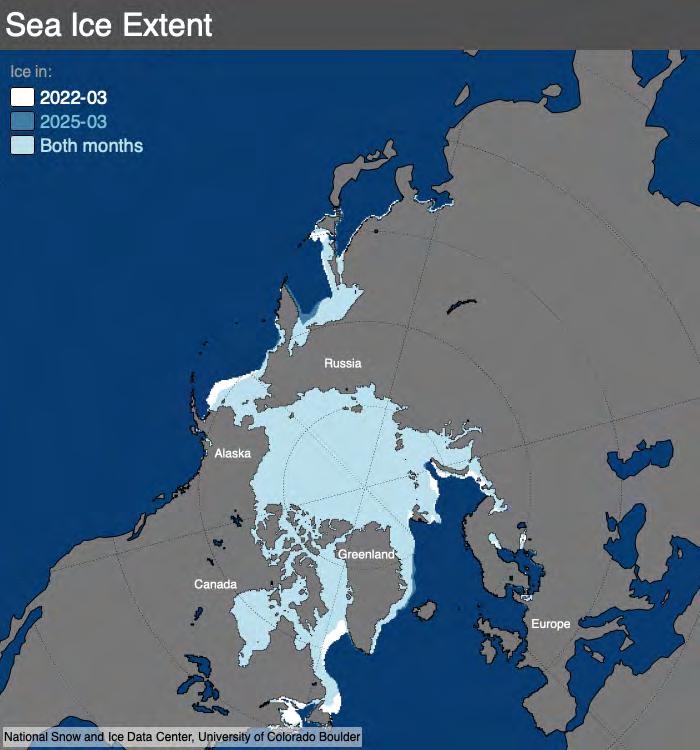
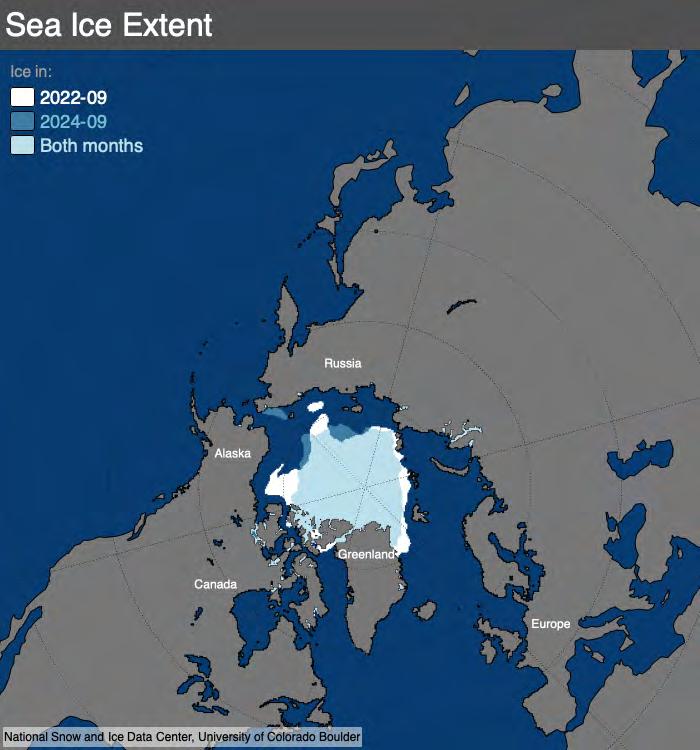
depletion – a comparison of average
extent in March (maximum ice coverage) and September (minimum ice coverage) in 2022 and 2024-25.
The development of the Northern Sea Route, however, is proceeding more slowly than planned. Despite the authorities’ repeated statements about the route’s strategic importance and the ambitious goals to increase transportation volume, the actual figures for 2024 are far from what was planned: instead of the intended 80 million tonnes, only around 37.9 million tonnes were transported along the route.[5.12]
US and EU sanctions have affected actual transportation figures, including those related to the Arctic LNG 2 (Novatek) and Vostok Oil (Rosneft) pipeline projects. [5.13] Additionally, there is a shortage of tankers capable of transporting liquefied natural gas (LNG) in Arctic conditions. The Vostok Oil project, which was designed to increase cargo traffic by 30 million tonnes in 2024, has been postponed until 2026.
However, despite sanctions, the number of trips and vessels on the Northern Sea Route is projected to increase further.[5.14] The past three years have shown that big business and the Russian authorities are able to reorient raw material exports and adapt to sanctions. However, restrictions on high-tech equipment imports continue to complicate the development of new resource deposits, slowing the growth of transport volumes.
Following a 2022–2023 decline, Russian official statistics recorded a recovery in Arctic natural gas and oil production in 2024.
Russia’s assertion of sovereignty over the Arctic is taking place in the context of alarming emerging data about climate change. The Arctic has been found to be warming four times faster than the global average.[5.15] According to Russian meteorologists, the fastest warming part of Russia is the Taymyr Peninsula: since 1998, the temperature on its Arctic coastline has risen by around 5°C. [5.16]
A warming Arctic causes an increase in the number of wildfires in the tundra zone, which, in turn, release carbon dioxide into the atmosphere, while melting permafrost leads to methane emissions.[5.17] Data for 2024 confirms a trend of rising concentrations of carbon dioxide and methane in the surface layer of the earth’s atmosphere.[5.18] The Arctic region mitigates the effects of the climate crisis through the high albedo of snow and ice cover while this remains, as well as contributing to thermoregulation of northern oceans — but the region is now becoming a driver of the climate crisis.
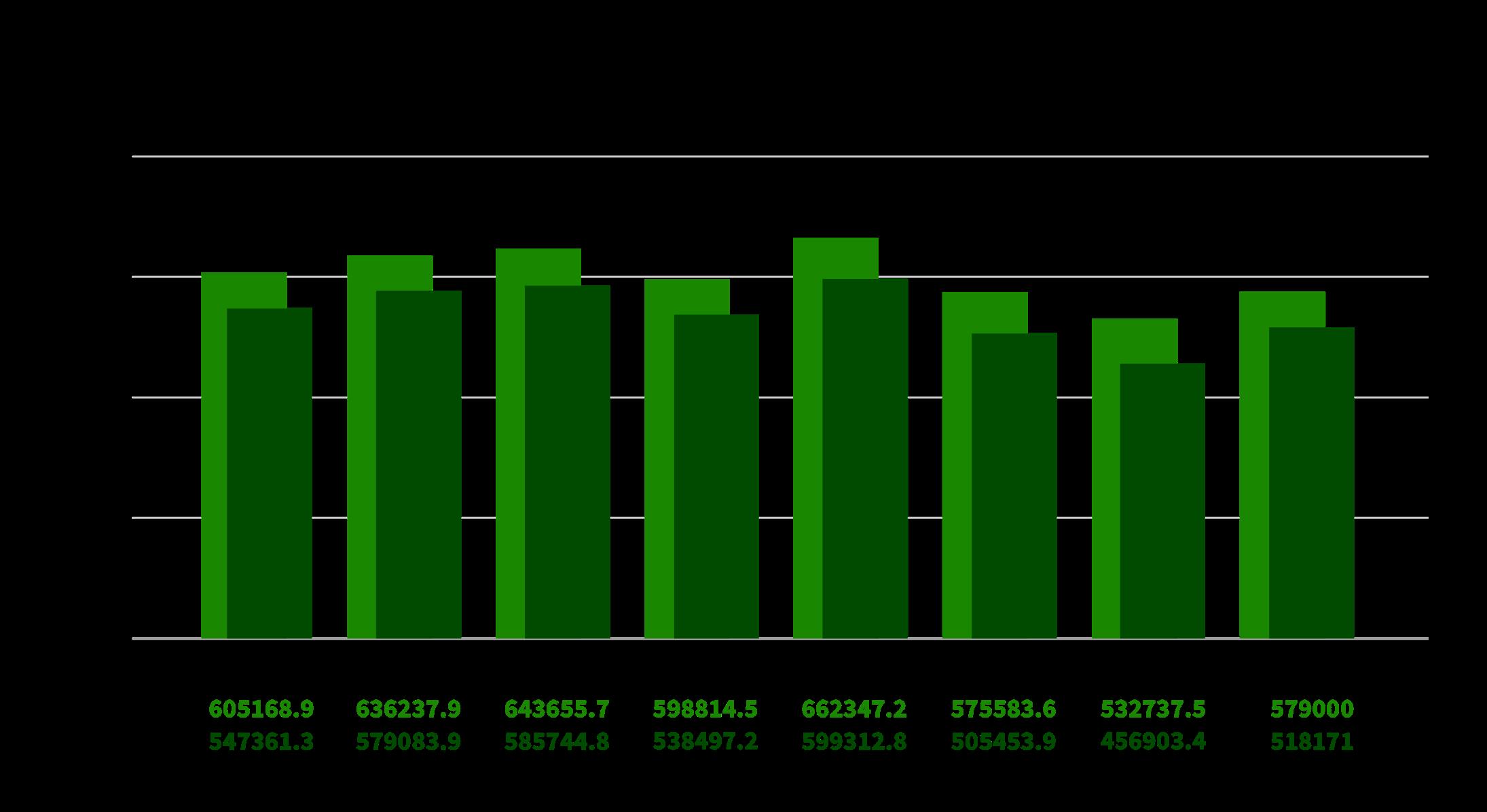
Figure 3.
Source: Greenpeace International calculations based on Arctida and Rosstat data
Warming and ice melt lead to the progressive degradation of permafrost. This creates heightened risks of man-made accidents from the destruction of industrial facilities and infrastructure. In some Arctic villages, up to 50% of structures have been deformed through thawing of permafrost.[5.19]
Since February 2022, many international research projects have been suspended and a lack of scientific exchange and dialogue has complicated predictions about climate changes that impact the entire planet but which are occurring at an accelerated pace in the Arctic, of which half the territory is in Russia. Foreign researchers are frequently unable to work in Russia and many Russian specialists, as well as both domestic and international scientific organisations, have been forced to leave the country.
The suspension of Russian researchers from discussions of Arctic issues leads to gaps in data. For example, the exclusion of 17 Russian stations from the international monitoring network INTERACT (International Network for Terrestrial Research and Monitoring in the Arctic), which only has 60 stations in total, distorts global data.[5.20]
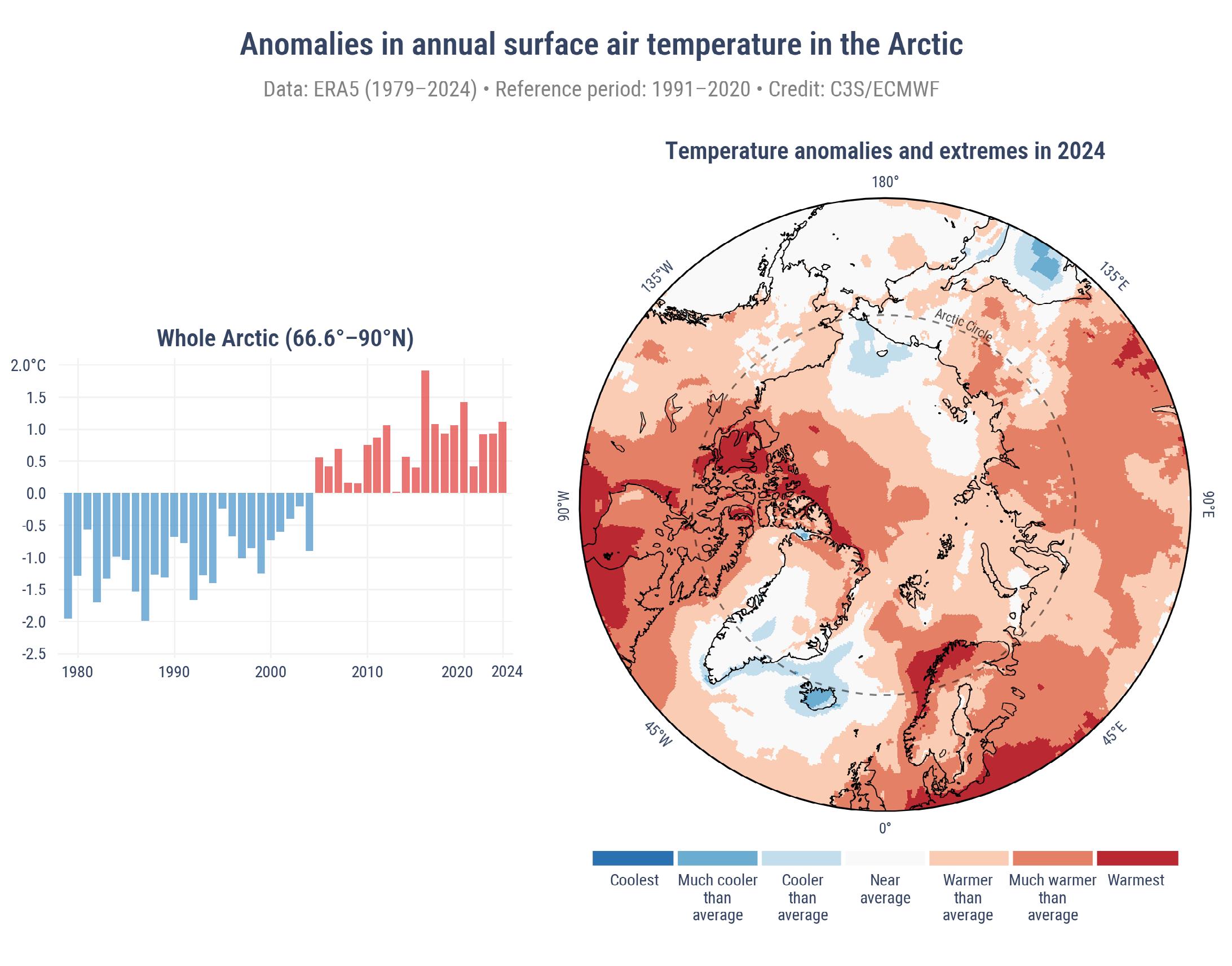
Figure 4.
Source: C3S/ECMWF
Indigenous Peoples are key stakeholders in the sustainable development of the Arctic. Since the beginning of Russia’s full-scale invasion of Ukraine, the Indigenous Peoples of the Arctic have been impacted by multiple crises: militarisation, the destruction of mechanisms designed to protect their rights, climate degradation and limited participation in decisionmaking.[5.21][5.22][5.23][5.24][5.25] Their way of life, based on living sustainably with nature and the transfer of traditional knowledge, is facing an existential threat.
Academic research has still not provided a full picture of the human cost of the war in Ukraine.[5.26] Since its very beginning, activists and researchers have been keeping a count of casualties among Indigenous Peoples.[5.27] They have recorded disproportionate losses among Indigenous Peoples across the entire country.[5.28] In the Nenets Autonomous Okrug, where Nenets people make up 17% of the population, they account for a third of all those from the region killed in the war. In the Chukotka Autonomous Okrug, out of 134 war dead, 77 were Chukchi, and eight were Yupik.[5.29]
Among Indigenous Peoples, sons of poor families are particularly vulnerable, and many of them were mobilised (drafted for military service in one of several mobilisation drives) or recruited from prison. These facts attest to the link between social disadvantage and vulnerability to mobilisation.[5.30][5.31][5.32]
If we compare the number of people killed per 1,000 among Indigenous groups versus among the general Russian population, we find that for the overwhelming majority of Indigenous groups the figure is higher than the average for Russia.[5.33][5.34][5.35]
Concurrent with the rise of war casualties, Indigenous Peoples’ ability to defend their rights is being curtailed. [5.28][5.38][5.39][5.40][5.41] The growing effects of the climate crisis also threaten Indigenous ways of life in the Arctic. [5.42][5.43][5.44]
Since 2022, repression against Indigenous associations and activists working with them has become systemic. In 2024, 55 Indigenous organisations were declared “extremist organisations”, including Aborigen-Forum, Indigenous Peoples’ Russia and Free Yakutia.[5.45] In December of the same year, a number of organisations,
including no fewer than 12 from the Arctic, were declared “terrorist” organisations. [5.46] After 2022, many independent activists were forced to leave Russia.
Since 2020, Russian authorities have been compiling a list of individuals belonging to Indigenous Peoples. Inclusion on this list is necessary for receiving state benefits and maintaining traditional ways of life — Indigenous individuals not included on the list may be charged with poaching. However, the procedure for receiving recognised Indigenous status is extremely bureaucratic, and the same list may also be used for repressive ends, including military mobilisation. [5.25]
The Federal Agency for Ethnic Affairs and other official representative structures, such as the Russian Association of Peoples of the North, Siberia, and Far East (RAIPON), have become channels for promoting governmental and business interests.[5.47]
The RAIPON leadership consists of legislative deputies and bureaucrats, and its activities amount to imitations of human rights protections and promoting the interests of industrial corporations. RAIPON supported Russia’s war against Ukraine and initiated repressive measures against anti-war and decolonial groups. The Association is financed by companies such as Norilsk Nickel, Gazprom, Rosneft and other corporations that exploit Arctic resources. At the same time, RAIPON represents Russia at international forums and, in the name of Indigenous interests, lobbies for the removal of sanctions against its donors.[5.48]
Despite pressure, independent Indigenous activists continue to fight for their rights with the support of human rights organisations. The Anti-Discrimination Centre Memorial and the International Committee of Indigenous Peoples of Russia (ICIPR) have made reports to the UN Special Rapporteur on the Rights of Indigenous Peoples and Human Rights Council.[5.24][5.25] [5.49] The reports document discriminatory practices in military mobilisations; destruction of traditional economies; violations of rights to free, prior and informed consent, and the forcing out of independent representatives. Arctic Indigenous rights was also a topic in a report by the UN Special Rapporteur on the situation of human rights in Russia, Mariana Katzarova.[5.50]
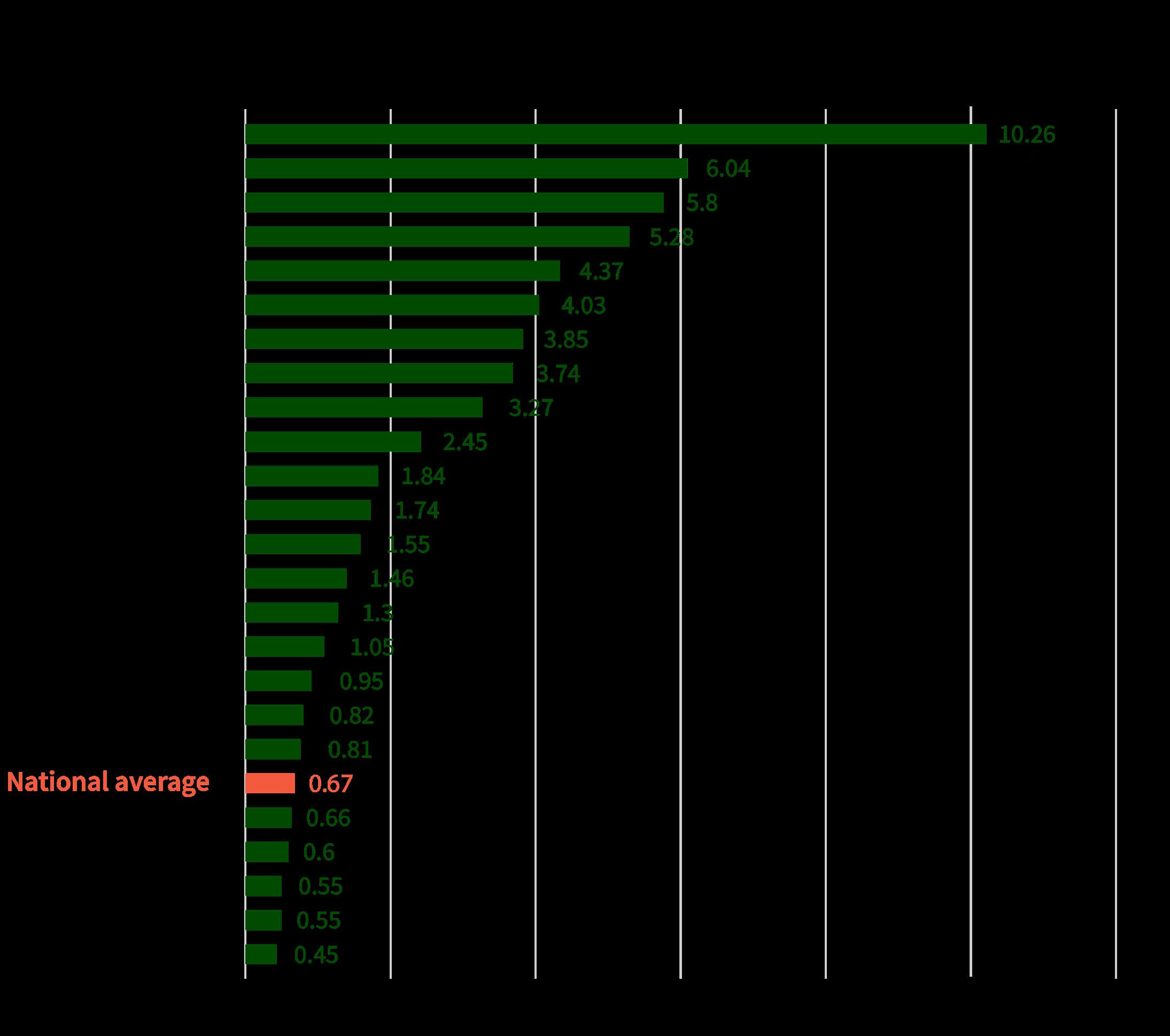
5.
Source:
as of March 2025.
Despite Russia’s formal standing in the field of sustainable development of the Arctic region [5.51], since 2022 the environmental degradation of Russia’s Arctic has intensified, and violations of Indigenous rights have become more systemic.
The full-scale invasion of Ukraine has, on the one side, led to Russia’s international isolation, the destruction of scientific cooperation and the weakening of mechanisms for environmental control. On the other, disproportionately high war losses among Russia’s Indigenous Peoples has hastened the destruction of these communities.
The Arctic, which was previously conceived as a zone of international cooperation and exceptionally rich natural ecosystems, has become a territory for Russian sovereignisation and strategic development in the interests of the state and big business.
Against the backdrop of the climate crisis and the destruction of the fragile ecosystems of the North, Russian policy in the Arctic centres on the expansion of industrial and military infrastructure, as well as the use of natural resources without regard for the rights or interests of Indigenous populations. The Russian state violates principles of free, prior and informed consent, and repressions of independent activists and organisations are intensifying. Representative structures for Indigenous Peoples, such as RAIPON, have come under the control of state officials and increasingly serve as mouthpieces for industrial lobbies and state propaganda.
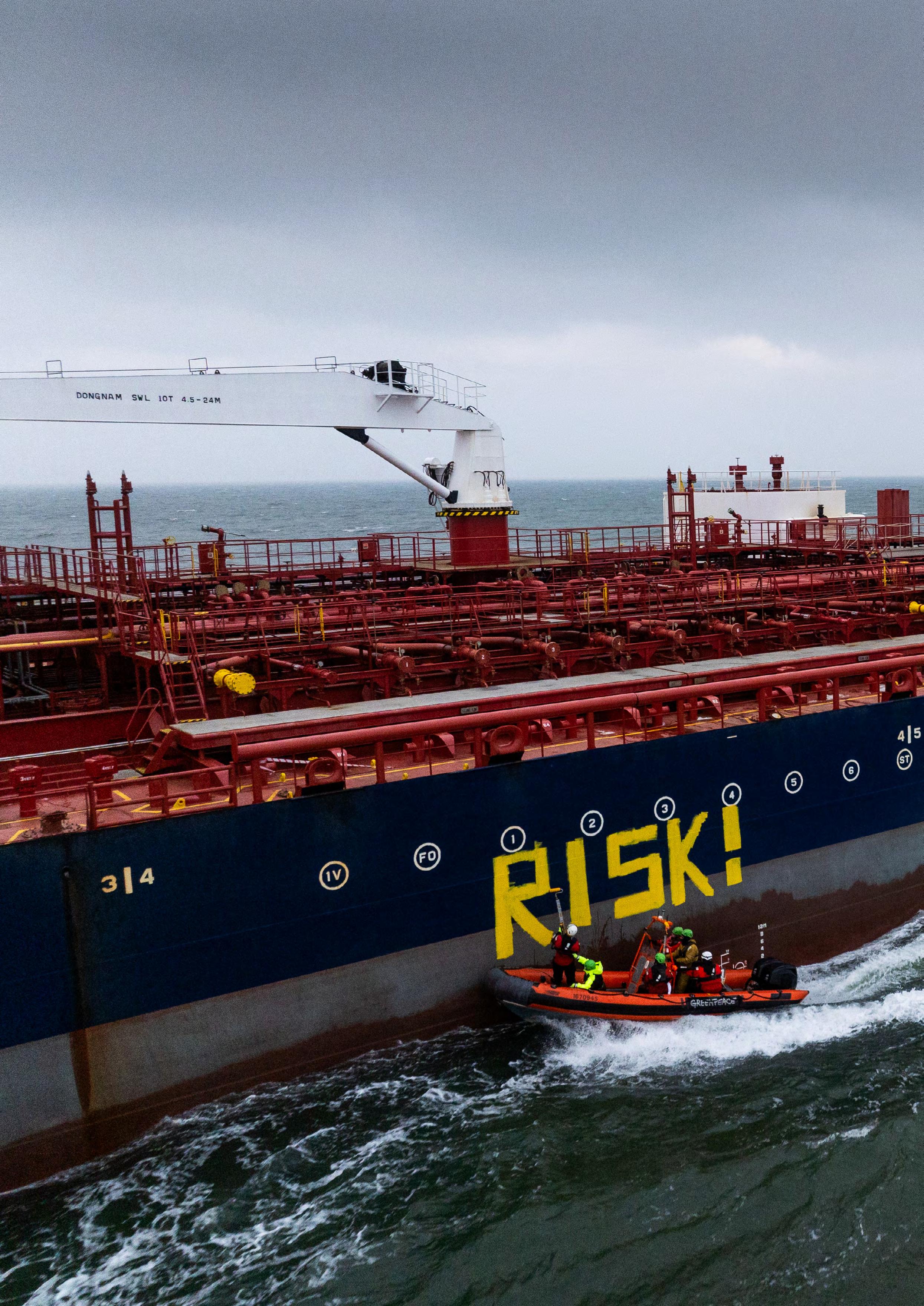
Russia’s global influence extends beyond its vast natural resources and ecosystems. It also manifests in international environmental diplomacy, where the country increasingly acts as a brake on global progress – both by adopting obstructionist positions in climate, biodiversity and pollution negotiations, and by promoting alternative narratives that emphasise sovereignty, development-first approaches and resistance to tightening international environmental norms.
Russia’s trajectory in international climate policy has undergone a fundamental shift – from active engagement in the 1990s to deliberate detachment and obstructionism in recent years. During the formative stages of the UN Framework Convention on Climate Change (UNFCCC) and the Kyoto Protocol, Russia positioned itself as a constructive actor.[6.1] It supported international market-based mechanisms developed under the Kyoto Protocol – such as emissions trading, Joint Implementation (JI) and the Clean Development Mechanism (CDM) – aligning with other non-EU developed countries in the informal ‘Umbrella Group’ coalition, which included the United States, Canada, Japan, Australia, Norway and others.[6.2] At that time, Russia’s vast forest resources and relatively low emissions provided it with leverage and flexibility in shaping global rules.
However, by the early 2000s, this engagement began to erode. During debates over Kyoto ratification, domestic industrial lobbies challenged the scientific foundations of climate policy, leading to the 2003 Moscow Climate Conference – a high-profile international event that gave visibility to climate-sceptical narratives.[6.3] While Russia eventually ratified Kyoto in 2004, the move was widely understood as a bargaining chip in its bid to join the World Trade Organisation, rather than a commitment to emission reductions.[6.4][6.5] Implementation remained weak and, by the second Kyoto commitment period (2013–2020), Russia declined to take on binding targets and was perceived as hindering progress.[6.6][6.123]
Moscow’s approach to the Paris Agreement followed a similar logic of formal compliance without substantive ambition. The country’s first Intended Nationally Determined Contribution (INDC) in 2015 was framed as a 25–30% reduction in emissions from 1990 levels by 2030. In practice, it allowed for a significant increase from current levels due to the collapse in emissions during the 1990s.[6.7] The longterm carbon neutrality pledge by 2060, first announced in 2021, lacks legal force and is not supported by binding sectoral strategies or fiscal instruments.[6.8]
Russia’s 2021 Low Carbon Development Strategy until 2050 outlines multiple decarbonisation scenarios, however, it relies heavily on delayed implementation: most mitigation is scheduled to occur after 2035. [6.9] The plan also leans on technological solutions that are either undeveloped or unreliable in the Russian context – particularly carbon capture and storage (CCS) and largescale carbon sequestration by forests. This emphasis persists despite growing evidence that Russia’s forests are under severe stress
from wildfires, illegal logging and inefficient forest management. Moreover, even the strategy’s most optimistic scenario assumes a continuing role for oil and gas exports deep into the second half of the century, signalling a reluctance to reorient the country’s economic model.[6.10]
Russia’s domestic climate policy stagnation reflects broader structural dynamics. The dominance of fossil fuel interests in political decision-making, combined with the influence of government-aligned scientific institutions, has shaped public narratives that downplay human responsibility for climate change and emphasise the alleged “natural carbon neutrality” of Russian ecosystems. These positions have been used to justify policy inaction and to resist calls for structural reform.[6.11] While most major economies have moved towards integrating climate objectives into national planning and finance, Moscow has treated decarbonisation as either a risk or a foreign agenda.
Following the full-scale invasion of Ukraine in 2022, Russia’s position in international climate diplomacy deteriorated sharply. Traditional coalitions such as the Umbrella Group ceased to function as coherent blocs, and cooperation with blocs like G77+China –an alliance of developing countries that coordinates positions in UN climate negotiations – became increasingly limited.[6.12] Sanctions and broader geopolitical tensions have restricted Russia’s access to international funding and investments for climate-related projects, international technology partnerships and multilateral negotiation formats.[6.13]
In response, Russia has shifted focus to alternative geopolitical groupings such as BRICS+, the Shanghai Cooperation Organisation (SCO) and the Eurasian Economic Union (EAEU).[6.14][6.15] Within these forums, it promotes a “development-first” narrative, emphasising national sovereignty, energy security and resistance to “imposed” climate agendas. While these platforms provide Russia a degree of political visibility on the world stage, they have produced limited results in terms of joint climate policy, financing mechanisms or investment in renewables. Key partners such as China and India remain cautious in extending green investment into the Russian economy.[6.16][6.17]
At the same time, Russia has distanced itself from climate initiatives linked to the European Union. It opposes the EU’s Carbon Border Adjustment Mechanism (CBAM) – a policy that places a carbon price on imports of certain goods from countries with less strict climate regulations. Moscow perceives CBAM as a protectionist measure, arguing that it threatens the competitiveness of key Russian export sectors such as steel, fertilisers and aluminum, which are both energy- and emission-intensive.
Participation in carbon market mechanisms has stalled, and domestic carbon pricing –including the Sakhalin pilot project, a regional experiment in emissions trading – remains largely symbolic.[6.18] In 2024, Russia introduced a new methodology for greenhouse gas inventory reporting, which led to a notable increase in estimated carbon sequestration by forests and a reduction in reported emissions.[6.13] This move was widely criticised as greenwashing and further undermined international trust in Russia’s climate data. Moreover, these revisions occurred in the absence of any robust system for independent verification or transparent MRV (Measurement, Reporting, Verification) mechanisms, leaving both domestic carbon projects and official reporting open to manipulation.[6.19]
Looking ahead, prospects for meaningful policy change appear limited. Russia’s 2060 carbon neutrality target remains non-binding and the country’s overall energy strategy remains firmly rooted in fossil fuels.[6.20] Key industrial associations, such as the Russian Union of Industrialists and Entrepreneurs (RSPP), continue to resist emission limits, carbon pricing and the broader green transition. Sectoral decarbonisation plans in energy, transport and construction are delayed or remain in draft form. Russia’s official climate communications to the UNFCCC continue to include conditional language, linking emissions reduction commitments to vague terms such as “balanced social economic development” and “maximum absorptive capacity of forests”. This phrasing leaves room for broad interpretation and serves as a loophole to delay or avoid concrete action.[6.21]
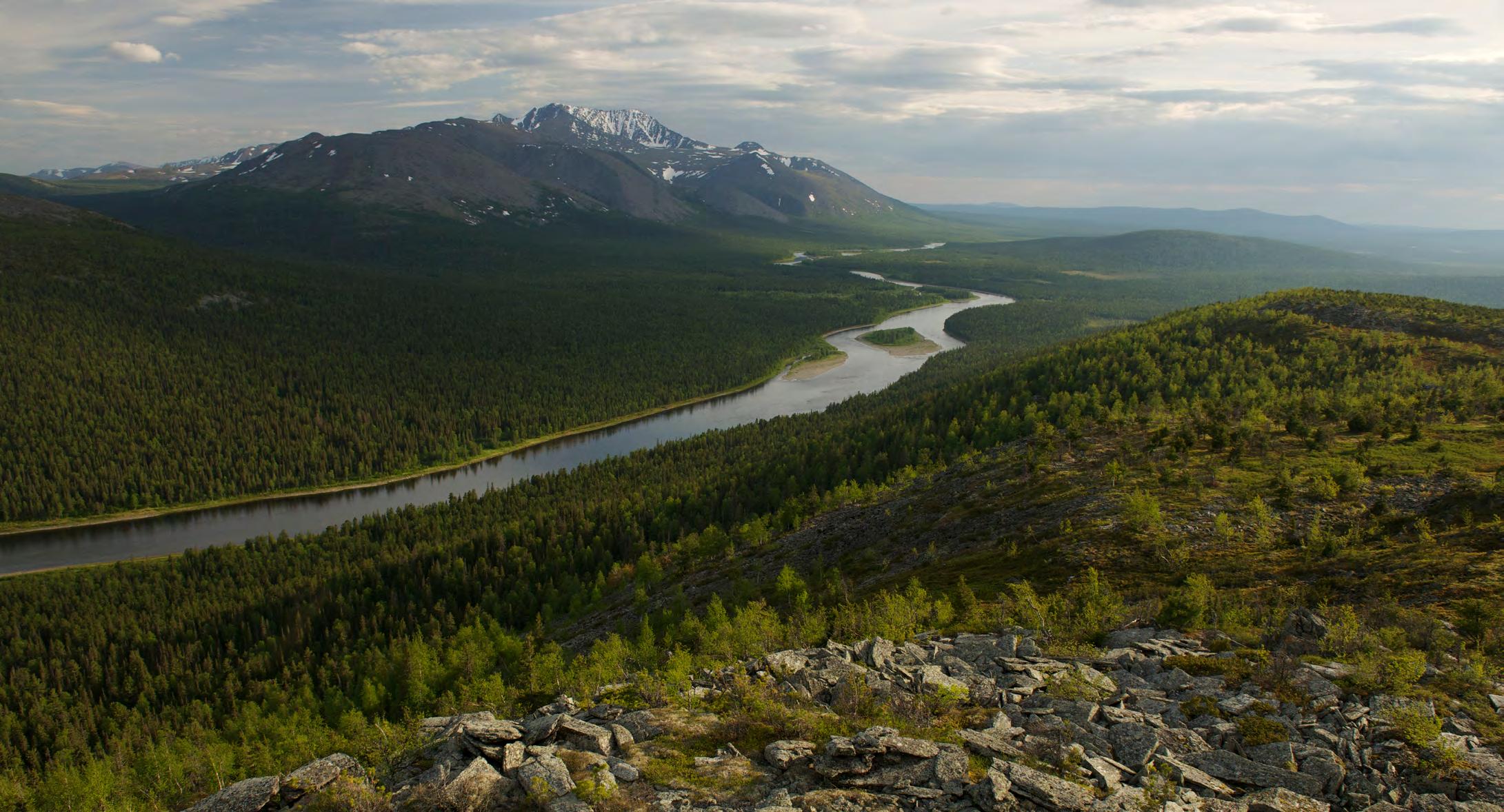
Moscow’s current trajectory carries significant implications for global climate efforts. As a major fossil fuel exporter, Russia’s decisions, as part of a broader group of fossil fuel-exporting states, shape the feasibility of international decarbonisation targets. Its continued absence from carbon pricing systems and reluctance to align with global finance mechanisms – such as green taxonomy standards or climate disclosure frameworks – isolate it from the mainstream of climate governance. Meanwhile, the expansion of discounted fossil fuel exports to countries such as China and India risks reinforcing carbonintensive development models in regions critical to global transition.
To sum up, the Kremlin’s climate policy reflects a clear strategic choice: to preserve its existing economic structure and geopolitical leverage at the expense of decarbonisation. This stance places it increasingly at odds with global trends – not only limiting its own resilience to climate risks, but also weakening collective efforts to address the climate crisis.
Until 2022, the Russian Federation maintained an active and visible role in the implementation of the UNESCO World Heritage Convention. It hosted the 2012 session of the World Heritage Committee (WHC) in St Petersburg and was elected twice (2008–2012 and 2018–2022) as one of the 21 rotating member states of the WHC, which oversees the implementation of the Convention.[6.22]
For the Russian government, participation in UNESCOrelated bodies served as a channel of multilateral engagement and international visibility – in other words, as a soft power tool.
Civil society actors also took part in World Heritage initiatives. For instance, Russian environmental NGOs, including Greenpeace Russia, alongside international partners, contributed to the establishment of the “World Heritage Watch” network, which aims to strengthen public monitoring of sites and increase civil society involvement in decision-making.[6.23] A comprehensive communication channel between civil society and UNESCO bodies emerged, involving annual UNESCO-Civil Society Organisation (CSO) forums and the publication of a compendium of monitoring reports.[6.24] Russian authorities rarely responded to allegations filed with UNESCO World Heritage Centre by Russian CSOs but were obliged to react when those allegations were used to formulate decisions of the WHC.
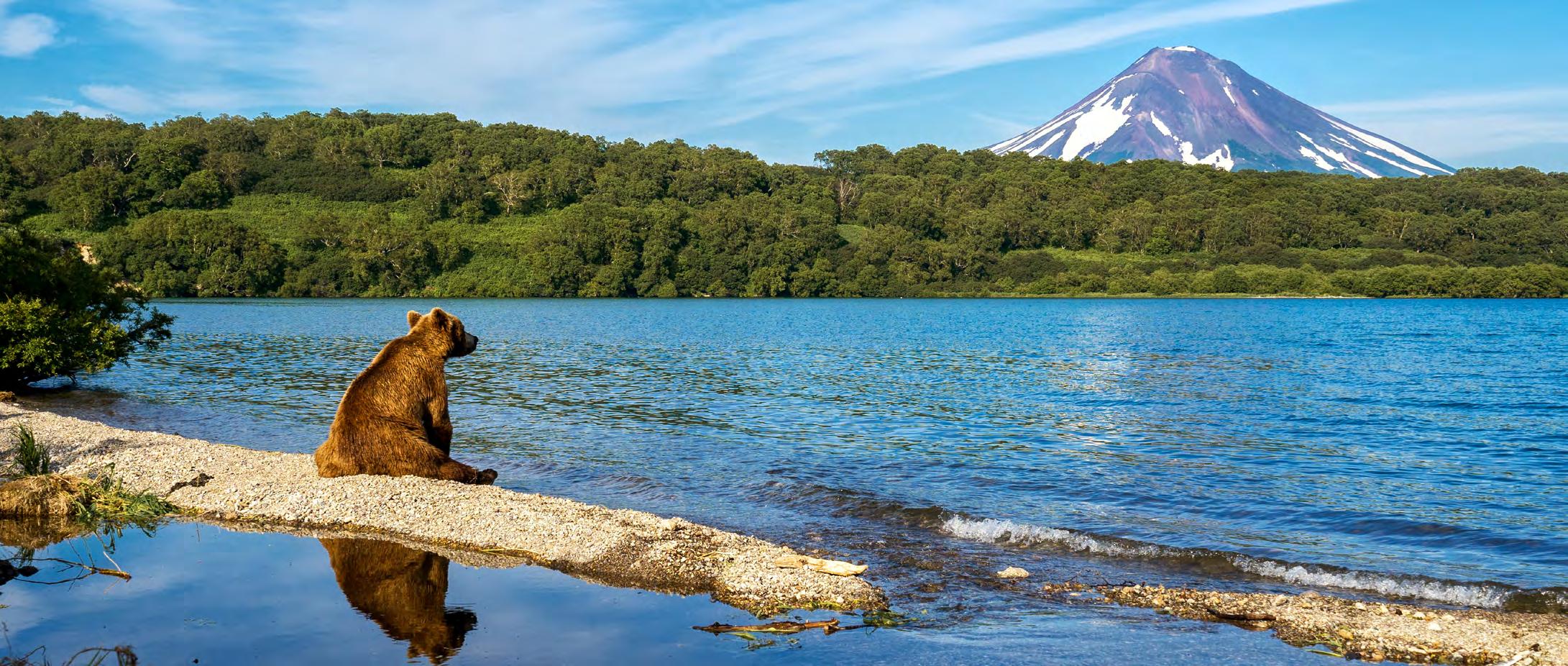
In 2021, Russia assumed chairmanship of the WHC and planned to host its 45th session in Kazan in 2022. Domestic civil society groups began preparations for a parallel NGO forum. However, the full-scale invasion of Ukraine in February 2022 prompted widespread calls for the relocation or cancellation of the session. In April 2022, a group of 46 member states, coordinated by the United Kingdom, issued a joint letter to the WHC stating that holding the session in Russia or under a Russian presidency was no longer appropriate, citing damage to cultural heritage sites in Ukraine as a core concern.[6.25][6.26] In response to this pressure, Russia proposed postponing the session. It was ultimately suspended, and the Russian WHC chair resigned by November 2022.[6.27][6.28]
Several Russian natural and mixed World Heritage properties have also faced increased risks during this period. In October 2022, the Ministry of Natural Resources published a draft regulation concerning the Wrangel Island Nature Reserve, which included provisions allowing defence-related activities.[6.29] Given the site’s status as a critical habitat for polar bears, walruses and other species, these proposals raised concerns about compatibility with the WHC’s principles. Russian NGOs and international actors filed comments and petitions.[6.30] In its 2023 decision, the WHC issued a formal warning that Wrangel Island risked inclusion on the List of World Heritage in Danger if broad defence operations were permitted.[6.31] Subsequently, the Ministry adopted a revised regulation limiting military activities to specified zones.[6.32]
Similar dynamics unfolded with other Russian sites. In 2023, UNESCO raised concerns about infrastructure development near the Volcanoes of Kamchatka site, particularly after part of its territory was excluded from the protected zone.[6.33] Russian authorities pledged to reinforce protections and to cancel plans to build a cruise port within the area. In 2024, Russia also agreed not to finalise new water management rules for Lake Baikal until those were reviewed by the International Union for Conservation of Nature (IUCN).[6.34] As of March 2025, this commitment has been maintained.
While these cases illustrate that Russia remains responsive to WHC recommendations in some instances, the overall environment for civil society engagement has changed. Many of the organisations previously active in monitoring World Heritage properties have been dissolved or designated as “undesirable”, limiting independent oversight. Legal restrictions introduced since 2022, including prohibitions on cooperation with foreign organisations deemed contrary to national interests, have further reduced transparency.[6.35][6.36] Currently, only activists and experts based outside the country are able to raise concerns freely, but they lack full access to on-theground information. Remote monitoring tools and indirect communication channels are becoming essential for maintaining civil society participation in the WHC’s processes.
Russia’s approach to the WHC processes affects environmental issues in other countries as well. Under the pretext of procedural flexibility and respect for national sovereignty, Russia has backed initiatives that lower the standards of environmental oversight and reduce the Convention’s tools to largely formalistic procedures. As a result, Zambia and Zimbabwe were effectively granted approval to proceed with the construction of a large hydropower project near Victoria Falls, while Bangladesh received positive feedback for a superficial strategic assessment regarding industrial development around the Sundarbans mangrove forest, and was allowed to continue port, industrial and energy infrastructure expansion in close proximity to this World Heritage site.[6.37]
Overall, despite political tensions [6.38], Russia continues to engage with UNESCO and the WHC. This illustrates that Russia continues to view multilateral platforms as useful diplomatic channels, particularly for heritage-related international engagement. The Convention’s mechanisms – particularly periodic reporting, reactive monitoring and annual sessions –offer opportunities to influence environmental governance, even in constrained circumstances. Nonetheless, the Convention covers only a limited portion of Russia’s natural territories, meaning its leverage remains partial.
In summary, Russia’s interaction with the World Heritage Convention since 2022 has been mixed. Though it faces reduced diplomatic standing and domestic restrictions on civil society, Russia has not withdrawn from the Convention and continues to engage with its procedures. In several cases, this engagement has helped moderate the impact of proposed regulatory changes or development pressures. However, longer-term trends suggest a narrowing space for independent oversight and growing challenges in ensuring effective implementation of conservation commitments.
Russia’s full-scale invasion of Ukraine also threatens the governance system for biodiversity conservation. The crisis has exacerbated three interrelated processes that undermine the system’s stability: Russia’s isolation from international biodiversity institutes; the suspension or delay of existing forms of cooperation; and the de-prioritisation of biodiversity conservation in domestic and international politics. Limited cross-border cooperation complicates the collection, exchange and verification of environmental data. As a result, the risk of long-term fragmentation of environmental protection mechanisms increases, decreasing their ability to adapt to global challenges.[6.39]
Russia continues to formally participate in the major international agreements on biodiversity protection, including the Convention on Biological Diversity (CBD), the Convention on International Trade in Endangered Species of Wild Flora and Fauna (CITES), the Ramsar Convention on Wetlands, and others. In 2022–2024, Moscow supported the adoption of the Kunming-Montreal Global Biodiversity Framework and presented national targets in accordance with its goals.[6.40] However, Russia has not developed a fully fledged strategy or a national action plan through 2030.[6.41]
Military activity in Ukraine has damaged the region’s biodiversity and undermined international scientific cooperation, including with regard to endangered species.[6.42] Shelling of zoos and nature reserves has resulted in recorded instances of deaths of animals included on the Convention on International Trade in Endangered Species of Wild Fauna and Flora (CITES) list. These incidents sparked discussion of limiting Russia’s participation in decision-making within the CITES framework, an idea which delegations from the EU, the US and other governments supported. Such precedents demonstrate Russia’s deepening isolation from the international environmental agenda.[6.43]
Within the country, the legal and institutional foundations for preservation of nature remain fragmented. Penalties for illegal trade in endangered species are weak, which reduces the effectiveness of their control.[6.44] As of June 2025, Russia remains a party to the Ramsar Convention, however doubts have been expressed at the administrative level about the appropriateness of continued membership. In particular, suspicions have been voiced that “migratory birds may be used for purposes other than environmental”. The intent behind this statement from the Ministry of Natural Resources officials is unclear, but it is reminiscent of conspiracy theories previously spread by Russia’s Defence Ministry, about the alleged use of migratory species for biological attacks or the spread of pathogens[6.45]. In July 2025, the State Duma supported Russia's withdrawal from the Ramsar Convention, citing the alleged “politicisation” of the agreement.[6.120] Thus, Moscow’s distrust of international mechanisms is growing, limiting prospective cooperation. Russia’s potential withdrawal from the Convention could threaten the preservation of key ecosystems.
Despite a reduction in international interactions, Moscow continues to fulfil some obligations. 2022 saw the approval of a new strategy for the preservation of polar bears through 2030, which stipulates restrictions on economic activity in areas of critical importance to the species.[6.46] Russia also advocates for expanding the mandate of the UN Convention to Combat Desertification, proposing to include the boreal and Arctic zones in its sphere of action.[6.47] Thus, Moscow seeks to expand the application of international environmental protection mechanisms onto its own territory.
Russia therefore maintains formal participation in international agreements while demonstrating an increasingly selective approach that focuses on national interests and reduces the country’s level of involvement in international mechanisms with binding conditions. Foreign policy isolation and internal institutional constraints create conditions in which the preservation of biodiversity is seen as a task of secondary importance.
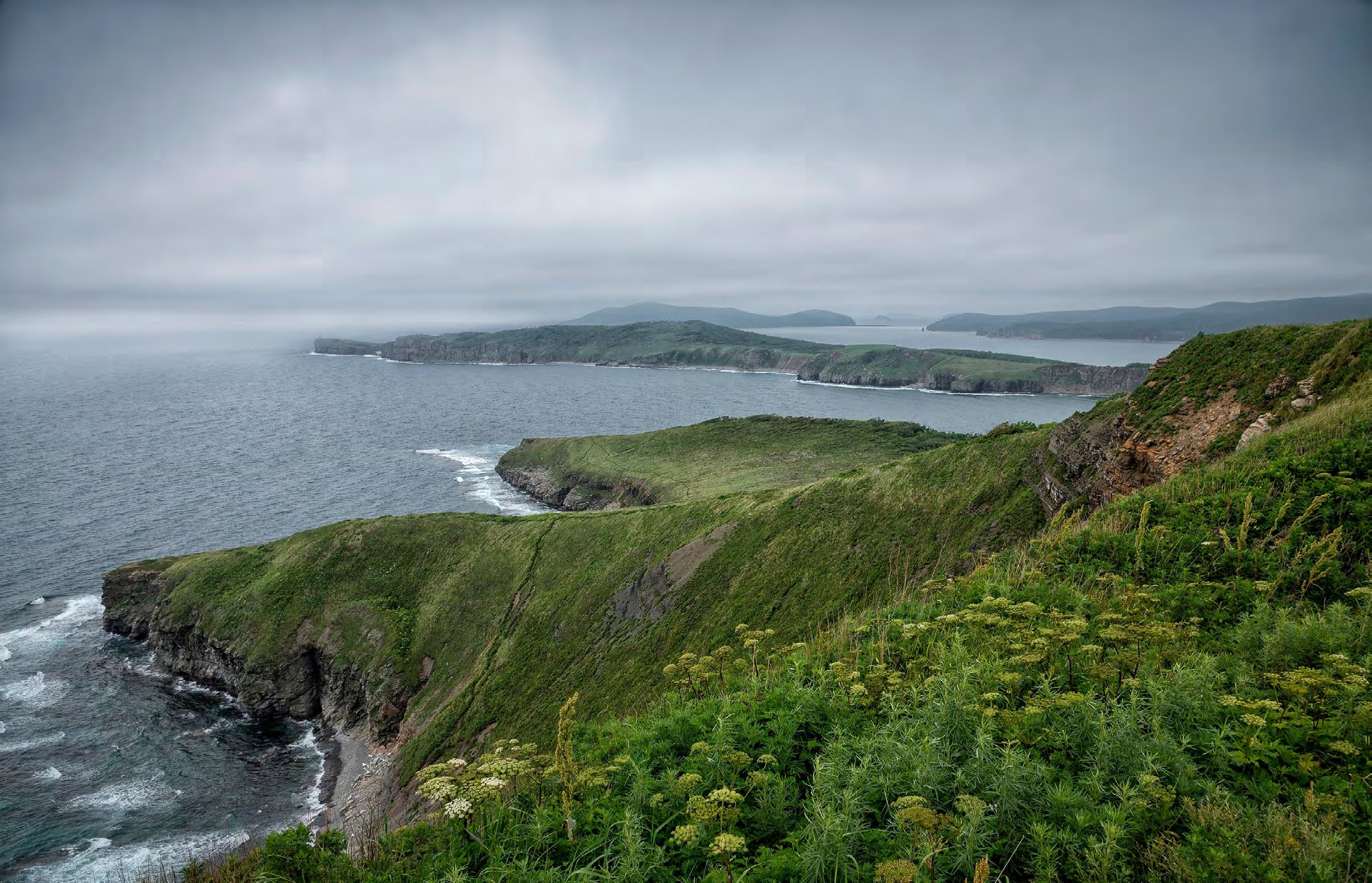
Since 2022, Russia’s involvement in international mechanisms for the preservation of marine environments and the Arctic has shifted significantly. The Arctic Council, which Russia chaired from 2021 to 2023, essentially stopped working after the start of the 2022 invasion, when seven of its eight member countries announced temporary suspensions of engagement with Russia. Those countries subsequently continued limited cooperation without Russia’s participation, primarily in the fields of science and environmental protection.[6.48][6.49] In response, Russia has shifted focus toward bilateral formats, especially with China, though the practical effectiveness of such ties remains low.[6.50]
Russia has been excluded or withdrawn itself from several international organisations dealing with Arctic development, where the natural environment and sustainable development are one area of international cooperation. For example, in March 2022, Russia was excluded from the Council of the Baltic Sea States (CBSS).[6.51] In September 2023, Russia left the Barents Euro-Arctic Council of its own accord.[6.52]
Russia continues to participate in a limited capacity in the processes of the UN Convention on the Law of the Sea (UNCLOS), which regulates countries’ rights and activities at sea and on the continental shelf, including mining, fishing and shipping. In 2023–2024, Russia considered withdrawing from the Convention, against the backdrop of accusations of NATO intelligence operations in the Arctic, but Russia’s Foreign Ministry subsequently stated that such a measure was impossible from the standpoint of international law.[6.53][6.54]
In June 2023, after nearly 20 years of negotiations, UNCLOS adopted the Agreement on the Conservation and Sustainable Use of Marine Biological Diversity of Areas beyond National Jurisdiction (also known as High Seas Treaty and Global Ocean Treaty). The document covers almost two thirds of the world’s oceans and establishes liability for pollution as well as conflict resolution mechanisms.[6.55] Russia refused to support the agreement: in March 2025, the country’s representatives to the UN said that it did not agree with provisions on the creation of protected marine territories or with possible restrictions on shipping, fishing and scientific research.[6.56]
Russia has also stepped up efforts to extend the boundaries of its continental shelf in the Arctic. In 2024, Moscow submitted an updated application to the UN, with another currently in preparation.[6.57][6.58] This amounts to an attempt to legally secure for itself additional marine territories rich in natural resources.
At meetings of the Convention on the Conservation of Antarctic Marine Living Resources (CCAMLR) in 2022 and 2023, the delegations from Russia and China blocked the creation of new marine protected territories, arguing that more robust scientific grounds were necessary.[6.59]
Despite its continued participation in certain institutions, Russia’s approach to the protection of the marine environment and sustainable development in the Arctic has become increasingly isolationist. This approach prioritises national control and economic interests, especially in the extractive sector, while significantly reducing participation in multilateral initiatives with binding regulation.
Russia remains a party to the Convention on LongRange Transboundary Air Pollution (LRTAP) but in 2024 withdrew from the Protocol for financing the European Monitoring and Evaluation Program (EMEP), which is responsible for monitoring the spread of pollutants in Europe. The withdrawal was a response to the relocation of the Vostok Meteorological Centre from Moscow to Ljubljana, which Moscow took as a politically motivated decision.[6.60]
In the realm of international regulation of chemicals and chemical waste, Russia continues to participate in the Basel, Rotterdam and Stockholm Conventions, but takes a cautious, and in some cases restraining, position. In recent years, Russia's main focus has been the defence of national sovereignty in ecological regulations and the prevention of tightening international obligations, especially in areas that affect industrial interests.
Within the framework of the Basel Convention on the Control of Transboundary Movements of Hazardous Wastes and their Disposal, Russia regularly opposes the expansion of lists of controlled categories. At the 2023 joint meeting of the Conferences of the Parties to the Basel, Rotterdam, and Stockholm Conventions (BRS COPs), the Russian delegation challenged the inclusion of lithium-ion batteries and e-waste on the list of controlled substances, citing a lack of documentation in all official UN languages.[6.61] The Russian delegation also proposed an amendment to change the procedure for obtaining prior consent for transboundary waste shipments, which sparked discussions about possible weakening of controls.
Under the Rotterdam Convention, which regulates the export of hazardous chemicals, Russia has traditionally opposed the inclusion of chrysotile (white asbestos) on the list of chemicals subject to mandatory consent procedures, despite the fact that the majority of countries support this measure. Russia’s arguments revolve around the material’s economic significance, but also claim that it can be “safely used” if technical standards are met. Russia remains one of the biggest exporters of chrysotile and consistently defends the industry.[6.62]
Within the framework of the Stockholm Convention, which aims to limit persistent organic pollutants, Russia participates in discussions but frequently objects to the inclusion of new substances, particularly those used in metallurgy and chemical and plastics production. Russia’s main arguments are that scientific validity, socioeconomic consequences and the importance of transition periods – formally, to allow for adaptations in production and the search for alternatives – need to be taken into account. However, in practice such requirements allow the country to postpone meeting its obligations and continue using unsafe substances in priority economic sectors.[6.63]
The same dynamics marked UN talks towards developing a global treaty on plastics. The Russian delegation has consistently opposed tough global measures such as reducing plastic production, and insists that regulation should be on a voluntary basis, taking national circumstances into account. Instead of covering the entire lifecycle of plastics – from resource extraction to utilisation – the Russian delegation proposes focusing on waste management, avoiding restrictions that could impact industry in the country.[6.64][6.65]
Moscow is thus counting on protecting industrial interests and opposing tightening environmental obligations. It implements international agreements selectively, and primarily where those coincide with its existing economic and technological priorities.
Russia has not ratified the Convention on Environmental Impact Assessment in a Transboundary Context (informally known as the Espoo Convention) or the Aarhus Convention on Access to Information, Public Participation in Decision-making, and Access to Justice in Environmental Matters, even though it was involved in the development of both.
In 2013, the Russian government approved a bill to ratify the Espoo Convention but it did not progress further. This reflects the state’s reluctance to take on international obligations in the realm of transborder ecological assessments.[6.66] When it implements large projects (for example, the Arctic LNG 2 terminal), Moscow prefers to rely on internal procedures, without applying international standards.[6.67] Russia is an observer under the Aarhus Convention and regularly expresses concern about the expansion of public participation in decision-making, citing threats to its sovereignty.[6.66][6.68]
The Kremlin's overall approach to international agreements regarding access to environmental information and public participation reflects its desire to maintain internal control and limit external influence on environmental policy.
Russia officially supports the implementation of the UN 2030 Agenda and Sustainable Development Goals (SDG); however, it puts a priority on economic growth, national sovereignty and technological development. In its only Voluntary National Review – the official report that countries submit to the UN to monitor progress toward Sustainable Development Goals – Russia provided limited discussion of climate change, human rights and the participation of civil society, focusing mainly on achievements in digitisation, infrastructure and social support. [6.69]
In international forums about sustainable development, the Russian delegation supports “diversification” of development paths and emphasises the voluntary fulfilment of SDGs, with national circumstances taken into account. Russia often insists on neutral phrasing in the final documents, especially around climate change and the role of civil society, and opposes the “politicisation” of the agenda.[6.70][6.71]
On regional platforms (like, for example, the UN Economic Commission for Europe (UNECE) Forum and the Asia-Pacific Forum on Sustainable Development), Moscow promotes the idea of the “right to development” and calls for considering socio-economic processes when defining international obligations.[6.72] The Russian delegation also emphasises the importance of so-called ‘technological neutrality’, access to financing and the impermissibility of unilateral restrictive measures, including sanctions, as impediments to reaching SDGs.[6.73]
At G20 and BRICS+, Russia consistently promotes the rhetoric of a “balanced” approach to sustainable development, substituting generally accepted goals and principles.[6.74][6.75] Under the banner of a fair distribution of climate responsibility and the rejection of universal solutions, Russia in practice promotes the protection of energy-producing countries’ interests. Rather than focusing on the rights of vulnerable groups and the need to transition to low-carbon technologies, Moscow and its partners insist on prioritising economic stability and “voluntary” fulfilment of obligations, while the concepts of “justice” and “inclusivity” are reduced to ensuring equal access to international energy markets, rather than environmental or social responsibility.[6.76]
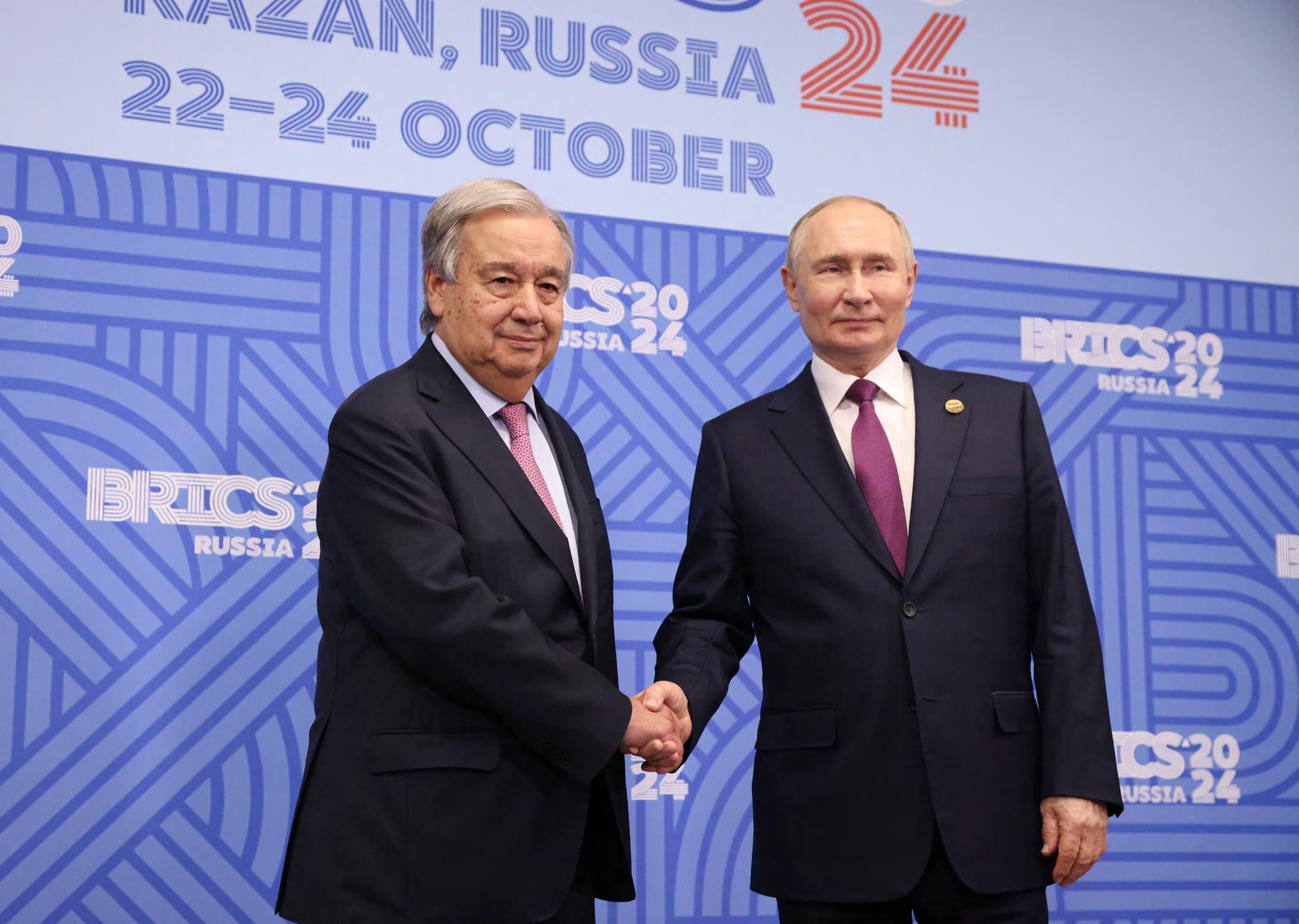
Vladimir Putin greets UN Secretary-General António Guterres during their bilateral meeting at the BRICS Leaders’ Summit, October 24, 2024, in Kazan, Tatarstan © Contributor / Getty Images
At the same time, Russia promotes its own understanding of the “green transition”, which prioritises not reduced dependence on fossil fuels but a strengthened export model and an increase in its role in global supply chains. Instead of making a real transition to decarbonisation, Russia is counting on expanding access to mineral resources – including to strategically important elements such as lithium, uranium and bauxite, which play a key role in battery production, nuclear power and “green” infrastructure. Russia’s strategy for developing raw mineral material through 2050 demonstrates an orientation towards resource sovereignty and control over rare elements.[6.77] Moscow places particular attention on expanding its economic and military presence in African countries – including to ensure access to uranium in Nigeria, lithium in Mali, bauxite in Guinea and zinc in Burkina Faso.[6.78]
Under the guise of countering Western hegemony and resisting the “politicisation” of the climate agenda, Russia uses international processes around environmental protection to strengthen its own extractivist development model.[6.79] Moscow also actively promotes nuclear energy, presenting it as part of the ‘green’ transition, including via the construction of nuclear power plants abroad. It frames these projects as one aspect of its technological exports and a means of strengthening its overseas economic influence.[6.80]
Following the start of the full-scale war in Ukraine, the imposition of sanctions and the establishment of a price cap on Russian energy resources, Moscow began extensive use of a so-called ‘shadow fleet’ – a network of tankers to circumvent export restrictions. According to various estimates, the shadow fleet consists of 300–450 oil tankers, 45 of which regularly transport Russian oil.[6.81][6.82][6.83] These vessels frequently turn off their Automatic Identification Systems (AIS), fly flags of countries with low levels of control over shipping and operate without reliable insurance.
‘Shadow’ logistics allow Russian oil to reach world markets while skirting western regulations, while also creating risks for maritime security, increasing the opacity of international trade and undermining sanctions regimes.[6.84][6.82]
Without full liability insurance for ship owners, it is more difficult in the event of accidents to quickly mobilise resources for spill containment and damage compensation. In many cases, ships sail without valid insurance or with policies from companies that do not actually exist.[6.85][6.86][6.87]
All of these issues increase the risks of a much wider scale of pollution and more serious consequences. Costs for an oil spill clean-up from a shadow fleet tanker could run from 859 million to 1.6 billion USD. [6.88]
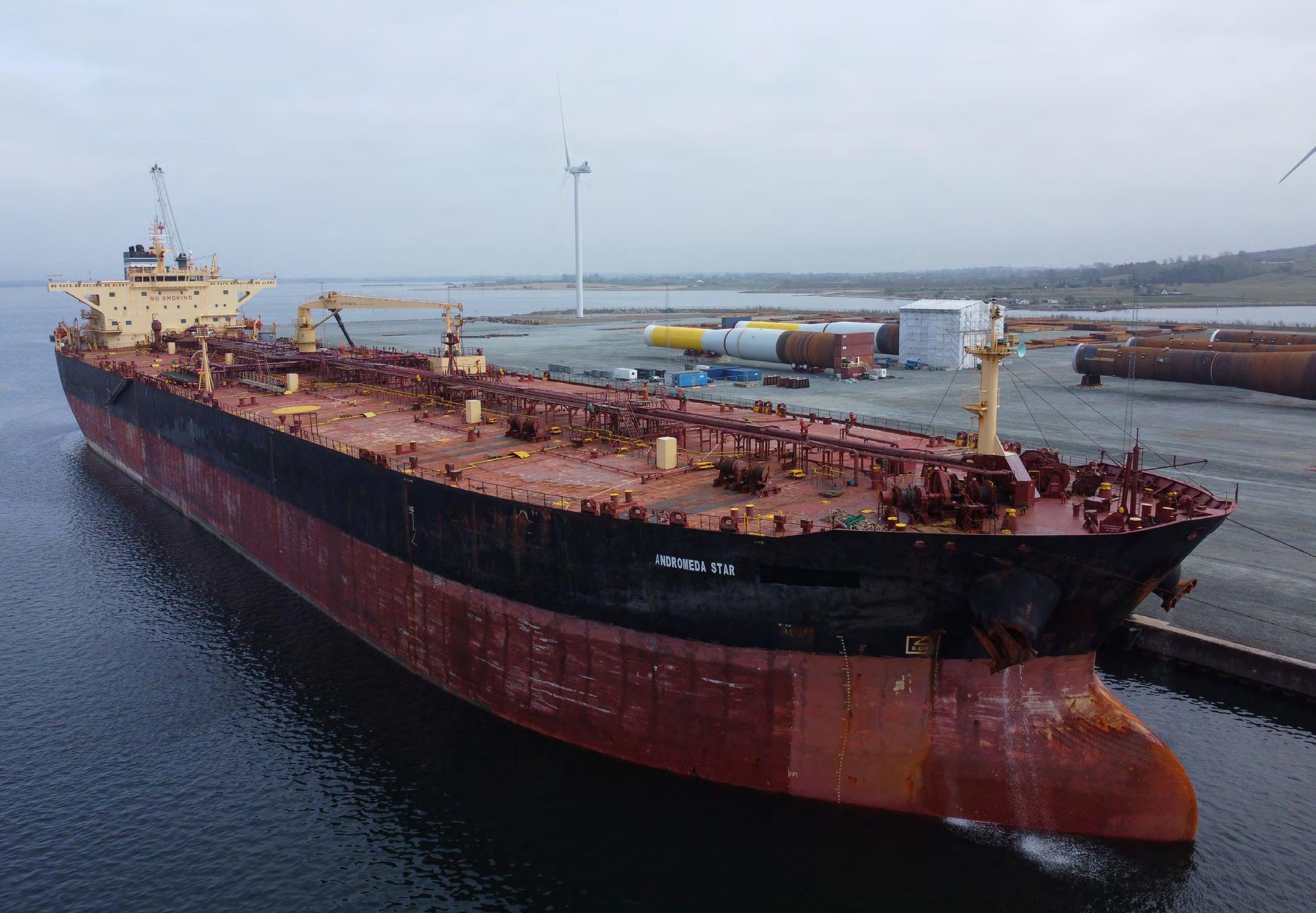
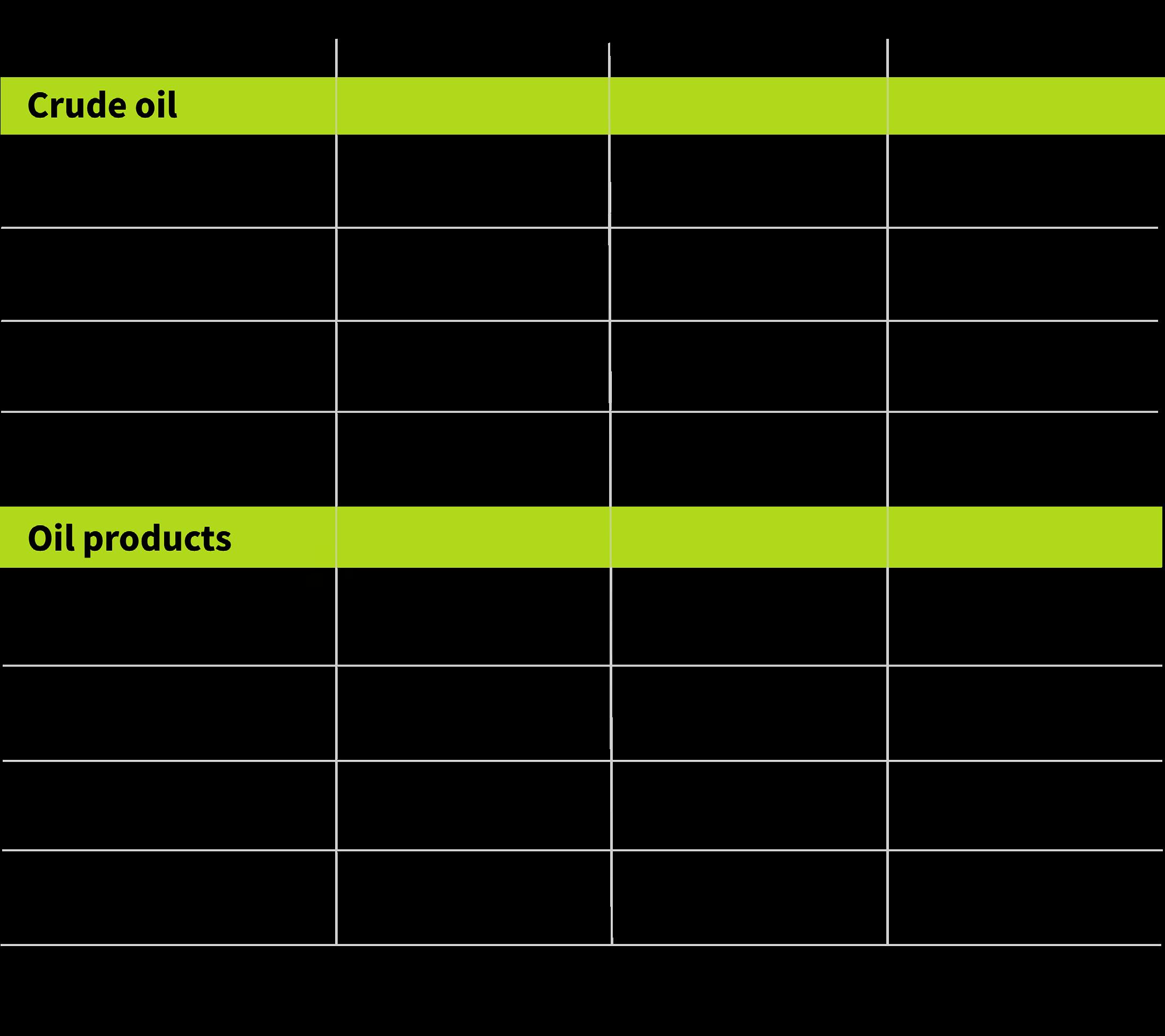
Source: Equasis, International Group of P&I Clubs, Kpler, KSE Institute
The core of Russia’s shadow fleet is old ships. Of the 294 tankers carrying crude oil, 51% have been in operation for 16–20 years, and another 26% for 11–15 years. An ageing fleet poses serious risks to human safety as well as to the environment: a vessel older than 15 years is more likely to break down, get into accidents and leak.[6.88][6.89] As of October 2024, shadow fleet tankers have been involved in 50 incidents, in locations from the Danish straits to Malaysian waters, including fires, collisions and oil spills.[6.90]
In recent years, South-East Asia has become a hub for sanctions evasions: tankers from Russia, Iran and Venezuela offload oil to other ships – as a rule, sailing under flags from third countries – on the open ocean, close to active shipping lanes. After this transfer, the cargo is registered as “legal” – that is, not subject to sanctions –and is sent to markets. Satellite data shows that such transfers take place several times per day. An oil spill in the Malacca Strait could paralyse shipping and cause serious damage to the global economy.[6.91]
On their way to South-East Asia, tankers carrying Russian oil pass through the territorial waters and exclusive economic zones of many countries, which significantly increases the zone of potential damage and complicates coordination in the event of an emergency. Shipping routes vary, but they may pass through the waters of four to 12 countries: [6.88]
• From the Baltic, the route runs through the Danish Straits, the Mediterranean Sea and the Suez Canal, covering up to 12 national and international jurisdictions.
• The Black Sea route through the Turkish Straits and the Mediterranean Sea crosses seven to 10 national and international jurisdictions.
• Arctic shipping involves the jurisdictions of six to nine states.
• The Pacific Ocean route is the shortest – it passes four to six coastal countries.
In the event of accidents involving shadow fleet tankers, the countries and regions highly exposed to possible oil spills along the main routes currently used for transporting Russian oil include: Algeria, Belgium, Bulgaria, China Mainland, Cyprus, Denmark, Djibouti, Egypt, Eritrea, Estonia, Finland, France, Georgia, Germany, Greece, India, Indonesia, Ireland, Israel, Italy, Japan, Latvia, Libya, Lithuania, Malaysia, Malta, Morocco, Myanmar, Netherlands, Norway, Oman, Pakistan, Philippines, Poland, Portugal, Republic of Korea, Romania, Russia, Saudi Arabia, Singapore, Somalia, Spain, Sri Lanka, Sudan, Sweden, Taiwan, Tunisia, Türkiye, Ukraine, United Kingdom, Vietnam, Yemen.
The routes and geography of incidents demonstrate that Russia’s shadow fleet is a global challenge to maritime security, which requires combined efforts from countries around the world.
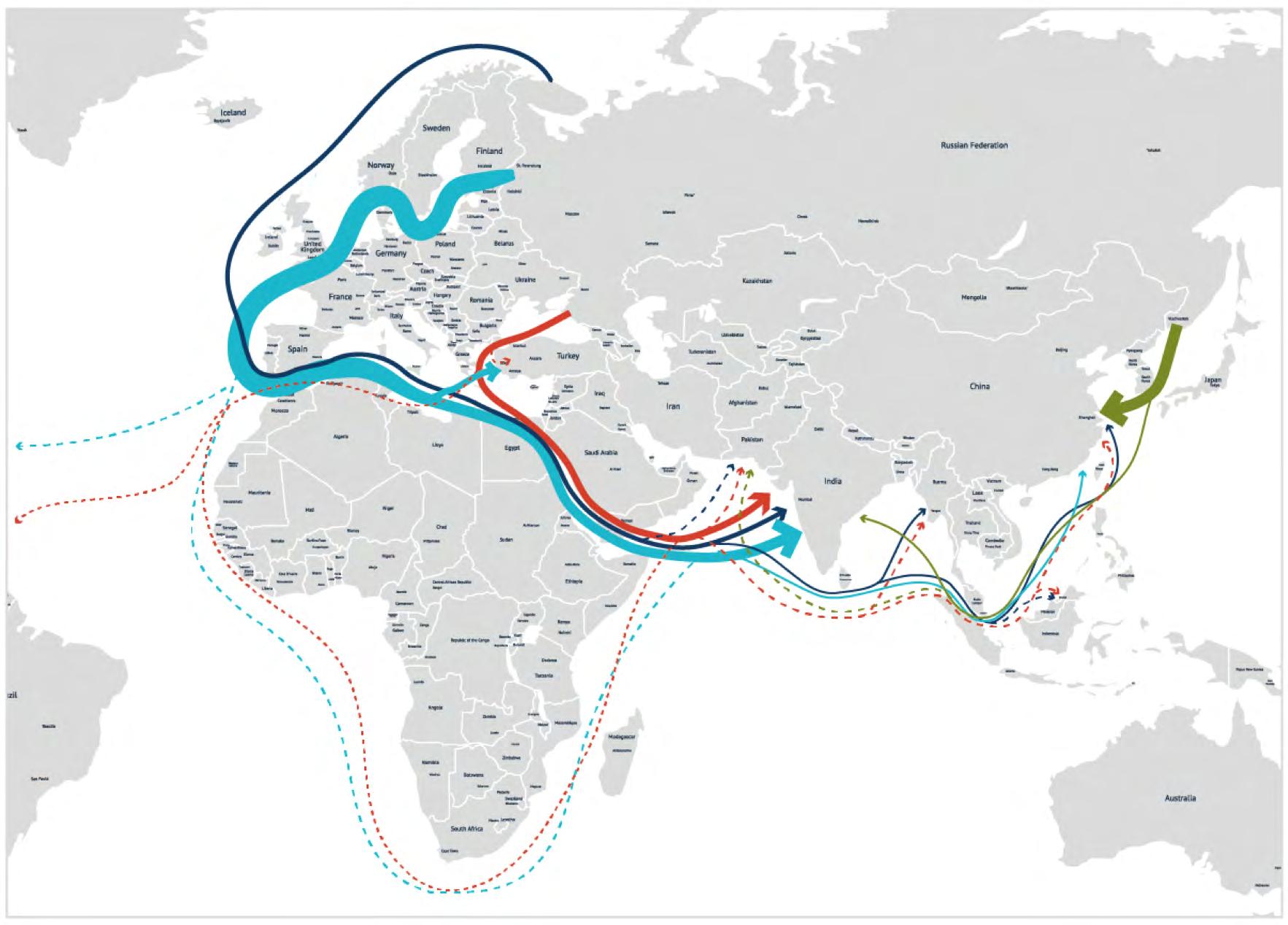
In December 2024, two Russian tankers of the Volgoneft class – one built in 1969, the other in 1973 – were wrecked, causing a major oil spill in the Black Sea. Although technically these tankers were not part of the shadow fleet, the accident clearly revealed the possible consequences of transporting oil in old ships that violate shipping regulations. According to authorities’ official version of events, the cargo was intended for domestic use, but experts suggest that the raw materials were destined for transfer to FIRN, a shadow fleet tanker, for further export.[6.92][6.93]
As a result of the incident, several thousand tonnes of heavy fuel oil spilled into the sea, and Rosprirodnadzor estimated that damage from the tanker wreck totalled 84.9 billion RUB (about 1.08 billion USD). [6.94][6.95][6.96] An accident with a shadow fleet vessel could have much more serious consequences – a Volgoneft tanker displaces 20–30 times less than a typical sea tanker.
The shadow fleet has become an important means of bypassing sanctions. It allows Russia to retain oil export revenue using risky and opaque logistics and to finance aggression against Ukraine. Old, poorly insured ships sail through the territorial waters of dozens of countries, raising the likelihood of accidents and major spills. Meanwhile, Russian authorities fail to ensure proper controls and disregard maritime transport safety. As the shadow fleet expands, so too does the global threat to both environmental safety and the sustainability of international shipping routes.
For nearly two decades, the Russian government has used the state nuclear corporation Rosatom as a geostrategic tool to secure influence in key regions of the world – a role that has only expanded since the full-scale war against Ukraine began in 2022. [6.121] Rosatom, which is funded directly from the federal budget and is controlled by the Kremlin, actively promotes Russian nuclear technology abroad. For Moscow, use of “the peaceful atom” is becoming an even more important lever for influence over other countries – much like the export of natural gas through Gazprom was previously. [6.97][6.98] This behaviour towards countries of the Global South is one element of Russian neo-colonialism, in which Russia exploits other states’ dependence on its technology and infrastructure to expand its political and economic control. [6.99]
The key feature of Rosatom’s export model is a full service cycle: from the design and construction of nuclear power plants to fuel supplies, personnel training, service support and decommissioning facilities. Almost all new overseas projects are financed with state loans, which can cover up to 90% of the overall cost. Loans are provided with preferential terms – low interest rates and decades-long payment deferrals. Rosatom offers its partner countries not just technology, but a whole infrastructure model based on the host country’s long-term dependence on Russia. [6.100]
Since 2022, Rosatom has intensified the promotion of its projects in Asia, Africa, the Near East and Eastern Europe. [6.101] In 2023 and 2024, Rosatom’s top management visited countries of the Global South almost as many times as they did in the entire 2016–2022 period. [6.102]
As of 2024, power units were under active construction in Türkiye, Egypt, Bangladesh, Iran, India and China. [6.103][6.104] Rosatom remains a world leader in construction of nuclear power plants abroad: out of 70 reactors, 33 are being constructed with the participation of the Russian state corporation. [6.105][6.106]
Rosatom’s foreign portfolio includes agreements and contracts with 54 countries – in 2023, it was worth 200 billion USD.[6.100] [6.107][6.108] Among its partners are China, India, Brazil, and countries in South-East Asia, Africa, Latin America and the Commonwealth of Independent States.[6.109][6.110][6.111]
In addition to international expansion through contracts, Russia uses more aggressive forms of influence in the nuclear sphere – including seizing and establishing control over nuclear infrastructure in occupied Ukrainian territories. In 2022, following the seizure of the Zaporizhzhia Nuclear Power Plant (NPP), Russian authorities began to integrate the station into their legal and infrastructural systems. This occurred via an illegal presidential order on the transfer of the station to federal ownership and the creation of a Zaporizhzhia NPP enterprise with a legal address in Moscow. At the same time, despite Rosatom’s actual involvement in running the station, data about its operations is absent from the corporation’s public records. This probably stems from a desire to avoid sanctions and reduce reputational risks.[6.112][6.113] Notably, this is happening amid investigations reporting that Rosatom has been involved, among other crimes, in torturing the Ukrainian staff of the ZNPP.[6.119]
Satellite images from May 2025 confirm largescale construction of a new power line to connect the Zaporizhzhia NPP to Russia’s electrical grid. Russian engineers are carrying out the work on the occupied Ukrainian territory, and the lines already stretch 90 km (around 55 miles). This indicates that preparations are underway to restart the reactors that were shut down in September 2022. The project is being implemented under the control of Russian energy agencies with the direct involvement of Rosatom. [6.114] In May 2025, the CEO of Rosatom announced that the Russian Ministry of Energy was in the process of approving a plan to bring the Zaporizhzhia NPP to full capacity. [6.115]
Rosatom is also involved in the Kremlin’s military programmes, including by supporting Russia’s defence industry. There is evidence that the corporation may have circumvented sanctions to supply weapons manufacturers with critically important materials – from aluminum oxide for rocket fuel to lithium-ion batteries. In public statements, Rosatom management confirmed that state defence orders had grown, including in non-nuclear areas and proactive military developments. [6.116]
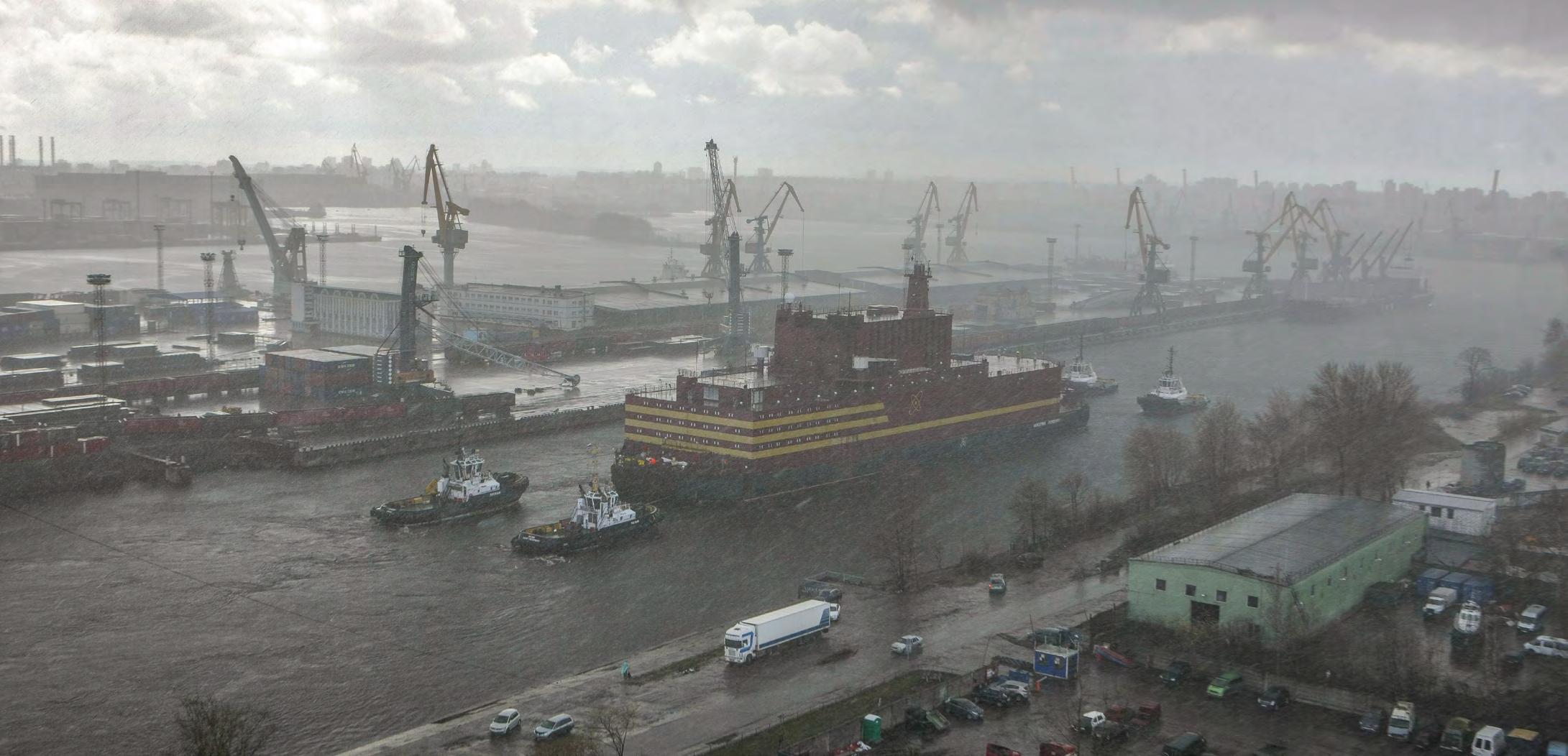
Despite its involvement in military production and the seizure of the Zaporizhzhia NPP, Rosatom is not on the sanctions lists of the EU or the majority of the G7 countries. Although the United States has enacted legislation aimed at ending imports of Russian enriched uranium, major loopholes persist, allowing imports to continue in 2025.[6.117][6.118] Within the European Union, there are no formal restrictions but member states are gradually reducing their dependence on Russian supplies: as of 2025, the majority of European consumers of Russian fuel had signed contracts with alternative suppliers, and Urenco (operating in the United Kingdom, Germany and the Netherlands) and the French company Orano are expanding their own uranium enrichment capacities. At the same time, according to the Rosatom CEO, the only European country that has completely stopped working with the corporation is Finland, while all other countries continue to cooperate despite sanctions pressure – however, “a number of negotiations are underway in a non-public format”.[6.115] At the same time, Rosatom is strengthening its position in countries of the Global South: in 2023, more than 12 billion USD of the company’s 16.2 billion USD foreign revenues came from markets that Moscow calls “friendly”.[6.116][6.122]
Thus, despite sanctions and isolation across many economic sectors, nuclear energy remains a key foreign policy instrument for Russia. Rosatom plays a central role in this strategy, combining technical influence with financial mechanisms and ensuring Russia’s long-term overseas presence.
In recent years, Russia has demonstrated increasingly systemic and strategically calculated resistance to international environmental cooperation. While it remains formally part of key agreements and platforms, the country increasingly hinders their implementation – by rejecting binding norms, promoting an alternative agenda, selectively interpreting obligations and substituting sustainable development goals for resource sovereignty priorities. It was not always this way: in the 1990s, Russia played an active and constructive role in the international climate process within the UN Framework Convention on Climate Change and the Kyoto Protocol.
The Kremlin’s current behaviour on the world stage is a conscious political choice that favours protecting the existing model of economic growth based on the export of fossil fuels and raw materials. Russia is developing its own conception of participation in global processes, interpreting environmental transformation through the prism of geopolitics, elite interests and the defence of national sovereignty. Russia conveys a similar approach to countries of the Global South, where it is attempting to impart a similar understanding of the global environmental agenda.
The development of the shadow fleet and the expansion of Rosatom’s presence overseas demonstrate that Russia is adapting to sanctions pressure, using environmentally sensitive sectors to pursue a broader strategy of political and economic expansion. These tools allow the Kremlin to increase foreign influence regardless of international isolation, while at the same time creating additional threats to environmental and global security.
The course of the Russian regime creates extra risks for international coordination in climate and environmental protections, exacerbates the fragmentation of global research institutes, and reduces the global community’s ability to effectively respond to challenges posed by the climate crisis, the loss of biological diversity, and environmental pollution. Without fundamental political and economic changes, Russia will continue to be one of the main opponents of global environmental transformation.
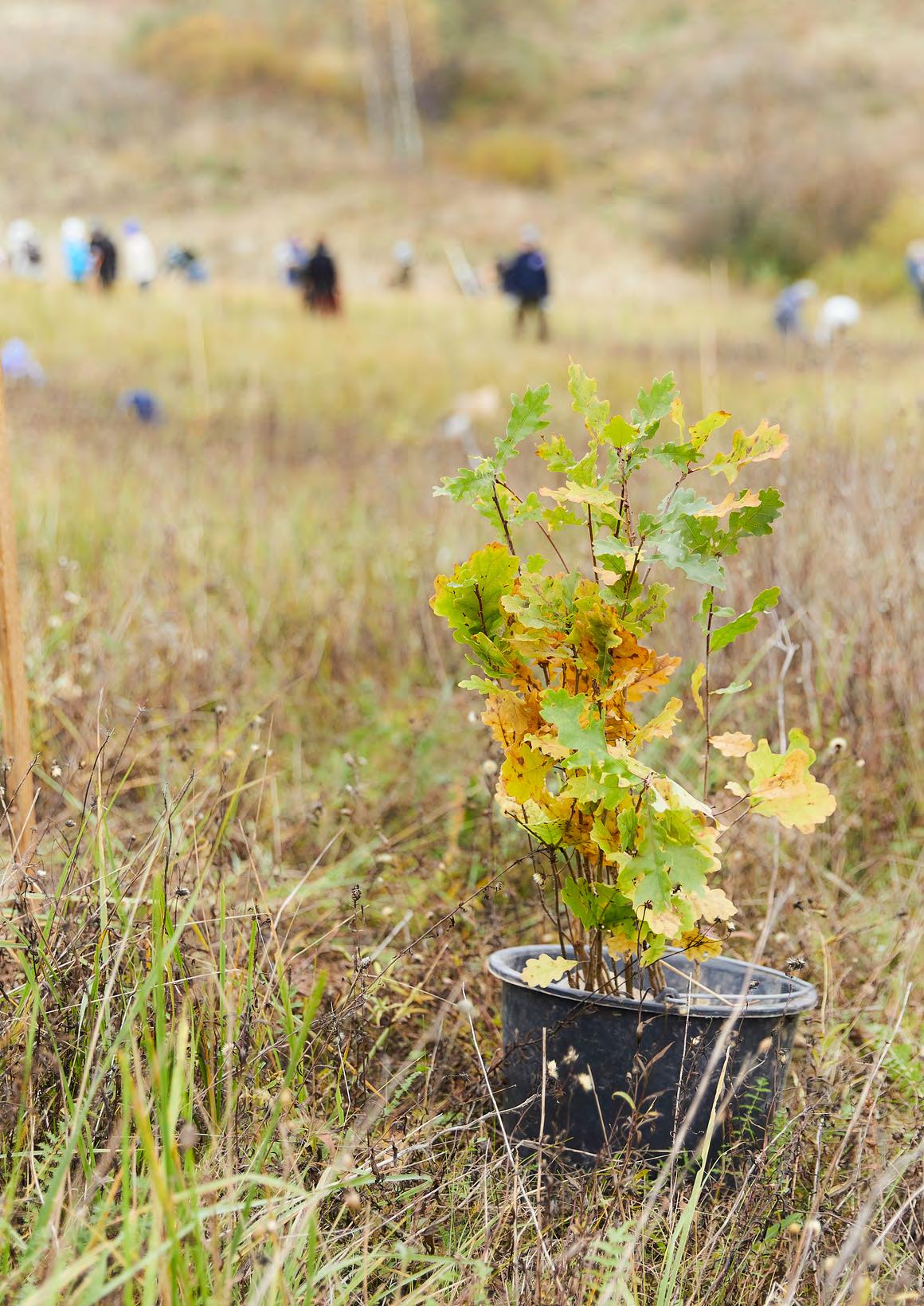
Assessing current Russian attitudes toward environmental problems is challenging. On the one hand, independent researchers face increasing pressure from Russian authorities; on the other, survey respondents are increasingly afraid to express their opinions openly.
Pressure on sociologists, combined with a pervasive atmosphere of censorship in Russia, often forces researchers to reword or soften surveys in ways that affect the reliability of their findings.[7.1][7.2] At the same time, much of the Russian public perceives even anonymous surveys as unsafe. In conditions of tight digital control, state suppression of dissent, and a general atmosphere of fear, many respondents have little faith in the confidentiality of their survey answers – and therefore either attempt to answer in ways they believe are expected of them, or they refuse to participate at all. The first behaviour creates a “social desirability” effect – a bias towards those answers which respondents consider safe.[7.3] The second creates further distortions: those most likely to refuse interviewers’ questions are generally the same people most inclined to assess their current situation negatively, or answer “I don’t know”. This means that the real level of dissatisfaction with a given situation is potentially higher than the survey results record.[7.4]
Additionally, regime-controlled research centres often employ manipulative methods to obtain desired survey results, with the published data then forming official rhetoric, creating the appearance of unity and mass support for government policies. This manufactured consensus further suppresses dissent and creates a “spiral of silence”: the louder the official position is broadcast, the harder it is to challenge.[7.5]
Despite the problems described above, several independent research centres continue to operate in the country, producing high-quality surveys and analyses of public sentiment (for example Public Sociology Laboratory, Russian Field, Chronicles.Report, Re:Russia and ExtremeScan). The majority of them focus on attitudes toward war, human rights and political activism. Such studies can also furnish valuable indirect data on how Russians’ perceptions of social issues –including environmental ones – are changing.
In short, the results of public opinion research, and especially of quantitative studies, should be treated with great caution. Researchers’ potential biases, their independence and their level of interest in obtaining certain types of results all require consideration. Equally important are the formulation of survey questions and how respondents are likely to perceive potential answers as either supportive or critical of the authorities and their policies. These factors can significantly distort the final results.
Against a backdrop of worsening environmental problems and growing environmental injustice, environmental issues continue to occupy an important place in the minds of Russians. More than 90% of survey respondents say that the media should discuss environmental problems. Other topics that attract a similar level of interest include the quality of medical care, social security and corruption. Significantly fewer respondents consider issues such as domestic violence and freedom of speech as deserving equal attention.[7.6]
The most widely cited research into how Russians rate the condition of the environment comes from polls conducted regularly by VCIOM, the state-owned and government-loyal Russian Public Opinion Research Center.[7.7] According to their surveys, positive assessments of local environmental conditions have increased sharply, from 50% in 2017 to 75% in 2024.[7.8]
Clearly, in such a short period of time, there have been no significant improvements in environmental conditions in Russia. Tellingly, when respondents are asked to assess environmental dynamics independently – with questions such as “How do you think the environmental situation in your region has changed recently?” – the results point in the opposite direction, with 18-20% saying that the situation has improved and 36-37% saying it has worsened.[7.9][7.10]
This contrast suggests that the officially published data showing a marked increase in satisfaction with environmental quality is unreliable. In recent years, there have been no alternative quantitative studies free from data distortions, making it impossible to reliably assess the dynamics of Russians’ satisfaction with the environment.
Surveys about which types of environmental issues cause the greatest concern tend to be more reliable. Several research centres have conducted such polls and found responses to be consistent and aligned. Answers to these types of questions are less susceptible to the “social desirability” bias, and they correlate well with pre-2022 data. The top five most pressing issues typically include industrial air and water pollution, waste management, deforestation and vehicle emissions.[7.8][7.9][7.11]
• industrial air pollution
• waste management
• water pollution
• deforestation
• vehicle emissions
Most Russians do not perceive the climate crisis to be among the most serious environmental issues. Recent years have seen a rise in climate scepticism, likely due to the suspension of international environmental organisations’ activities in Russia, as well as to the suppression of the climate agenda from public discussion.
Compared to people in most European countries, Russians feel much less personal responsibility to participate in the fight against climate change, and tend to be more pessimistic regarding the effectiveness of such measures.[7.12]
Percentage of Russians who believe climate change is anthropogenic vs. natural
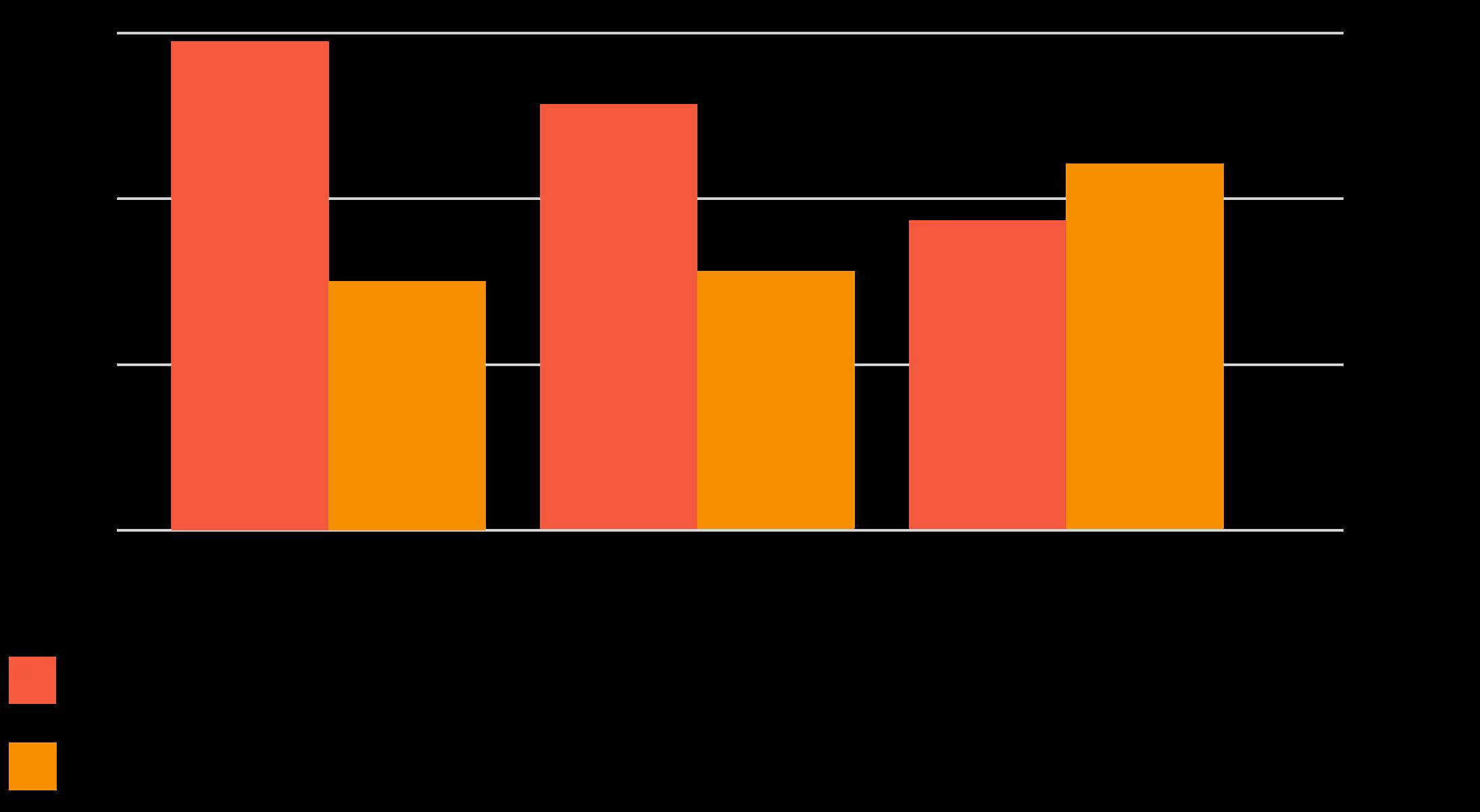
Figure 1.
Source: Greenpeace International, based on data from VCIOM
Percentage of Russians who believe that climate change will have catastrophic consequences for the entire Earth

Figure 2.
Source: Greenpeace International, based on data from VCIOM
Overall, the majority of Russians believe that it is important to take action aimed at protecting the environment, and say that they do. However, the phrase “environmental activities” most often refers to individual action aimed at reducing one’s personal impact on the environment. These include saving electricity and water, purchasing energy-saving appliances and technology, sorting household garbage and participating in nonprotest collective action such as public litter removal days or planting trees.[7.9][7.13]
In European countries, an individual’s socioeconomic status typically correlates positively with their willingness to get involved in solving environmental problems, including by modifying everyday consumer practices. In Russia, however, this link does not exist. On the contrary, a higher socioeconomic status usually accompanies decreased interest in environmental issues.[7.12]
The potential for participation in public activism, particularly if it involves any kind of confrontation, is extremely low. Contemporary Russian society is characterised by deep apathy and a withdrawal from public action. Even people who are critical of the authorities are losing faith in the possibility of creating change through collective efforts. People lack a sense of the efficacy of such actions, as well as positive examples and social support, with these conditions leading to broad demobilisation. This makes it difficult to organise any type of protest, including environmental, and social activism often takes the form of quiet, nonconfrontational behaviour. [7.14][7.15]
The high level of depoliticisation among Russians significantly decreases the potential for protest. [7.16] Even when local populations resist or demonstrate against government or corporate actions, the protests almost never lead to political demands or systemic changes. This is in large part due to the Putin administration’s systematic, long-term efforts to depoliticise the population, which have contributed to a widespread sense of lost political agency and subjectivity. [7.17][7.18]
Another cause of depoliticisation is the lack of institutions capable of conducting systematic work toward fostering civil society and political solutions. The authorities harshly suppress any attempts by opposition-minded citizens to forge political cohesion. In recent years, authorities have also banned large independent civil organisations that were carrying out systemic work, including Memorial, Greenpeace International, WWF, Amnesty International, Human Rights Watch and Transparency International.
In 2025, only 10% of Russians surveyed said that they believe political protests in the country are likely – the lowest recorded level since research centres began tracking this indicator in 1997. Moreover, sharp declines in both belief in the possibility of protests and willingness to take part in them occurred in both 2014 and 2022, at which points Russia invaded Ukraine and political repression increased markedly.[7.19]
On the other hand, local environmental issues, especially in the disadvantaged regions located far from Moscow, continue to seriously worry Russians. Even despite the general state of apathy and harsh repressions, the number of local protests, including direct confrontations, remains significant.[7.20]
Percentage of repondents who:
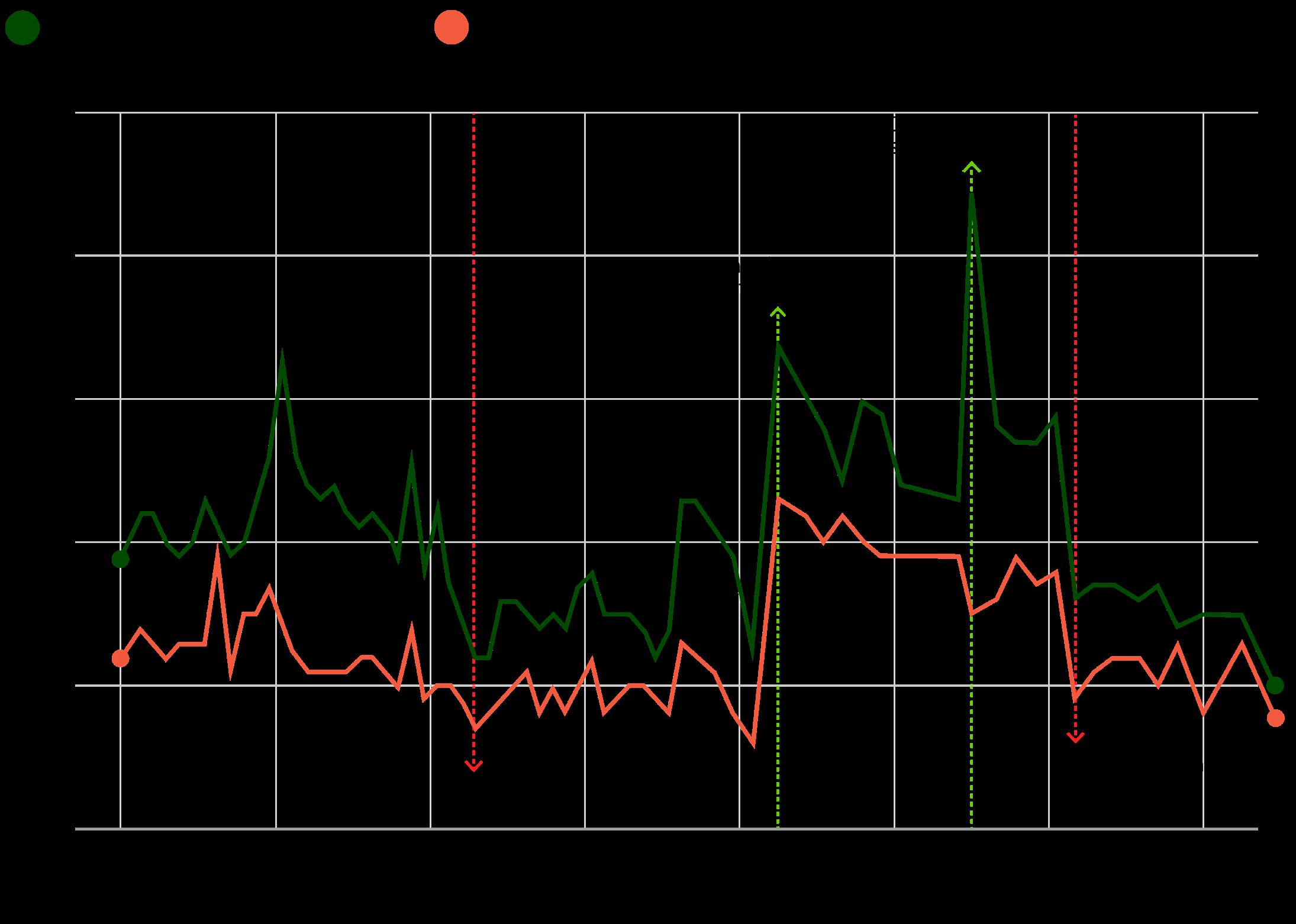
Figure 3.
Source: Greenpeace International, based on data from Levada Center

Action to protect Kushtau Mountain, Bashkortostan, 2020. People unfurled the flag of the republic © Evgeni Romanov / Shutterstock
Since the early 2000s, with Vladimir Putin's rise to power and the transformation of Russia's political system, state pressure has increased on independent organisations, including environmental ones. The 2012 law on ‘foreign agents’ is an important milestone in this process.[8.1] The executive branch unilaterally, without a court order, assigned ‘foreign agent’ status to nongovernmental organisations (NGOs) that receive foreign funding, regardless of the amount, and to those that do political work. However, the law lacked a clear definition of what the state considers ‘political activity’. This allowed officials to interpret the law according to their own judgement and to use it against various civil activities, ranging from signature collection to speaking out publicly in defence of environmental rights.
The 2012 version of the law did not place insurmountable restrictions on organisations declared ‘foreign agents’, but it did compel them to label all of their materials and public speech, and to submit lengthy reports to the authorities. As a result, many organisations continued to operate, and in fact ‘foreign agent’ status became a marker of quality and credibility within Russia’s pro-democracy community.
Over time, restrictions on ‘foreign agents’ became more stringent. In July 2022, a new law passed: “On controlling activities of individuals operating under foreign influence”.[8.2] This significantly expanded the formal grounds for assigning ‘foreign agent’ status: officials no longer needed to show proof of foreign financing; it was enough to declare that an individual or organisation was “under foreign influence”, for any reason.
The list of activities governed by the law has also been expanded, and it now applies not only to NGOs but potentially to any association, organisation or private citizen. Like other repressive legislation in contemporary Russia, its vague formulation gives officials broad latitude to use it to punish any unwanted or independent activity.
“Even an astronaut arriving from another planet, if he starts performing miracles against our country, will be a foreign agent,”
After the tightening of ‘foreign agents’ legislation between 2022 and 2025, significant restrictions made working in Russia practically impossible for organisations with the status. ‘Foreign agents’ found themselves socially and professionally isolated because collaborating with them became toxic and dangerous. Violations of the law left individuals and organisations vulnerable to criminal prosecution and is punishable by prison terms of up to five years.[8.4]
As of April 2025, the list of ‘foreign agents’ included more than 1,200 organisations and citizens. By comparison, in the first ten years after the law came into force, the list grew by an average of around 40 entries annually, and since 2022 by 250 per year.[8.5]
Russian authorities actively use the ‘foreign agent’ law to exert pressure on dissent, extending far beyond the political sphere. Opponents of the war, LGBTQ+ individuals, environmental and other social organisations, and anyone deemed inconvenient to the authorities have all been subjected to the discriminatory status.[8.6]
One of the first environmental organisations to receive ‘foreign agent’ status was the group Ecodefense!, due to its opposition to the construction of a nuclear power plant in the Kaliningrad region.[8.7] In June 2022, the European Court of Human Rights (ECHR) upheld a claim filed by Ecodefense! and 60 other plaintiffs against the Russian Federation. The Court found that the Russian government’s application of the ‘foreign agent’ law violates citizens’ rights to assembly, protected by Article 11 of the European Convention on Human Rights. [8.8] However, by that time, Russia had been expelled from the European Council and it refused to act on the ECHR’s decision.
A 2015 law on ‘undesirable’ organisations is even more stringent.[8.9][8.10] It allows the Prosecutor General to declare international and foreign organisations ‘undesirable’ without a court decision. The status effectively bans an organisation from any activity in Russia, including the distribution of information and use of organisational symbols.
As with the ‘foreign agent’ law, the grounds for declaring an organisation ‘undesirable’ are vaguely defined – for example, posing “a threat to constitutional order or state security”. This vagueness empowers authorities to use the law selectively and without having to justify their position.
Before the full-scale invasion of Ukraine, this law was only once used against environmentalists: the organisation Pacific Environment was labelled ‘undesirable’ in 2018. During just four months of 2023, five international organisations were labelled ‘undesirable’: Norwegian foundation Bellona, which by that time had already ceased its operation in Russia; two flagship environmental organisations working in Russia – Greenpeace International and the World Wildlife Fund (WWF) – as well as two USbased organisations – the Altai Project and the Wild Salmon Center.[8.11][8.12][8.13]
According to Amnesty International, the purpose of the law on ‘undesirable’ organisations is to isolate politically active people in Russia, create an atmosphere of fear and uncertainty, and minimise cooperation between Russian and European, American and international organisations.[8.14]
Prior to 2022, the Russian environmental movement already faced serious pressure. At the time, 34 regional environmental organisations had been declared ‘foreign agents’, with the majority – including well-known NGOs such as the Siberian Environmental Center, Bellona, Dront Ecological Center, Sakhalin Environmental Watch and the Baikal Environmental Wave –forced to halt their operations.[8.15]
Repressions have intensified since the beginning of the full-scale war. In the past three years, Russian authorities have targeted 553 environmental activists and organisations.[8.16] Earlier periods also saw a gradual increase in pressure, but it became particularly widespread in 2022, with over 300 repressive incidents were recorded.[8.17]
The most common forms of state political pressure are fines, administrative arrests and criminal prosecutions. Authorities also continue to declare both communities and private individuals ‘foreign agents’, while recorded cases mount of attacks on activists and the use of punitive psychiatric measures against them.[8.16]
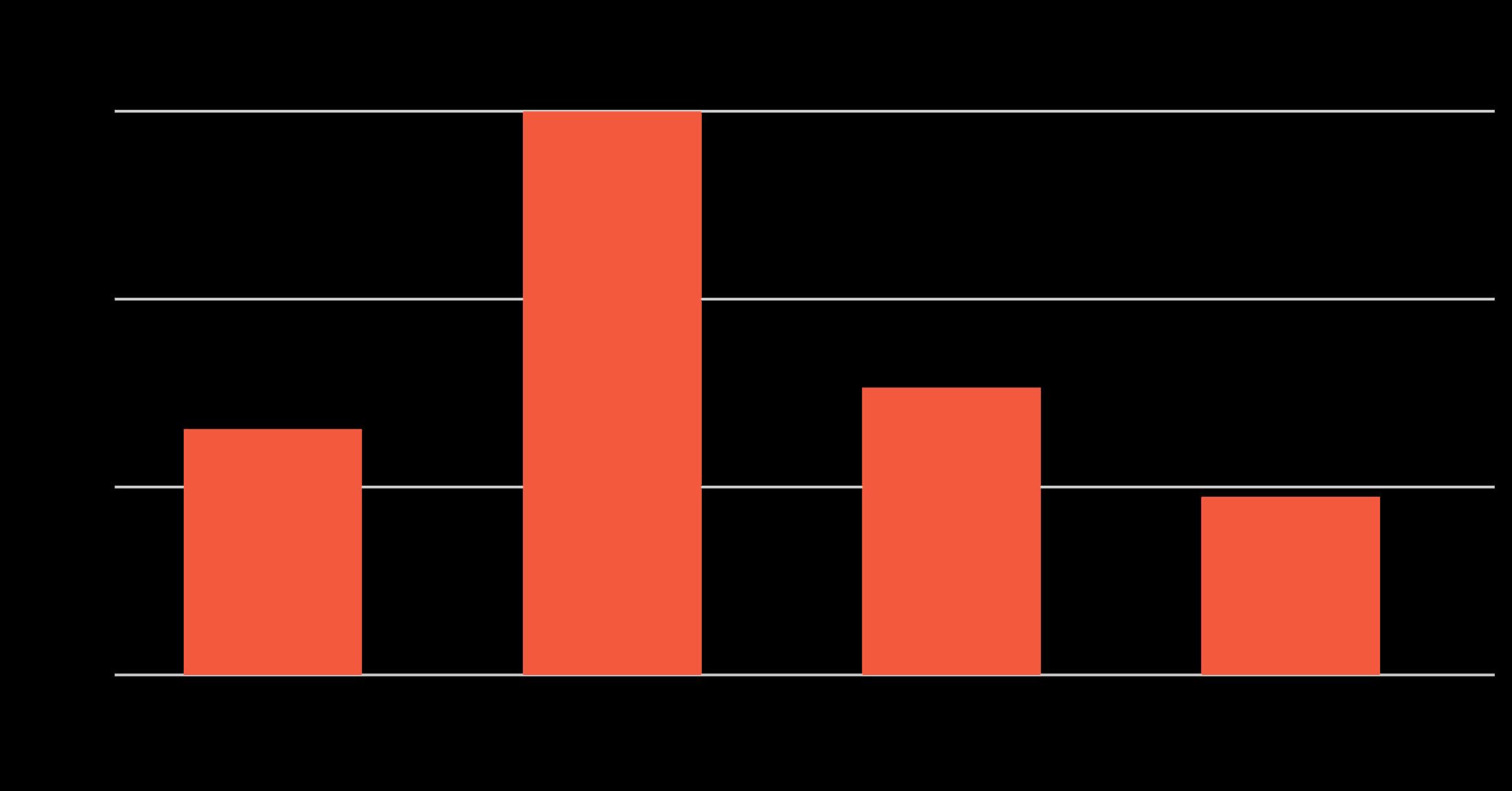
Figure 1.
Source: Greenpeace International, based on data from the Environmental Crisis Group [8.16]
The decrease in cases of state pressure on the environmental community in 2023–2024 is unlikely to indicate a decrease in repression, but rather a weakening of the environmental community itself and the transformation of its activities. The Putin regime’s actions have resulted in a number of organisations halting work and a significant number of activists leaving the country. Those who remain are left to adapt to new conditions by reducing the level of confrontation, avoiding topics that authorities consider sensitive and employing coded, Aesopian language in order to decrease the risk of state persecution.[8.18]
The most brutal repressions in recent years were directed at participants in a protest against a gold mine in Bashkortostan. The trigger was a speech delivered by local activist Fail Alsynov at a public meeting in one of the affected villages, for which he was sentenced to four years in prison.[8.19] The verdict sparked a wave of protests in the town of Baymak, which then spread to Ufa, the capital of Bashkortostan. Police violently dispersed the protests, which drew several thousand participants, and opened criminal prosecutions against 82 people. One of the people detained, Rifat Dautov, was killed following his arrest.[8.20] Another, Minniyar
Bayguskarov, committed suicide due to pressure from Russian security services.[8.21]
Two more, Dim Davletkildin and Zaki Ilyasov, were seriously injured as a result of torture by police.[8.22] Overall, the Baymak case, which began with environmental demands, has grown into the largest regional conflict between residents and authorities since the start of the full-scale war in Ukraine.[8.22][8.23]
A study of environmental protests held in the pre-war years reveals that the severity of repressions at regional level correlates with the degree of social inequality (per the Gini coefficient1). The greater the social stratification in a region, the more regional authorities fear protest activity – and the more harshly they suppress it.[8.24]
Besides environmental activists, workers in protected natural territories have also faced pressure, including criminal prosecutions, from law enforcement agencies.[8.25]
1 The Gini coefficient is a statistical measure of inequality, most commonly used to assess income or wealth distribution within a population.
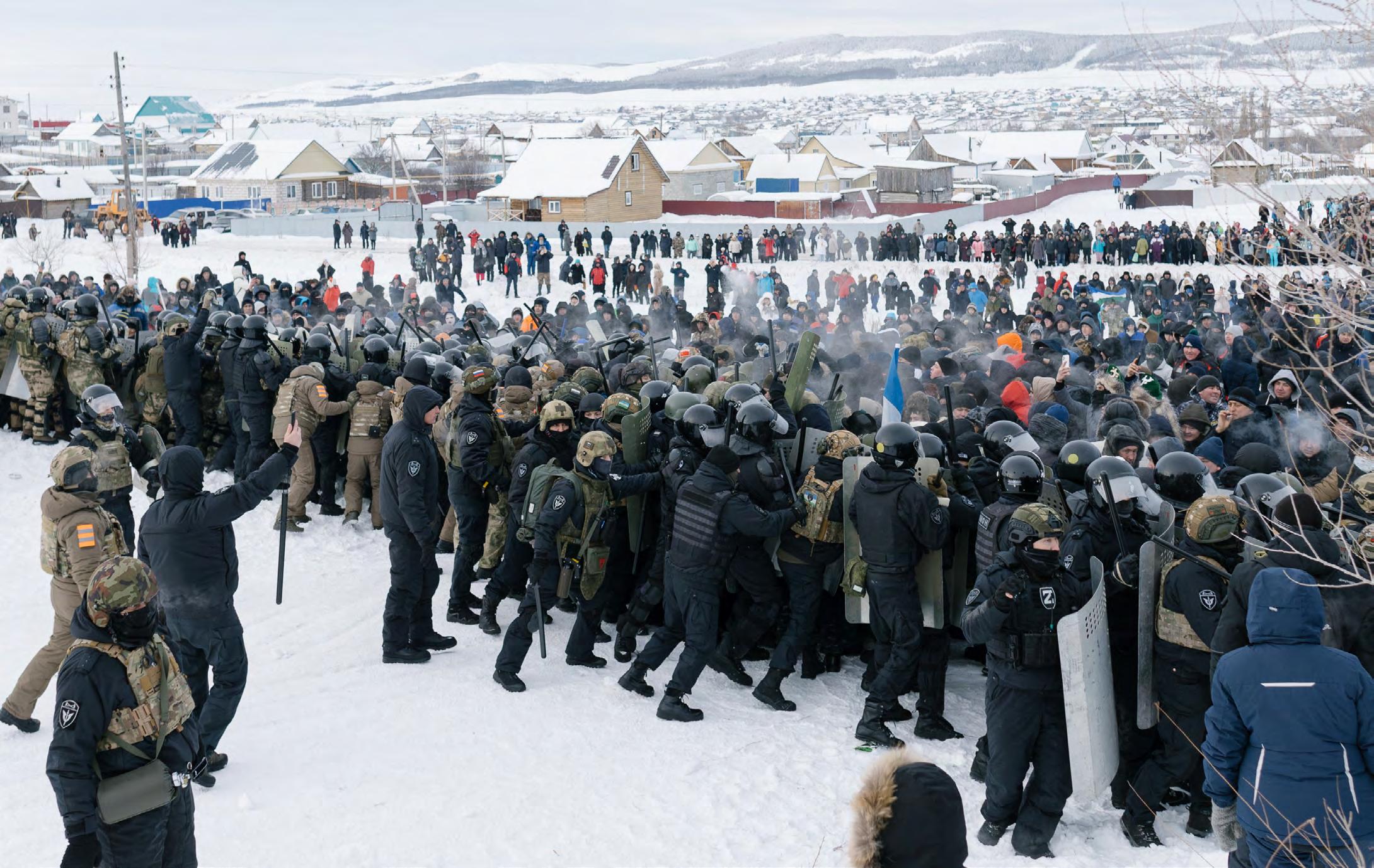
In 2022, a significant portion of Russia’s environmentalist community held anti-war sentiments and many environmental activists took part in anti-war protests. In the days following Russia’s full-scale invasion of Ukraine, 1,500 environmental activists, volunteers and representatives of environmental organisations signed an open letter against the outbreak of military action.[8.26] The letter was subsequently deleted amid the criminalisation of any anti-war speech and repressions against civilians who criticise Russian aggression.
At least 110 environmental activists have faced persecution for expressing anti-war views. Most received fines and jail terms of five to 15 days. However, in a number of cases, speaking out against the war let to criminal prosecution, with several environmental activists sentenced to prison for up to six years.[8.27]
Arshak Makichyan, a climate activist and the organiser of the Fridays for Future demonstrations in Russia, along with his family, was stripped of his Russian citizenship for his anti-war speech and forced into exile.[8.28]
At the same time, a number of local environmental communities have been split by differing views on the war. This has undermined previous solidarity, reduced their environmental activism, and in some cases led to suspension of the groups’ activities altogether.[8.29]
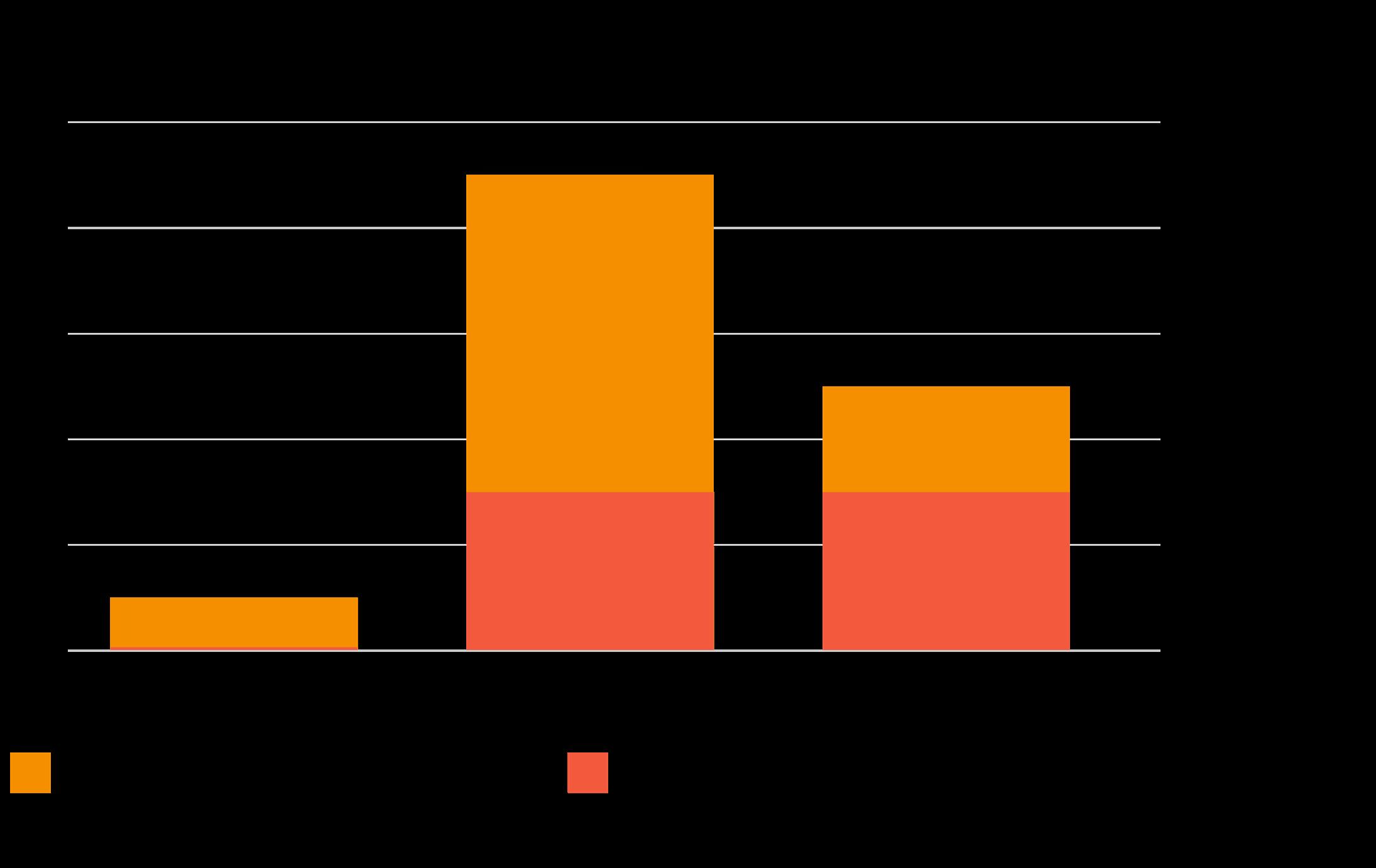
Source: Greenpeace International, based on data from the Environmental Crisis Group [8.27]
The start of the full-scale war and the dramatic escalation of repression against civil society have radically changed the state of environmentalism in Russia.
Nearly all of the leading independent organisations that formed the backbone of the environmental protection movement have ceased their operations in the country. Several of them, like Bellona, had already closed their Russian offices of their own volition by 2022, finding it impossible to continue interacting with Russian authorities.[8.30] Others, like WWF and Greenpeace, continued their work up until authorities declared them ‘undesirable’, which is effectively a total ban on their activities on Russian territory.
Emigration has also had a significant impact on the environmental movement. After the start of the full-scale invasion, around 650,000 people left the country.[8.31] Although that number amounts to less than 0.5% of the population2, the exodus has impacted Russia’s civil society landscape, chiefly because of the marked difference in levels of civic and political activity between those who emigrated and those who stayed. According to survey data, 78% of post-war emigrants said they left the country because they disapproved of state policy. This group’s level of civic activism is significantly higher than the national average.[8.32]
Many experts and activists who have left Russia continue to work in exile, despite the many challenges of forced emigration. These include discriminatory barriers in EU countries, such as restrictions on entry and residence; limited access to humanitarian visas, and difficulties in arranging Schengen visas from third countries.[8.33]. In the latter case, Russian emigrants are forced to return to Russia to submit documents, which exposes
2 For comparison, about 13% of the population left Ukraine because of the war.
them to the direct threat of persecution. It is impossible to view the environmental movement in isolation from other elements of civil society. Environmental organisations collaborated closely with human rights defenders – both to protect activists from persecution and to implement environmental projects defending the right, enshrined in the Russian constitution, to a healthy environment. Cooperation with independent media outlets was another important aspect of the environmental movement’s work. These outlets helped to spread information about environmental problems, involve people en masse in environmental projects, and to popularise an eco-conscious lifestyle.
The systematic destruction of human rights organisations and independent journalism in Russia, which began after Putin came to power and sharply intensified following the full-scale invasion, deprived environmental organisations of key allies within civil society and seriously reduced the effectiveness of their work.[8.34]
Realising that environmental issues continue to arouse interest in a significant portion of the population, authorities do not aim to eradicate them as they do with, for example, LGBTQ+ groups, feminists and anti-war movements. Instead, the Russian regime is attempting to appropriate the environmental agenda, integrating it into controlled formats and mimicking the activities of civil society via specially created organisations – the so-called Government-Organised NGOs (GONGOs) and Business-Organised NGOs (BONGOs). Various governmental departments, including environmental agencies, hold what they call ‘community councils’, which simulate civic participation while remaining under bureaucratic control. Examples include the Public Council under the Russian Ministry of Natural Resources and the Environment and the Public Council under Rosprirodnadzor, Russia’s environmental oversight agency.
At the same time, business interests and budgetary funds finance projects that involve the public in mass environmental activity, primarily in planting forests. [8.35] Such initiatives exploit the public’s demand for environmental action, while skirting the systemic causes of Russian forest degradation and avoiding the issue of state and corporate responsibility. Some projects incorporate the occupation of Ukrainian territory into their own narrative, planting forests in captured territories and supporting the invasion. [8.36]
Among the best-funded environmental NGOs are organisations created by Russia’s largest companies in the extractive industries, Rosneft and Gazprom. One of Russia’s main polluters, Norilsk Nickel, and the state-operated atomic monopoly, Rosatom, both also actively participate in implementing NGO projects that position them as environmental protectors.[8.37]
Vladimir Putin’s 2025 creation of the Presidential Fund for Environmental Projects is a vivid illustration of the trend towards further absorption of environmental NGOs by the state. The fund has a budget of 1 billion RUR (around 10 million USD) and is designed to finance nonprofit environmental projects. The composition of its coordinating council is illuminating: it is led by Sergey Kiriyenko, the de facto supervisor of the Kremlin’s domestic policy bloc and the former head of Rosatom; and its deputy directors are Sergey Ivanov, the former defence minister, and Dmitry Patrushev, the son of a former director of the Federal Security Service (FSB).[8.38]
Despite mounting pressure from Russian authorities on environmental organisations from the 2010s onwards, the pre-war period was characterised by a growth of grassroots environmental protests in Russia’s outlying regions. This was related to weakening environmental legislation and steadily rising corruption, which led to an increase in large, environmentally dangerous projects that ignored the interests of local residents. Many conflicts that began with environmental demands later came to include social and political dimensions.
In 2019, protests erupted in Yekaterinburg in defence of a park slated for the construction of an Orthodox church. Over the course of three days of protest, despite a ban by authorities, between 2,000 and 5,000 people took part each day.[8.39] The protests expanded to include criticism of the Russian Orthodox Church for its involvement in corruption schemes and serving state interests, alongside the destruction of the park’s trees.[8.40] The church’s construction was sponsored by Russia’s largest copper mining holding, the Russian Copper Company, whose own security forces and combat sports clubs participated, alongside police, in violently dispersing the demonstrations.[8.41] Despite the brutal suppression of the protest and the persecution of several participants by law enforcement agencies, the decision to cut the park’s trees was reversed.[8.42]
One of the most powerful environmental –and simultaneously political – protests in contemporary Russia was the 2018–2019 opposition to the construction of a landfill near Shiyes railway station in the Arkhangelsk region.[8.43] The landfill was intended to receive waste from Moscow, whose authorities had failed to reform the city’s waste management industry, leading to an acute shortage of land for waste disposal.
Local residents’ protests, which initially focused on the environmental threats to the region, revealed deep social conflicts – between Russia’s urban core and rural peripheries, rich and poor, the authorities and society. Trash became a metaphor for inequality in the country: waste from the capital was exported to the regions where residents felt like second-class citizens. [8.44] This symbolism helped protestors garner support from many other regions where residents felt social stratification and injustice, and to bring the struggle to the federal level. As a result of the unrest, the governor of the Arkhangelsk region resigned and the new regional authorities refused to complete the project.[8.45]
In 2020, a conflict arose in Bashkortostan around Kushtau mountain, where a quarry for limestone, a necessary ingredient in the production of soda, was planned. Kushtau is a unique shihan (limestone hill), a natural monument that is also sacred to the Bashkir people and is mentioned in their national epics.[8.46] In August 2020, activists and local residents organised a tent city at the foot of Kushtau in order to stop logging and the beginning of geological exploration. The standoff between defenders of the mountain and the police led to mass arrests and clashes. The protests received wide public support and media coverage, and led to the cancellation of the limestone mining project.[8.47]
Though these examples ended in victory for the protesters, they did not lead to systemic changes in addressing waste management, protection of green spaces or extraction of natural resources. These were situational NIMBY (‘not in my backyard’) protests which were largely limited to demands against economic activities in specific areas. At the same time, they provided local communities with important experience in defending their rights to participate in decisions about their lands, natural environment and cultural heritage.[8.48] These protests showed that people are capable of self-organisation and mass civic mobilisation, revealed the relationship between environmental issues and social stratification, and highlighted the sensitivity of the topic of environmental injustice for Russian society.3
3 ‘Environmental injustice’ is the unequal distribution among various social groups of environmental risks and damage.
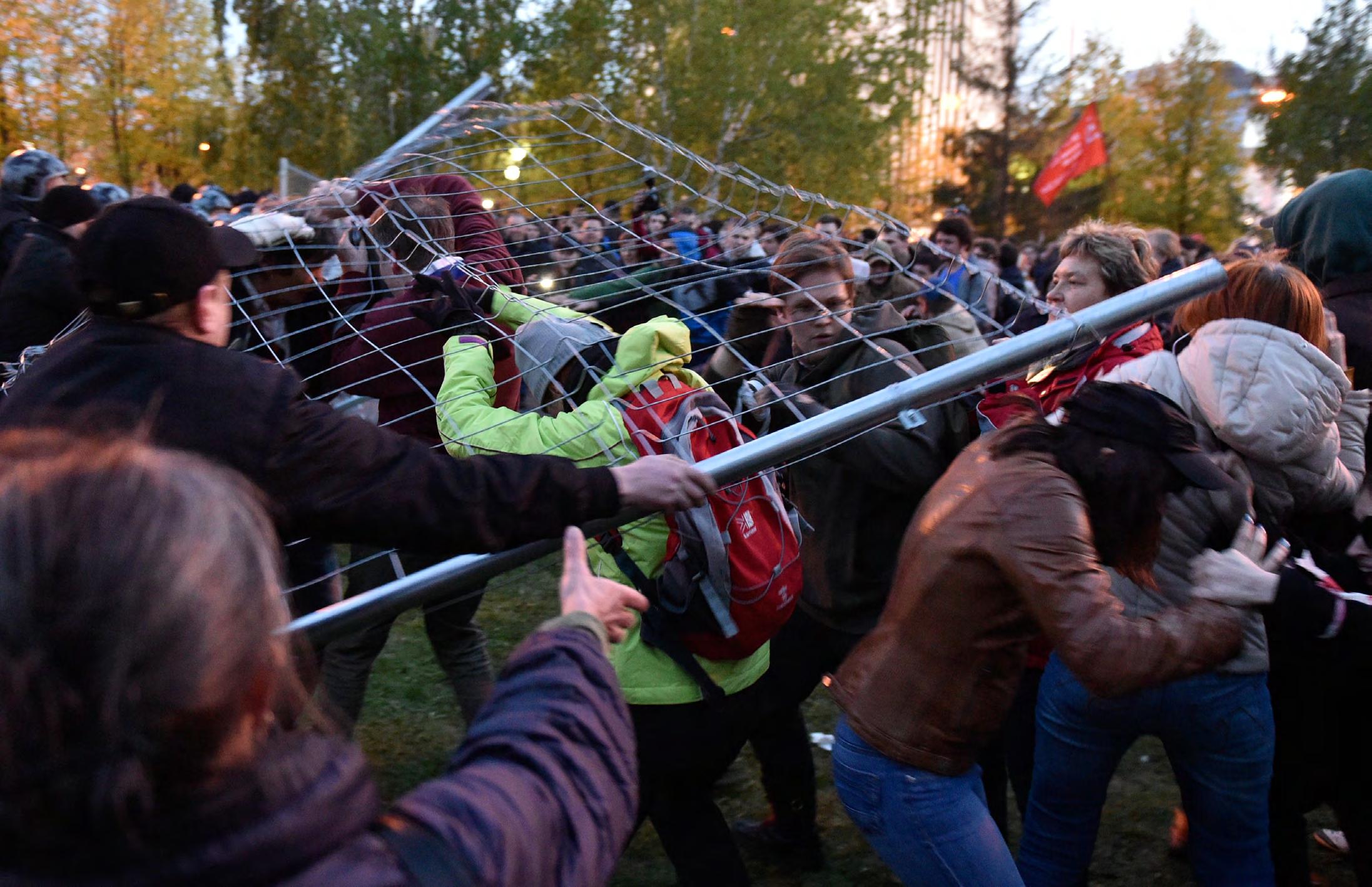
The radical transformation of the Russian environmental movement landscape that began in 2022 has led to significant changes to both environmental activism and expert environmental work.
The range of methods for conducting the type of advocacy campaigns initiated by professional environmental organisations have been significantly curtailed. This reduction is related both to the decline in the number of such organisations and to the shrinking variety of acceptable methods for conducting such campaigns.4 Under current conditions, environmental advocacy in Russia typically consists of preparing expert opinions for draft legislation, creating online petitions and participating in ‘public councils’ run by state agencies. The possibilities for conducting public campaigns and educational work are limited
4 We are deliberately not providing the names of organisations doing effective work in Russia, or the names of activists, so as not to expose them to the risk of persecution.
to ‘safe’ topics, while mobilising people for protest or direct action has been criminalised to a significant degree and can lead to an organisation’s liquidation and the persecution of its employees. At the same time, even under such harsh conditions, environmental organisations have managed to achieve individual victories, including preventing the weakening of environmental legislation, preserving valuable natural territory, and halting dangerous projects.[8.49][8.50]
One important case is the first climate lawsuit against the Russian government, filed in September 2022 in the Supreme Court of Russia. The suit was brought by two NGOs and 18 individuals representing various groups, the majority of them Indigenous.[8.52] After the Supreme Court refused to hear the case, the plaintiffs appealed to the European Court of Human Rights (ECHR) and the Constitutional Court of Russia.[8.52][8.53] Despite Russia’s lack of an independent judicial system and authorities’ refusal to uphold ECHR decisions, this precedent has become an important step in the struggle to reduce Russia’s contribution to the climate crisis.
In spite of growing repression, the rising number of cases against activists, and mounting pressure on environmental NGOs, the scale of local protest activism has not dramatically changed. This can be explained by several factors, including the continued growth of environmental injustice, disregard for residents’ opinions in implementing commercial and infrastructure projects, and corruption.
In terms of the number of protests in 2023, environmental issues ranked third, outnumbered only by protests against political repression and the war in Ukraine. [8.54] In 2024, amid a decline in anti-war protests, environmental issues rose to second place.[8.55] The number of protests related to the placement of landfills and waste treatment facilities rose significantly.[8.56]
Overall, local environmental campaigns and protests achieved their aims more often than other types of civic activism.[8.57] However, as in pre-war years, these victories generally did not bring about systemic change.
Environmental activism remains one of the most popular forms of civic engagement. The environmental agenda enjoys broad social support, attracting interest from diverse segments of society, regardless of political views or socioeconomic status. Environmental issues are less marginalised than others such as feminism, LGBTQ+ rights and anti-war activity. State propaganda does not yet associate environmental activism with ‘Western’ values whose threats must be eradicated. This is largely because environmental activists themselves avoid making overtly political demands. Under authoritarianism, maintaining distance from politics and avoiding confrontation are important features of the Russian environmental movement, which significantly limits its ability to make institutional changes.[8.24][8.58]
Despite a general state of apathy and growing pressure from authorities, Russian society has retained a need for social interaction and cooperative activity. Non-confrontational forms of environmental activism, which carry lower risks for participants and therefore have greater mobilisation potential than protests, continue to develop. Local initiatives – to improve public spaces, clean up natural areas, promote recycling and support zero-waste communities – satisfy demands for participation in environmental activism and social interaction. Although such activities do not lead to large-scale systemic change, they help foster experiences of collective interaction and solidarity.[8.59]
Currently, environmental activists are making increasing efforts to leverage the authorities’ prowar and authoritarian rhetoric to strengthen their own communications. In Bashkortostan, activists sought permission to hold a rally with the slogan: “For Putin! For Victory! For Clean Air!”[8.60] In Yekaterinburg, activists placed portraits of Putin on trees that they hoped to protect from being cut down.[8.61] In Dagestan and Krasnodar Krai, video messages from soldiers who had participated in the invasion of Ukraine were distributed, demanding the closure of landfills. [8.62][8.63] While such tactics can be effective in solving specific local problems, incorporating regime rhetoric into civic activism fuels the authoritarian system, which remains one of the major sources of environmental and social problems in contemporary Russia.
The response to a recent large Black Sea oil spill offers a telling example of people’s ability to organise around environmental problems. In December 2024, two tankers crashed in the Kerch Strait, spilling several thousand tons of heavy fuel oil into the water. Within days, the oil began to wash up on the shore in both Ukraine and Russia, with the most serious pollution recorded on the coast of Krasnodar Krai, especially around the town of Anapa.[8.64]
Immediately following the incident, against the backdrop of total inaction from authorities, several thousands of volunteers from all over Russia assembled in the hardest-hit areas to clean oil off the beaches and to rescue birds. An even greater number of activists provided remote support.[8.65] An extensive mutual aid network formed
on Telegram messenger, uniting nearly 100,000 people. In a short period of time, the network managed to organise logistics, a system for assigning tasks, keeping participants informed, fundraising and purchasing equipment.
The effort became a unique example of decentralised civic mobilisation in contemporary Russia.[8.66] In large part thanks to this selforganisation, which received a widespread public response, authorities were forced to join the efforts to eliminate the consequences of the catastrophe. Testimony from participants in the cleanup about the scale of pollution, state inaction, bureaucratic obstruction and the oil industry’s role in environmental destruction helped society see more clearly how destructive an oil-dependent regime is for the country.[8.67]
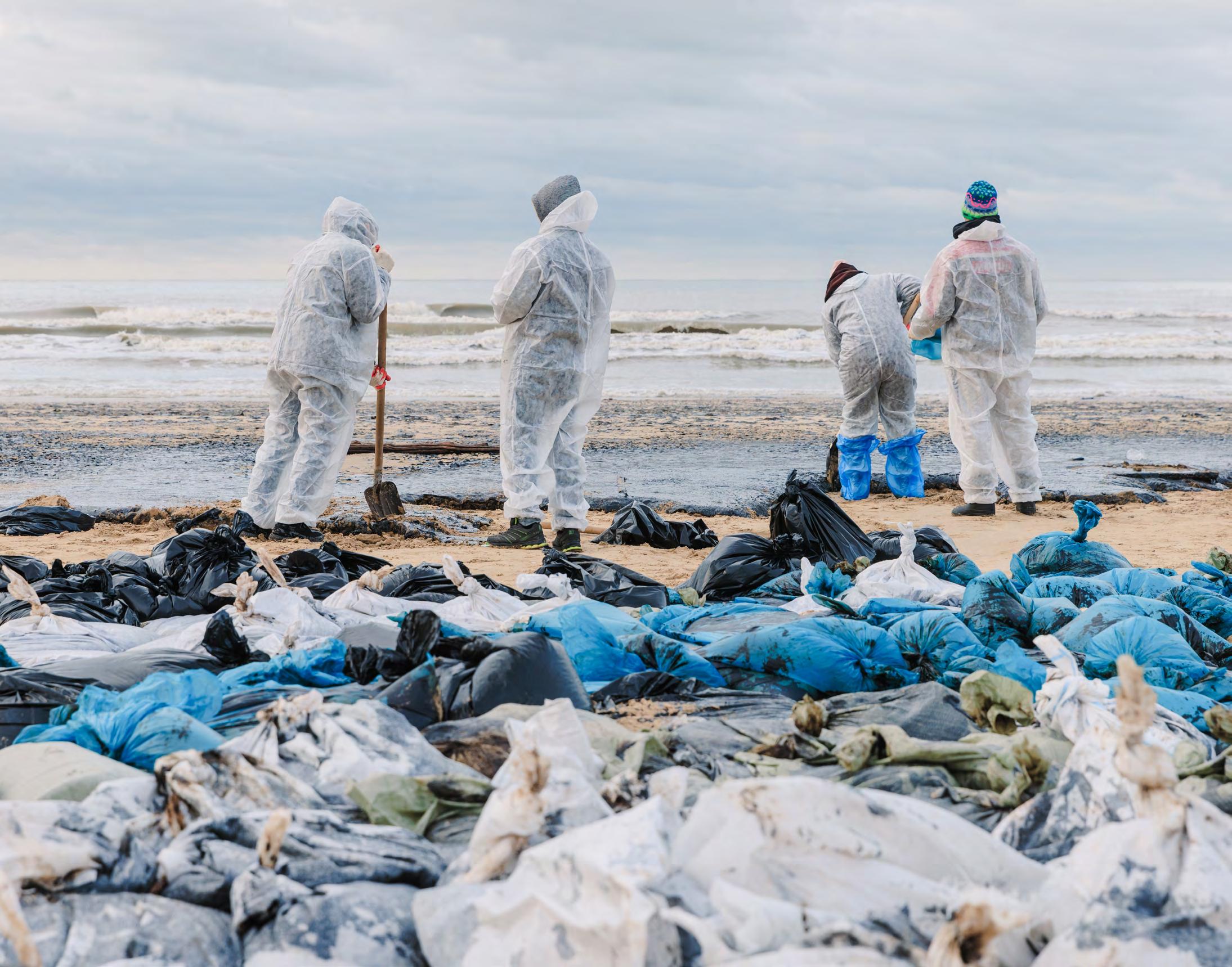
Many representatives of the environmental movement who left Russia continue to engage with Russian causes, either joining existing communities or creating new ones. From outside Russia, they enjoy greater freedom to act and speak out, but their ability to interact with Russian society and influence processes within the country are significantly limited.
Nonetheless, the environmental community in exile does important work: it shapes public opinion in other countries, interacts with decision makers and offers support to activists who continue to operate inside the country. For example:
• Ecodefense! continues its work against Rosatom overseas projects and distributes information about the climate crisis;
• The expert community Green Think Tank analyses the environmental protection situation in Russia;
• Bellona focuses on nuclear and radiation safety in Ukraine and Russia, the climate crisis and industrial pollution in the Arctic;
• Activatica monitors protest activity, including environmental protest;
• The Ukraine War Environmental Consequences Work Group, which includes ecologists from Ukraine, Belarus and Russia, monitors the environmental consequences of Russia’s invasion of Ukraine.
Russian authorities’ pressure on civil society has been ongoing since the early 2000s and has only intensified over time. While that pressure previously focused primarily on the political opposition, independent media and human rights organisations, the level of repression has increased sharply since the start of the fullscale war with Ukraine, radically changing the landscape of the entire civil sector in Russia, including the environmental movement. A large part of the movement’s institutional infrastructure has been destroyed, leading organisations’ operations have been banned and a significant number of activists have emigrated. Overall, these issues have sharply reduced the environmental community’s ability to influence decisionmaking and to resist destructive actions by the state and big business.
Authorities’ rhetoric and actions indicate that if the current regime remains in place, pressure on environmental initiatives will continue to intensify, especially those efforts that show signs of self-organisation, solidarity and agency.
The toolkit available to independent environmental organisations continues to shrink. Their activities are becoming less confrontational and increasingly selfcensoring. At the same time, authorities recognise that the environmental agenda is important to Russians and collaborate with extractive industries to attempt to co-opt the movement, creating the appearance of civic activism via statecontrolled structures and projects. This allows them to satisfy public demand for environmental initiatives while sidestepping the systemic causes of environmental problems and masking both state and corporate responsibility.
The avoidance of political demands is a characteristic feature of the Russian environmental community. On the one hand, it allows the movement to achieve results at the local level more frequently, to distribute information more easily and to lower activists’ personal risk. On the other, this approach does not produce systemic change and prevents the movement from scaling the results of individual victories or influencing authorities’ strategic decisions. As a result, environmental problems are most often perceived as local and isolated from other spheres of life, similar to issues like utilities or public space improvements, which obscures their true existential significance for people’s lives and the country’s future.
Against a backdrop of growing environmental injustice, official disregard for citizen’s opinions, and the degradation of the natural environment, the public shows sustained interest in environmental issues, especially at the local level. Despite intensifying pressure from the regime, the environmental movement demonstrates a high capacity for adaptation. In place of the formal NGOs characteristic of the 1990s and 2000s, activists today increasingly work via informal initiatives and use digital technology to organise and mobilise. New communities are emerging that use horizontal, localised and more resilient forms of activism under repressive conditions. Interaction between activists and experts who remained in Russia and those who emigrated is becoming normalised. The environmental agenda retains a high mobilisation potential and broad social approval, making it one of only a few remaining forms of civic activism capable of catalysing meaningful change in Russian society.
Environmental injustice in contemporary Russia is intertwined with other forms of social inequality and discrimination, and their analysis requires an intersectional approach. Repression and environmental degradation primarily affect the most vulnerable groups – Indigenous Peoples, residents of peripheral regions and low-income groups. Conflicts, such as protests against landfills, natural resource extraction and industrial seizures of natural areas, demonstrate that environmental threats in contemporary Russia frequently correspond with infringements on cultural, economic and political rights. The interweaving of environmental, ethnic, class and territorial forms of oppression increases the potential for protests and also leads to harsh responses from authorities.
The experience of transforming the Russian environmental movement under rapidly intensifying authoritarian conditions presents an important case study for adaptation strategies, the resilience of local initiatives, and the survival practices of civil society. Analysing this experience may provide valuable insights for other countries also facing the erosion of civil liberties.
Kochubeevskaya wind farm, Stavropol Region
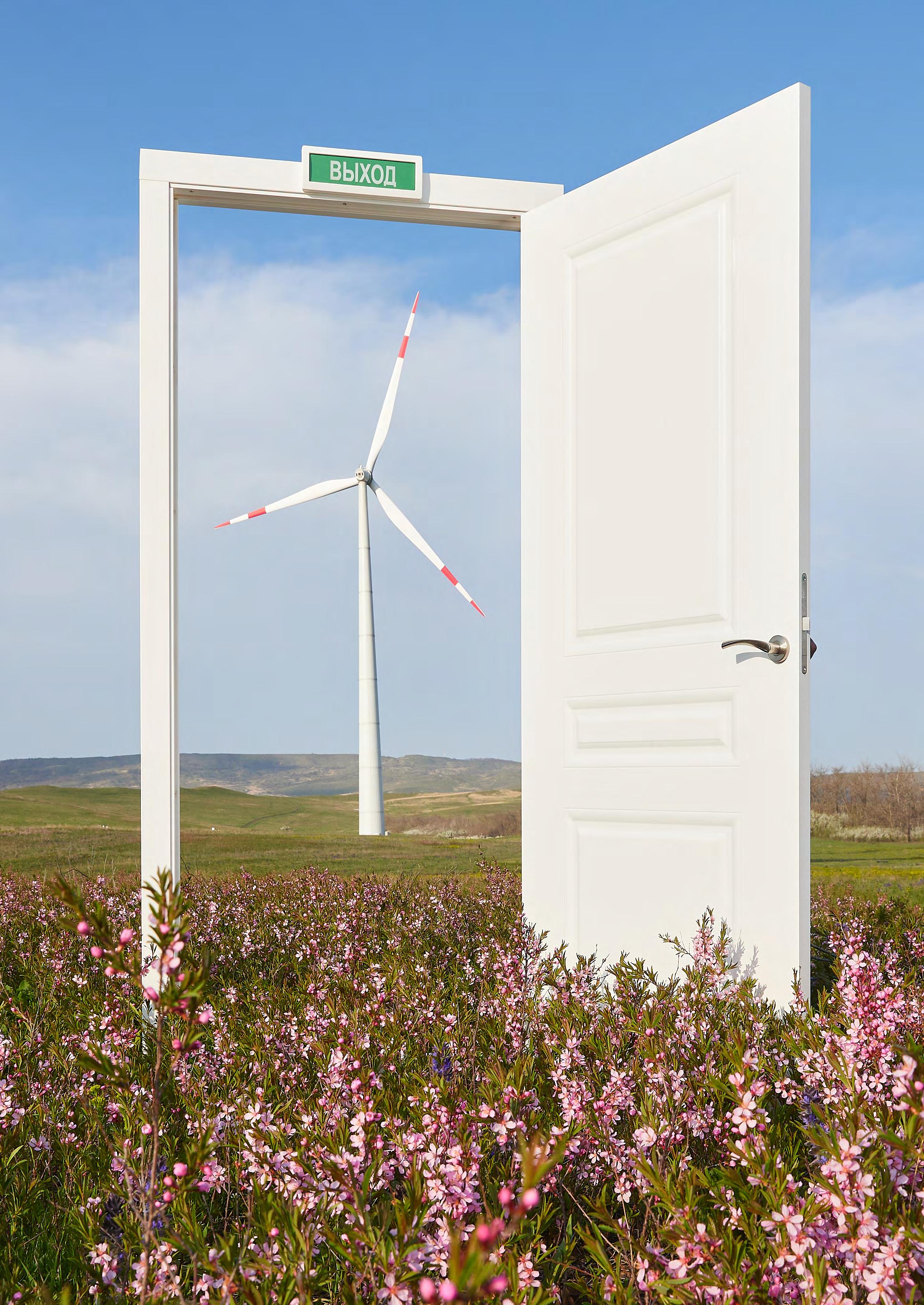
In the context of an aggressive war, domestic repression and a shift in state priorities towards military and extractive agendas, environmental protection has been pushed to the margins of Russian policy. Nevertheless, the consequences of these developments, as well as alternative paths that could have been taken, merit reflection. To open such a conversation, we invited Felix Jaitner, Ph.D., Fellow at the Institute for Global Reconstitution in Berlin and a specialist in political ecology and extractivism in Eastern Europe and the post-Soviet space, to discuss these topics. In this commentary, Jaitner offers a vision of a different approach – one focused on environmental sustainability and the long-term interests of society. We hope this commentary can serve as a starting point for a broader and fruitful public conversation about how to build a safer, greener and more peaceful future.
Russia's abundant natural resources appear to be both a blessing and a curse. In theory, they allow for the development of a diversified economy and the continuous supply of national industries. The resulting prosperity could contribute to the social and cultural wellbeing of the entire population and guarantee an above-average standard of living.
In reality, though, the country's abundance of resources hampers its industrial development. In fact, Russia exports a large proportion of its raw materials, often without further processing. Hightech products and consumer goods, on the other hand, are mainly imported. This phenomenon, known as the ‘resource curse’, creates a vicious cycle, in which the country relies on the constant expansion of raw material exports to generate further income, thus further increasing its dependence on other countries buying its
resources. Тhis economic model is particularly beneficial to a small elite. Based on the Gini coefficient, Russia has extremely unequal distributions of income and wealth compared to other countries. At the same time, the exploitation of fossil fuels (oil, gas, coal) and metals is exacerbating climate change. The dilemma of dependent development and ecological crisis raises the question of what alternatives to the extractive model – which is based on the exploitation and export of raw materials – exist.
This article analyses the extractive development model in Russia and the possibilities for overcoming it. Special attention is paid to the potential role of public participation and activism. The development of strategies to overcome extractivism in Russia is all the more pressing in the light of decarbonisation strategies in Europe and China, Russia's two main importers of fossil fuels. The transition to a climate-neutral society requires proactive measures, with public participation and grassroots organisation playing an important role.
Nevertheless, the inclination to exploit natural resources can only be comprehensively analysed within the context of globally unequal (power) relations. The pursuit of extractivism is predicated on the existence of a growing global demand for raw materials. The present study therefore has two tasks. Firstly, it explores the conditions within society that could enable the transition away from a development model based on the exploitation of raw materials. Secondly, it investigates the forms of international cooperation that would be required to make this transition possible.
The exploitation of raw materials and their subsequent export have always been a central aspect of Russian economic activity. While in the 19th century the primary exports were agricultural products, iron and metals; in the 20th and 21st centuries, the focus shifted to fossil fuels, which accounted for a total of 60% of exports in 2022. Following the dissolution of the Soviet Union, the significance of the raw materials sector for the Russian economy has increased considerably. In 2022, the oil and gas industry alone accounted for 41.6% of the national budget, and funded essential spending on education, health and culture.
Typical for an extractive economy is the appropriation of land and natural resources, often through the expansion into territories previously considered ‘unproductive’. In Russia, we are currently witnessing the expansion of extractive activities into new territories (Eastern Siberia and the Arctic). This has long-term consequences, including the entrenchment of the economy’s extractive orientation, which in turn exacerbates domestic social conflicts, as local populations in exploited regions are often deprived of their livelihoods. The development of Arctic resources also increasingly promotes ‘eco-imperial tensions’, as it goes hand in hand with the region’s militarisation, which increases the risk of armed conflict between the Arctic states.[9.1]
State institutions and policies support Russia’s focus on the extractive sector. The extractive orientation even serves as a basis for legitimising the state’s so-called ‘great power’ policy. For Russia, this includes presenting itself as an ‘energy superpower’. According to this narrative, Russia's global influence is based primarily on its dominant position in the energy sector. At the same time, the state often contributes to the emergence of a culture that relates positively to the exploitation of nature. In today’s Russia, oil and gas industries turn out to be not only one of few sources of national income, but also the key components of a national idea, which consists of making natural riches a symbol of national heritage.[9.2] The state plays a prominent role in securing the resource extractive mode of development and the specific social relations that go along with it.
At this point, it is clear that extractivism cannot be reduced to economic activities. It is a development model that structures all spheres of society (economy, politics, culture). The economist Alberto Acosta emphasises that in extractive economies, domestic production is strongly determined by external demands.[9.3] Thus, he points to a close connection between resourcebased development and the specific peripheral integration of a country into the world market. As a raw material supplier for industrialised countries and emerging economies like China and India, Russia holds a peripheral position in the international division of labour. It is precisely this peripheral position that complicates the possibilities for overcoming extractivism.
The extraction of raw materials invariably gives rise to environmental disasters whose deleterious long-term consequences greatly exceed short-term financial benefits. Recent Russian history is characterised by a significant number of such incidents, including the oil spill in the Kerch Strait in 2007; the Norilsk disaster in 2020, and the pervasive oil pollution in the Black Sea in December 2024. Even though the Black Sea incident has led to a significant mobilisation of civil society, the question of accountability for the consequences of this disaster remains salient, as journalist Anastasia Troyanova observes.[9.4]
However, even if it were possible to extract raw materials without causing significant environmental damage, these events can be considered the inevitable result of an extractive economy. The deregulation or dismantling of environmental standards and norms often causes environmental disasters – and is part of the business model. Weak environmental legislation enables international companies to transfer the consequences of their environmentally damaging business practices to countries such as Russia.
This state of affairs necessitates the implementation of political strategies that can start to shift the extractive sector towards an ecologically sustainable and socially just development model. Transitions to a postextractive economy must be accompanied by alternative developmental objectives, such as the concept of a good or decent life, known as buen vivir. Originally developed in Latin America, it rejects the focus on economic growth and modernisation. Instead, it emphasises the concept of harmonious coexistence among individuals and communities, both within and across different communities, and in relation to nature. Buen vivir strives to create the conditions for a life devoid of dangerous environmental impacts by strengthening democratic processes of deliberation and critical scrutiny.[9.5]
Overcoming dependence on raw materials can only be achieved in the long term. In the short term, it requires serious steps towards decarbonisation and the use of renewable energy. This should include a moratorium on the exploitation of new natural resources and steps to promote renewable energy, both of which go hand in hand with measures to reduce the consumption of raw materials.
Russia’s political elite, and entire regions of the country, have strong ties to raw material extraction, a fact which compounds the challenges of initiating a transformation process. In Kuzbass, for instance, coal extraction represents a significant economic sector, providing employment for tens of thousands of individuals. While the region's environmental predicament exerts significant negative health impacts for its inhabitants, coal mining does not elicit widespread disapproval among the local population. Furthermore, there are no concerted efforts to diversify the economy.
Therefore, consideration must be given to how the ecological restructuring of society can be achieved in a socially just and inclusive manner. Phaseout policies require active labour market policies to prevent large-scale job loss and guarantee economic security. A just transition programme would incur public expenditure “(1) for income, retraining and relocation support for workers facing retrenchments; (2) to guarantee the pensions for workers in the affected industries, and (3) to mount effective transition programmes for what are now fossilfuel-dependent communities”.[9.6]
It is crucial for the success of such a transformation process that all strata of society participate in the costs incurred in an appropriate manner. That requires sufficient taxes on extractive projects, particularly high profits and high incomes.
Which sectors should replace coal mining in Kuzbass – and other places with a heavy reliance on fossil fuels and an absence of alternatives – is an open question. Development beyond extractivism therefore requires the elaboration and implementation of regional development plans by local actors. This can only be achieved through strengthening of local self-government and the promotion of direct democratic practices at municipal and corporate levels. Changes to Russia’s regulatory framework could ensure that development meets environmental norms and standards, while also guaranteeing that local communities have the right to be consulted.
The socialisation and dismantling of socioenvironmentally harmful economic activity would represent a significant step towards a post-extractivist society in Russia. The production of weapons, for instance, consumes valuable and limited resources. The promotion of the arms industry, for example, has demonstrably exacerbated international tensions, consequently hindering cross-border cooperation in addressing the climate crisis. A democratic reorganisation of the economy that shifts focus away from profits and constant growth will require the dismantling of environmentally harmful sectors. Instead, economic activity must be oriented towards the needs of both humans and the nonhuman environment.
The democratisation of the economy is predicated on the active involvement of workers, especially in environmentally harmful sectors. Workers possess significant expertise, which is of considerable relevance to the transformation process. Nevertheless, the prevailing hierarchical structure within companies effectively prevents worker participation in, let alone a tangible influence over, the decision-making process. This is problematic for two reasons. Firstly, workers often possess detailed knowledge of their company's situation, which makes them valuable sources of information about how to achieve socio-environmental transformation. Secondly, though, phasing out fossil fuels and other environmentally detrimental production poses a significant threat to the workforce in these sectors. Workers’ legitimate trepidation surrounding job loss and social decline can only be mitigated through proactive engagement, such as offering opportunities for reorienting production or facilitating individualised training.
In this context, organisations representing the interests of workers have great importance. An inspiring approach in this respect comes from Nora Räthzel and David Uzzell, who coined the term social (or community) unionism, meaning a representation of interests “whose role is not only to defend jobs but also to question the given forms of production and develop alternatives. It conceptualises unions as representing not only the interests of workers at work, but in society at large.”[9.7] This strategic approach deviates from the established vision of consolidated unions, which see an immutable connection between production and employment. Instead, it synthesises immediate workplace concerns with struggles for environmental and social reproduction.
The escalating climate crisis is set to render substantial geographical areas of our planet uninhabitable in the imminent future. This is particularly evident in extractive countries, where the extraction of raw materials is accompanied by significant environmental degradation. However, the responsibility for resolving this issue does not rest solely with the extractive states, but also with those who have derived substantial benefits from the unequal global division of labour by importing raw materials at low cost and externalising the associated ecological costs.
Compensation payments from countries importing commodities to those exporting them would, if implemented, constitute a pivotal step toward equality in bearing the costs of climate change. In fact, at the 27th Conference of the United Nations Framework Convention on Climate Change, the industrialised countries agreed to provide 100 billion USD per year in climate financing to low-income countries, though this has not yet happened in any year. In addition, the parties agreed to finance a ‘loss and damage’ fund to help vulnerable countries rebuild after climate disasters and cope with climate damage.
Russia poses a particular challenge to the states of the European Union, which have imported oil, gas and coal at favourable prices for decades. This highly lucrative commercial arrangement for both parties is only viable due to the exclusion of environmental costs. However, reparation payments from the EU both compensate for externalised environmental damage and also actively contribute to the success of a socioenvironmental transformation process in Russia. The climate crisis can only be contained if Russia, with its high CO₂ emissions and large deposits of resources and sinks, is included in mitigation efforts. It is therefore in the EU´s own interest to support a socio-environmental transformation in Russia, especially as close cooperation in the climate and environmental sector would help to reduce tensions between the two sides.
Secondly, transformative movements need to build solidarity with people who cannot withstand the environmental consequences of destructive modes of production and living, and who are seeking refuge and a better existence. In the coming decades, the phenomenon of climate refugees is poised to become an increasingly serious challenge. However, Western countries (primarily EU nations and the US) have implemented policies aimed at deterring migration through the use of repressive measures. The consequences of these policies are manifold, including psychological and physical harm to refugees, and the expansion of a repressive surveillance state within the countries implementing them.
Russia and numerous other post-Soviet countries will also be affected by climaterelated migration. A substantial increase in internal migration is expected in Russia as a result of climate change. Likewise, large migration flows are anticipated in Central Asia and the Southern Caucasus due to water shortages and heatwaves. Given existing close ties, it is to be expected that people from both regions will seek refuge in Russia. In this context, there is an urgent need for developing strategies, in collaboration with the EU, against the adverse impacts of climate change. Potential strategies may include establishing legal agreements concerning climate-induced migration at state level, or providing targeted financial assistance to migrants within receiving countries.
Reflecting upon alternatives to the resource extractive mode of development might appear a very abstract endeavour as we witness the abolition of already established environmental standards, the continuous deterioration of international relations and increasing conflicts. In such a situation, the prospects for viable compromises and stable foundations for international cooperation are diminishing. This makes a further intensification of the climate crisis likely in the near future.
But it is precisely because multiple crises are accelerating that we need to develop strategies for overcoming them. The approaches outlined here are not to be regarded as concrete instructions for action; rather, they illustrate entry points into socio-environmental transformation, driven by the experience of social movements and social conflicts. Considering ecological and social issues in unison is a prerequisite. Environmental and social issues are too often perceived as separate domains, resulting in few points of contact between trade unions, and the climate and environmental movement. It is therefore vital that efforts are made to facilitate dialogue between these two groups to explore the ways in which they can benefit from and support each other. This imperative extends to the global context as well. The climate crisis affects all people and countries on this planet. Responses to these challenges will vary locally and nationally, but results can only be achieved together.
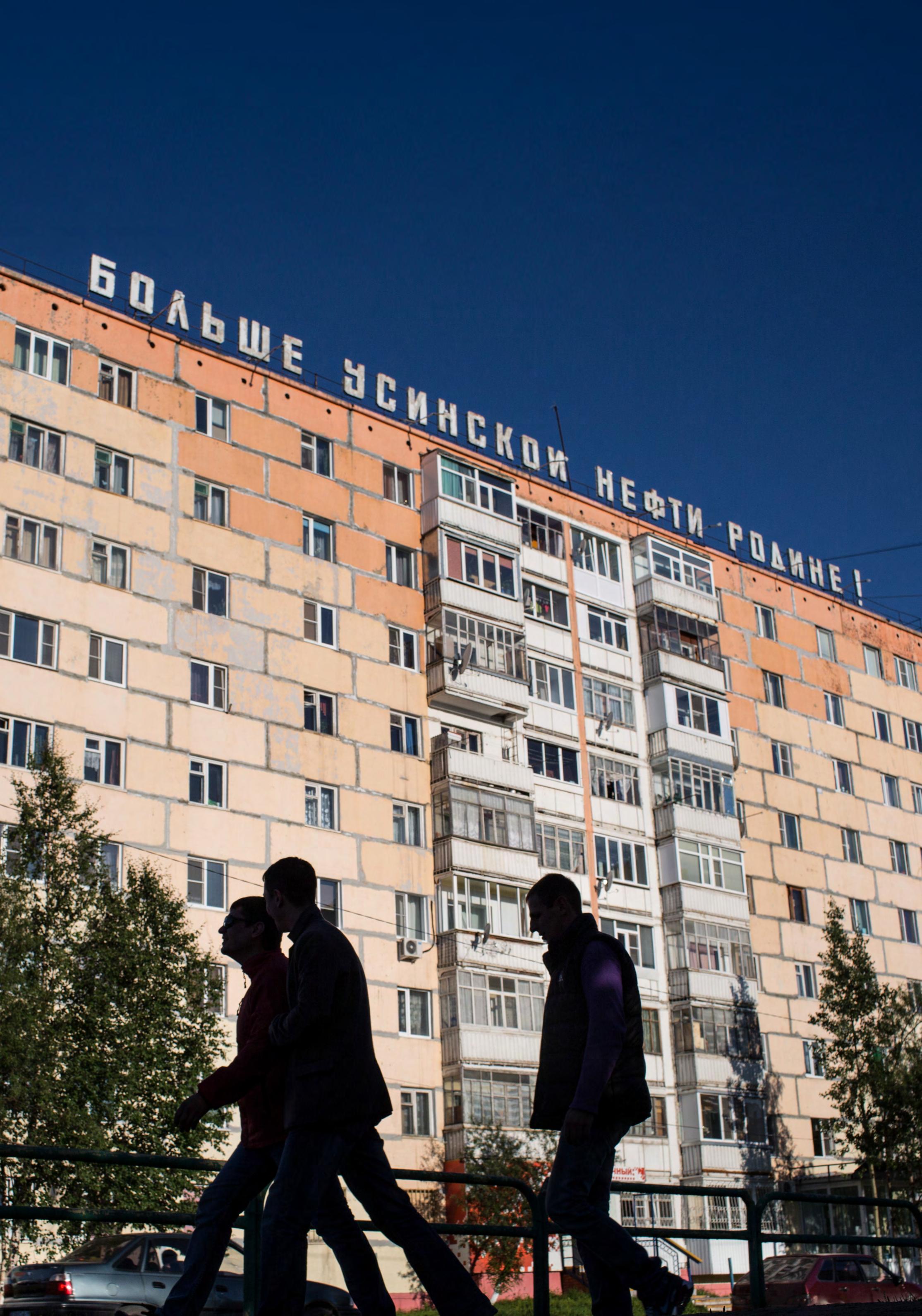
Modern Russia’s politico-economic model is a system based on extractivism, authoritarianism and war, in which all the interconnected elements reinforce one another.
Natural resources are exploited intensively , but the proceeds from their use and sale are distributed unfairly: rather than being invested in social development and improving the population’s quality of life, these funds go primarily to enriching the elite, financing the military-industrial complex and maintaining the repressive apparatus.
War serves as a tool for concentrating power, a justification for repressive legislation and a pretext for the violent suppression of civil society.
Authoritarianism, in turn, supports the extractivist model, protecting the interests of elites, whose wealth and power depends on the exploitation of natural resources. Public participation in decision-making is limited, hindering necessary structural reforms. Issues of environmental and social justice are systematically excluded from state policy priorities.
This troika forms a vicious cycle of degradation: it destroys institutions, undermines legal and environmental norms, depletes nature, deprives people of the means to defend their interests and makes a transition to just, sustainable and peaceful development impossible. As a result, the victims of the system are both people, particularly the most vulnerable, and the environment upon which their safety and wellbeing depends.
The model constructed by the Putin regime threatens not only the future of Russia itself, but also global stability – the Kremlin wages war and stokes other military conflicts, destroys global institutions, accelerates the climate crisis and contributes to the loss of biodiversity.
Extractivism, authoritarianism, war – the Russian troika of the Putin era:
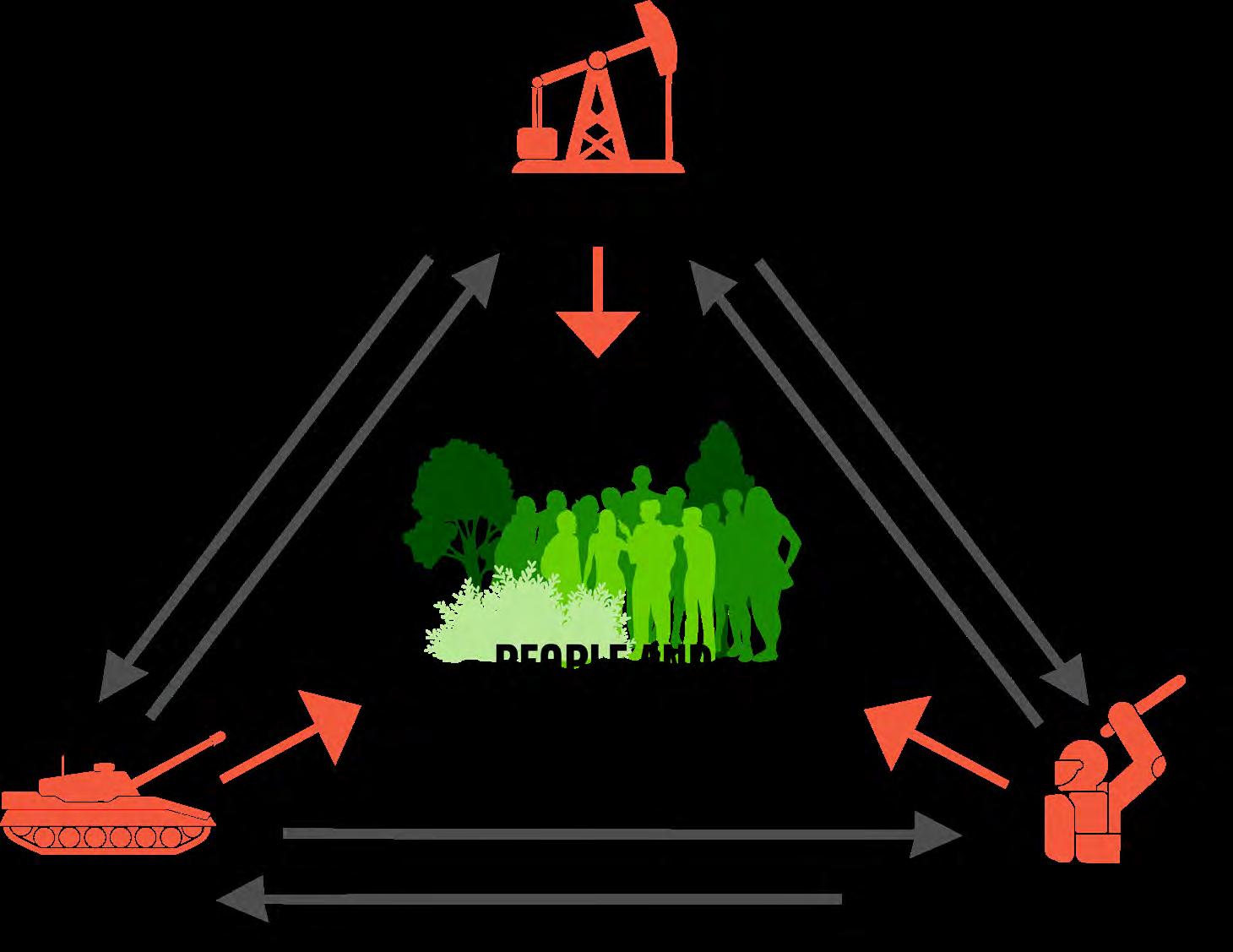
Black arrows indicate support, red indicate impact
Fuels military expansion; encourages foreign resource seizure
Deepens resource dependency; hinders diversification
Сonsolidates elite power; drives social inequality
Undermines independent environmental oversight; ignores environmental injustice
Justifies repression; restricts civil liberties
Reorganises society and economy around conflict; suppresses voices for peace
Russia plays a key role in ensuring global environmental sustainability –both in stabilising the climate and in preserving biodiversity.
Russia’s natural areas – from Arctic seas to Siberian forests, wetlands and tundra –regulate national and global climate, store vast amounts of carbon, and preserve one of the world’s largest pristine ecosystems and arrays of biodiversity.
At the same time, Russia is among the largest emitters of greenhouse gases and remains a leading exporter of fossil fuels. Its environmental and climate policy is therefore of critical importance for attaining global goals for climate mitigation, preserving biological diversity and sustaining the resilience of natural systems.
Without Russia’s participation, meaningful progress toward solving global environmental problems, and the climate and biodiversity crises, will be impossible.
See sections 3. Climate Crisis and 4. Biodiversity Crisis for more detail
The environmental situation in Russia continues to deteriorate.
Against the backdrop of the climate crisis, intensified economic exploitation and weakening environmental policy, Russia’s natural systems are under increasing stress, and their resilience is declining.
Forest fires consume increasing amounts of territory while becoming more intense due to a changing climate, cuts in funding for forest protections and degraded forestry practices. Logging increasingly occurs in intact forests, particularly in Siberia and the Russian Far East, where changing export patterns are intensifying pressure on forest ecosystems.
Due to rising temperatures, permafrost is degrading in the Arctic regions. This leads to risks of man-made accidents and methane emissions, further intensifying the greenhouse effect. The exploitation of the northern regions for the extraction and transport of resources poses additional threats to fragile Arctic ecosystems.
Biodiversity continues to decline. Populations of rare and endangered species are shrinking, and the ecosystem balance and resilience are being undermined. The construction of transport infrastructure and tourist, industrial and military facilities contributes to the destruction and fragmentation of valuable natural areas. These include the Western Caucasus, Central SikhoteAlin and Volcanoes of Kamchatka World Heritage Sites, and the Sochi, Tunkinsky, Curonian Spit, Ladoga Skerries, Samarskaya Luka and other national parks.
In place of a comprehensive approach to environmental preservation, the state implements disparate measures which do not address the root causes of biodiversity loss. The system of protected areas is losing its strategic coherence. In many highly valuable natural areas, protection regimes are being weakened, borders revised and economic activity allowed to the detriment of environmental objectives.
Together, these processes create a trend toward decreasing environmental sustainability and the country’s natural resilience and capacity. Without a reassessment of conservation policy priorities and a restoration of environmental protection mechanisms, this could have negative long-term consequences for natural systems and human quality of life alike.
See sections 3. Climate Crisis and 4. Biodiversity Crisis for more detail
The so-called ‘sovereignisation’ 1 of the Russian Arctic, initiated by authorities in recent years, aims to turn the region into a source of natural resources and a staging area for intensive militarisation.
The Arctic is increasingly rarely perceived as a unique area for international cooperation, including mitigating the consequences of the climate crisis. This trend was further intensified by Russia’s full-scale invasion of Ukraine. International mechanisms for Arctic collaboration were paralysed: Russia found itself isolated from the work of the Arctic Council and other organisations working toward the region’s sustainable development.
Arctic ecosystems are particularly vulnerable to climate change and industrial interference, with warming occurring three to four times faster than the global average. This accelerates permafrost melting, damages the landscape and leads to methane emissions, further intensifying the greenhouse effect. The Arctic plays a key role in supporting global climate stability, and the loss of the region’s natural regulators may have irreversible consequences far beyond its borders.
The rupture of scientific connections, the end of cross-border monitoring and growing authoritarian control lead to losses in environmental knowledge while increasing the risk of man-made and natural disasters. Despite the climate crisis and accelerated ecosystem degradation, authorities continue to expand industrial and military infrastructure, disregarding both environmental consequences and the rights of Indigenous Peoples.
Key industrial projects include the Prirazlomnoye offshore oil field in the Pechora Sea, the Arctic LNG-2 liquified natural gas
1 Resource sovereignty is a propagandistic political concept used by the Russian authorities, which implies full state control over the extraction and distribution of natural resources, priority for profiting from their use over international obligations, and the preservation of a resource-oriented economic model as the basis for national independence.
project on the Gyda Peninsula, the Vostok oil production and transportation project on the Taymyr Peninsula, and the planned increase in cargo traffic on the Northern Sea Route. The growth of military infrastructure has meant that by 2024, the region hosted at least 31 active military facilities, several of which were involved in strikes on Ukraine.
Rather than pursuing models of international cooperation and joint governance, aimed at preserving the Arctic’s unique nature with the participation of Indigenous Peoples, the authorities are turning the region into an arena for geopolitical confrontation and economic expansion. This undermines environmental sustainability in the Russian Arctic, deepens the climate crisis and increases tensions through the entire Arctic region.
See sections 5. The Arctic and 6. Russia’s Influence on Global Environmental Policy and Security for more detail
Risks of environmental and man-made disasters in Russia are increasing. A host of factors influence these risks: the climate crisis, infrastructure deterioration, corruption and the weakening of environmental protection institutions.
The likelihood of human-made accidents related to deteriorating energy, transport and industrial infrastructure is increasing –particularly in the context of pressure from sanctions and the rapid redistribution of resources in favour of the military-industrial complex. One such example is the oil spill following the sinking of two tankers in the Black Sea in December 2024.
The frequency and scale of extreme weather events and climate-related natural disasters – heat waves, drought, floods, hurricanes and wildfires – are also increasing.
The state’s institutional capacity to manage risks associated with extreme weather events and human-made disasters has weakened. The national climate adaptation system has been effectively shut down and responsibility has shifted to regional governments that have neither the sufficient authority nor the resources to manage it. The professional independent environmental organisations that had the expertise and ability to analyse and prevent environmental threats have been forced to close or been driven out of the country. The situation is aggravated by the destruction of expert and supervisory mechanisms, and limited access to reliable information, while authorities ignore scientific forecasts. Under the influence of the oil and gas lobby, and a media loyal to Russian authorities, denial of the very existence of the climate crisis is actively spreading throughout society, which reduces social support for adaptation measures.
See sections 1. Socioeconomic Context and 3. Climate Crisis for more detail
For many years, the Russian economic and political system has remained focused on the extraction and export of natural resources, while issues of environmental sustainability and nature protection have taken a back seat.
Despite attempts in the 1990s to institutionally strengthen the environmental protection sphere and expand public participation, the following decades saw a steady trend towards weakening environmental legislation, reduced authority for the relevant agencies, and the exclusion of independent expertise from decision-making processes. At the same time, opportunities for citizens and NGOs to participate in the formation of environmental policy and influence decisionmaking regarding the state of the environment also gradually narrowed.
The rise of authoritarianism has produced a situation in which environmental policy is subordinated to elite interests – their enrichment through natural resource extraction and their expanding control over society. The full-scale invasion of Ukraine, weakening international connections, and the drastic redistribution of resources to the army and military-industrial complex have significantly accelerated these processes, increasing the economy’s dependence on the extraction and export of natural resources.
The state and affiliated big business increasingly view nature exclusively as a source of raw materials – both for the pursuit of current political and military objectives, and for the personal profit of the regime’s beneficiaries – while issues of environmental preservation are left off the agenda. This exacerbates the environmental crisis within the country, increases its vulnerability to climaterelated risks, and weakens Russia’s contribution to achieving global biodiversity and climate targets.
See sections 1. Socioeconomic Context and 2. Environmental Policy and Governance for more detail
For decades, Russia’s resource-oriented economy has enjoyed the support of foreign governments and transnational corporations interested in stable supplies of oil, gas, coal, metals and other raw materials.
Even after the war in Georgia in 2008 and the annexation of Crimea in 2014 – in the context of growing militarism and increased repression against civil society – European, Asian and American partners continued to sign strategic contracts, invest in Russian raw materials companies and ensure the influx of foreign currency into the Russian state budget. These financial flows contributed to the development of an extractivist economic model and played a key role in strengthening authoritarian institutions and building up military infrastructure.
The full-scale invasion of Ukraine and resulting sanctions have reduced the volume of external support, but have not resulted in a radical reduction. Many states – including EU countries, China, India and Türkiye – continue to buy Russian energy resources. A significant portion of oil and gas exports, including those using the Russian shadow fleet, circumvent sanctions. As before, Rosatom supplies nuclear fuel and builds nuclear power plants abroad, remaining unsanctioned while facing essentially no significant opposition.
This situation allows the Russian regime to maintain stability based on extractivism, continue the war and repression, and to exacerbate the environmental, humanitarian and social consequences both within the country and abroad.
See sections 6. Russia’s Influence on Global Environmental Policy and Security and 9. An Alternative Path towards a Sustainable Future? Entry Points for Overcoming ResourceExtractivism in Russia for more detail
Environmental policy in Russia is experiencing a deep institutional crisis, which has become systemic and deliberate.
In recent years, the authorities have consistently weakened environmental regulatory norms, cancelling obligations to assess environmental impacts, destroying the state environmental expertise system, and relaxing restrictions on the use of protected areas, deforestation and industrial pollution.
The Ministry of Natural Resources – the main federal agency formally responsible for environmental protection – has de facto lost its environmental protection functions, turning into a structure that serves the interests of the extractive and other industrial sectors.
Government-organised NGOs (GONGOs) use the environmental agenda to legitimise the regime and justify its policies. The authorities use environmental issues as a propaganda instrument, for example during mass tree planting events in occupied Ukrainian territories or Putin’s performative participation in measures to preserve endangered animal species.
The largest extractive and industrial corporations – Gazprom, Rosneft, Norilsk Nickel and Rosatom –are, along with the state, becoming the main donors to environmental projects in Russia. Amid the destruction of the independent environmental sector, genuine environmental action is increasingly replaced by imitation designed to serve the interests of the biggest polluters.
The dismantling of Russia’s state and civilsociety environmental institutions and their transformation into instruments serving the interests of the political and business elite makes it impossible to implement genuine environmental protection objectives and increase the negative consequences of the extractivist and militarised development model.
See sections 2. Environmental Policy and Governance and 8. The environmental movement for more detail
In Russia, access to environmental information is declining, which undermines opportunities for independent expertise, public oversight and the development of climate adaptation measures.
Data on emissions, wildfires and air and water pollution are increasingly underreported or completely removed from public access. The agencies responsible for environmental monitoring – including Roshydromet, the Ministry of Natural Resources and regional administrations – operate under administrative pressure that forces them to downplay the scale of problems and restrict public access to information.
After 2022, the level of secrecy around information increased significantly. Independent researchers and civic activists, who try to make up for deficiencies in data, increasingly face persecution, administrative pressure and bans on their activities.
The Russian system for greenhouse gas emissions accounting is characterised by low reliability and flawed methodology: the introduction of “sovereign account methods” allows for the underreporting of the country’s true climate footprint. Significant sources of emissions, including methane from melting permafrost and carbon from wildfires, are not reflected in official statistics, which distort the real volume of emissions and undermine trust in national reporting.
This approach to environmental information seriously complicates timely responses to climate and environmental threats, hinders international cooperation and creates conditions for the further deterioration of the environmental situation.
See sections 2. Environmental Policy and Governance and 3. Climate crisis for more detail
Russia’s foreign environmental and climate policy increasingly aims at undermining universal norms and sustainable development institutions.
Under the slogans ‘sovereignty’, ‘an alternative path’ and ‘fair distribution of responsibilities’, Russia’s representatives prevent the adoption of binding decisions in key international processes – from climate talks to agreements regulating toxic emissions, the handling of hazardous waste and reducing plastic pollution. Rather than tightening international standards, Russia insists that obligations be voluntary, formally referring to particular national characteristics, but in fact protecting the interests of extractive and industrial corporations.
Although Russia remains a party to many international agreements, it increasingly works to weaken them – opposing increased control, selectively fulfilling its commitments and using ‘resource sovereignty’ rhetoric to shirk responsibility for implementing sustainable development goals. Russia’s behaviour, which also includes undermining international institutions, norms and measures to combat the climate crisis, environmental pollution and biodiversity loss while promoting extractivist interests, reduces capacity for collective action and makes the country a destabilising player in the global environmental protection system.
Russian authorities also apply a similar approach to Global South countries, promoting the export of hydrocarbons, nuclear energy and mineral resources under the guise of a ‘green transition’ and expanding Russia’s strategic influence across Central Africa, South and South-East Asia, and other regions.
See section 6. Russia’s Influence on Global Environmental Policy and Security for a more detail
Indigenous Peoples living in Russia’s resource-rich regions – the Arctic, Siberia and the Russian Far East – suffer disproportionately from the devastating consequences of extractivism, militarism and repression.
Indigenous lands are increasingly used for resource extraction and the deployment of infrastructure and military facilities –often without consent and in violation of international standards.
Simultaneously, these territories’ environmental and legal protections are being weakened, traditional forms of land use are eroded and sacred natural sites face destruction.
Since 2022, discrimination has increased: members of Indigenous nations are called up to serve in the war in Ukraine at disproportionately higher rates than the national average; they face displacement from their lands, suppression of their cultural identities and restrictions on access to information. Such a policy reflects features of internal neocolonialism, with the natural riches of the periphery exploited in the interests of the central elites and disregarding the rights, aspirations and sustainable future of local communities.
Recognising the systemic inequality, as well as the environmental and social injustice, that Russia’s Indigenous Peoples face is a necessary step toward the formation of a new, more inclusive model of development, based on respect for human rights and environmental protection.
See section 5. The Arctic for a more detail
Widespread repression of civil society in Russia has significantly weakened the environmental movement.
Attempts at independent environmental oversight or criticism of state policy are met with harsh resistance from the authorities and carry serious risks. In the three years following the start of the full-scale invasion of Ukraine, there have been recorded cases of pressure against 553 environmental activists and organisations, including attacks and criminal prosecutions.
The largest independent environmental organisations, WWF and Greenpeace, were declared ‘undesirable’, entailing a de facto ban on any activity in the country, under threat of incarceration. Dozens of nationwide and regional organisations have been labeled ‘foreign agents’ and forced to cease their operations.
This has seriously reduced society’s ability to defend its rights, including the right to a healthy environment. Space for public discussions, research and independent environmental monitoring has narrowed significantly.
Authorities consistently root out any form of public participation that could influence decisionmaking and support only controlled and risk-free formats that do not address the systemic causes of environmental and social problems. This destroys mechanisms of public control, reduces the country’s expert potential and deprives the environmental sector of long-term development perspectives. At the same time, authorities and affiliated businesses strive to control environmental activity, replacing independent initiatives with projects they oversee.
Repressions force many activists and groups to abandon political demands. Doing so helps them protect local environmental and social initiatives, but at the same time limits possibilities for systemic change.
Environmental injustice in Russia increasingly intersects with other forms of oppression –ethnic, political and territorial – which increases protest potential and provokes a harsh response from authorities.
See section 8. The Environmental Movement for a more detail
Despite repression, censorship and the destruction of environmental institutions, environmental issues remain one of the few topics that arouse sustained public interest.
Surveys and local initiatives show that environmental concerns remain important for millions of Russians, especially in the context of threats to health, water and air pollution, and deforestation.
The environmental agenda remains one of the few bridges between personal and social experience, enabling people to express solidarity, resist injustice and articulate a desire for change, even in the face of political pressure.
At the same time, the population exhibits a high degree of climate scepticism, and the climate crisis has been largely absent from public discourse in recent years.
See sections 7. Public Opinion and 8. The Environmental Movement for more detail
The environmental movement in Russia has a strong capacity for adaptation and retains public trust.
Local protest and environmental protection initiatives are increasingly a part of broader civic activism that goes beyond the environmental agenda.
In the context of increasing pressure from authorities and growing environmental injustice, activists are increasingly turning to informal and decentralised forms of organisation, relying on digital tools, horizontal connections and an intersectional approach.
Interaction between the environmental community within the country and NGOs and experts located abroad creates the potential to preserve independent information and analysis, coordinate efforts and offer mutual support. In these conditions, the
environmental movement could become a foothold for the restoration of civic agency, the formation of new coalitions and the development of alternatives to the extractivist, militarised and repressive trajectories currently pursued by the country’s administration.
See section 8. The Environmental Movement for a more detail
Russia’s experience should serve as a stark and unequivocal warning to all countries that rely on the extraction of natural resources, authoritarian rule and militarisation – and to those countries that finance such regimes and trade with them, paying no regard to the consequences.
The model in which natural resources are used to enrich the elite, maintain power and wage wars of aggression leads to deep domestic crisis, the degradation of nature and state and social institutions, and a loss of international legitimacy.
The situation in Russia is a graphic demonstration of how the mutual reinforcement of extractivism, repression and foreign aggression undermines environmental, social and political sustainability. Such a system limits possibilities for adaptation to climate change, destroys biodiversity, deepens social and environmental injustice, and erodes mechanisms for public participation. Its consequences go far beyond Russia’s national borders, heightening global risks, weakening international institutions and undermining our collective future.
Despite a destructive political and economic model, Russia has unique potential for sustainable development.
Vast territories, natural riches and the availability of renewable energy resources make Russia one of the most favourable countries in the world for sustainable development.
Despite the extensive damage already inflicted on its ecosystems, Russia’s nature remains of high value, both for the development of the country itself, and for maintaining global sustainability. Russia’s forests, tundra and wetlands remain key carbon sinks, sources of fresh water and habitat for many species. Maintaining their resilience alongside effective management of natural resources and environmental protection will not only ensure food, energy and environmental security for Russia, it will also contribute to climate stability and the preservation of biodiversity on a global scale.
The diversity of natural zones and the scale of Russian territory allow for the construction of a development model that ensures people have sufficient access to energy, food, clean water, and a favorable environment without destroying nature. This requires a rejection of the extractivist, export-oriented logic of development, pursuing demilitarisation and ensuring a just distribution of wealth.
Russia also has massive and essentially untapped potential for alternative energy generation – above all, for solar and wind power. Estimates suggest that the country is able to fully supply itself through sustainable, renewable sources, though their share in Russia’s electricity production is currently less than 1% – several times lower than in Europe, the US, India and China. The development of sustainable energy not only reduces the consequences of the climate crisis, it will also promote regional development and decrease social inequality, which is upheld by a resource-oriented economic model.
Despite institutional losses, Russia’s scientific and technological potential remains significant. If it had support and guaranteed freedom of research, scientific activity could be reoriented from the military sphere to the development of green technologies, environmental monitoring, sustainable urban planning and agriculture. Public sensitivity to environmental issues and the rise of the environmental movement in the 1990s and 2000s show that demand exists in Russian society for a transition to a sustainable development model. People are willing to invest time and energy into transformations leading to a green economy. Even in conditions of pressure and censorship, the environmental agenda generates interest, trust and a willingness to act – especially at local level.
Russia’s natural resources are enormous. But in order for them to serve the wellbeing of people and the world, a fundamental transformation of the country’s development model is necessary. This includes an end to aggression against Ukraine and other countries, a rejection of neocolonialism, promoting international environmental and humanitarian cooperation, dismantling authoritarianism, the restoration of civil society, and a transition away from extractivism and toward sustainable development.
[1.1] Bloomberg. 2024. Russia keeps the money rolling in for Putin’s war in Ukraine. https://bloomberg. com/news/articles/2024-09-23/russia-budget-plans-show-no-let-up-in-putin-s-war-on-ukraine
[1.2] Statista. Russia: Unemployment rate from November 2020 to November 2024. https://statista. com/statistics/277043/monthly-unemployment-rate-in-russia/
[1.3] Ministry of Finance of the Russian Federation. 2021. Presentation of the Federal Budget for 2022–2024. https://minfin.gov.ru/common/upload/library/2021/12/main/Prezentatsiya_FB_22-24.pdf
[1.4] Ministry of Finance of the Russian Federation. 2022. Budget for Citizens 2023–2025. https:// minfin.gov.ru/common/upload/library/2023/02/main/BDG.pdf
[1.5] Ministry of Finance of the Russian Federation. 2023. Budget for Citizens 2024–2026. https:// minfin.gov.ru/common/upload/library/2023/10/main/0749_Budget_2024-2026_corr.pdf
[1.6] Ministry of Finance of the Russian Federation. 2024. Budget for Citizens 2025–2027. https:// minfin.gov.ru/common/upload/library/2024/11/main/0759_Budget_2025-2027.pdf
[1.7] Vedomosti. 2023. Clean Air federal project cut by nearly half. https://vedomosti.ru/society/ articles/2023/10/12/1000151-finansirovanie-federalnogo-proekta-chistii-vozduh-sokratili
[1.8] The Moscow Times. 2023. Russia to Slash Funding for Air Quality, Environment Projects in 2024 Budget. https://themoscowtimes.com/2023/10/20/russia-to-slash-funding-for-air-qualityenvironment-projects-in-2024-budget-a82826
[1.9] Bank of Russia. 2024. Monetary Aggregate Assessment. https://cbr.ru/statistics/macro_itm/ dkfs/sr_ma_estim/
[1.10] Center for Strategic Studies. 2022. Picture of Foreign Businesses. https://csr.ru/ru/research/ kartina-inostrannogo-biznesa-uyti-nelzya-ostatsya/
[1.11] European External Action Service. 2024. EU Sanctions. https://eeas.europa.eu/eeas/ european-union-sanctions_en
[1.12] Bank of Russia. 2025. The Bank of Russia keeps the key rate at 21.00% p.a. https://cbr.ru/ eng/press/keypr/
[1.13] AK&M Information Agency. 2025. M&A Market Results with Russian Assets for 2024. https://akm.ru/ eng/news/ak-amp-m-has-released-the-results-of-the-m-amp-a-market-with-russian-assets-for-2024/
[1.14] Transparency International. 2024. Corruption Perceptions Index (CPI) for 2023. https://tirussia.org/en/2024/01/30/cpi_2023/
[1.15] Transparency International. 2025. Corruption Perceptions Index (CPI) for 2024. https://tirussia.org/en/2025/02/11/corruption-perceptions-index-2024-russia-scores-22-points-its-worst-result-in-history/
[1.16] Forbes. 2023. 40% of Russian companies cut ESG spending in 2022. https://forbes.ru/ biznes/486426-40-rossijskih-kompanij-urezali-rashody-na-esg-politiku-v-2022-godu
[1.17] INCRussia. 2023. A Universal Business Language: Why companies still engage with ESG in today’s realities. https://incrussia.ru/understand/esg-v-rossii-2023/
[2.1] Arkman A. 2022. The Whole Country Is a strike zone. Environmentalist Evgeny Simonov on the consequences of the war in Ukraine for Russia’s Nature. Kedr. https://kedr.media/interview/ zona-porazheniya-vsya-strana
[2.2] Marzhanov Z. 2024. Russian Environmental Legislation. The Green Think Tank. https:// greenthinktank.life/russian-environmental-legislation
[2.3] EurAsia Daily. 2024. Arctic LNG projects allowed to operate without transparency. https:// eadaily.com/ru/news/2024/11/12/arkticheskim-proektam-spg-razreshili-stat-neprozrachnymi
[2.4] The Insider. 2024. Moscow is losing its protected parks and forests due to air defence installations. https://theins.ru/politika/259760
[2.5] Federal Law No. 268-FZ of 14.07.2022 “On Amendments to the Federal Law on Industrial and Consumer Waste and Certain Legislative Acts of the Russian Federation”. https://consultant.ru/ document/cons_doc_LAW_421836/
[2.6] Federal Law No. 343-FZ of 14.07.2022 “On Amendments to the Law of the Russian Federation on Subsoil and Certain Legislative Acts of the Russian Federation”. https://consultant.ru/ document/cons_doc_LAW_421952/30b3f8c55f65557c253227a65b908cc075ce114a/
[2.7] Kedr. 2025. “Lawlessness, Sabotage and Subversion”: Russian Parliament assesses the National Ecology Project. Six out of 10 programme areas failed. https://kedr.media/news/ bespredel-diversiya-i-sabotazh-v-gosdume-podveli-itogi-naczproekta-ekologiya/
[2.8] Parlamentskaya Gazeta. 2024. Who Failed the Federal “Volga Recovery” Project? https://pnp. ru/politics/kto-provalil-federalnyy-proekt-ozdorovlenie-volgi.html
[2.9] Kedr. 2024. “Cleaner at the intake than the outlet.” MP Criticises Baikal treatment plants that consumed over 18 billion rubles. https://kedr.media/news/na-vhode-voda-chishhe-chem-navyhode-deputat-raskritikovala-bajkalskie-ochistnye-na-kotorye-potratili-bolshe-18-mlrd-rublej/
[2.10] Parlamentskaya Gazeta. 2025. Audit Chamber deems goals of National Ecology Project unmet. https://pnp.ru/economics/v-schetnoy-palate-sochli-celi-nacionalnogo-proekta-ekologiyanedostignutymi.html
[2.11] The Emissions Database for Global Atmospheric Research (EDGAR). https://edgar.jrc. ec.europa.eu/
[2.12] Mediazona. 2023. The Ministry of Justice Declares Kedr and Groza media outlets “Foreign Agents”. https://zona.media/news/2023/11/10/inoagenty
[3.1] Russian Federation. 2021. High level segment statement COP26. https://unfccc.int/sites/ default/files/resource/RUSSIAN_FEDERATION_cop26cmp16cma3_HLS_EN.pdf
[3.2] Climate Action Tracker. 2022. Russian Federation. https://climateactiontracker.org/countries/ russian-federation/
[3.3] IPCC. 2021. Climate Change 2021: The Physical Science Basis. Contribution of Working Group I to the Sixth Assessment Report. https://ipcc.ch/report/ar6/wg1
[3.4] Roshydromet. 2020. Second Roshydromet Assessment Report on Climate Change and its Consequences in the Russian Federation.
[3.5] WMO. 2024. WMO confirms 2024 as warmest year on record. https://wmo.int/news/mediacentre/wmo-confirms-2024-warmest-year-record-about-155degc-above-pre-industrial-level
[3.6] IGCE. 2025. Temperature regime in November 2024. http://igce.ru/2025/01/13/temp_regime_ nov2024
[3.7] Roshydromet. 2022. Third Roshydromet Assessment Report on Climate Change and its Consequences in the Russian Federation.
[3.8] Revich, B.A. 2024. Climate Change Impact on Public Health in Russia: Priority Areas for Adaptation. https://doi.org/10.3103/S1068373924020018
[3.9] National Intelligence Council (U.S.). 2009. Russia: The Impact of Climate Change to 2030. https://dni.gov/files/documents/climate2030_russia.pdf
[3.10] Revich B. 2011. 2010’s Hot Summer And Mortality In Russia's Europe: Preliminary Assessment. ISEE Conference Abstracts. https://doi.org/10.1289/isee.2011.01880
[3.11] Grigorieva E., Revich B. 2021. Health Risks to the Russian Population from Temperature Extremes at the Beginning of the XXI Century. https://mdpi.com/2073-4433/12/10/1331
[3.12] Revich, B., Tokarevich, N., Parkinson, A.J. 2012. Climate change and zoonotic infections in the Russian Arctic. https://tandfonline.com/doi/full/10.3402/ijch.v71i0.18792
[3.13] Kondrashin, A.V. et al. 2022. Global Climate Change and Human Dirofilariasis in Russia. Int. J. Environ. Res. Public Health 19(5), 3096. https://doi.org/10.3390/ijerph19053096
[3.14] Novikov, Y.M., Vaulin, O.V. 2014. Expansion of Anopheles maculipennis s.s. (Diptera: Culicidae) to northeastern Europe and northwestern Asia: Causes and Consequences. Parasites Vectors 7, 389. https://doi.org/10.1186/1756-3305-7-389
[3.15] Grigorieva, E.A., Livenets, A.S. 2022. Risks to the Health of Russian Population from Floods and Droughts (2010–2020): A Scoping Review. Climate 10(3), 37. https://mdpi.com/22251154/10/3/37
[3.16] Crate, S. 2013. Climate Change and Human Mobility in Indigenous Communities of the Russian North. Witness the Arctic 17(2). https://brookings.edu/wp-content/uploads/2016/06/30climate-russia-crate-paper.pdf
[3.17] Pavlova, V.N., Karachenkova, A.A. 2020. Assessment of climate-driven changes in spring wheat yields in Russia’s agricultural zone. Fundamental and Applied Climatology, No. 4, pp. 70–91. http://downloads.igce.ru/journals/FAC/FAC_2020/FAC_2020_4/Pavlova_V_N_Karachenkova_A_A_ FAC_2020_4.pdf
[3.18] Safonov, G., Safonova, Y. 2013. Economic Analysis of the Impact of Climate Change on Agriculture in Russia. Oxfam Research Reports. https://policy-practice.oxfam.org/resources/ economic-analysis-of-the-impact-of-climate-change-on-agriculture-in-russia-295247
[3.19] Shamin, S.I., Sanina, A.T. 2018a. Main trends in the frequency of hazardous hydrometeorological events in the Russian Federation. Proceedings of the Hydrometeorological Research Center of Russia, Issue 183, pp. 42–50.
[3.20] Shamin, S.I., Sanina, A.T. 2018b. Frequency of hazardous hydrometeorological events causing damage in the regions of the Russian Federation. Proceedings of the Hydrometeorological Research Center of Russia, Issue 184, pp. 54–60.
[3.21] Goroshko, A.A. et al. 2025. Risk Modeling for the Emergence of the Primary Outbreak Area of the Siberian Moth Dendrolimus sibiricus Tschetv. in Coniferous Forests of Central Siberia. Forests 16(1), 160. https://doi.org/10.3390/f16010160
[3.22] Shvidenko, A.Z., Schepaschenko, D.G. 2013. Climate change and wildfires in Russia. Contemp. Probl. Ecol. 6, 683–692. https://link.springer.com/article/10.1134/S199542551307010X
[3.23] European Forest Institute. 2013. Russian Forests and Climate Change. https://efi.int/sites/ default/files/files/publication-bank/2020/efi_wsctu_11_2020.pdf
[3.24] EDGAR. Emissions Database for Global Atmospheric Research. https://edgar.jrc.ec.europa.eu/
[3.25] UNFCCC. 2025. 2024 Common Reporting Table – Russian Federation. https://unfccc.int/ documents/645249
[3.26] Press conference. 2024. Russian Climate Monitoring System: Results of the First Phase. https://pressria.ru/20241105/957253876.html
[3.27] IEA. 2025. Global Methane Tracker. https://iea.blob.core.windows.net/assets/2c0cf2d5-391046bc-a271-1367edfed212/GlobalMethaneTracker2025.pdf
[3.28] Halff, A., Kleinberg, R., Mitrova, T. 2023. Russia’s methane emissions and the war in Ukraine. https://energypolicy.columbia.edu/publications/russia-s-methane-emissions-and-warukraine/
[3.29] Novaya Gazeta Europe. 2023. Greenpeace: Real area of forest fires 10 times bigger than official statistics. https://novayagazeta.eu/articles/2023/05/11/greenpeace-real-area-of-forest-firesin-russia-ten-times-bigger-than-official-statistics-en-news
[3.30] EMBER. 2024. Russia Country Profile. https://ember-energy.org/countries-and-regions/russia/
[4.1] Ministry of Natural Resources and Environment of the Russian Federation. 2024. State Report on the State and Protection of the Environment of the Russian Federation in 2023.
[4.2] The Forest Code of the Russian Federation, December 4, 2006 No. 200-FZ (ed. as of December 26, 2024). https://consultant.ru/document/cons_doc_LAW_64299
[4.3] Earth Touches Everyone. 2024. The Forest Code of the Russian Federation was 90% rewritten. https://earthtouches.me/expert/2024/01/18/lesnoj-kodeks-rf-perepisali-na-90
[4.4] Marzhanov, Z. The Green Think Tank. 2024. Russian Environmental Legislation. https:// greenthinktank.life/russian-environmental-legislation
[4.5] Earth Touches Everyone. 2025. A new threat to mountain forests. https://earthtouches.me/ articles/2025/03/11/novaja-ugroza-gornym-lesam
[4.6] Interfax. 2022. The government will accelerate the use of unused agricultural lands. https:// interfax.ru/business/833761
[4.7] Greenpeace International Global Mapping Hub. 2018. Map of unused agricultural lands potentially suitable for afforestation. https://maps.greenpeace.org/maps/aal
[4.8] Decree of the Government of the Russian Federation of September 21, 2020 No. 1509 "On the specifics of use, protection, and reforestation of forests located on agricultural lands". https:// fsvps.gov.ru/files/postanovlenie-pravitelstva-rossij-26
[4.9] Decree of the Government of the Russian Federation of June 8, 2022 No. 1043 "On amendments to the regulations on forest management on agricultural lands". https://garant.ru/ products/ipo/prime/doc/404720367
[4.10] Forestcomplex.ru. A permit that prohibits: how the issue of forestry on agricultural lands was handled in 2022. https://forestcomplex.ru/forestry/kak-reshaetsya-vopros-s-lesovodstvom-naselhozzemlyah
[4.11] Earth Touches Everyone. 2024. Climate amendments to the Forest Code introduced. https:// earthtouches.me/articles/2024/12/24/v-lesnoj-kodeks-vnesli-lesoklimaticheskie-popravki
[4.12] Earth Touches Everyone. 2024. What is happening to nature conservation in Russia? https:// earthtouches.me/articles/2024/06/05/chto-proishodit-s-ohranoj-prirody-v-rossii/
[4.13] Earth Touches Everyone. 2023. What are wild forests? https://earthtouches.me/ articles/2023/09/30/chto-takoe-dikie-lesa
[4.14] Accounts Chamber of the Russian Federation. 2024. Audit of the State Forest Inventory for 2020–2023 and part of 2024. https://ach.gov.ru/upload/iblock/0d2/ grvgmbcs5zu52wyb7zyckfht2iojauwf.pdf
[4.15] The Insider. 2023. Chopped to the ground: air defense systems replacing protected parks and forests in Moscow. https://theins.ru/politika/259760
[4.16] Smola. 2024. Fragile ground of Russian forests: how the break with Western countries has affected forest conditions. https://web.archive.org/web/20250804134034/https://smola.media/ zybkaya-pochva-russkogo-lesa/
[4.17] Earth Touches Everyone. 2024. Is forest restoration in Russia outpacing losses? https:// earthtouches.me/articles/2024/08/12/vosstanovlenie-lesov-v-rossii-prevyshaet-ih-poteri
[4.18] Earth Touches Everyone. 2023. Why “reforestation” is a serious threat to Lake Baikal. https:// earthtouches.me/expert/2023/12/08/pochemu-lesovosstanovlenie-strashnaja-ugroza-bajkalu
[4.19] Earth Touches Everyone. 2024. “Forest conservation” in reverse: how protection programs lead to timber harvesting. https://earthtouches.me/articles/2024/07/11/sohranenie-lesov-naoborot
[4.20] National Projects of Russia. 2024. Moscow concludes sixth season of the “Save the Forest” campaign. https://национальныепроекты.рф/news/v-moskve-podveli-itogi-shestogo-sezonaaktsii-sokhranim-les
[4.21] Earth Touches Everyone. 2024. Why planting trees can be dangerous for nature. https:// earthtouches.me/expert/2024/05/08/pochemu-sazhat-lesa-opasno-dlja-prirody
[4.22] President of the Russian Federation. 2021. Meeting on the development and decriminalisation of the forest sector. https://consultant.ru/law/hotdocs/64877.html
[4.23] The Global Tribune. 2023. Reduction in 2022 in all areas of the timber industry in Russia. https://globaltribune.net/reduction-in-2022-in-all-areas-of-the-timber-industry-in-russia
[4.24] Vedomosti. 2024. Russia’s lumber exports set to continue falling in 2024. https://vedomosti. ru/business/articles/2024/10/08/1067154-eksport-pilomaterialov-iz-rossii-prodolzhit-padat
[4.25] Tendata. 2024. Export of Russian Wood Products in 2023. https://tendata.com/blogs/ insight/5740.html
[4.26] RBC. 2024. Russia finds alternative buyers for timber after losing the European market. https://rbc.ru/business/02/02/2024/65b8fc719a79470f2a20dbfd
[4.27] International Consortium of Investigative Journalists. 2023. How Russia’s timber trade is sidestepping the EU’s Ukraine war sanctions. https://icij.org/investigations/deforestation-inc/howrussias-timber-trade-is-sidestepping-the-eus-ukraine-war-sanctions
[4.28] Sayari Analytics. 2024. The Shady Origins of Central Asia’s Burgeoning Timber Exports. https://sayari.com/resources/the-shady-origins-of-central-asias-burgeoning-timber-exports
[4.29] Federal Forestry Agency (FBU “Avialesookhrana”). https://aviales.ru
[4.30] Kedr. 2024. Nearly 5 million hectares of forest have burned in Russia since the beginning of the year — a three-year record. https://kedr.media/news/s-nachala-goda-v-rossii-sgorelo-pochti-5mln-ga-lesov-eto-trehletnij-maksimum
[4.31] Federal Forestry Agency (FBU “Avialesookhrana”). Summary report on wildfires (thermal anomalies) based on satellite monitoring as of December 31, 2021. https://public.aviales.ru/main_ pages/openform1.shtml?2024-12-31
[4.32] FBU “Avialesookhrana”. 2025. Preliminary forecast of fire danger in forests of the Russian Federation for May 2025. https://aviales.ru/popup.aspx?news=9270
[4.33] Meduza. 2023. “Then what is preferable — not putting out fires?” Authorities declared Greenpeace illegal, and nature may suffer the consequences. https://meduza.io/ feature/2023/05/23/a-chto-togda-zhelatelno-ne-tushit-pozhary
[4.34] Volunteer Forest Firefighters. Awareness campaign “Stop the Fire!” https://dlpinfo.org/ ekopros/ostanovi_ogon
[4.35] Earth Touches Everyone. 2025. How the dynamics of wildfires in Russia have changed. https://earthtouches.me/articles/2025/02/28/kak-izmenilas-dinamika-prirodnyh-pozharov-v-rossii
[4.36] The Insider. 2025. Let it burn: due to war expenses, Russia faces large-scale wildfires this year. https://theins.ru/obshestvo/279556
[4.37] Kedr. 2024. In the Urals, protesting Avialesookhrana workers were given canned meat instead of wages — not even animals want to eat it. https://kedr.media/news/na-uraleprotestuyushhim-sotrudnikam-avialesoohrany-vydali-tushenku-vmesto-deneg-est-ee-ne-hotyatdazhe-zhivotnye
[4.38] The Guardian. 2025. Forest fires push up greenhouse gas emissions from war in Ukraine. https://theguardian.com/world/2025/feb/24/forest-fires-push-up-greenhouse-gas-emissions-fromwar-in-ukraine
[4.39] UNESCO. World Heritage. https://unesco.org/en/world-heritage
[4.40] Convention on Biological Diversity. 2020. Aichi Biodiversity Targets. https://cbd.int/sp/targets
[4.41] Convention on Biological Diversity. Kunming–Montreal Global Biodiversity Framework 2030 targets. https://cbd.int/gbf/targets
[4.42] Draft Order of the Government of the Russian Federation "On the approval of the Strategy for the Development of the System of Specially Protected Natural Areas until 2030". https:// consultant.ru/cons/cgi/online.cgi?req=doc&base=PNPA&n=65776
[4.43] Vedomosti. 2025. The Russian Ministry of Natural Resources develops a strategy for nature reserves. https://vedomosti.ru/esg/ecology/news/2025/02/12/1091745-rossiiskim-zapovednikamrazrabotali-strategiyu
[4.44] Zimenko A.V. 2017. Nature conservation in post-Soviet Russia: factors and trends. In: In the Focus of Heritage, ed. M.E. Kuleshova. https://oopt.info/data/files/publications/Zimenko_2017.pdf
[4.45] Free Russia Foundation. 2024. Lands under protection: how to build an effective management system for protected areas. https://thinktank.4freerussia.org/ru/civil-society/zemlipod-ohranoj/
[4.46] TASS. 2022. The Ministry of Natural Resources prepares a national park project to protect the Amur tiger population. https://tass.ru/obschestvo/15348129
[4.47] Parliamentary Newspaper. 2023. Russia to establish Volcanoes of Kamchatka National Park. https://pnp.ru/politics/v-rossii-predlagayut-sozdat-nacionalnyy-park-vulkany-kamchatki.html
[4.48] Expert Council on Nature Reserves. 2024. On the need to expand Saylyugemsky National Park. https://zapovedcouncil.ru/o-neobhodimosti-prodolzheniya-raboty-po-rasshireniyu-naczparkasajlyugemskij-obratilsya-k-glave-minprirody-rossii-ekspertnyj-sovet-po-zapovednomu-delu
[4.49] Earth Touches Everyone. 2024. On restrictions regarding the development of protected areas. https://earthtouches.me/articles/2024/09/02/dom-ulica-fonar-v-nacparke
[4.50] Expert Council on Nature Reserves. 2024. On new “brilliant” initiatives of the Ministry of Natural Resources in the field of protected areas. https://zapovedcouncil.ru/o-novyh-blistatelnyhinicziativah-minprirody-rossii-na-nive-zapovednogo-dela
[4.51] Federal Law No. 124-FZ of May 1, 2022 “On Amendments to the Urban Planning Code of the Russian Federation and Certain Legislative Acts”. https://consultant.ru/document/cons_doc_ LAW_416183
[4.52] Bakuriani A. 2024. Specially Protected Natural Areas. The Green Think Tank. https:// greenthinktank.life/specially-protected-natural-areas
[4.53] Federal Law No. 77-FZ of March 18, 2023 “On Amendments to Certain Legislative Acts of the Russian Federation”. https://consultant.ru/document/cons_doc_LAW_442360
[4.54] Kommersant. 2023. Protected land is being prepared for tourism. https://kommersant.ru/ doc/5887544
[4.55] Federal Law No. 232-FZ of August 8, 2024 “On Amendments to Certain Legislative Acts of the Russian Federation and Recognition of Certain Provisions as Invalid”. https://consultant.ru/ document/cons_doc_LAW_482484/
[4.56] Earth Touches Everyone. 2025. Nature reserves and national parks may lose protection. https://earthtouches.me/articles/2025/04/17/zapovedniki-i-nacparki-mogut-poterjat-zashhitu
[4.57] Ryabtsev V.V. 2023. Pribaikalsky National Park – “the undertaker” of western Baikal's nature. Wildlife Conservation. https://biodiversity.ru/publications/odp/archive/41/n41.pdf
[4.58] Gubernatorov A.E. 2024. Samarskaya Luka – the struggle continues! Wildlife Conservation. https://biodiversity.ru/publications/odp/archive/42-43/n42-43.pdf
[4.59] Kronotsky Nature Reserve. The “Cleaning Case”. https://kronokiochistka.wildnet.ru
[4.60] Kommersant. 2024. Everything is justified in the park: the former director of Samarskaya Luka National Park found not guilty. https://kommersant.ru/doc/6663697
[4.61] Kedr. 2025. Scientific staff laid off from Lazovsky Reserve were offered janitorial jobs. https://kedr.media/news/lazovskij-zapovednik-gde-likvidirovali-nauchnyj-otdel-predlozhiluvolennym-zoologam-dolzhnosti-uborshhicz-i-slesarya
[4.62] Kedr. 2023. “The worst amendments disguised as conservation.” The Duma approves clear-cutting on Baikal shores. https://kedr.media/stories/hudshie-popravki-zamaskirovany-podprirodoohranu
[4.63] Earth Touches Everyone. 2025. Russian Academy of Sciences repeats opposition to Baikal draft law. https://earthtouches.me/articles/2025/03/04/uchjonye-ran-snova-vystupili-protivzakonoproekta-o-bajkale
[4.64] Yabloko Party. Deforestation Lobby: how MPs write forest-cutting laws around Baikal to benefit their associates. https://yabloko.ru/lp/lesopoval
[4.65] Decree of the Government of the Russian Federation No. 2066 of December 6, 2023.
[4.66] Decree of the Government of the Russian Federation No. 2067 of December 6, 2023.
[4.67] New Izvestia. 2023. Prosperity or destruction? What awaits Losiny Ostrov National Park under Moscow’s jurisdiction. https://newizv.ru/news/2023-07-27/protsvetanie-ili-unichtozheniechto-zhdet-natspark-losinyy-ostrov-pod-yurisdiktsiey-moskvy-414620
[4.68] Expert Council on Nature Reserves. 2024. Appeal to the Prosecutor General regarding the road through Losiny Ostrov National Park. https://zapovedcouncil.ru/o-nezakonnyh-dejstviyahminprirody-rossii-v-svyazi-s-planami-stroitelstva-dorogi-cherez-naczpark-losinyj-ostrovobratilsya-v-generalnuyu-prokuraturu-rf-ekspertnyj-sovet-po-zapovednomu-delu
[4.69] Earth Touches Everyone. 2023. Losiny Ostrov might be “sawed through” for a road. https:// earthtouches.me/articles/2023/12/19/losinyj-ostrov-mogut-raspilit-dorogoj/
[4.70] Faktologia.com. 2024. Authorities in Khanty-Mansi region removed protected status from Numto Park lands used by Surgutneftegaz. https://faktologia.com/hmao/vlasti-hmao-lishiliohranyaemogo-statusa-zemli-prirodnogo-parka-numto-na-kotoryh-surgutneftegaz-provodit-dobychu
[4.71] Novaya Gazeta. 2016. Gods of the swamps won’t let go: when your people and gods live on billions of tonnes of oil. https://novayagazeta.ru/articles/2016/05/27/68753-bogi-bolotnikogo-ne-otpustyat
[4.72] Kedr. 2023. Trouble on Ladoga: Ministry of Natural Resources wants to seize 3,000 hectares from Ladoga Skerries National Park. https://kedr.media/stories/neladnoe-na-ladoge
[4.73] Kedr. 2024. Conservation Fixers: how business is removing valuable nature from government protection. https://kedr.media/explain/zapovednye-reshaly/
[4.74] Kommersant. 2023. Sochi National Park slated for development. Ecologists criticise the decision. https://kommersant.ru/doc/6148674
[4.75] Bellona. 2021. Three volcanoes in Kamchatka: how officials and a billionaire plan to build a resort in a nature park. https://ru.bellona.org/2021/08/16/tri-vulkana
[4.76] Decree of the Government of Moscow No. 3160-PP of December 27, 2024. https:// consultant.ru/cons/cgi/online.cgi?req=doc&base=MLAW&n=249629
[4.77] Novaya Gazeta. 2022. Under the curse of Courchevel: a resort is being built in Zhiguli Mountains, allegedly promised by Putin in 2000. https://novayagazeta.ru/articles/2022/02/13/podstrakhom-kurshevelia
[4.78] Expert Council on Nature Reserves. 2023. Strong criticism of recreational infrastructure proposals in several protected areas. https://zapovedcouncil.ru/ekspertnyj-sovet-pozapovednomu-delu-vystupil-s-zhestkoj-kritikoj-predlozhenij-po-razvitiyu-rekreaczionnojinfrastruktury-v-ryade-zapovednikov-i-naczionalnyh-parkov/
[4.79] Kedr. 2023. “This would be a disgrace.” Who profits from the destruction of UNESCO-listed Lago-Naki plateau? https://kedr.media/research/eto-budet-pozornyj-fakt
[4.80] Expert Council on Nature Reserves. 2024. Challenges in the development and operation of internationally significant protected areas. https://zapovedcouncil.ru/problemy-razvitiya-ifunkczionirovaniya-seti-oopt-imeyushhih-mezhdunarodnoe-znachenie-obsudil-ekspertnyj-sovetpo-zapovednomu-delu
[4.81] RBC. 2025. Expert council appeals to Ministry of Natural Resources over hotel project on Curonian Spit. https://kaliningrad.rbc.ru/kaliningrad/11/03/2025/67d018fd9a7947b804190d0b
[4.82] Earth Touches Everyone. 2025. Fifth attempt: Stavropol deputies again seek to eliminate a protected area. https://earthtouches.me/articles/2025/01/30/popytka-nomer-pjat
[4.83] Russia in the IUCN Red List. 2022. Use and Conservation of Natural Resources in Russia, No. 2. https://istina.msu.ru/publications/article/488744141
[4.84] NEWSru.com. Putin credited for increase in numbers of Amur tigers and Far Eastern leopards. https://newsru.com/russia/11oct2013/leopard.html
[4.85] Amur Tiger Center. 2018. What we lose if the Amur tiger disappears. https://amur-tiger.ru/ news/chego-myi-lishimsya-esli-amurskiy-tigr-ischeznet-1251
[4.86] Programme ‘Polar Bear’. Putin’s official visit to Alexandra Land Island, Franz Josef Land. http://programmes.putin.kremlin.ru/bear/premier
[4.87] RIA Novosti. Spoon-billed sandpiper added to the list of the 100 most endangered species on Earth. https://ria.ru/20120912/748208023.html
[4.88] The Moscow Times. 2024. Is Russia running out of time to save the Caspian seal from extinction? https://themoscowtimes.com/2024/09/17/is-russia-running-out-of-time-to-save-thecaspian-seal-from-extinction-a85827
[4.89] TASS Science. 2019. Fewer dolphins, more garbage in the Black Sea. https://nauka.tass. ru/nauka/7181153
[4.90] Dolphin Rescue Center “DELFA”. 2025. Summary as of January 5 on mass dolphin deaths. https://t.me/delfacenter/245
[4.91] Kedr. 2024. Are things so good for tigers that there will be fewer of them? Zoologist on the paradoxes of the new tiger conservation strategy. https://kedr.media/stories/u-tigrov-vse-takhorosho-chto-ih-stanet-menshe
[4.92] Caucasian Knot. 2024. Environmentalists demand investigation into death of leopard ‘Terek’. https://kavkaz-uzel.eu/articles/405382
[4.93] ORCINUS — Marine Mammal and Rare Animal Channel. https://t.me/npczmm_ orcinus/3287
[4.94] Amur Tiger Center. 2023. Customs officers seize 400 kg of wildlife derivatives destined for China. https://amur-tiger.ru/news/tamojenniki-na-dalnem-vostoke-predotvratili-vyivoz-v-kitay400-kg-derivatov-osobo-tsennyih-jivotnyih-1311
[4.95] RIA Novosti. 2018. Tigers and bears slaughtered to fuel demand for traditional medicine. https://ria.ru/20181210/1547595194.html
[4.96] Kedr. 2025. “The driver should slow to 50–60 km/h.” Zoologist on how to avoid accidents with dzeren. https://kedr.media/news/mashinistu-by-sbrosit-skorost-do-50-60-km-chas-ekspertrasskazal-kak-izbegat-avarij-s-dzerenami
[4.97] Sevastopol Institute of Ecology and Evolution (IPEE RAS). Complex expedition to study causes of Black Sea dolphin deaths. https://sev-in.ru/node/742
[4.98] Gallo-Cajiao E. et al. 2023. Implications of Russia’s invasion of Ukraine for the governance of biodiversity conservation. Frontiers in Conservation Science. https://doi.org/10.3389/ fcosc.2023.989019
[4.99] Meduza. 2023. War is destroying science in Russia and even more so in Ukraine. What can be done? https://meduza.io/feature/2023/04/07/voyna-razrushaet-nauku-i-v-rossii-i-esche-kudasilnee-v-ukraine-chto-mozhno-etomu-protivopostavit
[4.100] The Moscow Times. 2024. Russian science budget to be slashed to lowest level in over 20 years. https://moscowtimes.ru/2024/07/08/pravitelstvo-reshilo-sokratit-dolyu-rashodov-na-naukudo-minimuma-bolee-chem-za-20-let-a136169
[4.101] Pashkov P. 2025. How the hunting lobby changes the law: the history of trophy hunting legalisation in Russia (2019–2025). https://pavel-pashkov.com/articles/ru/not-trophy
[4.102] Kedr. 2023. “Russia is drenched in animal blood…” Which MPs are lobbying for elite hunting and ever more brutal killings. https://kedr.media/stories/rossiya-zalita-krovyu-zhivotnyh
[4.103] RFI. 2021. Russia removes the ban on shooting Red Book species from hunting law. https://rfi.fr/ru/россия/20210805-в-россии-из-закона-об-охоте-убрали-запрет-на-отстрелкраснокнижных-животных
[4.104] Federal Law No. 455-FZ of December 22, 2020 “On Amendments to the Federal Law ‘On the Animal World’ and the Law ‘On Hunting and Preservation of Hunting Resources’”. https:// consultant.ru/document/cons_doc_LAW_371756
[4.105] Federal Law No. 305-FZ of July 14, 2022 “On Amendments to Certain Legislative Acts of the Russian Federation”. https://consultant.ru/document/cons_doc_LAW_421849
[4.106] Kedr. 2024. Ministry of Natural Resources once again seeks to allow hunting of endangered species — including to “prevent their suffering”. https://kedr.media/news/minprirodysnova-hochet-razreshit-dobychu-krasnoknizhnyh-zhivotnyh-v-tom-chisle-dlya-predotvrashheniyaih-stradanij
[4.107] Science X. 2025. Polar bears are struggling to get enough to eat as sea ice dwindles due to climate change, study finds. https://phys.org/news/2025-01-polar-struggling-sea-ice-dwindles.html
[4.108] Albouy C., Delattre V., Donati G. et al. 2020. Global vulnerability of marine mammals to global warming. Scientific Reports 10:548. https://doi.org/10.1038/s41598-019-57280-3
[4.109] Petrosyan V. et al. 2023. The TOP-100 most dangerous invasive alien species in Northern Eurasia. NeoBiota 82: 23–56. https://doi.org/10.3897/neobiota.82.96282
[4.110] IFL Mapping Team. World's Intact Forest Landscapes, 2000-2020. https://intactforests.org/ world.map.html
[4.111] Earthsight. Blood-Stained Birch: Exposing the EU Trade in Russian Conflict Ply. https:// earthsight.org.uk/blood-stained-birch
[5.1] Zamyatina N., ed. 2024. The Arctic in Numbers. Government of Murmansk Region; State Council Commission on Transport; Faculty of Urban and Regional Development, HSE. https:// minec.gov-murman.ru/activities/arktika-v-tsifrakh
[5.2] Lackenbauer P. W., Dean R. 2020. Arctic Exceptionalisms. In: Spohr K., Hamilton D. S., Moyer J. C., Hamilton D. S., eds. The Arctic and world order, 327–356. Transatlantic Leadership Network. https://transatlanticrelations.org/wp-content/uploads/2020/12/The-Arctic-and-WorldOrder-ch14.pdf
[5.3] NGO “Arctida”. 2023. Key Stakeholders in Russian Arctic Policy: Research. https://arctida.io/ ru/projects/key-stakeholders-arctic-russian-politics
[5.4] Wall C., Wegge N. 2023. The Russian Arctic Threat: Consequences of the Ukraine War. Center for Strategic and International Studies. https://csis.org/analysis/russian-arctic-threatconsequences-ukraine-war
[5.5] Boulègue M. 2024. Russia's Arctic military posture in the context of the war against Ukraine. The Arctic Institute. https://thearcticinstitute.org/russias-arctic-military-posture-context-waragainst-ukraine/
[5.6] Regehr E., Gallagher K. 2024. Military footprints in the Arctic. The Simons Foundation Canada. https://thesimonsfoundation.ca/highlights/military-footprints-arctic
[5.7] Staalesen A. 2025. Russian Defense Ministry confirms drone attack on Murmansk. The Barents Observer. https://ru.thebarentsobserver.com/minoborony-podtverzdaet-ataku-drona-namurmansk/423869
[5.8] Bellona Environmental Transparency Center. 2023. Nuclear legacy of the Arctic: Hard to clean up without international help. https://ru.bellona.org/2023/12/04/yadernoe-nasledie-arktiki/
[5.9] XIII International Forum “The Arctic: Present and Future”. 2023. The Arctic Is a resource treasury and a guarantee of Russia’s economic sovereignty, but the macroregion needs skilled workforce. https://forumarctic.com/conf2018/news/novosti-konferencii/Arktika_eto_kladovaya_ resursov_i_zalog_ekonomicheskogo_suvereniteta_Rossii_no_makroregionu_nuzhny_ka/
[5.10] Kedr. 2025. Damage to Indigenous Peoples in Yakutia from industry estimated at 1.5 billion rubles. https://kedr.media/news/v-1-5-mlrd-rublej-oczenivaetsya-ushherb-korennymmalochislennym-narodam-severa-v-yakutii-so-storony-promyshlennikov/
[5.11] Center for Climate Policy and Economics in Russia, Institute of Economic Forecasting, RAS. 2024. Economic Effects of Climate Change in Russia. https://ecfor.ru/wp-content/ uploads/2024/09/ekonomicheskie-effekty-klimaticheskih-izmenenij-v-rossii.pdf
[5.12] Farkhatdinov N., Pylaeva L., Martynova A., Alebardi F. V. 2025. After February 24: How has the Russian Arctic changed over the last three years? https://arctida.io/en/research/after-february24-how-has-the-russian-arctic-changed-over-the-last-three-years
[5.13] Vergine, S. 2024. How Italian companies circumvent sanctions against Russian gas. https:// editorialedomani.it/politica/mondo/emirati-cina-turchia-nomi-intermediari-usati-per-aggiraresanzioni-contro-gas-russia-upogzijn
[5.14] Mahmoud M. R., Roushdi M., Aboelkhear M. 2024. Potential benefits of climate change on navigation in the Northern Sea Route by 2050. Scientific Reports, 2771. https://doi.org/10.1038/ s41598-024-53308-5
[5.15] Rantanen M. et al. 2022. The Arctic has warmed nearly four times faster than the globe since 1979. Communications Earth & Environment, 168. https://doi.org/10.1038/s43247-022-00498-3
[5.16] Russian Federal Service for Hydrometeorology and Environmental Monitoring (ROSHYDROMET). 2021. Climate features in the Russian Federation in 2020. https://meteorf.gov. ru/upload/pdf_download/doklad_klimat2020.pdf
[5.17] Copernicus Atmosphere Monitoring Service. 2024. High Carbon Emissions From Wildfires in the Russian Arctic. https://atmosphere.copernicus.eu/high-carbon-emissions-wildfires-russian-arctic
[5.18] Russian Federal Service for Hydrometeorology and Environmental Monitoring (ROSHYDROMET). 2025. Climate Features in the Russian Federation in 2024. http://downloads. igce.ru/reports/Doklad_o_klimate_RF_2024_with_cover.pdf
[5.19] RIA Novosti. 2024. Ministry for the development of the Russian Far East urges creation of permafrost law. https://ria.ru/20240410/merzlota-1939037163.html
[5.20] López-Blanco E. et al. 2024. Towards an increasingly biased view on Arctic change. Nature Climate Change, 14, 152–155. https://doi.org/10.1038/s41558-023-01903-1
[5.21] Rakhimova N., ed. 2023. The Invasion of Ukraine: Implications for the SDGs in Russia. Civil Society Review. CSDR.
[5.22] Rakhimova N., ed. 2024. No SDG Achievement without Civil Society: Russia's Experience. CSDR. https://kurs2030.ru/report2024
[5.23] Anti-Discrimination Centre Memorial Brussels and International Committee of Indigenous Peoples of Russia. 2024. Repressions Against Independent Defenders of the Rights of Indigenous Peoples. https://icipr.international/archives/1151
[5.24] Anti-Discrimination Centre Memorial Brussels and International Committee of Indigenous Peoples of Russia. 2025. Identification, Documentation, Demarcation, Registration, and Titling of Indigenous Peoples’ Lands: Practices and Lessons Learned. https://icipr.international/ archives/1179
[5.25] Anti-Discrimination Centre Memorial Brussels and International Committee of Indigenous Peoples of Russia. 2025. Recognition of Indigenous Peoples. https://icipr.international/ archives/1174
[5.26] Ivanova M. 2023. A man From Buryatia has about 75 times higher risk of dying in war than a Muscovite: Sociologists study ethnic inequality in the Russian army. People of Baikal. https:// baikal-journal.ru/2023/06/20/u-muzhchiny-iz-buryatii-veroyatnost-umeret-na-vojne-primerno-v75-raz-vyshe-chem-u-moskvicha/
[5.27] Indigenous Russia. 2022. Representatives of Indigenous Peoples of Russia killed or missing in the war with Ukraine (List). https://indigenous-russia.com/archives/29542
[5.28] Idel.Realii. 2024. Two years of mobilisation: Bashkortostan and Tatarstan have the highest recorded losses in Russia. https://idelreal.org/a/mobilizatsii-2-goda-samye-vysokie-poteri-v-rossiiv-bashkortostane-i-tatarstane/33137737.html
[5.29] Sever.Realii. 2023. “Only about 1,500 of us left in Russia.” The Indigenous Saami People and the war. https://severreal.org/a/narod-zapugan-podavlen-chto-zhdet-saamov-iz-za-voyny/32606238.html
[5.30] Vyushkova M., Sherkhonov E. 2023. Russia’s ethnic minority casualties of the 2022 invasion of Ukraine. Inner Asia, 25(1), 126–136. https://brill.com/view/journals/inas/25/1/article-p126_11.xml
[5.31] Bessudnov A. 2023. Ethnic and regional inequalities in Russian military fatalities in Ukraine: Preliminary Findings From Crowdsourced Data. Demographic Research, 48, 883–898. https://demographic-research.org/articles/volume/48/31/
[5.32] Коmi pošta. 2023. What is the average profile of a resident of Komi killed in the war? https://t.me/komi_post/243
[5.33] Indigenous Russia. 2022. “We Beg for Mercy”: Indigenous Peoples of Khabarovsk Krai ask to cancel mobilisation. https://indigenous-russia.com/archives/25241
[5.34] Indigenous Russia. 2024. Maria Vyushkova. Disproportionate mobilisation of Indigenous Peoples in Khabarovsk Krai in raw figures. https://indigenous-russia.com/archives/38996
[5.35] Non-Moscow Says. 2025. In the village of Elabuga, Khabarovsk Krai, one man from every third family was sent to war. https://nemoskva.net/2025/01/30/pasport-semi-mobilizovannogosozdali-v-sele-habarovskogo-kraya-za-13-mln/
[5.36] NGO “Arctida”. 2025. How isolation and sovereignisation affect the Russian Arctic: From sustainable development to a high-risk territory. https://arctida.io/ru/projects/Sustainability-ofRussian-Arctic
[5.37] Mediazona. 2025. How many Russian soldiers died in the war with Ukraine. https://en.zona. media/article/2025/03/28/casualties_eng-trl
[5.38] Basygysov R. 2024. People or Gold? Sakha Parliament. https://sakhaparliament.ru/politika/ v-il-tumene/22222-lyudi-ili-zoloto
[5.39] Shadrin V. 2023. Vyacheslav Shadrin: The Tokkinskoye mine project by Nordgold Management must be rejected for ignoring the interests of the Tyans. https://sakhaday.ru/ news/vyacheslav-shadrin-nado-otklonit-proekt-gok-tokkinskoe-ot-nordgold-menedzhment-zaignorirovanie-interesov-tyancev
[5.40] MK-Yakutia. 2022. Reindeer herders of Iengra establish relations with subsoil users. https://yakutia.mk.ru/social/2022/02/08/olenevody-iengry-nalazhivayut-otnosheniya-snedropolzovatelyami.html
[5.41] Troyanova A. 2024. On the Black shores. Kedr. https://kedr.media/stories/na-chernyhberegah/
[5.42] Bolshakova K. 2024. How climate change is leading to a language shift in the Russian Arctic. Cultural Survival, 48(4). https://culturalsurvival.org/publications/cultural-survival-quarterly/howclimate-change-leading-language-shift-russian-arctic
[5.43] Jåma M. K. 2024. Climate change is affecting our knowledge and herding practices. Cultural Survival, 48(4). https://culturalsurvival.org/publications/cultural-survival-quarterly/climatechange-affecting-our-knowledge-and-herding
[5.44] Ivanova M. 2025. When the ice melts, so does life: How the climate crisis affects Indigenous Peoples of the Arctic. NGO “Arctida”. https://arctida.io/ru/projects/climate-crisis-and-indigenous-peoples
[5.45] Idel.Realii. 2024. Representatives of Indigenous Peoples of Russia appeal to the UN over inclusion of 55 organisations in “anti-Russian separatist movement”. https://idelreal.org/a/ predstaviteli-korennyh-narodov-rossii-obratilis-v-oon-po-povodu-vklyucheniya-55-organizatsiy-vantirossiyskoe-separatistskoe-dvizhenie-/33057438.html
[5.46] Mediazona. 2025. Security forces publish list of 172 “structural units” of the recognised “terrorist” forum of Free Nations of Post-Russia Forum. https://zona.media/news/2025/01/10/ spisok-172
[5.47] The International Committee of Indigenous Peoples of Russia. 2024. RAIPON: From a nation-based change agent to a weapon of state-controlled propaganda. https://icipr.international/ archives/1028
[5.48] Verstka. 2024. “They work for the benefit of those at the top.” How the Association of Indigenous Peoples became a tool for enrichment and lobbying. https://verstka.media/ rassledovanie-kak-associaciya-korennyh-malochislennyh-narodov-stala-instrumentomobogascheniya-i-lobbizma
[5.49] Anti-Discrimination Centre Memorial Brussels and International Committee of Indigenous Peoples of Russia. 2025. The rights of Indigenous Peoples to their traditional economies. https:// adcmemorial.org/en/publications/the-report-the-right-of-indigenous-peoples-to-their-traditionaleconomies/
[5.50] Katzarova M. 2024. Situation of human rights in the Russian Federation. UN General Assembly. https://docs.un.org/en/A/HRC/57/59
[5.51] Santillo D. 2007. Reclaiming the definition of Sustainability. Environmental Science and Pollution Research, 14, 60–66. https://doi.org/10.1065/espr2007.01.375
[6.1] Karas J. 2004. Russia and the Kyoto Protocol: Political Challenges. Background paper prepared for ‘Russia and the Kyoto Protocol: Issues and Challenges’ meeting held at the Royal Institute of International Affairs on 17 March 2004. https://chathamhouse.org/sites/default/files/ public/Research/Energy,%20Environment%20and%20Development/jkmar04.pdf
[6.2] International Institute for Sustainable Development. 2024. Climate Negotiations Glossary. https://iisd.org/articles/deep-dive/climate-negotiations-glossary
[6.3] McIntyre S. 2003. Moscow WCCC 2003. Energy & Environment, 14(6), 925–934. https://jstor. org/stable/43734615
[6.4] Nick Paton Walsh. 2004. Putin throws lifeline to Kyoto as EU backs Russia joining WTO. https://theguardian.com/world/2004/may/22/environment.russia
[6.5] Doctrine of Energy Security of the Russian Federation. 2019. http://scrf.gov.ru/security/ economic/energy_doc/
[6.6] Chamberlain G., Harding L., Davies L., Rice X. 2009. Copenhagen summit: 'First step' to a new order – or a 'betrayal of our grandchildren'. The Guardian. https://theguardian.com/ environment/2009/dec/20/copenhagen-climate-summit-deal-reactions
[6.7] Climate Action Tracker. 2025. Russian Federation. https://climateactiontracker.org/ countries/russian-federation/
[6.8] Safonov G. 2024. Prospects for Decarbonisation and Sustainable Development Goals in the New Context in Russia. ERINA Report. University of Niigata Prefecture / Economic and Social Research Institute for Northeast Asia. https://researchgate.net/publication/379993754_Prospects_ for_decarbonization_and_sustainable_development_goals_in_the_new_context_in_Russia
[6.9] Strategy of socio-economic development of the Russian Federation with low greenhouse gas emissions until 2050. 2021. https://unfccc.int/documents/613780
[6.10] Tafazzoli B. 2021. Russia's climate policy: A reluctant player. Anadolu Agency. https:// aa.com.tr/en/analysis/opinion-russias-climate-policy-a-reluctant-player/2391736
[6.11] Vrba M. 2023. Climate scepticism the Russian way. Green European Journal. https:// greeneuropeanjournal.eu/climate-scepticism-the-russian-way/
[6.12] International Institute for Sustainable Development 2024. Climate Negotiations Glossary. https://iisd.org/articles/deep-dive/climate-negotiations-glossary
[6.13] The First Biennial Transparency Report by the Russian Federation. 2024. https://unfccc.int/ documents/645251
[6.14] Lissovolik Y. 2024. BRICS Expansion: New Geographies and Spheres of Cooperation. https:// brics-econ.arphahub.com/article/120071/
[6.15] Marlies Linke. 2025. (No)Balancing Act: Central Asia and BRICS. Rosa-Luxemburg-Stiftung. https://rosalux.de/en/news/id/53071/no-balancing-act-central-asia-and-brics
[6.16] Kluge J. 2024. Russia-China Economic Relations. Moscow’s Road to Economic Dependence. SWP Research Paper 2024/RP 06. https://swp-berlin.org/10.18449/2024RP06/
[6.17] Zakharov A. 2024. India-Russia Relations in Troubled Times: Steady but Stagnating. IFRI. https://ifri.org/en/papers/india-russia-relations-troubled-times-steady-stagnating
[6.18] Beuerle B. 2024. The Sakhalin Climate Experiment. Zeitschrift für Vergleichende Politikwissenschaft / Comparative Governance and Politics 18, 251–272. https://doi.org/10.1007/ s12286-024-00606-x
[6.19] Korppoo A., Alisson A. 2023. Russian Climate Strategy: Imitating Leadership. Climate Strategies. https://climatestrategies.org/wp-content/uploads/2023/04/Russian-Climate-StrategyImitating-Leadership.pdf
[6.20] Alekseev A. N., Bogoviz A. V., Goncharenko L. P., Sybachin S. A. 2019. A critical review of Russia’s energy strategy in the period until 2035. International Journal of Energy Economics and Policy 9(6), 95–102. https://doi.org/10.32479/ijeep.8263
[6.21] Russian Federation. 2022. Nationally Determined Contribution of the Russian Federation as part of the implementation of the Paris Agreement of December 12, 2015. https://unfccc.int/sites/ default/files/NDC/2022-06/NDC_RF_eng.pdf
[6.22] UNESCO. 2012. Day 1 in St Petersburg: 2012 World Heritage Committee. https://whc.unesco. org/en/news/889
[6.23] World Heritage Watch. Beginnings. In 2012 an International NGO Forum preceded a meeting of the UNESCO World Heritage Committee for the first time. https://world-heritagewatch.org/content/our-story/
[6.24] World Heritage Watch Reports. https://world-heritage-watch.org/content/world-heritagewatch-report/
[6.25] UN News. 2022. UNESCO bolsters protection for Ukrainian heritage under fire. https:// news.un.org/en/story/2022/03/1113602
[6.26] Europa Nostra. 2022. 2022 Session of the World Heritage Committee cannot be chaired by Russia and cannot take place in Kazan. https://europanostra.org/europa-nostra-2022-session-ofthe-world-heritage-committee-cannot-be-chaired-by-russia-and-cannot-take-place-in-kazan/
[6.27] Daily Sabah. 2022. UNESCO Meeting in Russia on World Heritage postponed indefinitely. https://dailysabah.com/world/europe/unesco-meeting-in-russia-on-world-heritage-postponedindefinitely
[6.28] Artnet. 2022. Russia’s Ambassador to UNESCO has resigned, clearing the path for the World Heritage Committee to resume work. https://news.artnet.com/art-world-archives/russiaunesco-ambassador-resigns-2216944
[6.29] Ministry of Natural Resources and Environment of the Russian Federation. Draft Regulation on the Establishment of the Wrangel Island State Nature Reserve. https://regulation. gov.ru/projects/132581
[6.30] Petition. 2022. Hands off Wrangel Island! Ministry of Natural Resources, don’t take away the polar bears’ home! https://change.org/p/руки-прочь-от-острова-врангеля-минприроды-незабирайте-дом-у-белых-медведей
[6.31] World Heritage Convention. 2023. Decision 45 COM 7B.25 Natural System of Wrangel Island Reserve (Russian Federation) (N 1023rev). https://whc.unesco.org/en/decisions/8299/
[6.32] Ministry of Natural Resources and Environment of the Russian Federation. 2023. Order No. 598 of 14.09.2023 “On the Approval of the Statute of the Wrangel Island State Nature Reserve” (registered by the Ministry of Justice of Russia on 17.10.2023 No. 75603). https://consultant.ru/ document/cons_doc_LAW_460212/3aa6a5dfea3e91f35751b23cbb798a2d7f8c0bbd
[6.33] World Heritage Convention. 2023. Decision 45 COM 7B.26 Volcanoes of Kamchatka (Russian Federation) (N 765bis). https://whc.unesco.org/en/decisions/8300/
[6.34] Simonov E. 2024. Ukraine’s UNESCO World Heritage Sites at risk as war goes on. Ukraine War Environmental Consequences Working Group. https://uwecworkgroup.info/ukraines-unescoworld-heritage-sites-at-risk-as-war-goes-on/
[6.35] Simonov E. 2022. Polar bear vs military monsters. Ukraine War Environmental Consequences Working Group. https://uwecworkgroup.info/polar-bear-vs-military-monsters/
[6.36] Simonov E. 2022. Lake Baikal at War. Ukraine War Environmental Consequences Working Group. https://uwecworkgroup.info/lake-baikal-at-war/
[6.37] Simonov E. 2023. UNESCO condemns construction of border fences. Ukraine War Environmental Consequences Working Group. https://uwecworkgroup.info/unesco-condemnsconstruction-of-border-fences/
[6.38] The Moscow Times. 2023. UNESCO Plans to add volcanoes of Kamchatka to ‘World Heritage in Danger’ list. https://themoscowtimes.com/2023/09/11/unesco-plans-to-add-volcanoesof-kamchatka-to-world-heritage-in-danger-list-a82411
[6.39] Gallo-Cajiao E. et al. 2023. Implications of Russia’s Invasion of Ukraine for the Governance of Biodiversity Conservation. Frontiers in Conservation Science 4:989019. https://doi.org/10.3389/ fcosc.2023.989019
[6.40] CBD. 2024. Decision adopted by the Conference of the Parties to the Convention on Biological Diversity on 1 November 2024. https://cbd.int/doc/decisions/cop-16/cop-16-dec-24-en.pdf
[6.41] CBD. 2025. National targets. https://ort.cbd.int/ru
[6.42] Washington Post. 2023. Why Russia’s war in Ukraine is bad news for polar bears, too. https://washingtonpost.com/climate-environment/2023/04/15/polar-bears-russia/
[6.43] Ecopolitic. 2022. Ukraine achieved condemnation of Russia’s military aggression at the CITES Conference. https://ecopolitic.com.ua/news/ukraina-na-konferencii-cites-dobilasosuzhdeniya-voennoj-agressii-rossii/
[6.44] Ecosphere. 2024. Wildlife Trade: One of the world’s most dangerous and destructive illegal industries. https://ecosphere.press/2024/05/20/zver-na-prodazhu-kak-ustroena-torgovlya-dikimizhivotnymi-v-rossii/
[6.45] Kedr. 2023. Russia considers withdrawal from Ramsar Convention over concerns migratory birds might be used “for non-environmental purposes”. https://kedr.media/news/minprirodyobsuzhdaet-vopros-o-vyhode-rossii-iz-ramsarskoj-konvenczii-vvidu-togo-chto-pereletnye-pticzymogut-byt-ispolzovany-vne-ekologicheskih-czelej/
[6.46] Lenta.ru. 2022. Russia approves polar bear conservation strategy until 2030. https://lenta. ru/news/2022/03/10/bearr/
[6.47] Moscow State University. 2022. Results of the 15th Conference of the Parties to the UN Convention to Combat Desertification. https://ecfs.msu.ru/news/itogi-15-oj-konferenczii-storonkonvenczii-oon-po-borbe-s-opustyinivaniem
[6.48] Andreeva S., Rottem S.V. 2025. How and why the Arctic Council survived Russia’s invasion of Ukraine. NYU Jordan Center for the Advanced Study of Russia. https://jordanrussiacenter.org/ blog/how-and-why-the-arctic-council-survived-russias-invasion-of-ukraine
[6.49] Cunningham A. 2024. Shifting Ice: How the Russian invasion of Ukraine has changed Arctic Circle Governance and the Arctic Council's path forward. The Arctic Institute. https:// thearcticinstitute.org/shifting-ice-russian-invasion-ukraine-arctic-circle-governance-arcticcouncils-path-forward/
[6.50] Dagaev A. 2025. The Arctic Is Testing the Limits of the Sino-Russian Partnership. Carnegie Politika. https://carnegieendowment.org/russia-eurasia/politika/2025/02/russia-china-arctic-views
[6.51] Council of the Baltic Sea States (CBSS). 2025. History. https://cbss.org/about-us/history/
[6.52] The Ministry of Foreign Affairs of the Russian Federation. 2023. Foreign Ministry statement on Russia's withdrawal from the Barents Euro-Arctic Council. https://mid.ru/en/ foreign_policy/rso/1904899/
[6.53] The Barents Observer. 2024. Russia Is considering withdrawal from the UN Convention on the Law of the Sea in the Arctic. https://thebarentsobserver.com/news/russia-is-consideringwithdrawal-from-the-un-convention-on-the-law-of-the-sea-in-the-arctic/110326
[6.54] Gazeta.ru. 2024. Russian Foreign Ministry: It is impossible to suspend implementation of the Law of the Sea Convention in the Arctic. https://gazeta.ru/politics/news/2024/05/26/23098741.shtml
[6.55] United Nations Office at Geneva. 2023. UN Adopts historic agreement on the protection of the world’s oceans. https://ungeneva.org/ru/news-media/news/2023/06/82149/v-oon-prinyaliistoricheskoe-soglashenie-o-zaschite-mirovogo-okeana
[6.56] Permanent Mission of the Russian Federation to the United Nations. 2025. Statement by Vassily Nebenzia explaining Russia’s distancing from consensus on the UN General Assembly Draft Resolution on the Agreement on the Conservation and Sustainable Use of Marine Biological Diversity of Areas Beyond National Jurisdiction. https://russiaun.ru/ru/news/204032025
[6.57] Interfax. 2024. Russia moves forward on continental shelf expansion in the Arctic. https:// interfax.ru/russia/985636
[6.58] Interfax. 2024. New task set for expanding Russia’s Arctic continental shelf. https:// interfax.ru/russia/997801
[6.59] Table Briefings. 2024. Endangered species: Why China and Russia oppose Antarctic protected areas. https://table.media/en/china/news/why-china-and-russia-oppose-antarcticprotected-areas/
[6.60] Ecosphere. 2024. Russia withdraws from Protocol to the Convention on Long-Range Transboundary Air Pollution. https://ecosphere.press/2024/06/19/rossiya-vyhodit-iz-protokola-kkonvenczii-o-transgranichnom-zagryaznenii-vozduha-na-bolshie-rasstoyaniya/
[6.61] Earth Negotiations Bulletin. 2023. Summary of the Joint Conference of the Parties to the Basel, Rotterdam and Stockholm Conventions (BRS COPs 2023). International Institute for Sustainable Development (IISD). https://enb.iisd.org/basel-rotterdam-stockholm-conventions-brscops-2023-summary
[6.62] Earth Negotiations Bulletin. 2023. Curtain Raiser: 2023 Conferences of the Parties to the Basel, Rotterdam and Stockholm Conventions (BRS COPs). https://enb.iisd.org/basel-rotterdamstockholm-conventions-brs-cops-2023/curtain-raiser-rotterdam
[6.63] Stockholm Convention. 2023. Persistent Organic Pollutants Review Committee – Documents of the 19th Meeting (POPRC-19). https://pops.int/TheConvention/POPsReviewCommittee/ Meetings/POPRC19/MeetingDocuments/tabid/9589/Default.aspx
[6.64] Russian Federation. 2023. Submission by the Russian Federation on issues that were discussed at the INC-2 in Paris, France, on May 28th – June 2nd, 2023. https://resolutions.unep. org/resolutions/uploads/21062023_russian_federation.pdf
[6.65] The Intervention of the Russian Federation in regard of Article 5. 2024. https://resolutions. unep.org/incres/uploads/25.04.2024_intervention_of_the_russian_federation_during_ subgroup_1_2_meeting_art_5.pdf
[6.66] Bellona. 2018. Awaiting Ratification: Russia and Its International Environmental Commitments. https://ru.bellona.org/2018/07/06/v-ozhidanii-ratifikatsii/
[6.67] TotalEnergies. 2021. Assessment and Management of Environmental and Social Risks and Impacts of the Arctic LNG 2 Project. https://totalenergies.com/sites/g/files/nytnzq121/files/ documents/2021-09/ALNG2_ESHIA_Appendices%201-20_ENG_clean.pdf
[6.68] Grigorieva O. 2021. Implementation of international environmental standards in Russia (in terms of the provisions of the 1998 Aarhus Convention). E3S Web of Conferences 244, 12010. https://doi.org/10.1051/e3sconf/202124412010
[6.69] High-Level Political Forum on Sustainable Development. Main Messages for the 2020 Voluntary National Review by the Russian Federation. https://hlpf.un.org/countries/russianfederation/voluntary-national-review-2020
[6.70] Earth Negotiations Bulletin. 2022. Summary of the High-Level Political Forum on Sustainable Development (HLPF 2022). https://enb.iisd.org/high-level-political-forum-hlpf-2022summary
[6.71] Earth Negotiations Bulletin. 2023. Summary of the High-Level Political Forum on Sustainable Development (HLPF 2023). https://enb.iisd.org/high-level-political-forum-hlpf-2023summary
[6.72] United Nations Economic and Social Council, Economic and Social Commission for Asia and the Pacific. 2025. Report of the Twelfth Asia-Pacific Forum on Sustainable Development, Bangkok, 25–28 February 2025. Agenda Item 6. https://unescap.org/sites/default/d8files/eventdocuments/2500066R.pdf
[6.73] United Nations Economic and Social Council, Economic Commission for Europe. 2023. Report of the Regional Forum on Sustainable Development for the Economic Commission for Europe Region on Its seventh session, Geneva, 29 and 30 March 2023. https://documents.un.org/ doc/undoc/gen/g23/198/12/pdf/g2319812.pdf
[6.74] BRICS. 2023. Johannesburg II Declaration. XV BRICS Summit: BRICS and Africa – Partnership for Mutually Accelerated Growth, Sustainable Development and Inclusive Multilateralism, Sandton, South Africa, 23 August 2023. https://mea.gov.in/Images/CPV/ Declaration_2408.pdf
[6.75] G20 Information Centre. 2023. Annex to G20 Environment and Climate Ministers’ Outcome Document & Chair’s Summary 2023: Chennai High-Level Principles for a Sustainable and Resilient Blue/Ocean-Based Economy. https://g20.utoronto.ca/2023/230728-environment.html
[6.76] BRICS. 2024. Kazan Declaration: Strengthening multilateralism for just global development and security. http://static.kremlin.ru/media/events/files/ru/ MUCfWDg0QRs3xfMUiCAmF3LEh02OL3Hk.pdf
[6.77] Government of the Russian Federation. 2024. Strategy for the development of the Mineral Resource Base of the Russian Federation Until 2050. http://static.government.ru/media/files/ TNB3oQkPRJTmDE3AMaxuTn2KRSHG9X0S.pdf
[6.78] Kaschowitz S. 2024. Russia's stance on climate change: Powerless towards nature, paranoid towards policy, pragmatic towards profit. https://library.fes.de/pdf-files/bueros/wien/21467.pdf
[6.79] Ministry of Foreign Affairs of the Russian Federation. 2023. Foreign policy concept of the Russian Federation. https://mid.ru/ru/detail-material-page/1860586/
[6.80] Russian International Affairs Council. 2023. Climate policy of the new BRICS Members: challenges and opportunities. https://russiancouncil.ru/activity/policybriefs/klimaticheskayapolitika-novykh-uchastnikov-briks-vyzovy-i-vozmozhnosti/
[6.81] Oxford Analytica. 2024. Russia’s ‘shadow fleet’ will prove resilient. https://oxan.com/ insights/russias-shadow-fleet-will-prove-resilient/
[6.82] Kyiv School of Economics. 2024. Creating “shadow-free” zones proposal for the implementation of an insurance requirement to address key environmental risks. https://kse.ua/ wp-content/uploads/2024/10/Shadow_free_zones_October_2024_final.pdf
[6.83] Ministry of Defense of Ukraine. Marine and aircraft vessels, airports and ports involved in the transportation of weapons, stolen Ukrainian products and in the circumvention of sanctions. https://war-sanctions.gur.gov.ua/en/transport/shadow-fleet
[6.84] European Parliament. 2024. Russia's 'Shadow Fleet': Bringing the threat to light. European Parliament Briefing. https://europarl.europa.eu/RegData/etudes/BRIE/2024/766242/EPRS_ BRI%282024%29766242_EN.pdf
[6.85] The Maritime Executive. 2025. Finnish Coast Guard reports dangerous incident with shadow fleet tanker. https://maritime-executive.com/article/finnish-coast-guard-reportsdangerous-incident-with-shadow-fleet-tanker
[6.86] Bloomberg. 2024. Shadow fleet oil tanker that crashed had void Western insurance. https:// bloomberg.com/news/articles/2024-04-26/shadow-fleet-oil-tanker-that-crashed-had-void-westerninsurance
[6.87] Danwatch. 2023. For almost a year, Russia’s dark fleet has had free access to Denmark. https://danwatch.dk/en/for-almost-a-year-russias-dark-fleet-has-had-free-access-to-denmark/
[6.88] Centre for Research on Energy and Clean Air (CREA). 2024. Ensuring an ecological disaster: ‘shadow’ tanker spill could cost coastal states USD 1.6 bn. https://energyandcleanair. org/wp/wp-content/uploads/2024/10/CREA_Analysis_Ensuring-an-ecological-disaster_Shadowtankers_10.2024.pdf
[6.89] International Maritime Organisation. Tanker safety – preventing accidental pollution. https://imo.org/en/OurWork/Safety/Pages/OilTankers.aspx
[6.90] Oil Price. 2024. Russia’s shadow oil tanker fleet causes 50 maritime accidents. https:// oilprice.com/Latest-Energy-News/World-News/Russias-Shadow-Oil-Tanker-Fleet-Causes-50Maritime-Accidents.html
[6.91] The Guardian. 2023. How a burnt out, abandoned ship reveals the secrets of a shadow tanker network. https://theguardian.com/business/2023/sep/18/how-a-burnt-out-abandoned-shipreveals-the-secrets-of-a-shadow-tanker-network
[6.92] Simonov E. 2025. Military oil spill: How the Kerch Strait tanker disaster is linked to Russia’s ‘shadow fleet’ oil exports. Ukraine War Environmental Consequences Working Group. https:// uwecworkgroup.info/military-oil-spill-how-the-kerch-strait-tanker-disaster-is-linked-to-russiasshadow-fleet-oil-exports/
[6.93] Greenpeace. 2024. Shadow Fleet: A list of previously unsanctioned crude Oil tankers. https://greenpeace.org/static/planet4-sweden-stateless/2024/10/fb3d5709-greenpeace-shadowfleet-baltic-tankers-list.pdf
[6.94] RBC. 2025. Ministry of Transport reports less fuel oil spilled from tankers than initially estimated. https://rbc.ru/rbcfreenews/6776b55f9a794753add26ec7
[6.95] TASS. 2024. About 4,000 tonnes of fuel oil spilled into the Black Sea after tanker accident. https://tass.ru/obschestvo/22733295
[6.96] RBC. 2025. Rosprirodnadzor estimates environmental damage from tanker accident at ₽84.9 Billion. https://rbc.ru/society/04/04/2025/67efa3d99a79476c0fb6a917
[6.97] Novaya Gazeta Europe. 2025. The Russian nuclear needle: How nuclear power became the Kremlin’s new soft power tool – and why neither the West nor China can stop Rosatom’s global expansion. https://novayagazeta.eu/articles/2025/05/28/igla-rossiiskogo-atoma
[6.98] The Insider. 2022. Rosatom’s Weapon: How Russia uses its foreign nuclear projects for coercion and pressure. https://theins.ru/ekonomika/254301
[6.99] Meduza. 2025. In just a few years, Russia has gained massive influence in Africa — with the help of mercenaries, corporations, the church and propaganda. While accusing the West of neocolonialism, it is pursuing the same. https://meduza.io/feature/2025/05/29/rossiya-vsego-za-neskolko-let-poluchilaobshirnuyu-sferu-vliyaniya-v-afrike-pomogli-naemniki-krupnye-kompanii-tserkov-i-propaganda
[6.100] Prokopenko A. 2023. Rosatom: A Difficult Target. Russia’s Global Energy Role — Working Paper No. 1. Energy Innovation Reform Project. https://innovationreform.org/wp-content/ uploads/2024/02/EIRP-Rosatom-Report-Final.pdf
[6.101] National Association of Oil and Gas Service. 2024. Rosatom is discussing the creation of floating Nuclear Power Plants (NPPs) with South Africa and other African countries. https://nangs. org/news/renewables/nuclear/rosatom-obsuzhdaet-s-yuar-i-drugimi-stranami-afriki-sozdanieplavuchikh-aes
[6.102] Financial Times. 2024. How Russia Is using nuclear power to win global influence. https:// ft.com/content/7110fc18-5a31-4387-9f4c-0cc5753d050a
[6.103] Rosatom. 2024. Russia–China Partnership. https://rosatomnewsletter.com/2024/11/23/ russia-china-partnership/
[6.104] Rosatom. 2024. Head of Rosatom Alexey Likhachev holds working meeting with Prime Minister of Bangladesh Sheikh Hasina. https://atommedia.online/press-releases/glava-rosatomaaleksej-lihachev-prove
[6.105] Rosatom. 2023. Performance Report of the State Atomic Energy Corporation Rosatom. https://report.rosatom.ru/go/rosatom/go_rosatom_2023/rosatom_2023_ru.pdf
[6.106] World Nuclear Association. 2025. Plans For New Reactors Worldwide. https://worldnuclear.org/information-library/current-and-future-generation/plans-for-new-reactors-worldwide
[6.107] Anpilogov A. 2024. Nuclear Master Plan. INFOTEK. https://itek.ru/analytics/atomnayageneralnaya-shema/
[6.108] Szulecki K., Overland I. 2023. Russian nuclear energy diplomacy and Its implications for energy security in the context of the war in Ukraine. Nature Energy 8: 413–421. https://doi. org/10.1038/s41560-023-01228-5
[6.109] Rosatom. 2024. No go without nuclear. https://rosatomnewsletter.com/ru/2024/08/29/nogo-without-nuclear/
[6.110] Nuclear Engineering International. 2025. Rosatom secures Brazilian uranium deal. https://neimagazine.com/news/rosatom-secures-brazilian-uranium-deal/
[6.111] Rosatom. 2025. Rosatom may build a nuclear power plant in Vietnam. https://stranarosatom.ru/2025/05/19/rosatom-mozhet-postroit-aes-vo-vet/
[6.112] Rosatom. 2024. Key Performance Results of the State Corporation. https://report. rosatom.ru/go/rosatom/go_rosatom_2024/rosatom_2024_key_results_ru.pdf
[6.113] Bellona. 2023. Nuclear Digest, September 2023. https://ru.bellona.org/2023/10/23/atomicdigest-09-23/
[6.114] Greenpeace Ukraine. 2025. Location of illegal Russian construction of new electricity line for Zaporizhzhia Nuclear Plant – as Rosatom chief tells Russian politicians he is “living the dream of restart”. https://greenpeace.org/ukraine/en/news/3658/location-of-illegal-russian-constructionof-new-electricity-line-for-zaporizhzhia-nuclear-plant-as-rosatom-chief-tells-russian-politicianshe-is-living-the-dream-of-restart/
[6.115] Federation Council of the Federal Assembly of the Russian Federation. 2025. Presentation by Alexey Likhachev, Director General of the State Atomic Energy Corporation “Rosatom”, on the development of the nuclear industry in the Russian Federation. http://council.gov.ru/events/ multimedia/video/352519/
[6.116] Bellona. 2025. Rosatom in the war years of 2023 and 2024: main events, projects, decisions, facts and problems. https://network.bellona.org/content/uploads/sites/4/2025/04/ ROSATOM_report_2025_ENG.pdf
[6.117] U.S. Congress, 118th Congress. 2024. H.R.1042 – Prohibiting Russian Uranium Imports Act. https://congress.gov/bill/118th-congress/house-bill/1042/text
[6.118] Rudnik F. 2025. Centre for Eastern Studies. Russia continues to export uranium to the United States. https://osw.waw.pl/en/publikacje/analyses/2025-06-18/russia-continues-to-exporturanium-to-united-states
[6.119] Truth Hounds. 2025. Seizing Power: Rosatom’s Complicity in Occupation, Torture, and Nuclear Safety Breaches at the Zaporizhzhia NPP. https://truth-hounds.org/en/cases/seizing-power/
[6.120] Kommersant. 2025. Russia to withdraw from International Wetlands Agreement. https:// kommersant.ru/doc/7907974
[6.121] Greenpeace International. 2014. Rosatom Risks. Exposing the Troubled History of Russia’s State Nuclear Corporation. https://academia.edu/20819181/Rosatom_Risks_Exposing_the_ Troubled_History_of_Russias_State_Nuclear_Corporation
[6.122] Rosatom. 2023. Business Development Report. https://report.rosatom.ru/go/rosatom/ go_rosatom_2023/app/rosatom_2023_2.pdf
[6.123] Sauer P. 2025. The Guardian. ‘We’re the canary in the coalmine’: when will Russia take action on the climate? https://theguardian.com/environment/2025/jul/18/when-will-russia-takeaction-on-the-climate
[7.1] Meduza. 2024. Russian Ministry of Justice declares sociologist Grigory Yudin a "Foreign Agent". https://meduza.io/news/2024/01/19/minyust-rf-ob-yavil-inoagentom-sotsiologa-grigoriya-yudina
[7.2] Gessen K. 2025. Do Russians really support the war in Ukraine? The New Yorker. https:// newyorker.com/news/a-reporter-at-large/do-russians-really-support-the-war-in-ukraine
[7.3] Alyukov M. 2022. In Russia, opinion polls are a political weapon. openDemocracy. https:// opendemocracy.net/en/odr/russia-opinion-polls-war-ukraine/
[7.4] Russian Field. Do you feel unsafe participating in polls? https://russianfield.com/ strashnievoprosy
[7.5] Proekt. 2022. Unnatural Numbers. Part Two. How sociologists convinced Russians to support Putin and the war in Ukraine. https://proekt.media/narrative/rating-putina/
[7.6] Levada Center. 2020. Civic Engagement and Public Issues. https://levada.ru/2020/04/27/ grazhdanskaya-aktivnost-i-obshhestvennye-problemy/
[7.7] Morar N. 2009. VCIOM: Corruption in exchange for loyalty. The New Times. https:// newtimes.ru/articles/detail/7767/
[7.8] VCIOM. 2024. Environmental Situation: Monitoring. https://wciom.ru/analytical-reviews/ analiticheskii-obzor/ehkologicheskaja-situacija-monitoring
[7.9] Center for Social Design “Platforma”. 2025. Public Views on the Environment: Concerns and Expectations. https://pltf.ru/2025/02/20/vzglyad-na-ekologiyu-trevogi-i-ozhidaniya-obshhestva/
[7.10] VCIOM. 2024. Environmental Situation in Russia: Monitoring. https://wciom.ru/analyticalreviews/analiticheskii-obzor/ehkologicheskaja-situacija-v-rossii-monitoring-2
[7.11] Pew Research Center. 2020. Science and scientists held in high esteem across global publics. https://pewresearch.org/science/2020/09/29/science-and-scientists-held-in-high-esteemacross-global-publics/
[7.12] Kurbanov A.R., Prokhoda V.A. 2019. Ecological Culture: An Empirical Projection (Attitudes of Russians Towards Climate Change). Monitoring of Public Opinion: Economic and Social Changes, no. 4: 347–370. https://doi.org/10.14515/monitoring.2019.4.17
[7.13] NAFI Analytical Center. 2023. 71% of Russians hold the state and business responsible for environmental conditions. https://nafi.ru/analytics/71-rossiyan-vozlagayut-otvetstvennost-zasostoyanie-ekologii-na-gosudarstvo-i-biznes/
[7.14] Public Sociology Laboratory. 2024. “We Just Have to Live Somehow”: Ethnography of Russian Regions During Wartime (Based on Autumn 2023 Fieldwork). https://publicsociologylab. com/assets/reports/PSLab-Report3.pdf
[7.15] Sautkina E.V., Agissova F.B., Ivanova A.A., Ivande K.S., Kabanova V.S. 2022. ProEnvironmental Behaviour in Russia: A Systematic Review. Experimental Psychology 15(2): 172–193. https://doi.org/10.17759/exppsy.2022150213
[7.16] Levada Center. 2023. Readiness to participate in politics. https://levada.ru/2023/06/20/ gotovnost-k-uchastiyu-v-politike/
[7.17] Ishchenko V., Zhuravlev O. 2022. Imperialist ideology or depoliticisation? Why Russian citizens support the invasion of Ukraine. HAU: Journal of Ethnographic Theory 12(3): Winter. https://journals.uchicago.edu/doi/abs/10.1086/723802
[7.18] Yudin G. 2022. Russian society between depoliticisation and repoliticisation. Reforum. https://reforum.io/blog/2022/07/15/rossijskoe-obshhestvo-mezhdu-depolitizacziej-i-repolitizacziej/
[7.19] Levada Center. 2025. Protest potential and Russian attitudes toward anti-war rallies in December 2024. https://levada.ru/2025/01/16/protestnyj-potentsial-i-otnoshenie-rossiyan-kantivoennym-vystupleniyam-v-dekabre-2024-goda/
[7.20] Activatica. 2025. In 2024, over 3,800 protest actions took place in Russia. https://activatica. org/content/17182455-c5c8-416a-887f-49ef35b97841/v-2024-godu-v-rossii-proshlo-bolee-3800protestnyh-akcij
[8.1] Federal Law “On Amendments to Certain Legislative Acts of the Russian Federation Regarding the Regulation of Activities of Non-profit Organisations Performing the Functions of a Foreign Agent” No. 121-FZ, 2012. https://consultant.ru/document/cons_doc_LAW_132900
[8.2] Federal Law “On Control over Activities of Persons under Foreign Influence” No. 255-FZ, 2022. https://consultant.ru/document/cons_doc_LAW_421788
[8.3] TASS. 2025. Russian legislation allows designating anyone as a foreign agent — even a cosmonaut from another planet — if they act against Russia’s interests, said Deputy Minister of Justice Sviridenko. https://t.me/tass_agency/315924
[8.4] Criminal Code of the Russian Federation No. 63-FZ, 1996 (as amended in 2025). Article 330.1. Evasion of duties under legislation on foreign agents. https://consultant.ru/document/cons_doc_ LAW_10699/eced99f183c1f9087f9b4f9e512295fbc846762e
[8.5] OVD-Info. Foreign Agents and Undesirable Organisations. https://data-scripts.ovd.info/agents
[8.6] OVD-Info. 2024. “Cutting off the Oxygen”: How authorities use war to prosecute “Foreign Agents” — Legal Analysis. https://reports.ovd.info/perekryt-kislorod-kak-na-fone-voyny-vlastipresleduyut-inostrannykh-agentov-analiz
[8.7] Ecodefense! 2014. Not a “Foreign Agent.” https://ecodefense.ru/2014/06/30/nope
[8.8] European Court of Human Rights. 2022. Case of Ecodefence and Others v. Russia. https:// hudoc.echr.coe.int/eng#{%22itemid%22:[%22001-217751%22]}
[8.9] Federal Law “On Measures of Influence on Persons Involved in Violations of Fundamental Human Rights and Freedoms, Rights and Freedoms of Citizens of the Russian Federation” No. 272-FZ, 2012. Article 3.1. https://consultant.ru/document/cons_doc_LAW_139994/ a2a2c3de18de17987c273111214cd45393805c36
[8.10] OVD-Info. 2023. How legislation on “Undesirable Organisations” works. OVD-Info Guide. https://ovdinfo.legal/instruction/nezhelatelnye-organizacii-pamyatka
[8.11] Then what is preferable — not putting out fires?” Authorities declared Greenpeace illegal, and nature may suffer the consequences. https://meduza.io/feature/2023/05/23/a-chto-togdazhelatelno-ne-tushit-pozhary
[8.12] Meduza. 2023. “We must become the state’s guard dog.” WWF and Greenpeace declared undesirable. Why the authorities targeted nature protection groups. https://meduza.io/ feature/2023/06/23/neobhodimo-stat-tsepnym-psom-gosudarstva
[8.13] Environmental Crisis Group. 2023. List of environmental NGOs designated as undesirable. https://help-eco.info/env_unwanted
[8.14] Amnesty International. 2023. Eight years of Russian law on “Undesirable Organisations.” Greenpeace becomes the latest victim. https://eurasia.amnesty.org/2023/05/23/segodnya-vosemlet-so-vstupleniya-v-silu-rossijskogo-zakonodatelstva-o-nezhelatelnyh-organizacziyah-poslednejego-zhertvoj-stal-greenpeace
[8.15] Environmental Crisis Group. 2025. List of NGOs and individuals designated as Foreign Agents for environmental activity. https://help-eco.info/envfa
[8.16] Environmental Crisis Group. Monitoring of pressure on environmental activists. https:// help-eco.info/monitoring
[8.17] Environmental Crisis Group. 2023. 2022 Review. https://help-eco.info/ehrd2022
[8.18] Ukraine War Environmental Consequences Working Group. 2024. Environmental activism under attack: persecution of the environmental movement in Russia. https://uwecworkgroup.info/ environmental-activism-under-attack-persecution-of-the-environmental-movement-in-russia
[8.19] Meduza. 2024. Environmental activist Fail Alsynov sentenced to four years in Bashkortostan. Large protest held outside court. https://meduza.io/news/2024/01/17/vbashkortostane-aktivista-failya-alsynova-prigovorili-k-chetyrem-godam-kolonii-poseleniya-usuda-proshla-krupnaya-aktsiya-protesta
[8.20] Idel.Realii. 2024. How did “Baymak Case” defendant Rifat Dautov die? Independent expert says: from beatings after arrest. https://idelreal.org/a/kak-pogib-figurant-baymakskogo-dela-rifatdautov-nezavisimyy-ekspert-utverzhdaet-ot-poboev-posle-zaderzhaniya/33158076.html
[8.21] The Moscow Times. 2024. A second participant in the Baymak protests has died in Bashkortostan. https://moscowtimes.ru/2024/02/15/vbashkortostane-umer-vtoroi-uchastnikprotestov-vbaimake-a121778
[8.22] Kholod. 2024. The largest political case since the USSR. https://holod.media/2024/06/03/ samoe-krupnoe-politicheskoe-delo-so-vremen-sssr
[8.23] Posle Zavtra. 2025. The Baymak case: the largest criminal case in Russia — 81 defendants. https://youtube.com/watch?v=P6L8fe0K-Ak
[8.24] Tkacheva, T.Yu., Snarsky, Ya.A., Semenov, A.V. 2024. The Green Whip? The security factor and non-political protests in Russian regions: the case of environmental mobilisation. Politiya, 4(115). http://politeia.ru/files/articles/rus/Politeia-2024-4(115)-Pages-001-214-92-113.pdf
[8.25] Environmental Crisis Group. 2022. Pressure on protected areas personnel. https://help-eco. info/oopt
[8.26] Derzhavin, G. 2022. Over 1,500 members of the Russian environmental community signed an open letter to end the war. https://yandex.ru/q/sota/10617869826
[8.27] Environmental Crisis Group. 2025. Overview of cases of pressure on environmental activists under “anti-war” articles. https://help-eco.info/antiwar
[8.28] Current Time. 2023. The family of environmental activist Arshak Makichyan was stripped of citizenship and given three days to leave Russia. https://currenttime.tv/a/semyu-ekoaktivistaarshaka-makichyana-lishili-grazhdanstva-i-dali-tri-dnya-chtoby-pokinut-rossiyu/32254782.html
[8.29] BBC News Russian. 2023. “Hostile and destructive” work: how nature is protected in wartime Russia. https://bbc.com/russian/features-64253440
[8.30] Bellona. 2022. Bellona closes its offices in Russia. https://bellona.org/news/nuclear-issues/ nuclear-russia/2022-11-bellona-closes-its-offices-in-russia
[8.31] The Bell. 2024. After the war began, around 650,000 people left Russia and have not returned: The Bell's study. https://thebell.io/posle-nachala-voyny-iz-rossii-uekhali-i-ne-vernulisbolshe-700-tysyach-chelovek-issledovanie-the-bel
[8.32] Kamalov E., Nugumanova K., Sergeeva I. 2025. On the Move: Mobility, Integration, and Dynamics of Russian Emigration in 2022–2024. https://outrush.io/report_march_2025_eng
[8.33] Free Russia Foundation. 2024. Russian citizens in the EU after the full-scale invasion of Ukraine: impact of entry restrictions, protection barriers and possible solutions. https://thinktank.4freerussia. org/ru/wp-content/uploads/sites/2/2024/10/FRF-RussianCitizensInTheEUru.pdf
[8.34] Council of Europe. 2022. Commissioner’s Human Rights Comments. Support Russian and Belarusian civil societies and human rights defenders. https://coe.int/en/web/commissioner/ blog/-/asset_publisher/xZ32OPEoxOkq/content/id/131430618
[8.35] Let’s Save the Forest — annual nationwide reforestation campaign in Russia. https:// сохранимлесрф.рф
[8.36] “Garden of Memory”. About the campaign. https://сад-памяти.рф/about
[8.37] Report of the Public Council under the Federal Service for Supervision of Natural Resources (Rosprirodnadzor) for 2023. 2024. https://publications.hse.ru/pubs/share/ direct/1017998809.pdf
[8.38] Presidential Decree on the establishment of the Presidential Fund for Environmental and Nature Protection Projects. 2025. http://static.kremlin.ru/media/events/files/ru/ UQAsSAdHvHJm1tlgAo9CW9uwhv0o9Ocn.pdf
[8.39] Kommersant. 2023. Disputes over the construction of a church in Yekaterinburg. https:// kommersant.ru/doc/3969626
[8.40] Current Time. 2019. “You can't bring faith with batons”: Yekaterinburg residents explain why they protest. https://currenttime.tv/a/protesters-of-yekaterinburg/29947507.html
[8.41] Novaya Gazeta. 2019. Fist law: Who dispersed opponents of the church in Yekaterinburg’s park? Names, business ties, and criminal connections. Joint investigation by Novaya and E1.ru. https://novayagazeta.ru/articles/2019/12/26/83315-boevye-edinitsy
[8.42] TASS. 2019. Yekaterinburg City Duma returns “secular” status to the park where the church was planned. https://tass.ru/ural-news/7148573
[8.43] BBC News Russian. 2019. “I won’t let my nature be harmed”: how residents near Shiyes resist the landfill. https://bbc.com/russian/features-48339319
[8.44] Tereshina, D. 2019. ‘Shiyes is our Stalingrad’: garbage riots and moral outrage in northwest Russia. https://eth.mpg.de/5354497/blog_2019_12_10_01
[8.45] Interfax. 2020. New governors of Komi and Arkhangelsk regions oppose the Shiyes landfill. https://interfax.ru/russia/704700
[8.46] Mediazona. 2020. “We are the defenders of Kushtau”: a brief history of the protests on the Bashkir shihan that (so far) ended in local victory. https://zona.media/article/2020/08/22/kushtau-toratau
[8.47] Ecowiki. 2021. Victory at Kushtau — the most prominent environmental event of 2020. https://ecowiki.ru/stories/pobeda-na-kushtau
[8.48] Istomina, A. 2024. “We won’t give it up — it’s ours”: The battle for Kushtau and how spilled blood united Bashkortostan residents in defense of nature. Report. Kedr. https://kedr.media/ stories/my-ne-dadim-eto-nashe
[8.49] Kedr. 2024. The State Duma rejected a bill that could have endangered 86% of Russian protected areas. https://kedr.media/news/gosduma-otklonila-zakonoproekt-iz-za-kotorogo-podugrozoj-okazalis-by-86-rossijskih-oopt
[8.50] Kedr. 2024. Ministry of Natural Resources abandons draft hunting rules that allowed bears to be killed in dens all winter. https://kedr.media/news/minprirody-otkazalos-ot-proekta-novyhpravil-ohoty-kotoryj-razreshal-ubivat-medvedej-v-berlogah-vsyu-zimu
[8.51] CAN EECCA. Russia’s first climate lawsuit filed with the country’s Supreme Court. https:// caneecca.org/eng/russias-first-climate-lawsuit-filed-with-the-countrys-supreme-court
[8.52] Current Time. 2023. “The authorities are lying to the whole world”: eco-activists filed a climate lawsuit against Russia in the ECHR. The activists themselves are being persecuted and pushed out of the country. https://currenttime.tv/a/klimaticheskiy-isk-protiv-rossii-vespch/32588187.html
[8.53] Kaminski, I. 2024. Activists sue Russia over ‘weak’ climate policy. The Guardian. https:// theguardian.com/environment/article/2024/may/16/activists-sue-russia-climate-policy-court
[8.54] Activatica. 2024. In 2023, over 3,650 protest actions took place in Russia. https://activatica. org/content/a684e250-9948-4b3a-9f97-871f36b38dcb/v-2023-godu-v-rossii-proshlo-bolee-3650protestnyh-akcij
[8.55] Activatica. 2025. In 2024, over 3,800 protest actions took place in Russia. https://activatica. org/content/17182455-c5c8-416a-887f-49ef35b97841/v-2024-godu-v-rossii-proshlo-bolee-3800protestnyh-akcij
[8.56] Collective Action. 2025. Garbage unites: what makes the fight against landfills successful? https://web.archive.org/web/20250319081504/https://k-d.center/musornyeprotesti
[8.57] Turovets, M. 2024. Portrait of environmental protest – 2023. Themes and trends in Russian environmental activism. Environment and Rights. https://ecopravo.org/portret-ekoprotesta-2023
[8.58] Erpyleva, S., Luhtakallio, E. 2024. ‘The Climate Is Changing and the President Is Not’: ‘NonPolitical’ Climate Activism in Russia. Europe-Asia Studies, 76(6): 891–908. https://doi.org/10.1080/0 9668136.2024.2351572
[8.59] Morris, J. 2025. The Micropolitics of Resistance. OVD-Info. https://ovd.info/en/2025/03/10/ micropolitics-resistance
[8.60] OVD-Info. 2023. In Bashkortostan, a rally for Putin and clean air was denied approval. https://ovd.info/express-news/2023/02/15/v-bashkortostane-otkazali-v-soglasovanii-mitinga-zaputina-i-chistyy
[8.61] “7x7” Horizontal Russia. 2022. Yekaterinburg residents posted portraits of Putin in the forest to stop tree cutting. https://semnasem.org/news/2022/09/04/ekaterinburzhcy-raskleiliportrety-putina-v-lesu-chtoby-spasti-derevya-ot-vyrubki
[8.62] Activatica. 2023. Military officials again request relocation of landfill. https://activatica.org/ content/02f58286-2c13-4d65-8689-e8fc5b387189/voennye-snova-prosyat-perenesti-musornyj-poligon
[8.63] Activatica. 2023. ‘Special military operation’ fighters demand closure of landfill in Poltavskaya village. https://activatica.org/content/c4b47236-4139-49af-b081-68d48d085164/bojcysvo-potrebovali-zakryt-svalku-v-stanice-poltavskoj
[8.64] Greenpeace CEE. 2024. The oil spill accident in the Black Sea demonstrates what environmental damage old tankers with Russian oil can cause around Europe. https://greenpeace. at/cee-press-hub/the-oil-spill-accident-in-the-black-sea-demonstrates-what-environmentaldamage-old-tankers-with-russian-oil-can-cause-around-europe/
[8.65] Meduza. 2024. For a week, volunteers and rescuers have been trying to clean Black Sea beaches from oil sludge and save local wildlife — a result of two tanker spills. https://meduza. io/feature/2024/12/22/uzhe-nedelyu-volontery-i-spasateli-pytayutsya-ochistit-ot-mazutachernomorskie-plyazhi-i-spasti-mestnyh-zhivotnyh-i-ptits-eto-posledstviya-krusheniya-dvuhtankerov-s-nefteproduktami
[8.66] “7x7” Horizontal Russia. 2025. “This kind of self-organisation doesn’t exist in corporations or the state.” Volunteer coordination in Anapa has become part of Russia’s civil society history — what it consists of and how the state tries to claim it. https://semnasem.org/articles/2025/02/07/ samoorganizaciya-volonterov-v-anape
[8.67] Meduza. 2024. Thousands of volunteers have been cleaning up the Black Sea coast and rescuing animals from oil contamination for two weeks. Here is what they say. https://meduza.io/ feature/2024/12/30/tysyachi-volonterov-uzhe-dve-nedeli-spasayut-poberezhie-chernogo-morya-izhivotnyh-ot-mazuta-vot-chto-oni-rasskazyvayut
[9.1] Brand U., Wissen M. 2024. Eco-Imperial Tensions: Decarbonisation Strategies in Times of Geopolitical Upheaval. Critical Sociology, 1–14.
[9.2] Kalinin I. 2015. Petropoetics: The Oil Text in Post-Soviet Russia. In: Dobrenko E., Lipovetsky M. (eds.) Russian Literature Since 1991. Cambridge: Cambridge University Press.
[9.3] Acosta A. 2013. Extractivism and Neoextractivism: Two Sides of the Same Curse. In: Lang M., Mokrani D. (eds.) Beyond Development: Alternative Visions from Latin America. Amsterdam–Quito: Transnational Institute / Rosa Luxemburg Foundation, pp. 61–86.
[9.4] Troyanova A. 2025. Will Rosneft be held accountable for cleanup? One month after the Black Sea disaster: scale of pollution, unanswered questions, and those responsible. https://kedr.media/ stories/a-rosneft-na-likvidacziyu-vyjdet/
[9.5] Muraca B. 2012. Towards a Fair Degrowth Society: Justice and the Right to a “Good Life” Beyond Growth. Futures 44: 535–545.
[9.6] Pichler M. et al. 2021. Beyond the Jobs-versus-Environment Dilemma? Contested SocialEcological Transformations in the Automotive Industry. Energy Research & Social Science 79: 102180.
[9.7] Räthzel N., Uzzell D. 2011. Trade Unions and Climate Change: The Jobs Versus Environment Dilemma. Global Environmental Change 21: 1215–1223
